INDUSTRIAL & TERMINAL RAILROADS &
RAIL-MARINE OPERATIONS
OF BROOKLYN, QUEENS, STATEN
ISLAND, BRONX &
MANHATTAN:
South Brooklyn Railway So Bk Rwy SoB SBRR Railroad SBK

SUNSET PARK, BOROUGH PARK, GREENWOOD, KENSINGTON, PARKVILLE, GRAVESEND, CONEY ISLAND, BEDFORD and BATH BEACH; BROOKLYN
South Brooklyn Railway New York Municipal Railroad Prospect Park Coney Island Long Island Nassau Street Rapid Transit Manhattan Heights
 .
.
.
..
updated: |
||
|
|
||
update summary: |
date: | |
| History of the unmarked boxcars at 39th Street Yard added | 27 July 2023 | |
.
.

As this particular webpage deals with an active
railroad and company,
or any of their subsidiaries, holding companies
or parent organizations, employees or otherwise;
This website and the information contained
within has been compiled for the use of reference only, and any inaccuracies
are purely accidental. Also, this website does not condone or authorize anyone not employed or affiliated with the above companies or agencies |
.
.
.
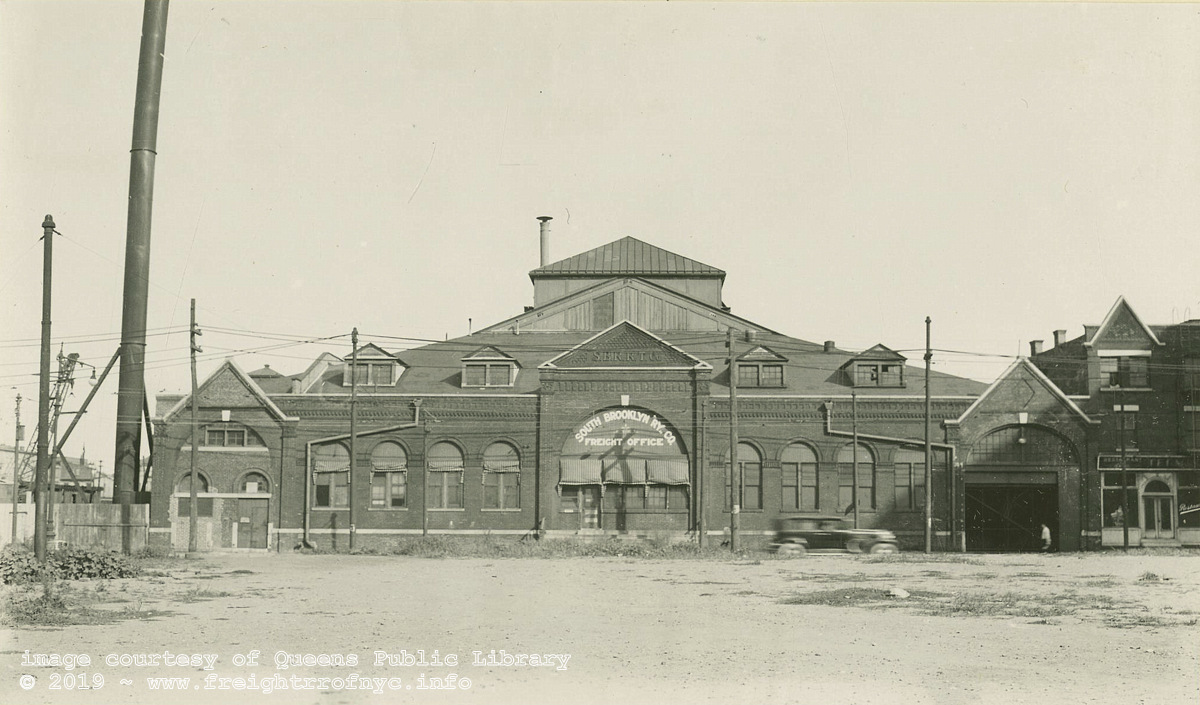
South Brooklyn Railroad & Terminal Co. Freight
House - September 7, 1938
William J. Rugen photo
Looking east: Automobile is on Second Avenue, between 37th
Street (left) and 39th Street (right).
This structure would be razed unknown year, and the location subsequently
occupied by a brick yard, Davidson Pipe and now CostCo Wholesale club.
original image courtesy of Queens Public Library Digital Archives
via P. Matus
added 13 July 2010
.
Private Ownership
| The South Brooklyn Railway or "SBK" (as
it is known within New York area railfanning groups) as organized, was unique
in the fact that it at one time; handled both freight and passenger service.
This webpage will focus itself upon the freight aspects of their operations, with intermittent mention of passenger operations where relevant. According to the New York Times article dated July 16th, 1892 (seen at right); the South Brooklyn Railroad & Terminal Company was organized in 1887, but its history really predates this by one year. In September 29, 1886, the South Brooklyn and Flatbush Railroad Company was incorporated to operate a steam railroad. Historical recordings reflect that this company never started construction and on November 10, 1887, the name was changed to South Brooklyn Railroad & Terminal Company. Even at this time, it was not an operating railroad in that it owned no locomotives or rolling stock, but had been merely organized as a property holder no longer than a few city blocks. It was organized with the intent for that property to be leased to another operating railroad that wished to the connect to the Ferry Terminal at the foot of 39th Street. Unfortunately, no other railroads showed interest, and the tracks and terminal remained unused.
In 1892, the South Brooklyn Railway &
Terminal Company spent a great deal of money to purchase that land and extend
the route to the new ferry terminus at the foot of 39th Street and the shoreline
of New York Harbor. A Terminal Station and Freighthouse was built at Third
Avenue & 37th through 39th Streets. In 1897, the Long Island Railroad, (which had been operating passenger trains from their own ferry terminal at 65th Street via the Bay Ridge Branch and connecting with the Prospect Park & Coney Island RR at Parkville Junction), now leased the South Brooklyn Railway & Terminal Company, (and LIRR eliminated their Bay Ridge Branch to Parkville Junction passenger train). Quick side bar here: in 1893, Andrew Culver sold his Prospect Park & Coney Island RR (which ran along Gravesend Avenue) to the Long Island Rail Road. The Long Island Railroad operated the South Brooklyn Railway & Terminal Company using steam powered locomotives (former elevated locomotives of 0-4-2T and 0-4-4T wheel arrangements) from June 1897 and until June 1903. Unfortunately, these locomotives were not adequate for freight operations, and the line was electrified in 1899. In spite of this, the LIRR continued to run irregular steam powered "Racetrack Specials" to the Brooklyn Jockey Club / Gravesend Racetrack located at Kings Highway and Ocean Parkway. On December 19, 1899, the South Brooklyn Railroad & Terminal Company was foreclosed upon, and the company was reorganized as the South Brooklyn Railway on January 13, 1900 by the new owners, Brooklyn Rapid Transit. Even under this new Brooklyn Rapid Transit ownership, the Long Island Rail Road would continue to operate the trains.
In 1900, Irving T. Bush of the "Independent Stores" (soon
to become Bush Terminal) advised the Brooklyn Heights Railroad (a BRT
subsidiary) that their trolley cars should handle freight as well, and
by installing private sidings for the service of such. Following this,
the BHRR formed a freight department. It should be recognized that in the early days of operation, the South Brooklyn Railway, being a subsidiary of the Brooklyn Rapid Transit; operated over several other already established railroad / railway routes that by this time had been absorbed under the parentage of Brooklyn Rapid Transit. On 06 January 2009, I acquired a copy of the "Brooklyn Rapid Transit - Track Mileage Book" originally dated January 1, 1910; which reflects that the South Brooklyn Railway (freight) would have operated over the following passenger "routes". Reference to these several different "routes" led me to understand these routes were operated by several different "owners", which was quite confusing. While I hope the following is accurate there is a small possibility of error. Please note the locations given are passenger stops / stations. Corrections are welcome: |  |
| owner | route | from | to | distance from 39th Street Ferry Terminal |
| Property of the City of NY | Ferry Terminal | connection of South Brooklyn Railway | 0.094 | |
| South Brooklyn Railway Co. | (Private Right of Way) | connection of South Brooklyn Railway | Second Ave & 39th Street | 0.264 |
| Brooklyn City RR | 39th St Ferry - Coney Island | Second Avenue & 39th Street | Third Avenue & 39th Street | 0.302 |
| Brooklyn City RR | 39th St Ferry - Coney Island | Third Avenue & 39th Street | Fifth Avenue & 39th Street | 0.746 |
| Nassau City Electric RR | Culver | Fifth Avenue & 39th Street | old city line | 1.184 |
| Sea Beach Railway Co. | Culver | old city line | Ninth Ave connection to Culver Line | 1.370 |
| Prospect Park & Coney Island Railroad | Culver | Ninth Avenue connection to Culver Line | Fort Hamilton Parkway | 1.640 |
| " " " " " " " " " " | " " | Fort Hamilton Parkway | Thirteenth Avenue | 1.908 |
| " " " " " " " " " " | " " | Thirteenth Avenue | Kensington Junction | 2.472 |
| " " " " " " " " " " | " " | Kensington Junction | Eighteenth Avenue | 2.840 |
| " " " " " " " " " " | " " | Eighteenth Avenue | Parkville | 3.085 |
| " " " " " " " " " " | " " | Parkville | Twenty-Second Ave | 3.517 |
| " " " " " " " " " " | " " | Twenty-Second Avenue | Woodlawn (Avenue N) | 4.005 |
| " " " " " " " " " " | " " | Woodlawn (Avenue N) | Avenue P | 4.357 |
| " " " " " " " " " " | " " | Avenue P | Kings Highway | 4.683 |
| " " " " " " " " " " | " " | Kings Highway | Gravesend Race Track* | 4.965 |
| " " " " " " " " " " | " " | Gravesend Race Track* | Gravesend (Avenue U?) | 5.308 |
| " " " " " " " " " " | " " | Gravesend | Avenue W | 5.490 |
| " " " " " " " " " " | " " | Avenue W | Van Sicklen | 6.295 |
| " " " " " " " " " " | " " | Van Sicklen | Culver Terminal | 6.723 |
* = also known as the Brooklyn Jockey Club
In 1913, all freight and railway express handled by the Brooklyn Rapid Transit was again reorganized to simplify accounting and all freight handling motive power was transferred to South Brooklyn Railway ownership. The construction of new subway and elevated lines in Brooklyn, especially the Fourth Avenue Subway; was expedited by the presence of the South Brooklyn Railway, which provided an affordable and convenient service by hauling in the raw materials and hauling away the excavation tailings and debris. A temporary connection installed at 38th Street and Fourth Avenue allowed South Brooklyn Railway equipment to enter and keep pace with the progress of construction of that subway route. In June of 1922, the South Brooklyn Railway purchased the majority of the capital stock of the Prospect Park & Coney Island Railroad (which was still owned by the LIRR). By 1923, the Prospect Park & Coney Island Railroad and New York & Coney Island RR (which was operating the Norton Point trolley line) was merged into the South Brooklyn Railway, giving them access to Coney Island. Also in 1923, Brooklyn Rapid Transit filed bankruptcy and was reorganized into the Brooklyn Manhattan Transit Corporation (BMT), which in effect became parent organization to the South Brooklyn Railway, and all ICC regulations remained as before. . . New York City Ownership In May 1940, the South Brooklyn Railway became part of the New York City Board of Transportation, which consolidated ("the Unification") all the individual transit companies and street car lines in the New York City proper under one municipal government organization: the Board of Transportation. The BoT entered into contract with the South Brooklyn Railway to provide labor, supplies and ultimately, equipment. Railroad freight traffic, which had been tapering off with the advent and proliferation of motor trucks, figuratively exploded with the entrance of the United States in World War II. Wartime restrictions and rationing of gasoline and other petroleum products curtailed motor truck usage and the South Brooklyn Railway (which was electric powered) found itself with plenty business. At some point during this time frame, the South Brooklyn Railway also operated a fleet of trucks for delivery of incoming freight direct to customers doors. In 1946, World War II was over and the South Brooklyn Railway would purchase two surplussed ex-U.S. Army Whitcomb 65 ton diesel locomotives, #8 & #9 (first). In 1953, the New York City Board of Transportation was renamed the New York City Transit Authority (NYCTA). On October 31, 1958; passenger service by streetcar along McDonald Avenue was discontinued, leaving that route to the exclusive use of the South Brooklyn Railway for freight movements (although it would have to share that thoroughfare with automobiles). | 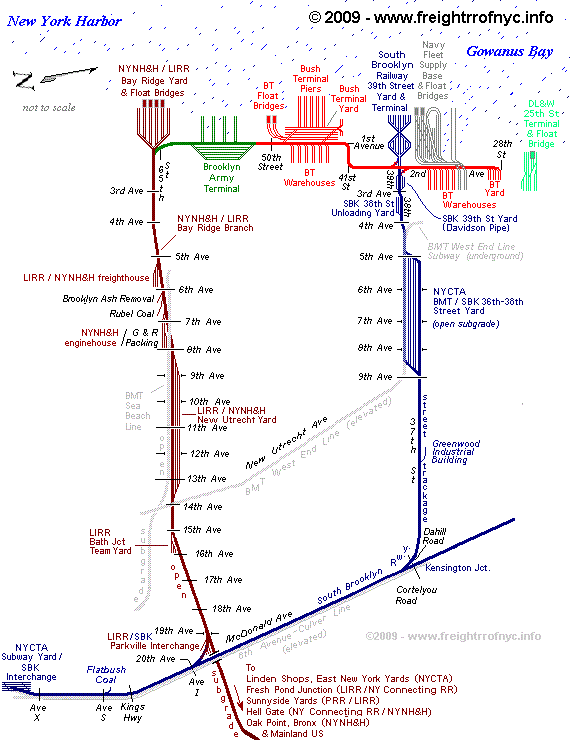 |
. In 1960, two more diesel electric locomotives were purchased (#12 & 13) and a sad milestone in South Brooklyn Railway history occurred in December 27, 1961, when the overhead trolley wire was de-energized, effectively ending electric locomotive operations along the South Brooklyn Railway. It was deemed cost prohibitive to refurbish the aging overhead trolley wire along the right of way. The surviving electric locomotives (#4, 5, 6 & 7) were turned over to the NYCTA where they would continue to see life working on the various elevated and subway routes as they were equipped with third rail pick up shoes.. Fortunately, their historical value is recognized and were restored and kept as museum pieces.
The switches at Kensington Junction were locked into the 37th Street position (some references state they were removed altogether) thereby isolating the branch up to the Ninth Avenue & 20th Street Depot, which was no longer needed with the cessation of passenger streetcar operations.
Freight would continue to be transported along the South Brooklyn Railway to several merchants, but like the rest of the terminal railroads located in Brooklyn; freight traffic was dwindling due to the ever increasing use of the motor truck.
In 1978 the street trackage east of Fort Hamilton Parkway, as well as that upon McDonald Avenue trackage was abandoned. Portions of the line were paved over around 1991.
In 1994, the last non-NYCTA customer, Davidson Pipe closed their yard bound by Second and Third Avenues and 39th and 37th Streets. The South Brooklyn Railway would continue to partake somewhat of the Bush Terminal Interchange to intermittently utilize the Long Island Rail Road's Bay Ridge Division.
The SBK has not hauled new or rebuilt inbound subway cars since 1992 with the delivery of rebuilt R44's; or outbound obsolete subway cars for scrapping or rebuilding since circa 2004.
It did however place obsolete subway cars in the Second Avenue and 39th Street Yard for asbestos removal as late as 2007. But these cars were not interchanged with New York Cross Harbor / New York New Jersey Rail or shuttled to & from the float bridge at Bush Terminal or LIRR Bay Ridge Branch.
Beginning in May and throughout June 2012, the South Brooklyn Railway saw haulage of new equipment for the NYCTA: the delivery of twenty-eight R156 diesel-electric work locomotives. Delivery took place upon the completion of the reconstruction of street trackage along First Avenue to the new South Brooklyn Marine Terminal at 39th Street.
In June 2019, new R252 contract flatcars began arriving via tractor trailer, and offloaded at the SBK / NYNJ Rail interchange.
The South Brooklyn Railway remains in operation as a freight subsidiary to the New York City Transit Authority,
Any updates regarding this will appear in the Current & Future Operations chapter below.
The schematic seen above shows the original route of the South Brooklyn Railway (in blue) and the connections and interchanges to the BMT Subway (light gray), Bush Terminal (red); Fleet Supply Base of the US Navy (dark gray), Brooklyn Army Terminal (in green) and the NYNH&H / LIRR Bay Ridge Division (shown in brown).
Please keep in mind, is it not to scale and is a composite of the various railroads and industries that operated throughout the Twentieth Century, even though some of the businesses may not have existed all at the same time.
.
.
.
An In Depth Look into SBK Delivery Network
 | 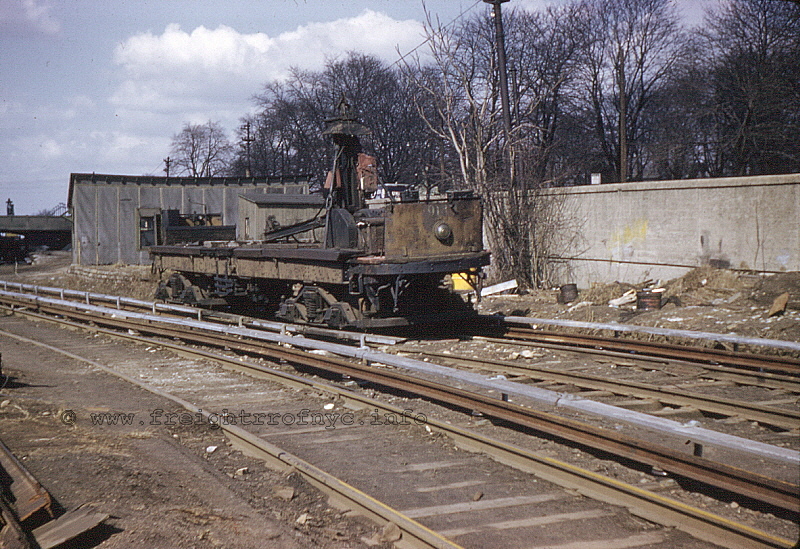 |
| #9444 - "freight box motor" - 1928 | #9137 - "trolley derrick gondola" - 1959 |
Freight business under the auspices of the South Brooklyn Railway began in April 1896 when the South Brooklyn entered into contract with the National Express Company to carry freight in seven express trolley cars. In May, National Express Co. leased a store at the corner of Jamaica Union Hall Street (approximately near the present 160th Street) and utilized it as a baggage office. Actual service commenced on June 10, with four round trips daily.
One more express trolley would enter service four months later. Sidings were installed at six locations:
|
This service would continue for almost three decades, ending December 31, 1928.
Because of the complexity of passenger service and the proposed freight service, the Brooklyn Rapid Transit decided to form a freight department. Wisely, the company proceeded along these lines methodically and slowly. Furthermore, the haulage of the construction material for both their own lines and the new ones being constructed saw a rapid increase in freight traffic. At the beginning, the BRT forces performed their own work, but as the scope of the construction and reconstruction became obvious, the BRT hired private contractors to assist.
Meanwhile word got out and the demand for freight service kept increasing. Elaborate plans for handling freight cars were set on paper by ex-Governor Flower, Richard Croker and John F. Carroll who conceived the idea of hauling the ashes on the surface lines.
Prominent realtors McNulty & Fitzgerald were expecting to reclaim much of the marsh land in Coney Island Creek area and sell for suitable residential building lots
In 1897, the Long Island Railroad, (which had been operating passenger trains from their own ferry terminal at 65th Street via the Bay Ridge Branch and connecting with the Prospect Park & Coney Island RR at Parkville Junction), now leased the South Brooklyn Railway & Terminal Company, (and LIRR eliminated their Bay Ridge Branch to Parkville Junction passenger train).
Quick side bar here: in 1893, Andrew Culver sold his Prospect Park & Coney Island RR (which ran along Gravesend Avenue) to the Long Island Rail Road.
The Long Island Railroad operated the South Brooklyn Railway & Terminal Company using steam powered locomotives (former elevated locomotives of 0-4-2T and 0-4-4T wheel arrangements) from June 1897 and until June 1903.
.
Trolley / Streetcar Delivery System . It is most important to remember that the South Brooklyn Railway, unlike any other of the freight terminal railroads throughout Brooklyn, that its delivery system was based upon the vast network of passenger streetcar trackage laced throughout the borough. It did not haul freight along a fixed route from Point A to Point B until much later in its existence. When the South Brooklyn Railway was first created it handled the freight delivery for most of, if not all the passenger carrying streetcar lines throughout Brooklyn. There were untold customers and countless sidings and spurs off the streetcar routes that snaked their way through Brooklyn. This early history must not be forgotten despite it being slowly erased from our collective memories. When presently discussed all that seems to be remembered about the South Brooklyn Railway is that it hauled subway cars for the NYCTA from Bush Interchange to the Coney Island Shops. It has become too easy to think in simplistic terms of the fixed route service discussed at length below and I, more than anyone; am guilty of this. The South Brooklyn Railway was so much more than that. Hence the creation of this chapter. It also must be understood, that there were two varieties of freight being handled by the South Brooklyn: carload and less-than-carload. Carload freight is comprised of an entire railway car for a single customer. It could be a box car of metal castings for an assembly firm, sacks of hops or barley for a brewery, flatcars of granite to be cut for curbstones or to be carved into headstones, gondolas of steel pipe or hoppers of coal for a coal dealer to resell or to heat or power a electrical generating station for a large industry. Originating at locations throughout Brooklyn would be the trolley gondolas carrying ash from coal stoves used in home and business heating as well as the manufactured good originating in Brooklyn. . Carload and Less-Than-Carload For carload delivery, Brooklyn had no connection to the mainland US rail network until 1916, and even then it was a limited affair. So once a freight car arrived at the freight terminal dock via carfloat for the South Brooklyn Railway (and almost certainly the Bush Terminal Railroad), the carloads were pretty much handled by the electric locomotives and delivered to the designated consignee / customer. | ... |
|
The other kind of freight haulage is less-than-carload. In most cases, this would be a boxcar loaded with many different items or materials from different consignors for different customers.
By itself, that partial load would have been a waste of space in assigning an entire boxcar to deliver just a single customers few crates and would have been cost prohibitive. When many small loads shared one boxcar and thereby sharing the expense of shipping, it cut the cost of shipping. But, these less than carload shipments were the most labor intensive. It is with these types of deliveries, that the final delivery agent (in this case the South Brooklyn Railway) needed a large roster of freight cars for it network of customers.
It was the less-than-carloads that usually were transferred to the "freight box motor" or similar equipment. This was really nothing more than a powered boxcar with a platform on both ends (sometimes one) for the motorman to operate from. Basically it was the next step in the evolution from horse-drawn wagon delivery in urban environments.
As such, the South Brooklyn Railway had dozens of these trolley box motors and trolley gondolas to serve the needs of its customers. They would pretty much fan out throughout Brooklyn on a daily basis to hundreds of different customers and return to the freight stations for more deliveries arriving throughout the day. The best I can compare it to in modern times, is think of it as a primitive UPS distribution system, but instead of brown trucks, it was brown (or dark red or olive green) trolleys!
Another factor to be considered was that the standard size freight cars in use by the transcontinental railroads at that time were too large in dimension for easy transport through narrow city streets (yet tiny in comparison to the freight cars of today!) So the less-than-carloads were transferred to smaller trolley sized equipment such as those shown below.
And of course, the South Brooklyn Railway worked for the growing rapid transit system - the subways and elevateds; by hauling tunnel excavation debris and delivering the various materials needed for the building of tunnels, stations and the elevateds.
It should be remembered that the subways and elevateds were considered "rapid transit" because the train could go blocks without stopping, covering more distance in less time than opposed to the "surface transit" of which the trolleys and streetcars pretty much stopped on every street corner much like the present bus routes. The rapid transit and surface transit systems thought of as separate operations in those days.
On July 30, 1903, the American Railway Traffic Company was incorporated in Jersey City, NJ. This company was created with the purpose of hauling the ash, rubbish and street sweepings (read: horse droppings) collected in the Borough of Brooklyn. This operation was small in scale due to the fact that ARTCo was not incorporated in the state of New York and had not yet acquired the rail cars for widespread service. This would be remedied in 1904, and twenty-eight gondolas were ordered.
On August 31, 1902, the Brooklyn Rapid Transit Company acquired full control of the South Brooklyn Railway for $500,000 by buying in all stock except for directors shares; and the South Brooklyn became another subsidiary of the Brooklyn Heights Railroad.
Things really got going with when contracts were let for the construction of 52 freight car bodies as the cost of $31,886. This shall include:
12 additional flat cars for freight service were built in the
company shops at approximately $6,000, and a portion of this equipment
would reuse motors and trucks and electrical systems from obsolete
passenger equipment.
Also
taking place in 1903, was the construction of a railyard (equipped with
overhead trolley wire), which was located adjacent to the 39th Street
Ferry Terminal.
This yard was so situated that it allowed the transfer of freight from the Bush Terminal Railroad. In 1905, the South Brooklyn Railway purchased three locomotives along with 40 additional freight cars to handle the increase in freight traffic.
This freight traffic arriving at Bush Terminal for interchange with South Brooklyn, was divided into two groups: "trolley freight" and "steam freight". While not specifically stated in the Linder / Eppler article, it can be assumed that steam freight referred to carload and trolley freight was less than carload. This assumption is reached as trolley freight would have had to have been transferred from a standard "steam" railroad car to the SBK / BHRR trolley car for final delivery, and as it would not make any sense to transfer freight from one steam railroad car to yet another when that first steam railroad car could simply be interchanged and hauled to destination in the first place.
Steam freight was interchanged at the yard west of Second Avenue between 40th and 41st Streets operated by Bush Terminal which accessed the yard from the west under a large coal trestle. At that time there were no tracks on 41st Street. These cars would be hauled along Second Avenue to the 38th Street Yard west of Second Avenue where they would be coupled to South Brooklyn Railway locomotives. The Bush Terminal Railroad performed this service under contract from the Brooklyn Heights Railroad as well as maintained the yard and provided office space for the BHRR representative.
Trolley freight was interchanged from Second Avenue. Freight was transferred from steam railroad cars and less than carload freight was transferred from the freight house to South Brooklyn Railway cars.
This transfer and interchange service all changed around 1906, when Bush Terminal began a massive expansion and construction of its lofts and warehouses. The 40th Street freight yard was demolished and a new South Brooklyn Railway / Bush Terminal Railroad interchange yard and freight house was built at 48th Street and Second Avenue.
The South Brooklyn Railway and Long Island Rail Road were unable to to agree on rent for the LIRR Coney Island Freight House. SBK needed the use of the freight house for less than carload traffic but the profit would have been less than the $1000 annual rent LIRR was demanding. This led to the BHRR constructing it's own freight house located on West 8th Street, near the Police Station.
SBK began hauling the freight with several small locomotives no longer needed after the electrification of the elevated lines. These locomotives soon proved not to be powerful enough, and BRT designed locomotive #4 and built it.
Also during this period freight traffic steadily increased. Throughout the next few years, the SBK entered into many agreements to haul the freight for the occupying passenger hauling company lines throughout Brooklyn, i.e.: Transit Development, Brooklyn, Queens County & Suburban, Nassau Electric, Brooklyn Union Elevated, Prospect Park & Coney Island, Sea Beach Railway, New York & Coney Island Railway, Coney Island & Brooklyn Railroad, among others.
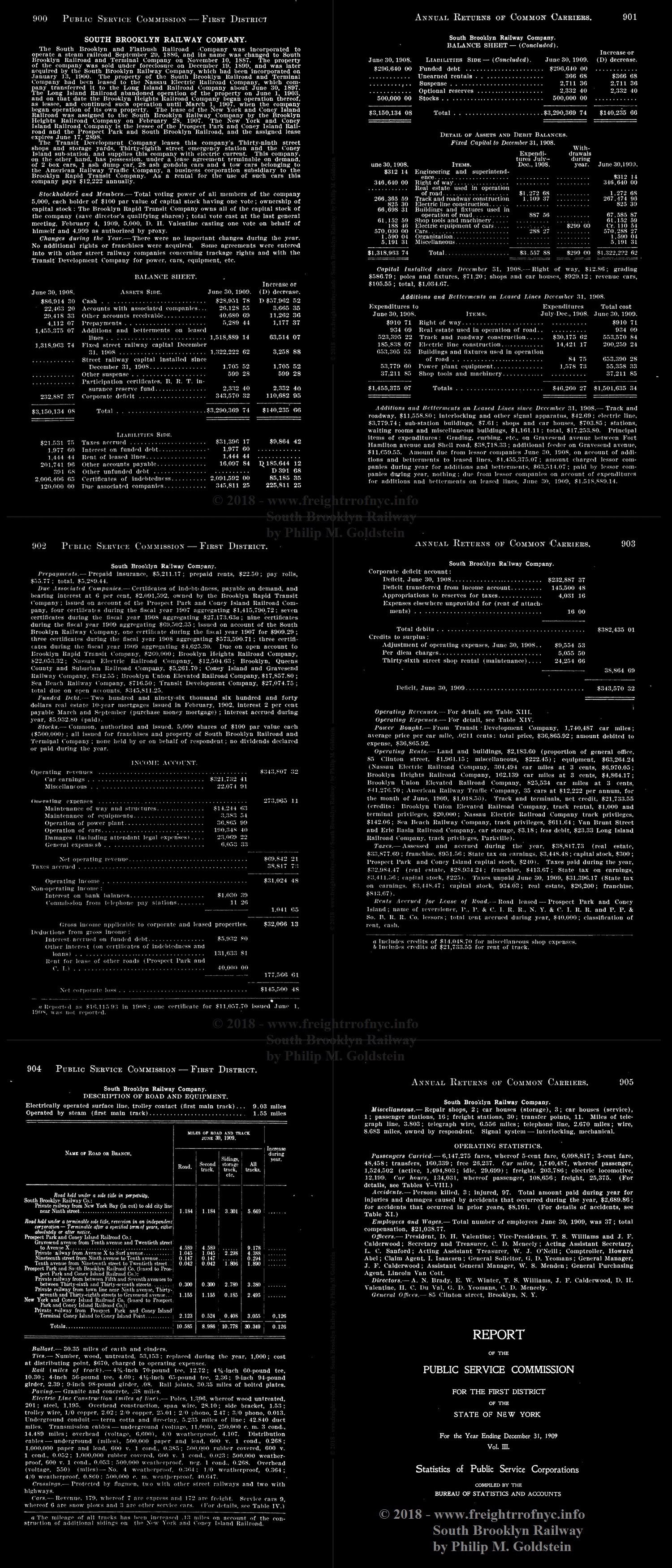
In 1910, Locomotive #5 was built by General Electric and delivered to South Brooklyn Railway. It was designed to ascend the steep grade near the waterfront as well as operate at high speeds on lengthy runs.
In 1915, with the beginning of construction of the Brooklyn Rapid Transit's Culver Line which was being constructed either directly next to or over South Brooklyn Railways right of way adjacent to 37th Street, required a a tunnel east of Ninth Street Station. This effectively blocked the South Brooklyn Railway's main line. So, the South Brooklyn Railway commenced in purchasing land on the north side of ongoing construction and rerouted their right of way.
In 1916, the Transit Development Company (another BRT subsidiary) built four rail cars: 9978-9979 and 9987-9988 for the South Brooklyn Railway. At about the same time, a motor was installed on ash car 9980, which allowed the ash bins to be dumped mechanically. Other improvements to rolling stock this year were a Whiting crane was installed on Derrick Car 9004 and a new under frame built for 9133. In compliance with Public Service Commission orders, geared handbrakes were installed on 37 other cars on the roster.
While not related to freight operation, it is worth noting that in 1918, all elevated cars were fitted with trolley poles in addition to third rail contact shoes when the United States Army announced their intention to use the dock at Nortons Point, located at the west end of SBK's Norton Point Line. The BRT substituted Brooklyn Heights Railroad "El" cars for trolley cars on May 25, 1918. The dock was never used, and the US Army altered their plans, and passenger traffic did not increase. Therefore, trolley cars returned October 1919. In fact, passenger traffic became so light, that South Brooklyn Railway purchased six single truck "Birney" cars from Cincinnati Car Company, numbered 7200 through 7205.
Freight traffic started falling off following the conclusion of World War I, but the routes were still busy. In the internal BRT monthly magazine published September / October 1919; the South Brooklyn Railway was averaging 60 to 75 carloads daily.
In 1918, with the near completion of most of the subway construction projects, the South Brooklyn Railway was becoming burdened with a surplus of equipment. Locomotives #6 (first) and #7 (first) were sold to New York Consolidated Railroad, yet another(!) subsidiary of the Brooklyn Rapid Transit, this one being their rapid transit subsidiary. Numbers 6 and 7 were sold for $34,000 and twenty-six air dump cars: #9940-9959 and 9964-9973 were sold for $22,000; netting a profit of $1,000.
In 1920, plow motors 9802, 9803 and 9805 were sold to the Brooklyn Development Company for $19,319.76 and Locomotive #3 sold to New York Consolidated for $6065.85. Fifteen dump cars were scrapped. Also in 1920, Kensington Tower and the Parkville Passenger Station (built 1885) were removed.
Freight was also allowed to be transported through the new subway tunnels of Fourth Avenue Line, between the hours of 1:00 am and 5:00 am; and also from the Culver Line to the Sea Beach Line. On January 18, 1921, and agreement was made with the New York Consolidated RR permitting operation of of freight cars on portions of the Fourth Avenue, Sea Beach & West End Lines. A reciprocal agreement was made concerning their use of the electric cars and freight locomotives. All this freight was usually carried at night, and without interference to the commuter.
Despite being a Sunday, that day of the week saw significant freight traffic. Ten cars were required for the Sunday issues of the areas newspapers, three alone for the Brooklyn Daily Eagle.
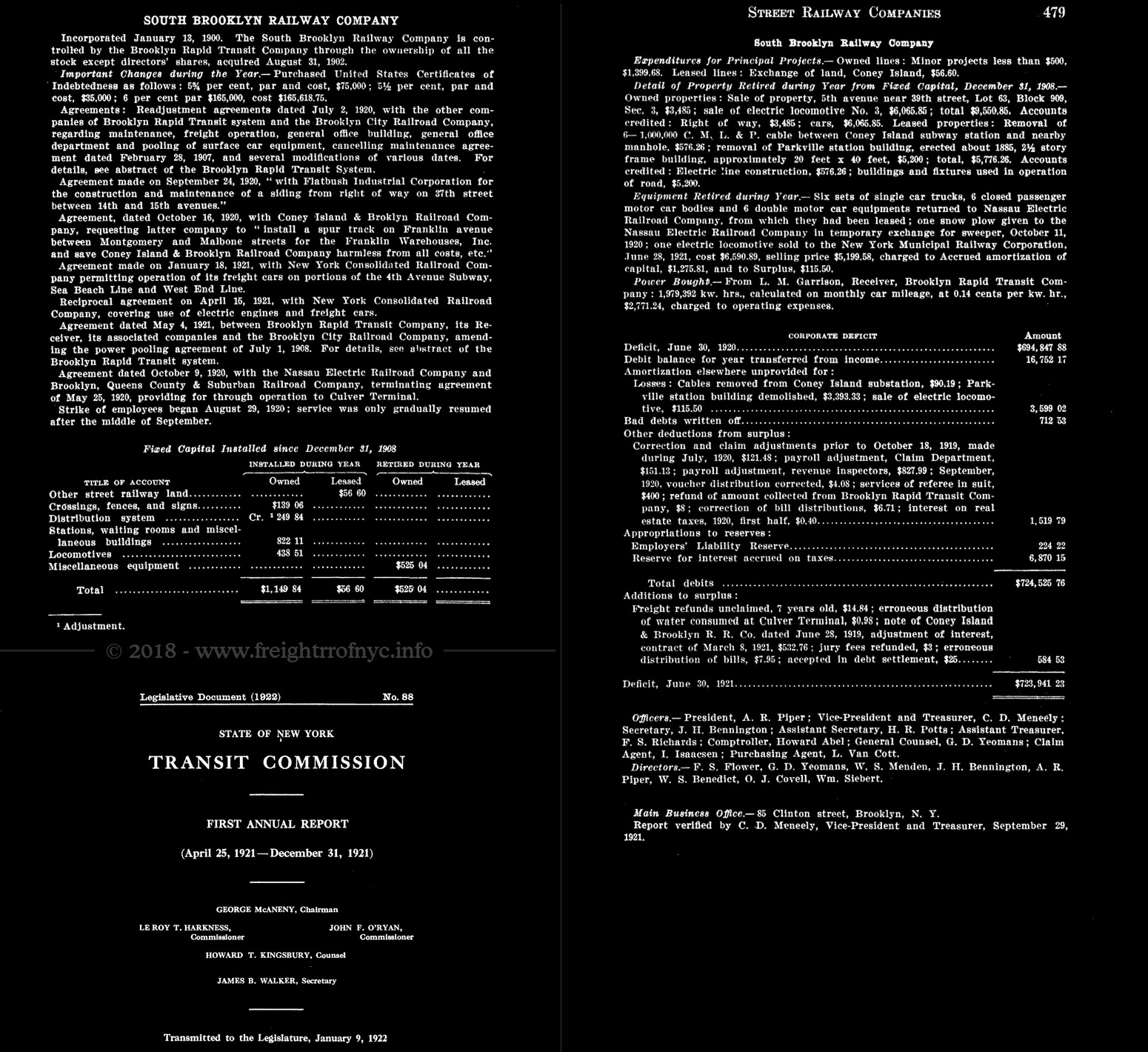
Transit Commission Annual Report - 1921
In 1926, the New York Rapid Transit Corporation, the Brooklyn Manhattan Transit subsidiary requested that South Brooklyn Railway cease operating freight trains in the Fourth Avenue Subway and on the Sea Beach Line. Even though the South Brooklyn Railway only had four customers remaining on the Sea Beach Line (J. M. Huber, Rubel Coal & Ice, Granitface and Brooklyn Borough Gas); the NYRT was not successful in their action and freight service along that route continued for several more years.
Commencing in 1929, and following the merger of the various BMT trolley subsidiaries into the formation of the Brooklyn & Queens Transit Corporation; the South Brooklyn agreed to pay the B&QT ten cents per mile for freight cars operated on its streetcar lines.
By 1930, South Brooklyn Railway instituted their motor truck store-door delivery service. In 1931 two miles of yard tracks were removed from the 36th Street Yard and repurposed for bus parking and storage.
In 1935, South Brooklyn Railway agreed to pay New York Rapid Transit Corporation 30 cent per mile for freight cars operating on their tracks.
On June 1, 1940, the City of New York assumed operation of all surface and rapid transit lines throughout the Boroughs of Brooklyn and Queens. The previous day, the South Brooklyn Railway entered into contract with the newly formed Board of Transportation of the City of New York, whereas the BoT agreed to control and operate the South Brooklyn Railway and furnish the labor, employees, material, and supplies required for maintenance and operation. This contract allowed the South Brooklyn Railway to share the use of the various BoT clerical and operating departments and provided that employees required by the South Brooklyn operation be assigned by the BoT.
A survey held in 1953 revealed the Granitface siding at 17th Avenue was no longer used and the Huber siding was unused since June 1949. Following this, the trackage rights as agreed to in 1934 of the South Brooklyn Railway on the Sea Beach Line were amended. It was now amended to only include the portion between the north end of the 86th Street Station and the old junction junction of the Sea Beach Line at Avenue Y.
On August 26, 1954 the overhead wire on the property of the Brooklyn Borough Gas Company siding was removed.
.
.
.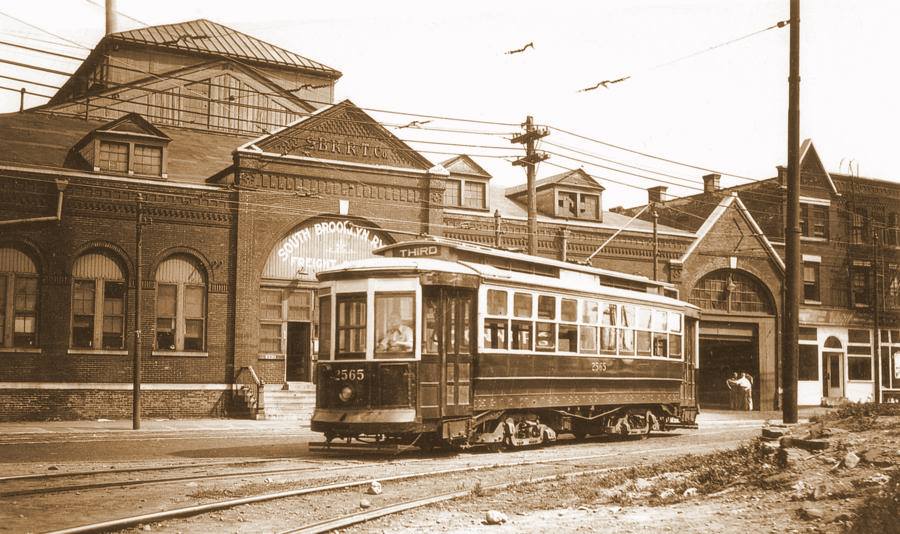
South Brooklyn Railway Main Freight House - Second Avenue & 38th Street - ca. 1899
Up until 1904, the Long Island Rail Road, Brooklyn Heights Railroad and several other subsidiaries (the South Brooklyn Railway being one of many) of Brooklyn Rapid Transit (the main holding company) handled the freight traffic throughout Brooklyn.
On April 16, 1905, South Brooklyn Railway took over freight handling from Long Island Rail Road.
Also, this year is doubly significant for it is the year the South Brooklyn Railway entered into direct agreement with Bush Terminal Railroad to forward freight from the Class 1 mainland railroads yards in New Jersey through Bush Terminal via carfloats. Without this agreement, the South Brooklyn Railway most certainly would not have enjoyed the cost savings and convenience of someone else doing the carfloating, and doubtfully would have been so successful.
In 1907, newly enacted legislation by the Interstate Commerce Commission resulted in the South Brooklyn Railway being split off from the Brooklyn Rapid Transit Company, and of which would now operate the South Brooklyn Railway under its own name as a completely separate company. This required a slew of trackage rights and terminal agreements being canceled by the original subsidiaries and new contracts issued by the South Brooklyn Railway. Had this not been done, the entire Brooklyn Rapid Transit system (almost entirely a passenger hauling company) would been made subject to Interstate Commerce Commission regulations.
Upon the formation of the South Brooklyn Railway (as will be discussed in The Old Era chapter above), there were dozens if not hundreds of small customers that received freight via the streetcar delivery network. Unfortunately, quite a few of those names have been lost to history until a receipt or a document makes itself available, at which time it will be added to the list below.
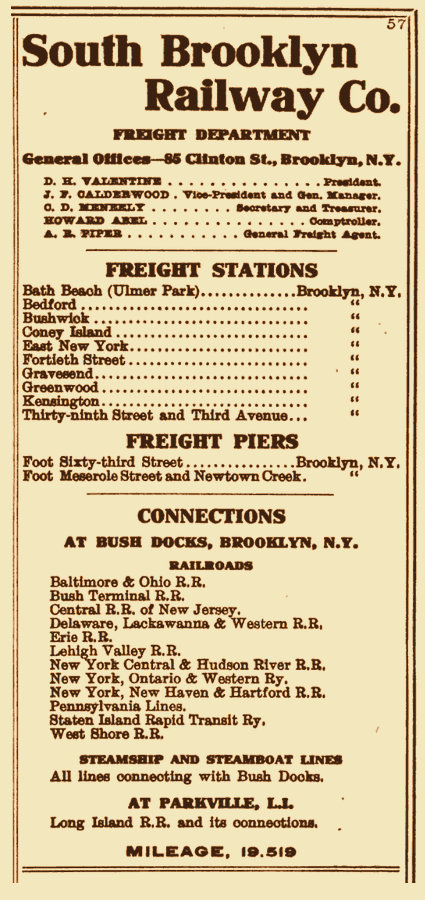
Official Railway Guide - June 1911
.
What we do know is that the South Brooklyn Railway had freight stations at the following locations (some of which have been discussed at length, others very little is known). The August 27, 1915 - Volume 9, No. 9 issue of Railway Age Gazette (a railroad trade journal) lists the following locations as freight stations for the South Brooklyn Railway:
|
.
While researching various other documents (i.e.: Documents of the Senate of the State of New York - 1917, the Joint Report with Comprehensive Plan and Recommendations, Volume 1, Part 4 -1920 as well as numerous others), we have come to learn that the following locations also came to be freight or delivery stations for the South Brooklyn Railway.
|
Some of the information for actual customers comes from the ten part Bernard Linder / Paul Eppler series of articles on the South Brooklyn Railway as published in the Electric Railroaders Association bi-monthly magazine: "Bulletin". Benjamin W. Schaeffer fortunately has the complete set in his personal library. Furthermore, with the kind generosity and courtesy of Jeff Erlitz, present editor in chief of the ERA Bulletin, we have secured permission to republish the articles on this website.
From this series and from official filings, lawsuits, announcements, magazine articles, property map notations as well as recollections and information from the various transit buffs of the South Brooklyn Railway for both old and new era of operations, we have been able to compile the list below. As we learn more, they too will be added to the list below.
One of the most unusual arrangements the South Brooklyn Railway engaged in, long before any other common carrier did offer such service, was their "Store to Door" delivery trucking.
The South Brooklyn Railway entered into contract with Horstmann Trucking to furnish the trucks and drivers. If a consignee specified "Paramount Station" on their waybill, that freight was delivered to the main freighthouse at Third Avenue & 39th Street. Here the South Brooklyn Railway unloaded the freight from the Class 1 railroad freight car (brought in by Bush Terminal via carfloat) and placed it upon a motor truck for haulage to the final delivery location. The reverse held true for outgoing shipments.
| Paramount Station Team Tracks / Horstmann Trucking 39th Street between First and Second and Third Avenues (to become Davidson pipe) images courtesy of the New York Transit Museum (not to be reused or reproduced without consent) added 03 June 2021 | |
.
.
Customer List
The years served column is only an estimated time frame. Dates given are usually the date of the reference article, and actual dates of service could extend before or after the given date. This is by no means a complete list, but very comprehensive:| customer | commodity | location | years served |
| Direct Freight Car Service (via steam and/or electric locomotive) | |||
| S. Abato | Shell Road & Cobek Court | 1928 | |
| Ansonia Clock | clock manufacturer | 20th Street & Ninth Avenue | |
| Armour Packaging | distribution plant | 38th Street & Third Avenue | |
| Bay Ridge Coal | coal | 37th Street & Fifteenth Avenue | |
| Berkshire Structural Steel | steel beams | 37th Street & Fort Hamilton Parkway 38th Street & Tenth Avenue | ca. 1917 to ? |
| Brooklyn Borough Gas | contruction materials, valves, pipe manufactured illuminating gas and gas storage | West 17th Street & Mermaid Avenue Coney Island Creek | c1913-1960 |
| Cirillo Brothers Ice | ice | 37th Street & Thirteenth Avenue | 1932 |
| Cobco Flooring & Lumber | 38th Street & Twelfth Avenue | 1927 | |
| Cohn Cut Stone | cut stone | 38th Street & Fourteenth Avenue | 1909 |
| Cullen Fuel | Coney Island | 1926 | |
| Culver Lumber | dimensional wood & building supplies | 37th Street & Fifteenth Avenue | c1930 |
| Davidson Pipe | steel pipe | 38th Street & Third Avenue | c1955 - 1994 |
| Desbrock Coal & Company | coal & ice | 14th Avenue & 60th Street; relocated to 16th Avenue & 63rd Street (Sea Beach Line) | ca. 1913 |
| Five P Holding | 38th Street & Twelfth Avenue | 1927 | |
| Flatbush Coal | coal | Gravesend Avenue (McDonald Avenue) & Avenue S (listed as Gravesend Avenue& Kings Highway) | 1928-1978 |
| Flatbush Industrial Building | machinery (H. W. Cotton), manufacturing lofts | 37th Street & Fourteenth Avenue | 1920-1978? |
| Granitface (?) | cut granite | Seventeenth Avenue | 1926-1953 |
| Gravesend Racetrack & Brooklyn Jockey Club? | hay & feed? | Gravesend Avenue (McDonald Avenue) & Avenue U | 1920's |
| Greenwood Cemetery | cut stone for mausoleums, headstones | 38th Street & Ninth Avenue | |
| Philip Gruber | 37th Street & Fourteen Avenue | 1926 | |
| Harstan Chemical | 38th Street & Twelfth Avenue | 1919 | |
| J. M. Huber | printing inks | 63rd Street & Sixth Avenue (Sea Beach Line) | 1912-1949 |
| C & S Jacobs Plumbing Supply | plumbing heating & steam fitting | 37th Street & Twelfth Avenue | 1927 |
| Kingsway Lumber | dimensional wood & building supplies | Gravesend Avenue & Cortelyou Road (Kensington Junction) | ca. 1930 |
| Knickerbocker Fuel Oil | fuel oil | 38th Street & Twelfth Avenue | 1927 |
| Samuel Klein / Klein's Lumber | dimensional wood & building supplies | 37th Street & Thirteenth Avenue | 1919 - c1930 |
| Luzerne Coal | coal | 38th Street & Sixteenth Avenue | 1930 |
| Maltine Co. | medical preparations | 20th Street & Ninth Avenue | |
| Massoit Corp | 36th Street & Fourteenth Avenue | 1920 | |
| New York City Transit Authority and predecessors (Brooklyn Rapid Transit) | subway cars and parts thereof; track components | 36th / 38th Street Yard, Coney Island Shops | 1899 - present |
| Nygaard Flooring | 37th Street & Twelfth Avenue | 1928 | |
| Peter Olson | 37th Street & Fort Hamilton Parkway | 1911 | |
| Phoenix Hermetic | sheet metal, canning / packaging supplies, lithographic plates | 37th Street & Fourteenth Avenue | ca. 1916 |
| S. Pizzutiello & Co | 37th Street & Twelfth Avenue | 1925 | |
| Prospect Coal | coal | 37th Street & Fort Hamilton Parkway 38th Street & Tenth Avenue | ca. 1917 to ? |
| Daniel M. Rader | 37th Street & Fort Hamilton Parkway | 1924 | |
| Roberts Holdings (Roberts Foods) | pickles, mayonnaise, condiments | 37th Street & Fort Hamilton Parkway 38th Street & Tenth Avenue | 1919-1978 |
| Rubel Ice & Coal | ice | Dahill Road & Cortelyou Road (Kensington Junction) | 1922 |
| Serlinsky & Kalish | Neptune Avenue & Coney Island Creek | 1926 | |
| Shell Road Coal | coal | Avenue Y & Shell Road | 1921 |
| Somers & Anderson | coal, tin plate & stamping? | Fort Hamilton Parkway & Culver Line | ca. 1913 |
| W. A. Case & Son | plumbers supplies | 49th Street & Twentieth Avenue (Parkville Junction) | ca. 1907 |
Trolley Motor Freight Service | |||
| Advex | adhesives, chemicals | Montgomery Street & Franklin Avenue | 1922 to |
| American Ice | ice | 331 Park Avenue near Grand Avenue | |
| American News | newsprint, printing supplies | Park Row (Manhattan end of Brooklyn Bridge | |
| American Steel Barrel (Brooklyn Meurer Steel Barrel) | steel containers, kegs & barrels | Flushing Avenue & Nostrand Avenue | ca. 1913 |
| Amid Duron | tallow, stiffening gums, rosin soaps, soluble oils for textiles | Nostrand Avenue & Park Avenue | 1912 |
| Arabol Manufacturing | adhesives, synthetic gum arabic | Nostrand Avenue & Park Avenue | 1904 - 1917 |
| Atlantic, Gulf, and Pacific | shipyard | Kemble Avenue, Mill Basin, Brooklyn | 1916, 1921 |
| Barber Asphalt | sand, liquid tar, asphaltum | Varick Avenue & Metropolitan Avenue; Newtown Creek | ca. 1913 |
| Benisch Brothers Monumental Works | cut stone, marble, granite from Maine | 840 Jamaica Avenue & Lincoln Avenue | 1911 |
| Berglass Manufacturing | 10 Fulton Street | ||
| Borough Asphalt | sand, liquid tar, asphaltum | Varick Avenue & Metropolitan Avenue | ca. 1913 |
| Borough of Brooklyn Highway Department | liquid tar, asphaltum | 63rd Street Dock | |
| Brooklyn Daily Eagle | newsprint & materials for same | Adams Street & Johnson Street | ca. 1913 |
| Burton Dixie | mattresses | Franklin Avenue & Montgomery Street | 1921 |
| Cheek-Neal Coffee | coffee roaster | 39th Street & Third Avenue | < 1921 |
| Consumers Park Brewery | malt, cereal for beer brewing | Montgomery Street & Franklin Avenue (Brighton Line) | |
| E. H. Cook Coal | coal | West 8th Street 1600' north of Sheepshead Bay Road | 1905 |
| Central Foundry | Fulton Street & Tompkins Avenue | ca. 1913 | |
| Continental Baking | flour, yeast, grain | public team track at power station 3rd Street & Third Avenue | |
| Cranford Asphalt | sand, liquid tar, asphaltum | Avenue R and Brighton Line (East 16th Street) | |
| Cranford Company | tunnel excavation material sand to Trolley Depots | 9th Street & Gowanus Canal temporary tunnel shafts at: Joralemon Street & Court Street Fulton Street & Dekalb Avenue Fourth Avenue & Atlantic Avenue | |
| Crimmins Contracting | broken stone, cement for new streets | 63rd Street Dock | |
| Cropsey & Mitchell | lumber | Cropsey Avenue & Bay 35th Street | 1910 |
| Cullen Fuel | coal | West 8th Street & Surf Avenue | |
| Damast, Abraham & Murray | 39th Street & Second Avenue | 1921 | |
| Degnon Contracting | street construction of Atlantic Avenue between Fifth & Flatbush Aves | temporary siding on Atlantic Avenue | |
| DeHass Simonson Realty | land fill | Broadway & Elmhurst Avenue | |
| Frank Brewery | malt, cereal for beer brewing | Flatbush Avenue & Vernon Avenue (now Tilden Avenue) | |
| Charles Froeb | wine & liquor wholesaler | Tompkins Avenue & Flushing Avenue | 1912 |
| Robert Gair | Front Street & Adams Street | ca. 1913 | |
| Granitface (?) | cut granite | Seventeenth Avenue | 1926-1953 |
| H. J. Heinz 1 | canned goods | Franklin Avenue & Bergen Street (former Nassau Brewery) | < 1921 |
| Hildebrandt Baking (predecessor to Continental Baking) | flour, yeast, grain | Third Avenue & 3rd Street (former ARTCo ash station) | |
| Joshua Horricks | wire fencing | Herkimer Street near Reid Avenue - materials delivered to trolley loop | |
| Otto Huber | beer depot | West 8th Street - beer trucked from brewery to Ridgewood Depot, then South Brooklyn to Coney Island | |
| Igoe Brothers | iron & steel | Flushing Avenue & Marcy Avenue - public yard | |
| Iron Clad Manufacturing | steel containers, kegs & barrels | Flushing Avenue & Varet Street | 1905 |
| Knickerbocker Ice | ice | Flatbush Avenue & East 32nd Street 37th Street between Fourteenth & Fifteenth Avenues | 1912, 1921 |
| League Storage & Warehouse | warehousing | Third Avenue & (proposed) 2nd Street (exact location unknown) | 1919 |
| Lower Gambrinus Brewery | malt, cereal for beer brewing | trucked from brewery on West 42 Manhattan to Williamsburg Bridge Plaza then via South Brooklyn to Coney Island | |
| W. F. Mangels | Coney Island | 1921 | |
| Metropolitan Engineering | electrical cabinets & cutout boxes | Nostrand Avenue & Atlantic Avenue | 1918 |
| Michael Brewing | beer & ice | Bergen Street & Third Avenue | |
| Benjamin Myers | Coney Island Yard | 1921 | |
| Nassau Brewing | malt, cereal for beer brewing | Dean Street & Franklin Avenue / Dean Street & Bergen Street (under Brighton el) | ca. 1913 |
| National Lead | lead | Strickland Avenue & Mill Avenue | |
| National Express Company | parcels & freight | 8-10 Fulton Street Broadway & Myrtle Avenue Bay 19th Street & Bath Avenue 16th Avenue & Ditmas Avenue Railroad Avenue between Sea Beach Palace and West End Depot 25th Street & Third Avenue East New York at Howard House Jamaica Avenue & Union Hall Street (160th St) | |
| North American Brewing | malt, cereal for beer brewing | used dead track in Ridgewood Car Barn | |
| J. W. Oeleriches | food packaging | Sanford Street & Park Avenue | 1912 |
| Pathe Freres Phonograph Co. | materials, goods for manufacturing and coal | Grand Avenue & Park Avenue | 1921 |
| Piel Brothers | malt, cereal for beer brewing | Liberty Avenue & Georgia Avenue | pre-1929 |
| Robison Clay Products | vitrified pipe | Seventeenth Avenue & Sea Beach Line | |
| Joshua Rogers & Son | Pacific Street near Franklin Avenue | ca. 1913 | |
| Thomas Roulston 1 | grocer & dry goods | 9th Street & Second Avenue | |
| Saltser & Weinsier (formerly Iron Clad Mfg) | plumbing supplies | Flushing Avenue & Varet Street Flushing Avenue & Bushwick Avenue | < 1921 |
| Sholtz & Atkinson Realty | land fill | Thirteenth Avenue between 78th and 79th Streets | |
| South Brooklyn News | Sunday newspaper distribution | Park Row | |
| Sure Seal | Pearl Street & Prospect Street | 1912 | |
| Charles Tisch | stove parts | Rockwell Place between DeKalb Avenue & Fulton Street | |
| Trommer's Evergreen Brewery | malt, cereal for beer brewing | Bushwick Avenue & Conway Street | pre-1929 |
| Uvalde Asphalt Paving | sand, liquid tar, asphaltum for paving Rockaway Boulevard | Metropolitan Avenue & Grand Street (Newtown Creek) | ca. 1913 |
| unknown | paving stone | Kent Avenue & Division Street | |
| US Government - Department of the Navy - Brooklyn Navy Yard | material and supplies for US Government | Flushing Avenue & Claremont Avenue | 1919 |
| US Government - Post Office Department | mail sorted and transported to outlying stations | Adams Street & Johnson Street | |
| W. W. Vandewater | scrap iron & metal (mostly from BRT shops) | Park Avenue & Classon Avenue Park Avenue & Grand Avenue | 1927 |
| J. H. Williams | heavy machinery & parts | 150 Hamilton Avenue (Richards Street & Bowne Street) | ca. 1913 |
Public Delivery Yards as of 6/25/1913 unless otherwise noted | |||
| lumber yard coal yard | located at Unionville a/k/a Ulmer Park (former Brooklyn Bath & Coney Island Railroad siding) | ||
| Bath Avenue & Bay 19th Street (former American Express Co Bath Beach Depot) | ca. 1910 | ||
| Flushing Avenue between Marcy & Nostrand Avenues | |||
| St Nicholas Avenue & Gates Avenue | |||
| Third Street and Third Avenue | |||
| Bergen Street & Troy Avenue | |||
| 23rd Street and Sixth Avenue | |||
| 19th Street and Seventh Avenue | |||
| Reid Avenue & Marion Street | |||
| Gillen Place and Jamaica Avenue | |||
| Franklin Avenue & Atlantic Avenue | |||
| Flatbush Avenue & Vernon Avenue | |||
| Avenue J and Rockaway Parkway | |||
| Adams Street and Concord Street | |||
| Halsey Street & Broadway | |||
Public Delivery Sidings | |||
| Commercial & Box Street | |||
| Fulton Street & Sands Street | |||
| Flatbush Avenue & Avenue N | |||
| Broadway & Fulton Street | |||
1 - South Brooklyn Railway permitted trained & qualified
employees of H. J. Heinz and Thomas Raulston companies to operate and
move trolley motors on the sidings.
2 - Saltser & Weinier's employees permited to shift cars within their premises
3 - permission given to William's employees to shift cars on their siding.
| List of Sidings in Service as 1912 |
| Brighton Beach Hotel |
| Herkimer Street Ash Station |
| Flatbush Avenue near Plaza |
| Liberty Avenue & Snediker Avenue |
| Post Office (Adams Street) |
| West End & Beach Crossing |
| Neptune Avenue and Brighton Line |
| end of Cypress Avenue |
| Ridgewood Yard |
| Willow Street near Wyckoff Avenue |
| East 32nd Street |
| List of Sidings in Service as of July 3, 1917 | List of Sidings in Service as of July 11, 1921 | |||
| Station | Siding | Station | Siding | |
| Bath Beach | Ulmer Park | Bath Beach | Cropsey Avenue & 25 Avenue | |
| Bath Beach | Bay 19th & Bath Avenue | Bath Beach | Bay 19th & Bath Avenue | |
| Bath Junction | 63rd Street & Seventeenth Avenue | Bath Beach | 63rd Street & Nineteen Avenue | |
| Bath Junction | 63rd Street & Sixteenth Avenue | Bath Beach | 63rd Street & Seventeenth Avenue | |
| Bedford | 56 Nostrand Avenue near Park Avenue | Bedford | 56 Nostrand Avenue near Park Avenue | |
| Bedford | Park Avenue & Grand Avenue | Bedford | Park Avenue & Grand Avenue | |
| Bedford | Flatbush Avenue & Nostrand Avenue | Bedford | Kent Avenue & Division Avenue | |
| Bedford | Williamsburg Power Station | Bedford | 575 Flushing Avenue | |
| Bergen Beach | Bergen Beach Terminal | Bedford | Atlantic Avenue & Nostrand Avenue | |
| Bergen Beach | Kemble Ave | Bedford | Flushing Avenue & Cook Street | |
| Brighton Beach | Ocean Avenue between Avenue X and Avenue Y | Bedford | Avenue J & Rockaway Parkway | |
| Bushwick | Flushing Avenue & Cook Street | Bedford | Flatbush Depot | |
| Bushwick | St Nicholas Avenue & Gates Avenue | Bedford | Ralph Avenue & Atlantic Avenue | |
| Bushwick | DeKalb Depot | Bedford | Fulton Street & Furman Street | |
| Bushwick | Covert Avenue & Cornelia Street | Bedford | 40 State Street | |
| Canarsie | Canarsie Terminal | Bedford | Varick Avenue & Stagg Street | |
| Canarsie | Avenue J & Rockaway Parkway | Bedford | Halsey Street & Broadway | |
| Coney Island | Brooklyn Borough Gas Company (Coney Island Creek) | Bedford | 150 Hamilton Avenue | |
| Coney Island | Culver Yard | Bedford | 3rd Street & Third Avenue | |
| Coney Island | Sea Beach Yard | Bedford | 9th Street & Second Avenue | |
| Coney Island | West 36th Street & Surf Avenue | Bedford | Jamaica Avenue & Railroad Avenue | |
| Coney Island | West 17th Street & Surf Avenue | Bedford | Bergen Street & Franklin Avenue | |
| Corona | Union Avenue | Bedford | Nostrand Avenue & President Street | |
| Corona | Grand Avenue | Bedford | Tompkins Avenue & Fulton Street | |
| Cypress Hills | Woodhaven Sand Pit - Jamaica Avenue | Bedford | Franklin Avenue & Montgomery Street | |
| Cypress Hills | Liberty Avenue, end of line | Bergen Beach | Bergen Beach Terminal | |
| Cypress Hills | Jamaica Avenue & Crescent Street | Coney Island | 4 sidings | |
| Cypress Hills | New Lots Avenue & Berriman Street | East New York | Gillen Place & Jamaica Avenue | |
| Dean Street & Franklin Avenue | Bergen Street & Franklin Avenue | Gravesend | Gravesend Avenue & Kings Highway | |
| Dean Street & Franklin Avenue | Pacific Street (Transit Development Co) | Gravesend | Gravesend Avenue & Avenue U | |
| Dean Street & Franklin Avenue | Nostrand Avenue & President Street | Greenwood | 3 sidings | |
| Dean Street & Franklin Avenue | Tompkins Avenue & President Street | Kensington | 10 sidings | |
| Dean Street & Franklin Avenue | Franklin Avenue Car Barn | 39th Street & Third Avenue | 38th Street & Second Avenue | |
| East New York | East New York Loop | |||
| Flatbush | Vernon Avenue Yard | 39th Street & Third Avenue | 40th Street & Second Avenue | |
| Flatbush | Cortelyou Road & Coney Island Avenue | 39th Street & Third Avenue | 23rd Street between Fifth & Sixth Avenues | |
| Flatbush | Holy Cross Cemetery | |||
| Flatbush | Flatbush Avenue & Nostrand Avenue | |||
| Flatlands | Flatbush Depot | |||
| Flatlands | Flatbush Avenue & Avenue U | |||
| Flatlands | Coney Island Avenue & Kings Highway | |||
| Flushing | Terminal Loop | |||
| Fort Hamilton | Terminal | |||
| Fort Hamilton | 86th Street & Fifth Avenue | |||
| Fulton Street & Furman Street | 8-10 Fulton Street | |||
| Fulton Street & Furman Street | end of Brooklyn Bridge | |||
| Gravesend | Gravesend Race Track / Brooklyn Jockey Club | |||
| Gravesend | Kings Highway & Gravesend Avenue | |||
| Greenwood | Fort Hamilton Avenue & Culver Line | |||
| Greenpoint | Commercial & Box Street | |||
| Greenpoint | Meeker Avenue & Newtown Creek | |||
| Jamaica | Terminal | |||
| Kensington | 3 customers | |||
| Middle Village | Dry Harbor Road & Metropolitan Avenue | |||
| Middle Village | Fresh Pond Road & Lutheran Line | |||
| Middle Village | Maspeth Depot | |||
| Newtown Dock | 4 customers | |||
| North Beach | Terminal | |||
| Richmond Hill | Schwetzen Park | |||
| Richmond Hill | Myrtle Avenue & Jamaica Avenue | |||
| Reid Avenue & Fulton Street | Halsey Street & Broadway | |||
| Reid Avenue & Fulton Street | Ralph Avenue & Atlantic Avenue | |||
| Reid Avenue & Fulton Street | Reid Avenue & Fulton Street | |||
| Reid Avenue & Fulton Street | Troy Avenue & Bergen Street | |||
| Sheepshead Bay | Sheepshead Bay Yard | |||
| Sheepshead Bay | Sheepshead Bay Racetrack | |||
| 63rd Street Dock | 58th Street & Second Avenue | |||
| 63rd Street Dock | 63rd Street & Second Avenue | |||
| 63rd Street Dock | 63rd Street & Sixth Avenue | |||
| 3rd Street & Third Avenue | 19th Street & Seventh Avenue | |||
| 3rd Street & Third Avenue | 20th Street & Ninth Avenue (Depot & two private sidings) | |||
| 3rd Street & Third Avenue | 9th Street & Second Avenue | |||
| 39th Street & Third Avenue | 52nd Street Dock (Transit Development) | |||
| 39th Street & Third Avenue | 52nd Street Storeroom (Transit Development) | |||
| 39th Street & Third Avenue | 39th Street Yard | |||
| 39th Street & Third Avenue | 23rd Street & Fifth Avenue | |||
| 39th Street & Third Avenue | 36th Street & Fifth Avenue | |||
| 39th Street & Third Avenue | 38th Street & Second Avenue | |||
| 39th Street & Third Avenue | 39th Street & Third Avenue | |||
| 39th Street & Third Avenue | 29th Street & Third Avenue | |||
| location | installed |
| 40 State Street | 1921 |
| location | installed | location | installed | |
| Avenue C & Coney Island Avenue | 1917 | North Beach Terminal | 1912 | |
| Bay 19th Street & Bath Avenue | 1912 | Nostrand Avenue & Atlantic Avenue | 1922 | |
| Canarsie Terminal | 1912 | Pacific Street (TD Co) | 1912 | |
| Covert Street & Cornelia Street | 1917 | Reid Avenue & Fulton Street | 1912 | |
| Coney Island Avenue & Kings Highway | 1917 | Rockaway Avenue & Hegeman Avenue | 1917 | |
| Commercial & Box Street | 1912 | Smith Street - 9th Street | 1922 | |
| DeKalb Depot | 1917 | Troy Avenue & Bergen Street | 1912 | |
| Dry Harbor Road & Metropolitan Avenue | 1912 | Ulmer Park | 1912 | |
| Liberty Avenue - end of line | 1912 | Union Avenue & Grand Avenue (Corona) | 1912 | |
| end of Brooklyn Bridge | 1912 | West 17th Street & Surf Avenue | 1917 | |
| Flatbush Avenue & Avenue V | 1917 | West 36th Street & Surf Avenue | 1917 | |
| Fresh Pond Road and Lutheran Line | 1912 | 19th Street & Seventh Avenue | 1912 | |
| Flushing Avenue Yard (near Nostrand Loop) | 1912 | 20th Street & Ninth Avenue | 1917 | |
| Flushing Terminal Loop | 1912 | 29th Street & Third Avenue | 1917 | |
| 8-10 Furman Street | 1912 | 38th Street & Second Avenue | 1912 | |
| Gravesend Race Track | 1912 | 39th Street Yard | 1912 | |
| Holy Cross Cemetery | 1917 | 52nd Street Dock | 1912 | |
| Jamaica Terminal | 1912 | 52nd Street Storeroom | 1912 | |
| Maspeth Depot | 1917 | 58th Street & Second Avenue | 1917 | |
| Meeker Avenue & Newtown Creek | 1917 | 63rd Street & Sixth Avenue | 1917 | |
| New Lots Avenue & Berriman Street | 1917 |
| Siding List: Last Year Reported: 1926 | Siding List: Last Year Reported - 1928 | ||||||||||||||||||||||||||
|
|
| Siding List: Last Year Reported - 1929 | Siding List: Last Year Reported - 1930 | ||||||||||||||||
|
|
| Siding List: Last Year Reported - 1931 | Siding List: Last Year Reported - 1932 | ||||||||||||||||
|
|
| Siding List: Last Year Reported - 1934 | Siding List: Last Year Reported - 1936 | |||||||||||||||||
|
|
| Siding List: Last Year Reported - 1937 | Siding List: Last Year Reported - 1939 | ||||||||||||
|
|
| Siding List: Last Year Reported - 1942 | Siding List: Last Year Reported - 1945 | ||||||||||||
|
|
The Decline
There was a marked decline in customers following the conclusion of World War I. But this also coincided with the advent of the internal combustion engine and motor trucks. And as a result, the streetcar delivery system (and like railroads elsewhere) traffic began to diminish. It was the second step in the progression from horse drawn wagons. Little by little, as more trucks were built and entered service there was less need for trolley motors to ply the routes. Now a truck could be sent and returned within hours and without having to shoehorn its way into a trolley schedule or wait until off peak hours (usually late at night), and thereby be sent out again quickly.
Another factor hastened the end of the streetcar system (both freight and passenger) in New York City as well as other cities in the U.S. Namely, the well documented General Motors Streetcar Conspiracy. So much has been written and said on this subject that it is not justifiable to expend the time or effort in reiterating it here. In short, it slowly devastated the streetcar systems in major cities throughout the United States.
By 1940, there were only seven freight stations:
Some of this decline was ameliorated by World War II due to gasoline and rubber rationing, and the South Brooklyn Railway held on. After World War II the "chicken in every pot and a car in every garage" way of life really took off, spelling doom for passenger carrying streetcars everywhere because the privately owned automobile was now in reach of just about everyone.
The South Brooklyn Railway's vast borough-wide delivery network was whittled down, and by 1956 only a solitary route through Brooklyn survived. It is this route that is best remembered in the collective memories of todays transit buffs and railfans that lived in Brooklyn in the latter half of the Twentieth Century.
On October 31, 1956, passenger trolley service was abolished along McDonald Avenue, and South Brooklyn Railway electric locomotives were the only recipients of current.
Following a study, it was decided on January 7, 1958 that the South Brooklyn Railway would cease operating its remaining electrically powered locomotives and motor cars after it was estimated it would cost upwards of $32,000 to rehabilitate the overhead trolley wire. This translates to $280,011 in 2018 dollars adjusted for inflation.
This discontinuance of overhead electric power would not have any effect on service as the South Brooklyn Railway already had in service two ex-US Army diesel electric switch locomotives, and would acquire two others in November 1960.
| station | # of customers 4/25/1946 | # of customers 12/30/1955 |
| Bath Beach | 1 | 0 |
| Coney Island | 2 | 2 |
| Gravesend | 1 | 1 |
| Kensington | 3 | 2 |
| 39th Street & Third Avenue | 26 | 20 |
As of May 28, 1959, passenger service on the Culver Line was cut back to Ninth Avenue. This allowed the track to be rearranged on June 15th, so that the northbound Culver track "C-2" was connected to middle of track just south of Ninth Avenue. As a result, the middle track in the Ninth Avenue Station was no longer needed for passenger service allowing it to be realigned to provide through service to 37th Street right of way for the South Brooklyn Railway.
As a result of this new alignment and installation, the South Brooklyn no longer had to switch operating ends at Ninth Avenue, operate through the 36th Street Yard, then switch ends on the South Brooklyn's main line to Second Avenue. Also, the installation of third rail in 36th Street Yard and the Tenth Avenue Yard on March 25, 1958, made the trolley wire redundant, so it was removed between Fifth Avenue and the coal trestle at the east end of the 36th Street Yard. It was taken out of service at 10 am April 15, 1960.
A letter dated December 27, 1961 ordered the NYCTA electrical department to de-energize the overhead trolley wire.
On November 19, 1965 a contract was entered with Sarnelli Brothers to
remove the poles, overhead wire and other appurtenances between Fort
Hamilton Parkway and Coney Island Freight Yard. The Branford Electric
Railway Association signed an agreement to remove of the overhead wire
between Fourth Avenue and New York Bay.
For 1961, the following freight statistics were recorded: there were 63 loaded cars inbound and 18 cars outbound monthly. The 39th Street Agency, which concerns itself with customers west of the BMT Fourth Avenue Tunnel; the principal commodities were: pipe, brick, and canned goods for two regular and fifteen sporadic customers.
The Greenwood Agency handles everything else from that Tunnel to Coney Island Yard and averaged 70 loaded inbound cars and 2 outbound loaded cars per month for that same year. Here, the principal commodities were rail, ties, track appliances and signal equipment and other related materials for the Transit Authority. Most of the rail and ties are delivered to the 38th Street Yard for the preassembly of track panels for the subway.
During October and November 1961, approximately 60 carloads of grapes was hauled. This amounted to one quarter of the tonnage of the same commodity as hauled during the 1920's.
In 1961, interchange with Long Island Rail Road Bay Ridge Division amounted to approximately 10% of annual freight traffic. The remaining 90% was interchanged via Bush Terminal Railroad.
Also at this time, the south terminal of the South Brooklyn Railway is located in a team yard at Shell Road and Avenue Z, adjacent to the NYCTA Coney Island Shops. There is a small freight house, used by a forwarding firm, as well a track connection to the Coney Island Shops for the movement of subway cars.
In 1976, South Brooklyn Railway sold their yard between Second & Third Avenues to Davidson Pipe, but did retain an easement through the yard as well as occupies an office at the northwest corner of 39th Street and Third Avenue.Unfortunately, as stated in the Transit article below, and like the other contract terminals in the New York City, the South Brooklyn's freight customers were vanishing even along the fixed route. With the closing of Davidson Pipe in 1994 on Third Avenue and 38th Street (and where the South Brooklyn Railway would store their locomotives), the New York City Transit Authority was the only "business" for the South Brooklyn Railway.
And that is the way it remains today.
.
.
.As described in the Linder / Eppler article, the following procedure for operating a train is as follows:
The Crew
A freight crew consisting of a Conductor in Charge, a Motorman, two brakemen and a flagman. All members of the crew except the motorman are qualified Conductor / Handswitchmen. The motorman is qualified on diesel and electric locomotives and all miscellaneous equipment, and of whom received eight days of training as a South Brooklyn Railway motorman. Conductors must have at least one years experience as a Conductor / Handswitchman, who then must qualify as a Conductor of in Charge of Freight after ten days training.
The Conductor in Charge is responsible to the South Brooklyn
Railway Freight Dispatcher and receives a list of cars and their
destinations from him. Before the cars can move, the Conductor must
record the following information:
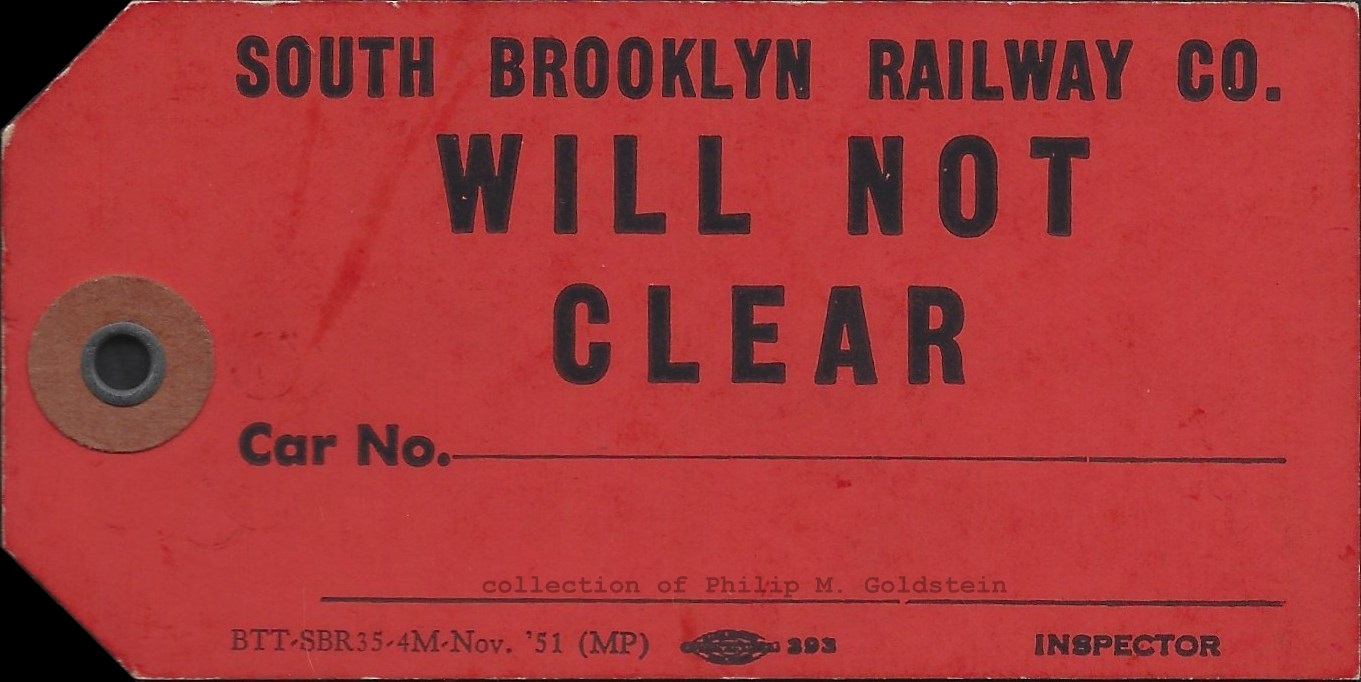 ...
...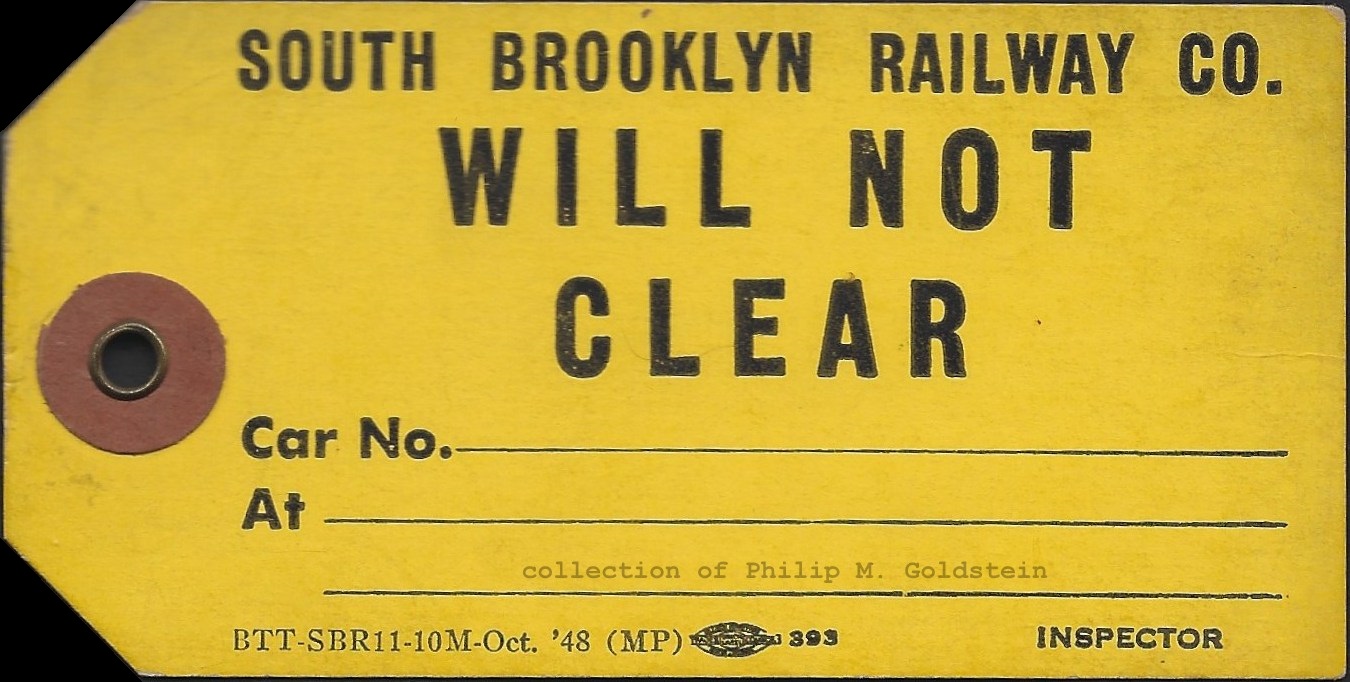 ...
...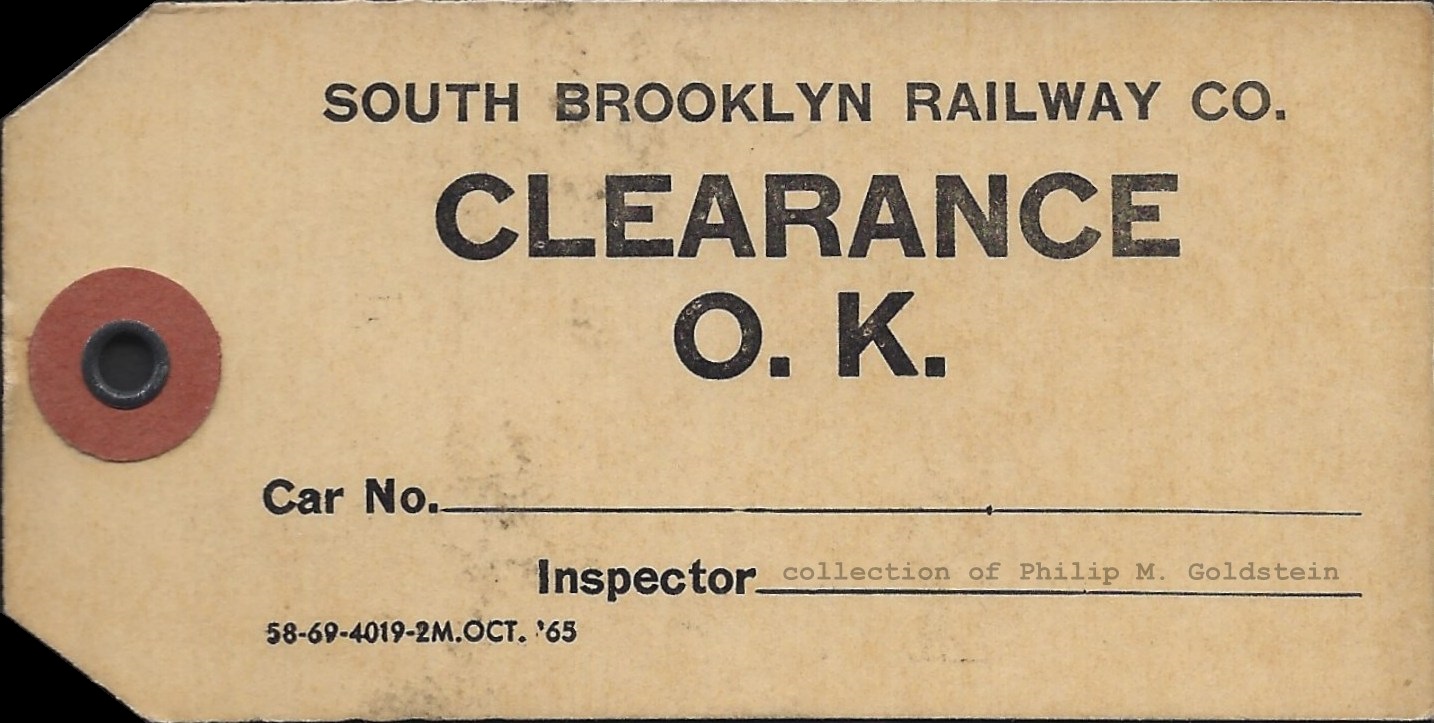
When the train arrives at the Ninth Avenue Station, it must wait until the conductor detrains and walks on track C-2 to the Tenth Avenue Yard, making sure the track is both unoccupied and that the hand throw switch is properly aligned. If Track C-2 is occupied, the train may reverse direction to operate onto Yard Lead Y-2 to the 38th Street Yard, where the train reverses direction again.
Upon arriving at the 10th Avenue Yard, the locomotive(s) (which were coupled to the rear or west end of the train at Fourth Avenue on eastbound movements) are run around, coupled to the east end of the train, where it resumes movement.
Upon leaving the 10th Avenue Yard, the South Brooklyn Railway is now operating on its own right of way under the Culver "El", paralleling 37th Street where most of its customers are located. The train crew must drop the derails north of Fort Hamilton Parkway, as well as raise them after the train has passed. Before crossing avenues, crews must be sure that the traffic light is green. Vehicular traffic must be flagged with red flags. As the train proceeds, it will most likely interrupt an Italian bowling game, bocce; played on a cinder court between the rails. Images can be seen in the Memoirs chapter below.
Trains operate infrequently between Kensington Junction where South Brooklyn right of way and the elevated Culver Line turn south onto McDonald Avenue.
.
.
.
Trackage, Right of Way &
Facilities
.
Rapid expansion of the South Brooklyn Railway soon followed the turn of the century and about this time as the BHRR / SBK began installing freight sidings from established trolley routes into various factories. The first siding is recorded as being build for the Iron Clad Manufacturing Company, which made steel kegs and drums; and was located at Flushing Avenue & Cook Street.
And the South Brooklyn Railway delivery network was vast. By referencing that 1914 article, we can see by the list of delivery stations in Brooklyn as far north as Greenpoint, as far south as Coney Island, as far west as Bay Ridge, and surpisingly, as far east as Jamiaca, Queens. If there was a set of trolley tracks in the street, you can be pretty sure the South Brooklyn Railway had an agreement with the owning railway operator to deliver freight along that route. And there were dozens of streetcar line operators throughout Brooklyn. And since the streetcar operators kept getting consolidated into the larger Brooklyn Rapid Transit and then Brooklyn Manhattan Transit conglomerate, it only made sense to keep the freight traffic "in the family".
The following map, circa 1930, shows the surface streetcar routes (solid red lines) of Brooklyn of that date. It has been annotated by the author as such but as one can plainly see, the streetcar network was vast and with it, the early delivery network of the South Brooklyn Railway. It should be noted that not all freight stations and not all customers existed at the same time.
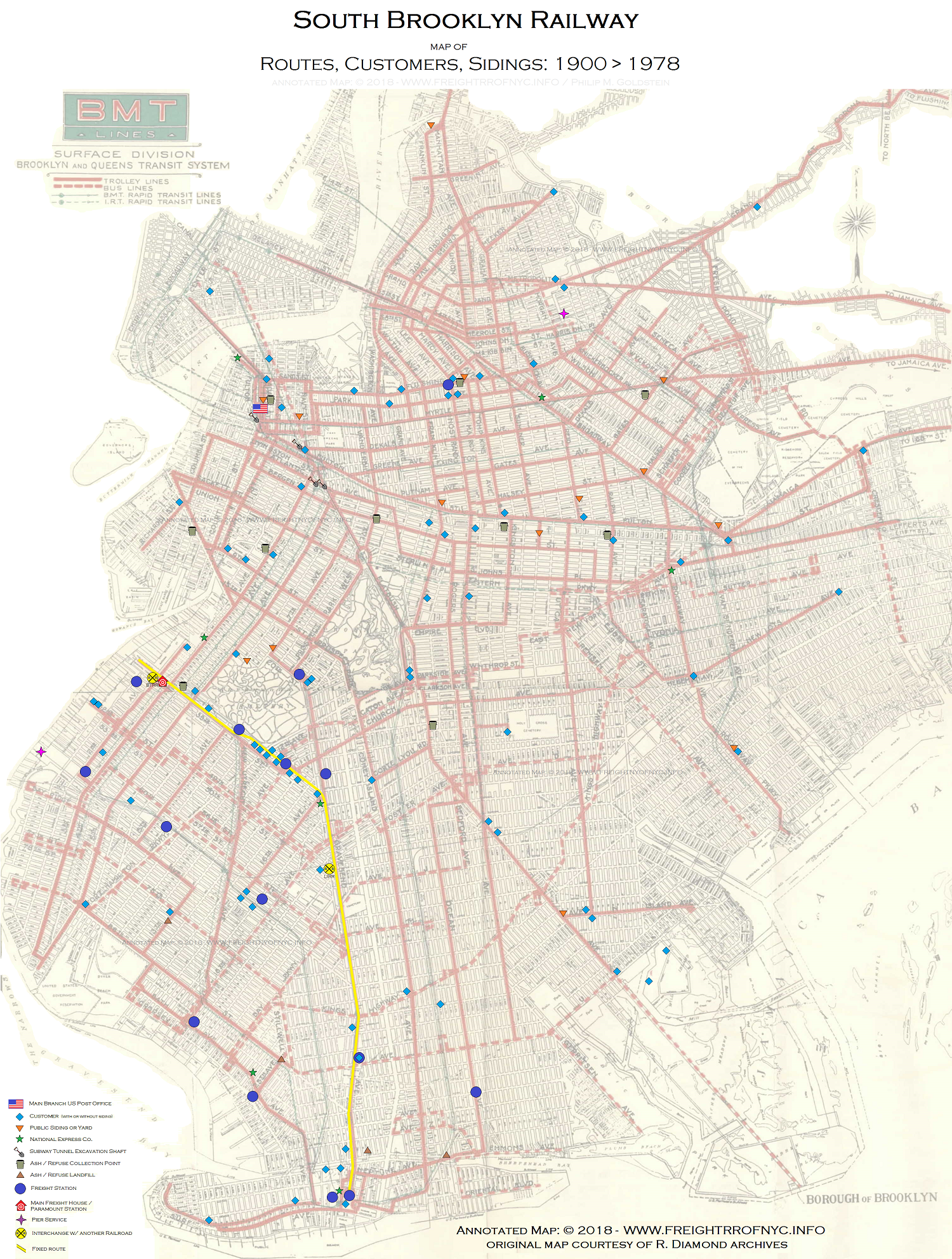
.
.
In 1938, the tracks along McDonald Avenue (formally Gravesend Avenue and so renamed in 1931) was reconstructed. As originally constructed, the horse and automotive lanes to the outside of the trackage were paved but the railroad right of way was unpaved. Then the overhead elevated line was built in 1920 with the girder supports between the auto lanes / rail right of way. This sort of kept the two types of traffic segregated, but with increasing automobile and truck traffic, more space was needed. So, the 70 pound (per yard) "T" Rail was replaced with 128 pound grooved girder rail and the space between the girder supports graded and paved south of Avenue P.
With the construction of the Belt Parkway in 1940, the private South Brooklyn Railway right of way south of Avenue X and to the east of the Culver Elevated was realigned to the public Shell Road, and the freight yard in the Culver Terminal was relocated to the Coney Island Yard. The southbound track opened for service April 29, 1940 and the northbound track on May 6.
Following the end of passenger streetcar service in Brooklyn on October 31, 1956, (and probably predating that by a bit) the South Brooklyn Railway had a solitary route through Brooklyn when it hauled general freight for customers. And only customers situated along this route could get freight service from the South Brooklyn Railway.
The line began (or ended - depending on your point of departure) at 38th Street and First Avenue Yard
where incoming freight arrived via interchange with the Bush Terminal
Railroad was received. From here, the South Brooklyn Railway route took it though
the neighborhoods of Sunset Park, Greenwood / Borough
Park, Kensington, Parkville, Midwood, Gravesend and Coney Island.
Joe Korman was gracious enough to allow me to use the following
two images from his website
www.thejoekorner.com. These two
images, which are from a New York City Transit Employees internal magazine,
called (what else?) "Transit".
The article was published in the March 1955 issue, and contains some interesting information on the South Brooklyn Railway:. Most importantly, that by this date; the South Brooklyn Railway is illustrated is that solitary dedicated route.
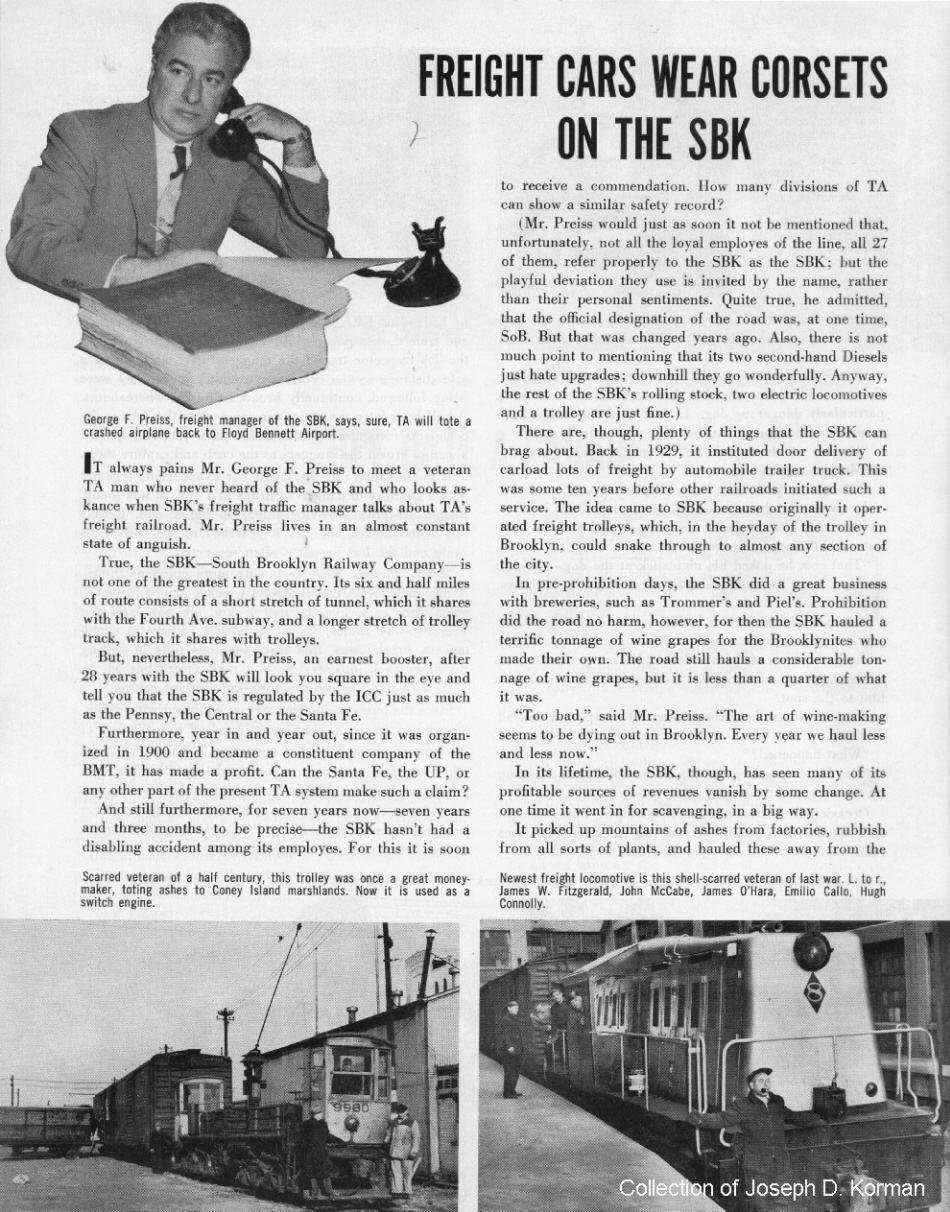
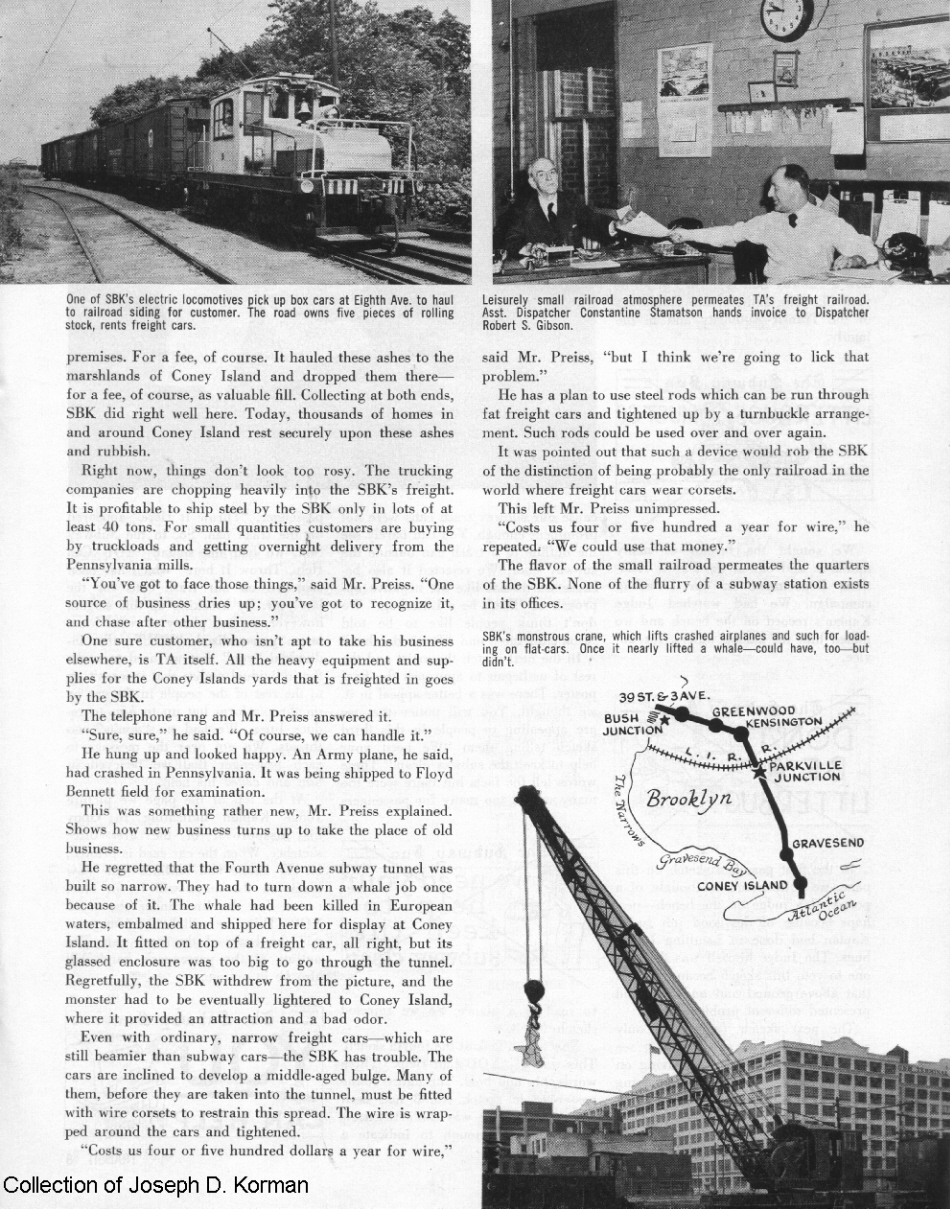
both images above:
March 1955 issue of "Transit Magazine"
collection of Joseph D.
Korman
added 07 Sept 2009
.
.
As of July 2018, we now have two maps at our disposal showing South Brooklyn Railway trackage. Recently discovered in an October 1976 issue of the ERA Bulletin is a map which is dated 1960. I took a little time and effort and cleaned it up for legibility. While there are not too many differences between this map and the Raudenbush map of 1961 below (they are dated within one year of each other), this 1960 ERA map shows the locations of derail and bumping posts (end of tracks) and quite as importantly, the names of a few of the customers served! It is not to scale.
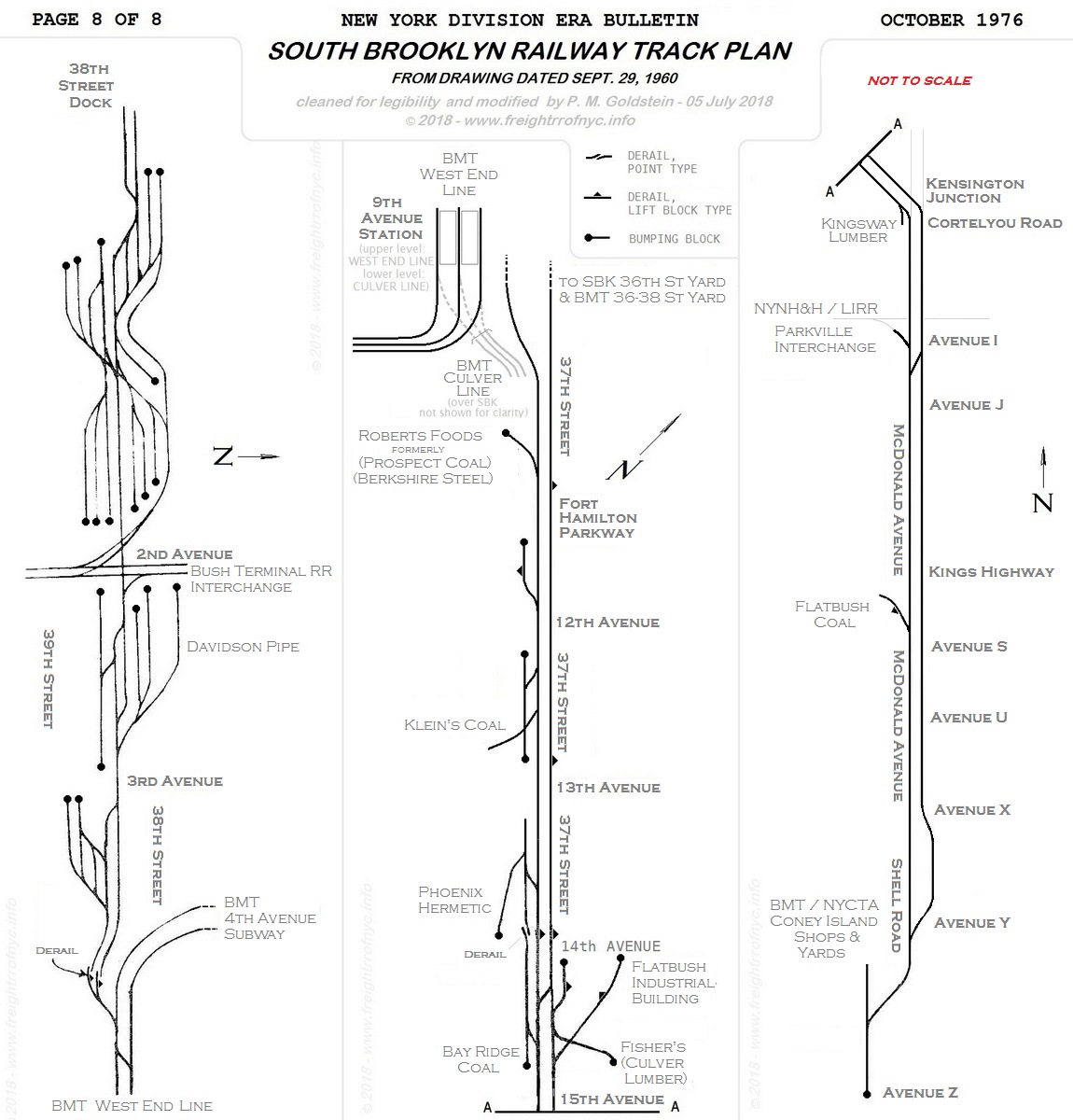
original map courtesy of October 1976 issue Electric Railroaders Association Bulletin
map cleaned and modified by author
added 05 July 2018
.
.

(click on map above for large scale image)
(numbers correspond to map locations above)
While we are discussing the routing of the South Brooklyn Railway, it should be also be noted that it shared a portion of its route with four different subway lines over its history. Adding confusion for a lot of non-Brooklyn railfans as well as modern era NYC Transit buffs, was that these four different subway lines used various or the same parts of the Culver Elevated over its the history. While this technically has nothing to do with the actual operation of the South Brooklyn Railway, it does reflect why subway cars on the elevated lines in those photos taken throughout the decades have different route letters displayed. Further confusing matters on Transit Maps was that the line "bullets" (the colored circles) changed colors throughout the years.
 |  |  |  | 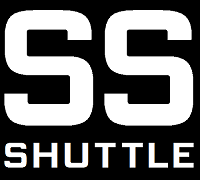 |  |  |
| Culver Line | Culver Line | Culver Line | Culver Line | Culver Shuttle | Culver Shuttle | Culver Shuttle |
| 1925 - 1954 | 1954-1967 | 1967-1979 | 1979-present | 1954-1960 | 1960?-1967 | 1968-1975 |
Beginning in 1925, with the delivery of the BMT D Type or "Triplex" cars and the IND R1 cars in 1931, head end destination signs were incorporated into the design. The line that followed the South Brooklyn Railway routing was known as the BMT 5 or Culver Line.
Commencing from the lower level of the Ninth Avenue Station at 37th Street, the BMT  took to an elevated structure directly over the South Brooklyn Railway
right of way. This elevated line turned south at Kensington Junction and
continued over Gravesend Avenue. This elevated was completed in several stages throughout 1919 until gradually reaching Coney Island in 1920.
took to an elevated structure directly over the South Brooklyn Railway
right of way. This elevated line turned south at Kensington Junction and
continued over Gravesend Avenue. This elevated was completed in several stages throughout 1919 until gradually reaching Coney Island in 1920.
In 1932, Gravesend Avenue would be renamed McDonald Avenue (in honor of John. R. McDonald, chief clerk of the Brooklyn Surrogate’s Court, who died suddenly).
In 1954, with the construction of the IND Culver Ramp between
Church Avenue and Ditmas Avenue completed, the BMT Culver Elevated was
transfered to the IND Division, becoming the IND Culver Elevated, but
the BMT  train began running upon the Culver Elevated over McDonald Avenue from Ditmas Avenue to Coney Island. Also on this date, the BMT
train began running upon the Culver Elevated over McDonald Avenue from Ditmas Avenue to Coney Island. Also on this date, the BMT  route was truncated. This now shortened route operated between Ninth Avenue (lower level) and Ditmas Avenue and was designated the Culver Shuttle
route was truncated. This now shortened route operated between Ninth Avenue (lower level) and Ditmas Avenue and was designated the Culver Shuttle  .
.
In 1960, the Culver Shuttle  was given the new graphics route bullet:
was given the new graphics route bullet: which in turn became the
which in turn became the  in 1968. These new bullets appeared only on the maps because in fact
the older equipment relegated to the actual shuttle service was not
equipped with the new graphics.
in 1968. These new bullets appeared only on the maps because in fact
the older equipment relegated to the actual shuttle service was not
equipped with the new graphics.
On November 26, 1967 with the opening of the Chrystie Street Connection in Manhattan, the  operating over the Culver Elevated was replaced with the
operating over the Culver Elevated was replaced with the  Culver Line / Sixth Avenue Local.
Culver Line / Sixth Avenue Local.
On May 11, 1975, the  Culver Shuttle service was abolished.
Culver Shuttle service was abolished.
In 1979, the color of the subway line bullets were changed
to reflect and color coordinate their primary Manhattan routing. Therefore the  became the
became the  (with the orange color denoting Sixth Avenue routing regardless of being express or local)
(with the orange color denoting Sixth Avenue routing regardless of being express or local)
The Culver Shuttle
elevated structure would not be demolished until the mid 1980's, well after the South
Brooklyn Railway right of way under the el had been abandoned in 1978. The  still operates on the elevated over McDonald (formerly Gravesend) Avenue.
still operates on the elevated over McDonald (formerly Gravesend) Avenue.
And if this didn't help you figure it out, nothing will.. My head still spins trying to figure it out too. So let us get back to the SBK, shall we? ☻
Location List
.
1) 39th Street Yard & Terminal
- Sunset Park
The northwestern-most point of the trackage was the ferry terminal and storage yard located between 39th and 38th Streets between Second Avenue and the Upper New York Harbor bulkhead. Also at this location, the South Brooklyn Railway connected with ferries and a loop track was in place for turning trolley cars.
Randall Auguste was generous enough to allow the use of the following two plates from his 1912 Belcher Hyde Atlas of Brookyn. In them, we can view early track and building arrangements of the Brooklyn Rapid Transit / South Brooklyn Railway facilities in the Sunset Park area.
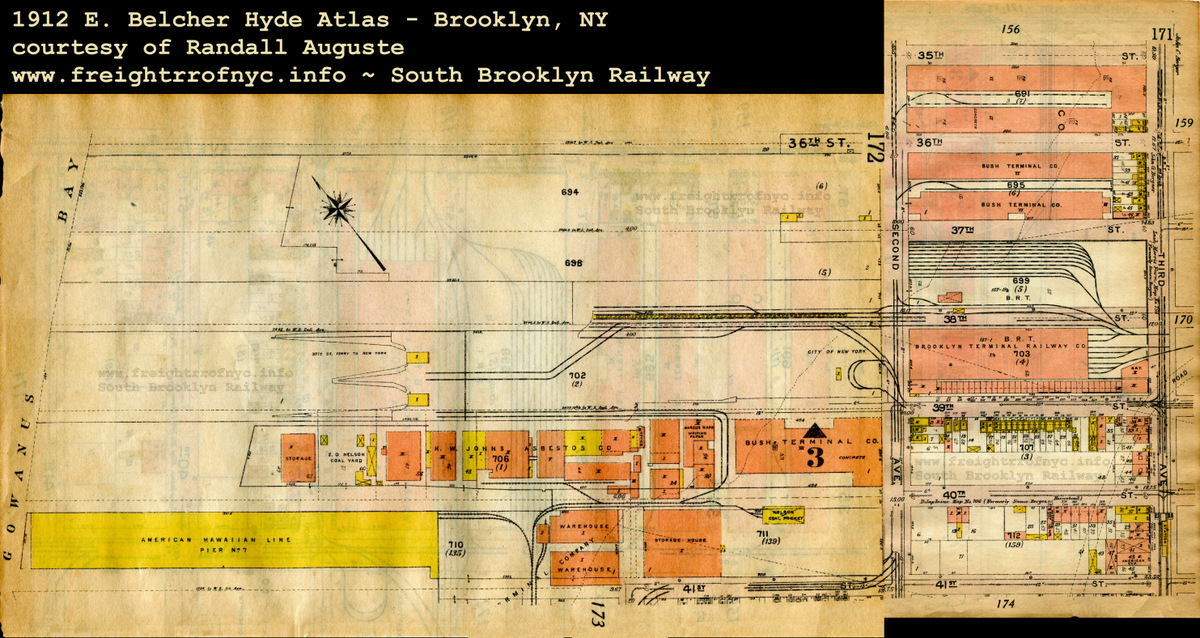 |
| 1912 E. Belcher Hyde Atlas of Brooklyn, NY courtesy of Randall Auguste (two plates scaled and merged by author) added 18 April 2021 |
On 02 January 2010, Joe Roborecky located two maps in the Library of Congress' Historic American Buildings Survey / Historic American Engineering Records; U.S. Navy Fleet Supply Base, Brooklyn, Kings County, NY.
Referencing these two maps, it appears that the Brooklyn Rapid Transit / South Brooklyn Railway sold a portion of its property to the US Navy, which went on to build its own yard and railroad upon this land.
The first map is undated but appears to be circa 1913, as the proposed (but not constructed) "South Brooklyn Marginal Railroad" is shown. It appears that the Brooklyn Rapid Transit trackage extended to and occupied a pier north of the Ferry Terminal. Notice how 38th Street is still a through street. You may click on the map below to bring you to a larger version. Use your back arrow to return you here:
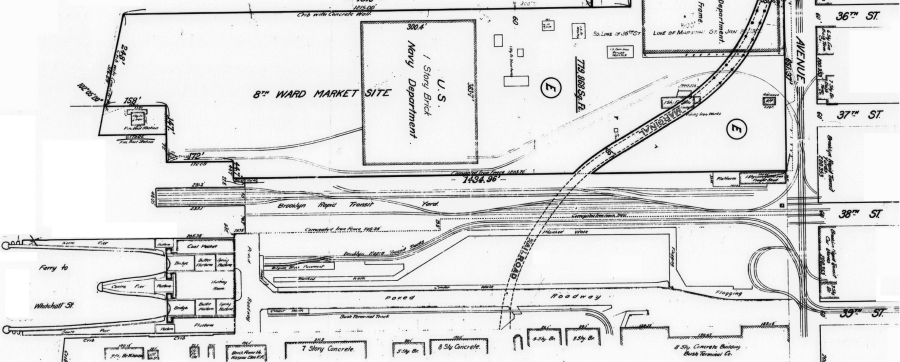
Brooklyn Rapid Transit / South Brooklyn Railway, Brooklyn, Kings County,
NY - circa 1913
Library of Congress - Historic American Buildings Survey
Historic American Engineering
Records
added 02 January
2010
.
The second map is dated August 20, 1919 and shows a great deal more trackage and a significant yard belonging to the US Navy abutting the north property line of Brooklyn Rapid Transit Yard (which is the South Brooklyn Railway and unfortunately this trackage is not shown in detail).
However, if you take note; the pier north of the ferry terminal is now flanked by a pair of float bridges ("terminal bridges"), and according to the legend the trackage is now marked for the US Navy (solid lines = Navy RR, broken lines = other RR).
Also take notice that the 38th Street thoroughfare is no longer shown and the "Property of the South Brooklyn RR" is now a two block parcel. It is this parcel which would become Davidson Pipe Yard in later years.
Again, you may click on the map below to bring you to a larger version. Use your back arrow to return you here.
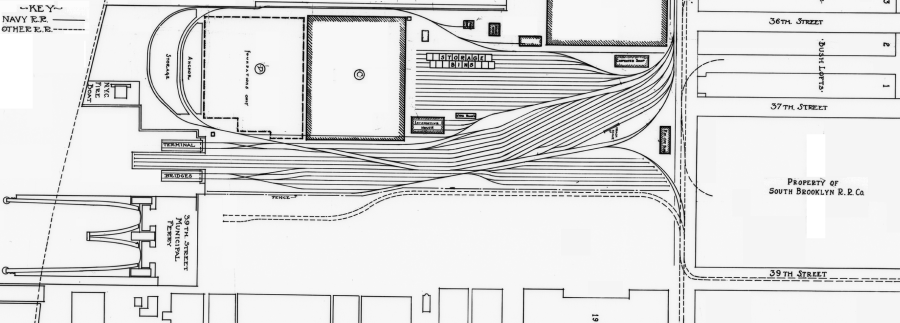
Brooklyn Rapid Transit / South Brooklyn Railway
(U.S. Navy Fleet Supply Base), Brooklyn, Kings County, NY - August 20,
1919
Library of Congress - Historic American Buildings Survey
Historic American Engineering
Records
added 02 January 2010
.
So at the least, it appears that Brooklyn Rapid Transit sold part of its property to the US Navy for the construction of their supply base. The Navy would continue to occupy that piece of property abutting the South Brooklyn Railway's 39th Street Yard through at least the 1950's. Whether this property was sold voluntarily or involuntarily by Brooklyn Rapid Transit to the US Government remains to be discovered.
(If by chance you are interested in the Navy operation, I have authored a webpage on that history and of which may be read here: US Navy Fleet Supply Base - South Brooklyn Section)
In 1930, in an effort to compete with trucking companies, the South Brooklyn Railway entered into contract with the Horstmann Trucking Corporation to handle interchange freight at this location. In the tariff filings, this location was called "Paramount Station, Brooklyn, NY". This venture was short lived unfortunately, due to the extra expense in having to offload the freight into trucks to deliver the freight off the South Brooklyn Railways' route.
The closest item that has surfaced to date that reflects the track structure of the South Brooklyn Railway at this location in the 1940's, is a Port Facilities & Terminals Map dated 1942. As the property between Second & Third Avenues that would become Davidson Pipe Yard was still in fact owned and part of the South Brooklyn Railway during the time of this map, it is shown here for continuity.

Port Facilities & Terminals Map - 1942
US Army Corp of Engineers
authors collection
added 02 January 2010
.
When passenger service ended on the South Brooklyn Railway in 1958, this yard became strictly freight. At some point in time (exact date unknown) after 1958 and 1966, the trolley loop would be removed and the yard would be rebuilt. The following configuration closely (but not exactly) represents that trackage:
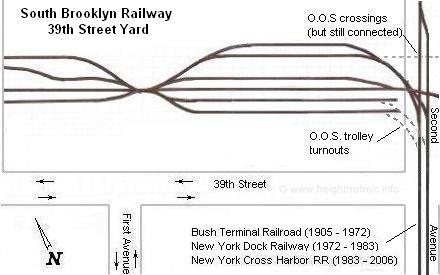
39th Street Yard & "Bush Junction" - ca. 1905 -
1994
.
In 1994, the interchange trackage was rebuilt and in 2000, the yard itself would be reconstructed. The diagram below is representative of both of those changes and show the current track configuration.
A gate on the west border of the 39th Street Yard allows two tracks to exit the yard and enter the South Brooklyn Marine Terminal (no affiliation with the South Brooklyn Railway). These two tracks merge and form a single track which services a set of loading docks located along the north wall of the pier shed. This pier shed was the location of American Stevedoring. This location is situated upon the site of the old 39th Street Ferry Terminal.
Oddly, the South Brooklyn Railway did not service this customer, but in fact the New York Cross Harbor Railroad did. This Marine Terminal is currently vacant and sees no rail service; but as of 2010, it is under extensive reconstruction and rail operations are part of the plan.

39th Street Yard & "Bush Junction" - 1994 -
2003?
.
.
Readers Please Take Note:
It is now understood from documents located on the web, that the 39th Street Yard is now part of the South Brooklyn Marine Terminal property which is owned by the Port Authority of New York & New Jersey, and operated by Axis Group; and the 39th Street Yard is no longer owned or operated by the South Brooklyn Railway / New York City Transit Authority / Metropolitan Transportation Authority.
As current data reflects that the South Brooklyn Railway / New York City Transit Authority / Metropolitan Transportation Authority no longer has interest in the 39th Street Yard ; all updates pertaining to this location, will be posted in the South Brooklyn Marine Terminal chapter of the New York New Jersey Rail page of this website.
.
.
2) Bush Terminal / South Brooklyn
Railway Interchange a/k/a "Bush Junction"
On Second Avenue, there was interchange with the Bush Terminal Railroad until 1972, when New York Dock assumed operation of the Bush Terminal properties. In August 1983 the New York Cross Harbor Railroad was organized (absorbing the New York Dock operation) and this company operated until 2006. At this time, the operation was renamed New York New Jersey Rail, and taken over by Port Authority of New York & New Jersey and became a government subsidiary.
It is this location that is referred to as Bush Junction and is shown below.
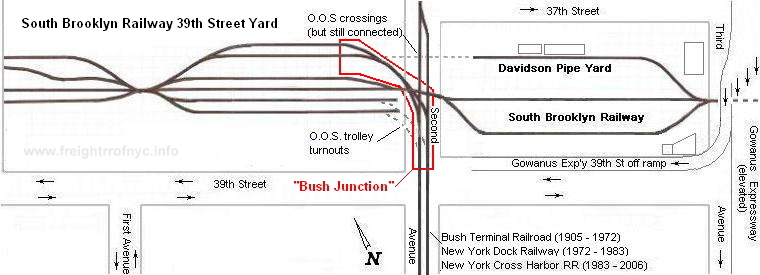
"Bush Junction" 1905 - 1994
.
Before we go any further, it is imperative to understand that the Bush Terminal Railroad (and likewise its successors) had a significant involvement in South Brooklyn Railway history. For it was at Bush Terminal where freight cars destined for and from the South Brooklyn Railway customers had arrived and departed from Brooklyn via the Bush Terminal float bridges.
Without the float bridges at Bush Terminal, the South Brooklyn Railway would not have been able to received or ship freight cars nor would it have lasted long as it has.
Throughout the decades, countless new subway cars arrived at, and many obsolete subway departed via carfloats at the 50th Street float bridges of the Bush Terminal Railroad:
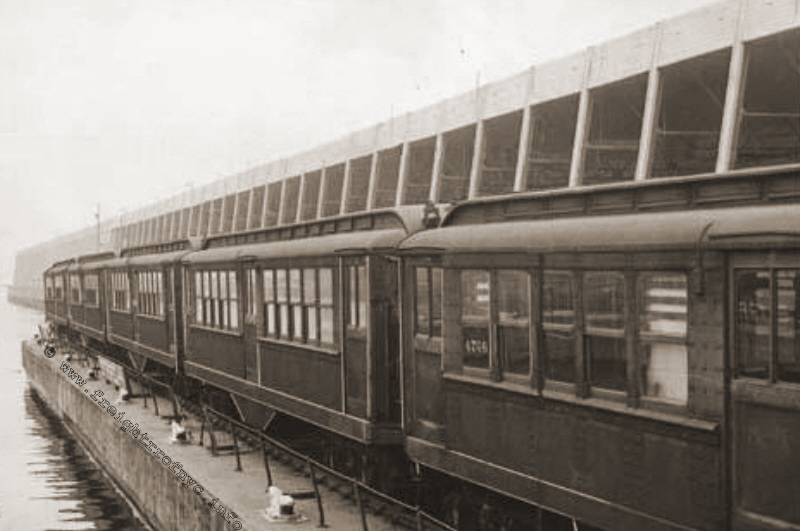
Bush Terminal 50th Street Floatbridge - April 24,
1950
"Seagoing subway cars - Somewhat out of their natural element, cars being
transferred
from Queens IRT line to Bronx shops make detour through Brooklyn by way of
Bush Terminal dock."
Brooklyn Eagle Newspaper archives
Brooklyn Public Library
added 22 Dec 2009
.
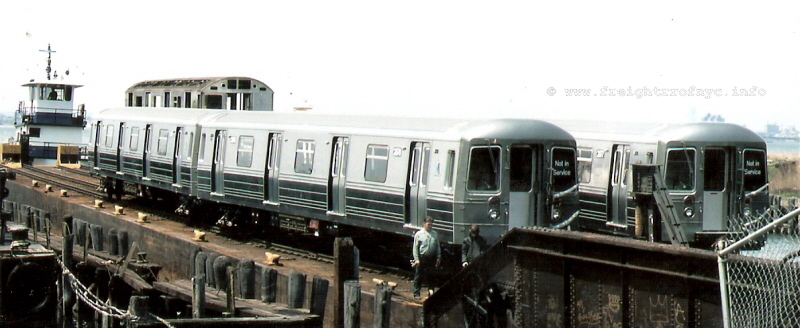
Bush Terminal 50th Street Float Bridge "Bush 1" (southern
float bridge) - ca. 1985 - 1987
R68's on left and right tracks with an R32 loaded on flat car on center
track.
unknown photographer
added 22 Dec 09
.
Once new cars arrived at Bush Terminal, they would then be moved by Bush Terminal locomotives to the South Brooklyn Railway Yard at 39th Street and Second Avenue. From here, South Brooklyn Railway locomotives would bring them to the NYCTA Yard at either 36th Street or Coney Island.
Freight cars however, would be distributed to the various customers (when they existed) along the South Brooklyn Railway route by South Brooklyn locomotives.
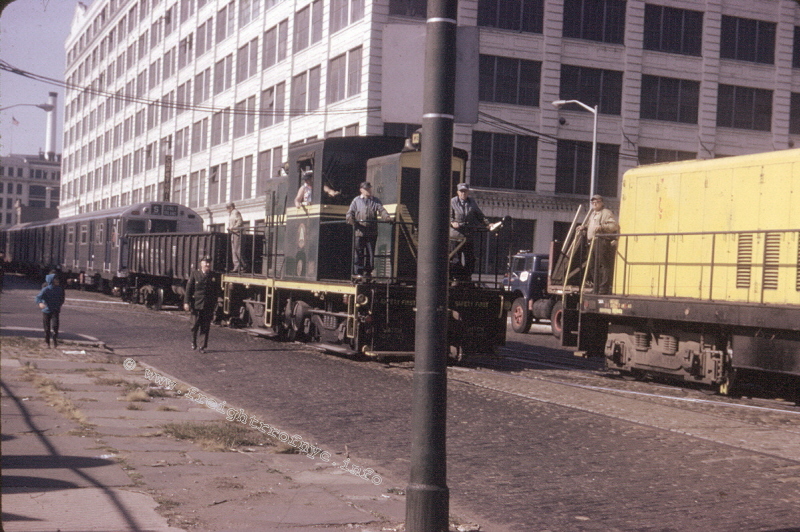
Bush Terminal RR #2 and South Brooklyn Railway #13
- September 28, 1965 - Second Avenue & 38th Street
Brand new R32's arriving at the BTRR/ SBK Interchange.
BT #2 on northbound track, SBK #13 on southbound track.
G. Landau photo
authors collection
added 22 Dec 09
.
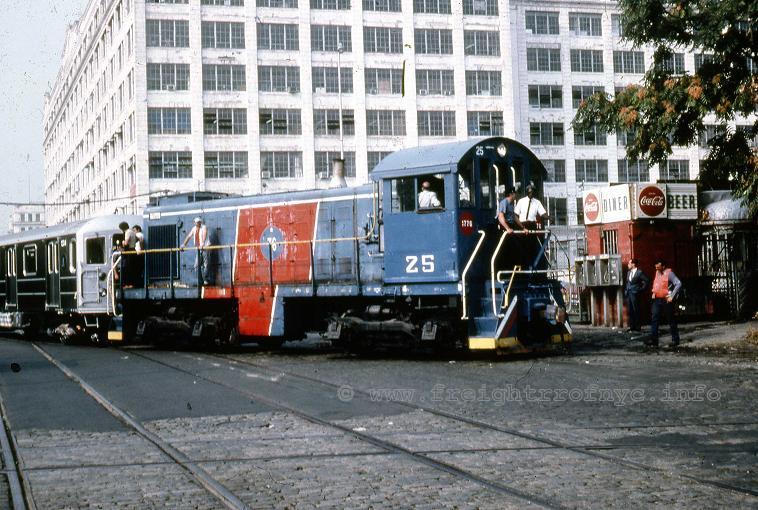
New York Cross Harbor RR #25 - 1983 - Second Avenue
& 38th Street
Brand new R62's arriving at the BTRR/ SBK Interchange.
NYCH #25 is ex-BEDT #25 ALCo S1 coming off northbound track and
is about to enter the South Brooklyn Railway's 39th Street Yard.
unknown photographer
P. F. Strubeck
collection
added 22 Dec 09
.
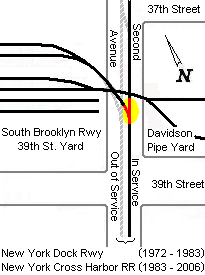 Reportedly, when delivery
of the first R68's was made on February 4th, 1986, they failed to negotiate
a sharp curve on South Brooklyn Railway trackage on 38th Street in Brooklyn.
Supposedly, this curve had to be rebuilt and the radius eased somewhat; with
delivery finally occurring on February 26th, 1986.
Reportedly, when delivery
of the first R68's was made on February 4th, 1986, they failed to negotiate
a sharp curve on South Brooklyn Railway trackage on 38th Street in Brooklyn.
Supposedly, this curve had to be rebuilt and the radius eased somewhat; with
delivery finally occurring on February 26th, 1986.
An inquiry made to Fred Briemann, locomotive engineer on the New York Cross Harbor Railroad at that time; relates that no trackage or curve was realigned for the delivery of these subway cars nor were any delays incurred on a delivery of subway cars to the South Brooklyn Railway.
However, he does recall that the turnout (highlighted in red in diagram to right) on the northbound track of Bush Terminal RR trackage on Second Avenue into the South Brooklyn Railway 39th Street Yard was temperamental, with many cars over the years "picking the points".
It should be kept in mind, trackage at this location was aged, located in a street and abused by heavy commercial vehicular traffic as well as NYC Department of Sanitation snowplows during snow removal. Also contributing to the factor, was that the turnout was a "single point" or "tongue & nape" switch (designed primarily for streetcar / trolley use), see Glossary.
Joe Roborecky adds: this switch point was held in position by a wedge; and the roadbed was "soft", with the rail flexing in a vertical direction under load which contributed to the point moving. Fortunately, speeds were slow and either the "minor derailment" or "unintentional reroute" was remedied immediately.
Therefore, this "point picking" problem could have been misinterpreted by the novice as a radius problem..
The diagram below reflects several changes taking place in 1994
and afterwards:
.
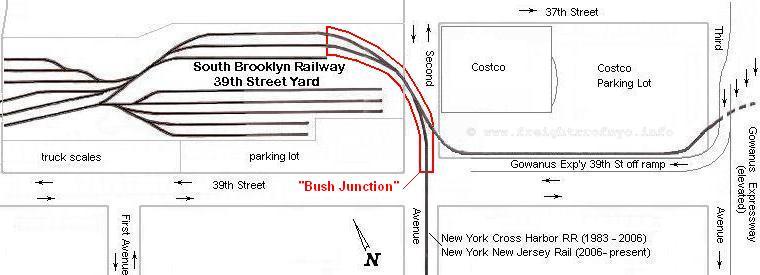
"Bush Junction" 1994 - 2012 (with new 39th Street
yard constructed in 2000)
.
According to research conducted by Paul Strubeck, the contracting firm of T. Glennon of Piscataway, NJ rebuilt the street trackage portion of Bush Junction.
The South Brooklyn Railway Thirty-Ninth Street yard was last used in 2007 as a location for asbestos removal from obsolete subways cars that were outbound and prior to reefing.
Commencing in 2011, the construction and new alignment of trackage of New York New Jersey Rail along First Avenue from 41st Street to 39th Street, as well as the reconstruction of the South Brooklyn Marine Terminal; required the original "Bush Junction" interchange being abandoned. The existing property of the South Brooklyn Railway 39th Street Yard was relinquished to the Marine Terminal property and demolished.
The new interchange for New York New Jersey Rail and South Brooklyn Railway was located to First Avenue and 39th Street, and is reflected by the lime green & orange line segments in the map below. The purple line segments reflect the old yard. This new trackage eliminated the dilapidated street trackage and two 90 degree curves at First Avenue and Forty-first Street and Second Avenue & Forty-first Streetas well as the temperamental Bush Junction turnout (the junction of the red & black striped / orange and yellow line segments).
This new construction also allowed for the installation of conventional two point turnouts as normally used for freight railroad service (as opposed to the lightweight single point tongue & nape switch for streetcars).
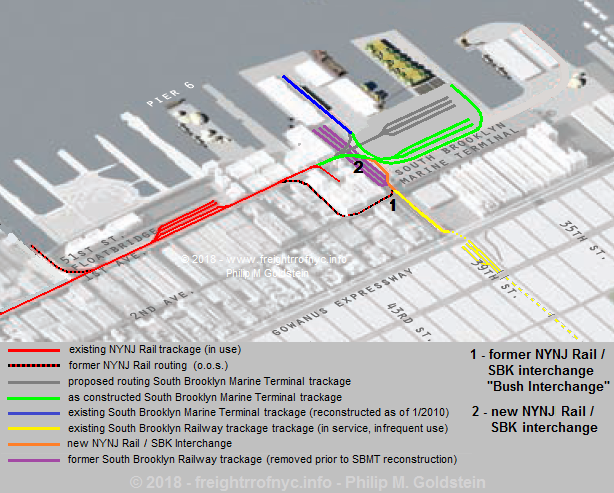
2012 - present: South Brooklyn Railway / New York New Jersey Rail Interchange
and South Brooklyn Marine Terminal track layout.
diagram by author
.
.
This new interchange remains in service as of 2021.
Contrary to erroneous statements and assumptions made in railfan groups on social media, and with utmost thanks to my access to internal sources within the MTA, the delineation line of the South Brooklyn Railroad and New York New Jersey Rail is established at the Second Avenue crossing at 39th Street, in which the legal documents states:
"WHEREAS, the 2nd Avenue Grade Crossing at 39th Street is the point of delineation between NYNJR rail territory and operations and SBK Rail territory and operations, and; WHEREAS, the Parties desire to establish an interchange agreement, to formalize and accurately reflect how interchange traffic emanating from both Parties' facilities will be handled, with the primary interchange activity to be NYNJR delivering rail cars to the SBK Connection Track (as hereinafter defined); and WHEREAS, the parties are willing to enter into this Agreement on the terms and conditions provided herein for so long as the Parties tender rail cars to each other..." |
Therefore, it is simple: west of Second Avenue crossing is NYNJ
Rail, east of the crossing is South Brooklyn Railway. Not Third Avenue,
not the Bush Terminal Yard, and not 65th Street Yard. Precisely where
it is shown on the map below.

2012 - present: South Brooklyn Railway / New York New Jersey Rail Delineation Point
(North is to the right)
annotated map by author
not to be reused or reproduced without consent.
added 18 April 2021
.
.
3) Davidson Pipe Yard - SBK
Offices
Traveling east from Second Avenue, the tracks run on through a two block parcel bordered by 39th and 37th Streets, Second and Third Avenues.
In the years prior to circa 1959; this was another modestly sized railyard of the South Brooklyn Railway. As seen in a historicaerial.com aerial photo dated 1954, there were many team tracks in this location. This image is quite blurry, so the exact track layout is indeterminable. According to Peter Davidson, this was the site of a brickyard prior to Davidson Pipe moving here. Eventually, Davidson Pipe purchased the property from the City of New York.
Paul Strubeck sent the following scan on 25 December 2009. While it states the location of the South Brooklyn Railway to be at 370 Jay Street, (which is the Headquarters of the New York City Transit Authority) the other address shown is 990 Third Avenue. Research shows this location to be the Davidson Pipe Yard.
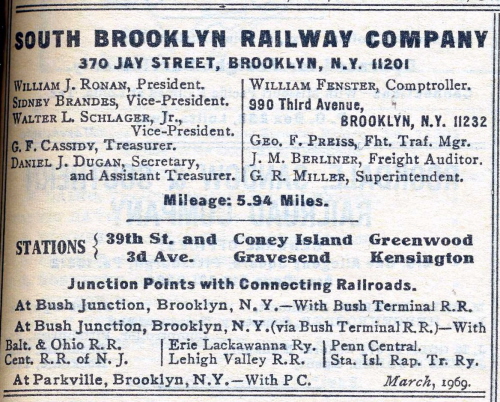
.
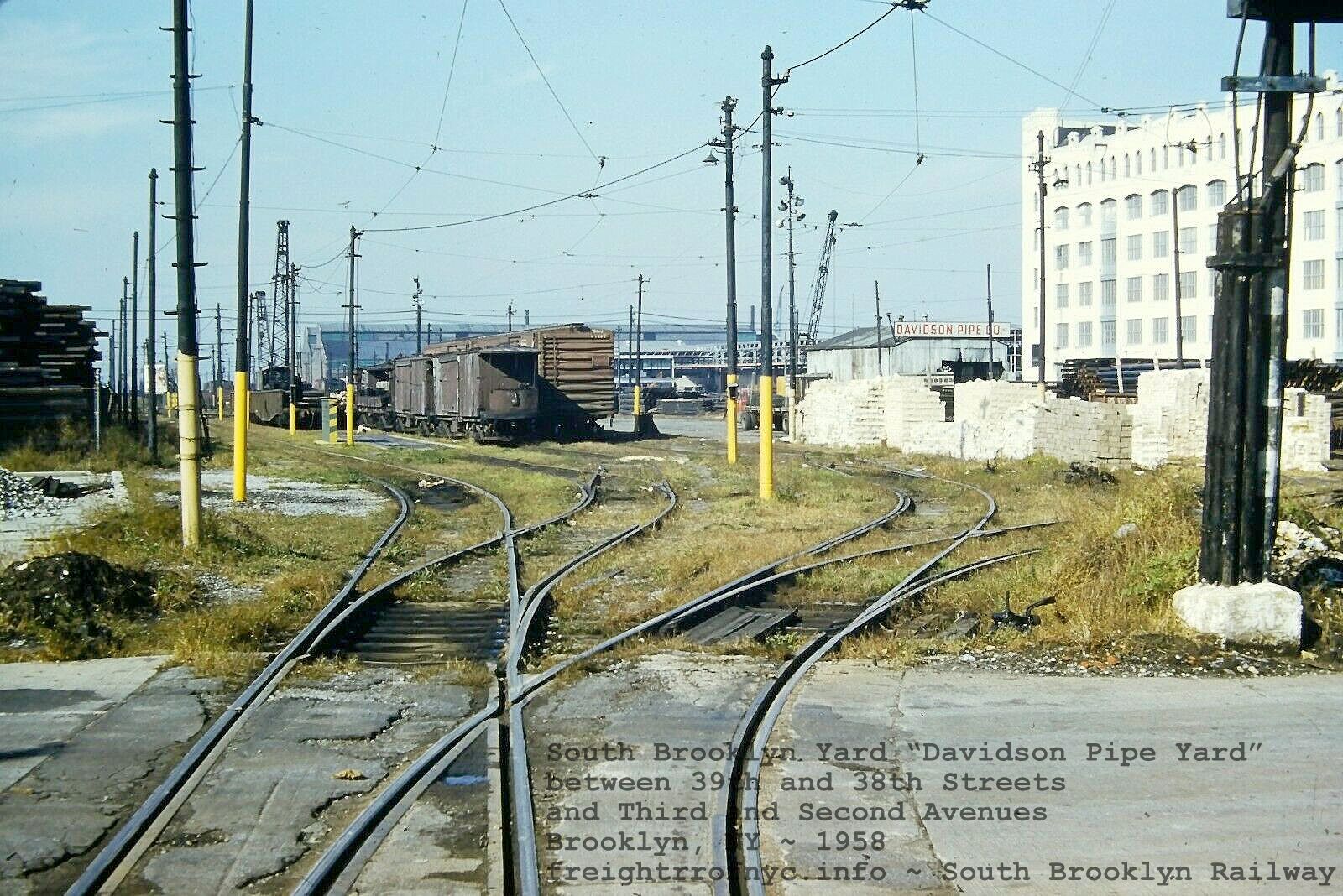
South Brooklyn Railway Yard - 1958
"Davidson Pipe Yard" between 39th & 38th Streets and Third & Second Avenues (looking west)
unknown photographer
added 31 October 2022
.
Davidson Pipe would occupy this location, which was known simply as the "Davidson Pipe Yard". Tall stacks of pipe of many types and varieties were stored in this yard for commercial resale. Davidson Pipe was a large and very significant customer for the South Brooklyn Railway and countless gondolas were brought in by the South Brooklyn Railway for unloading here. Davidson Pipe would also be South Brooklyn Railway's last "non-Transit Authority" customer.
It appears (but is unconfirmed) that the pipe was simply stacked on the trackage rendering it out of service. However three tracks would remain unblocked for use: the northern track, effectively made a dead end siding by a pile of pipe (the track continued under this pile to a 90 degree street crossing on Second Avenue); a middle "through track" that ran straight through the yard; and the southern "runaround track", but also a through track.
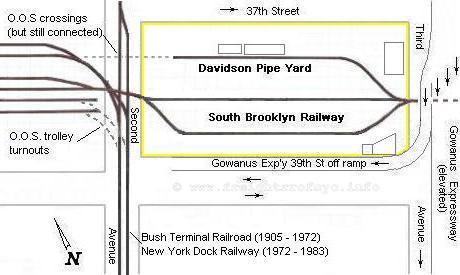
Davidson Pipe Yard: ca. 1960 - 1994
.
.

Davidson Pipe unloading Erie Lackawanna gondola #43599
W. Schneider photo
J. McCluskey collection
added 07 November
2016
..
On 28 December 2009, I contacted Mr. Peter Davidson, of Davidson
Pipe; which is still located in the Sunset Park area of Brooklyn. Mr. Davidson
was gracious enough to take some time out of his busy schedule to answer
a few questions regarding their occupancy of the property at 39th Street
& Third Avenue:
.
Prior to Davidson Pipe's occupancy, there was a brickyard
located at this location. It was not in business long, and Davidson Pipe
took over the property circa 1959.
.
During their presence, Davidson Pipe would receive
between 5 and 10 carloads of pipe per week (which was brought in from New
Jersey by the Bush Terminal Railroad and subsequently New York Dock
Railway and then New York Cross Harbor Railroad). These cars would be placed
in the South Brooklyn Railway Yard at 39th & Second Avenue, and
the South Brooklyn Railway would spot the carloads of pipe within the
Davidson Pipe property.
.
At this yard was a main building; which housed the
Davidson Pipe yard office, the freight offices of the South Brooklyn Railway
(which explains why the locomotives were stored in the yard) and another
city agency.
.
As far as Mr. Davidson recalls in the later years,
other than Davidson Pipe themselves; there was only one other "non-NYCTA"
customer (a cocoa warehouse), but they did not receive freight traffic
often.
.
Mr. Davidson might have some images of the Davidson Pipe Yard operation, but needs some time to locate them, so stay tuned for further updates.
In 1994, Davidson Pipe closed this yard.
They were the last non-NYCTA customer for the South Brooklyn Railway. The property was subsequently sold to Costco (the wholesale membership club), and due to their construction plans, the South Brooklyn Railway right of way would have to be relocated from the middle of the property to the extreme southern edge.
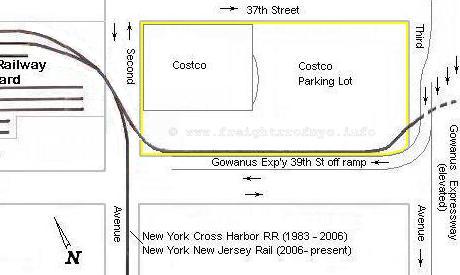
Costco: 1994 - 2012
Exiting east out of the Davidson Pipe Yard (and now Costco), the tracks would cross Third Avenue. Prior to the construction of the Gowanus Expressway, the tracks crossed Third Avenue, which was a "simple" two way street. When the Gowanus Expressway (elevated) was constructed in the 1940's, Third Avenue would be widened to accommodate the elevated superhighway, and this became a "major" crossing, with tracks now having to cross 3 lanes of southbound traffic, a wide island in the middle, (in which the supports for the Gowanus Expressway are located) and then three lanes of northbound traffic.
.
.
4) 38th Street between Third &
Fourth Avenue Yard - "Unloading Yard"
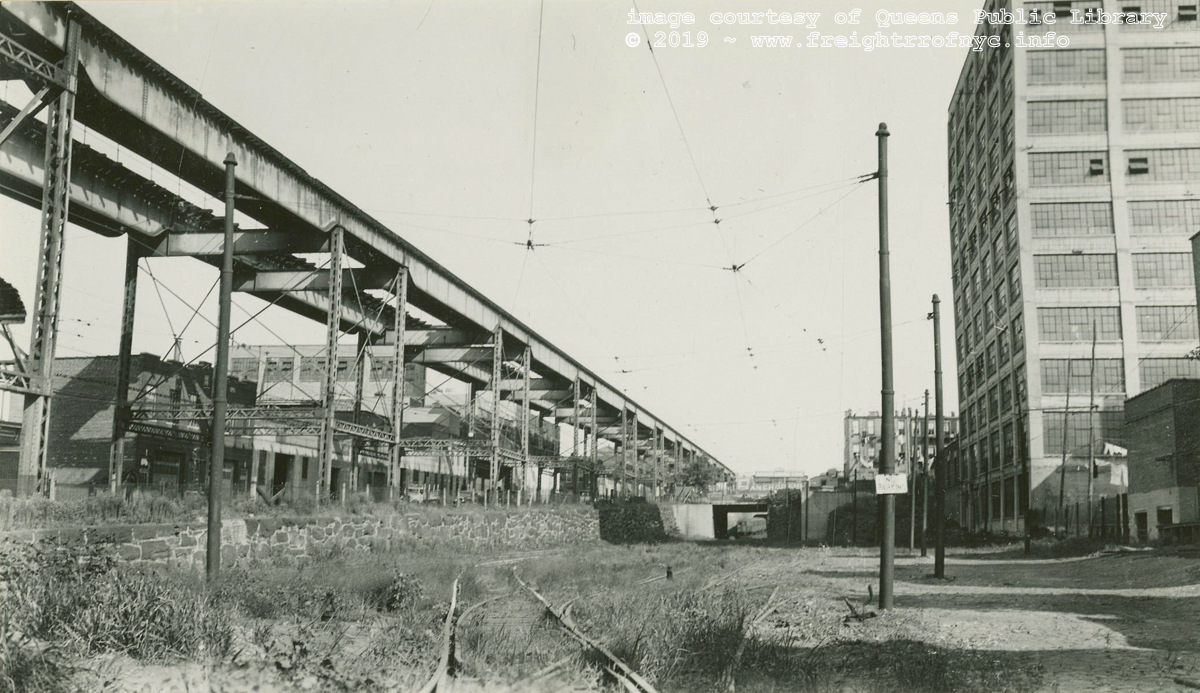
38th Street Yard - 1935
looking east from Third Avenue, with the Bay Ridge - Fifth Avenue Shuttle elevated.
Note the subway train through the overpass and about to turn north up the Fourth Avenue Line over 38th Street.
William J. Rugen photo
image courtesy of Queens Public Library Digital Archives
color corrected by author
added 21 May 2019
.
.
38th Street Yard - 1940
looking west from Fourth Avenue overpass, with the Bay Ridge - Fifth Avenue Shuttle elevated over 38th Street.
unknown photographer (possibly a William J. Rugen photo)
courtesy of New York Historical Society archives
added 31 October 2022
East of the Third Avenue crossing would be another small yard. Upon the demolition of the Bay Ridge / Fifth Avenue elevated commencing September 15, 1941 and the construction of the Gowanus Expressway an off ramp was needed. The yard would be reconfigured to accommodate this. The above image shows the yard before said reconfiguration.
In later years, at this location was the ramp built of railroad ties with rectangular structural tubing laid upon it and kept in gauge by welded cross braces. This ramp was used to load / unload subway cars that were transported on top of flat cars. To my understanding, this ramp has not been used in quite some time.
With thanks to Dave Pirmann, I was finally able to secure images of this ramp in use, and these photos can be seen in the Locomotive Photo section below.
At the east end of this yard, the right
of way begins to run subgrade under Fourth Avenue (actually the land contour
rises). This tunnel entrance can be seen by the chain link gates and interlocking
signals in the photo below. The South Brooklyn Railway enters the former
Brooklyn Manhattan Transit "BMT" West End
![]() line (current NYCTA
line (current NYCTA
![]() &
&
![]() subway lines) at this
point.
subway lines) at this
point.
From this point, it runs for about half a block in open subgrade and then enters a tunnel to yet another railyard located a block and a half east at Fifth Avenue.
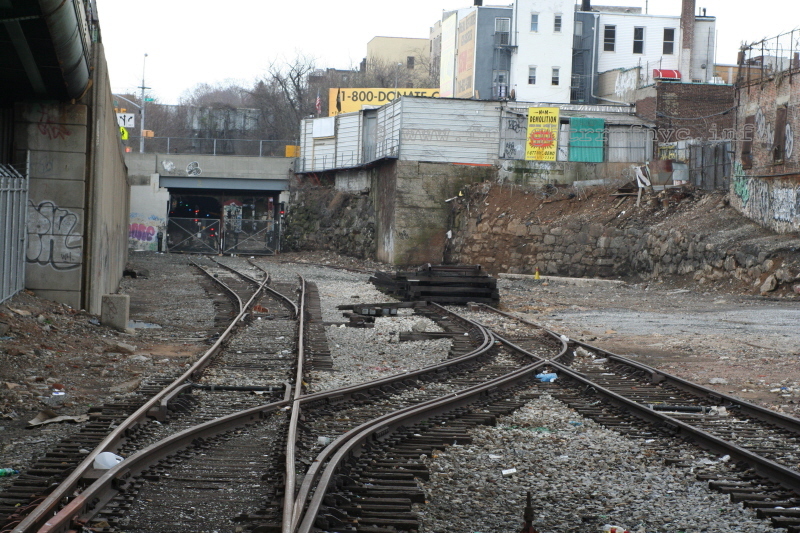
South Brooklyn Railway "38th Street Yard" between Third and Fourth Avenues
and 38th Street - April 13, 2008
looking southeast, showing the subway car unloading ramp.
Fourth Ave and interchange with subway interchange in background.
P. F. Strubeck
photo
added 16 Dec 2009
.
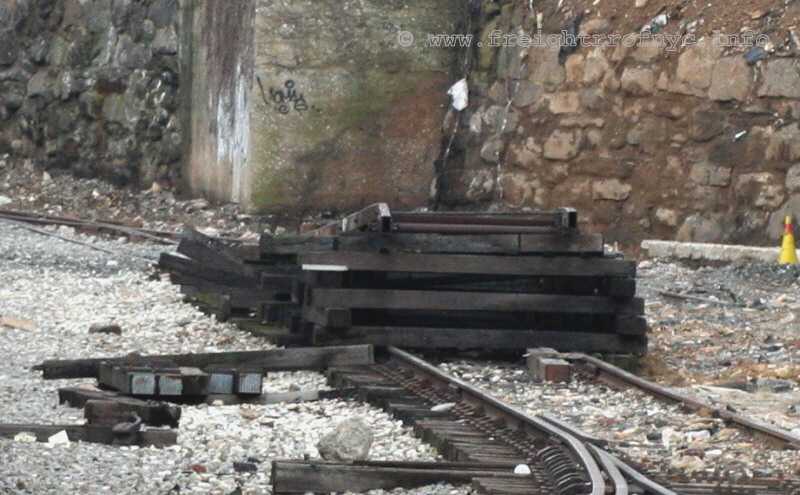
Close up of unloading ramp. Yes, this is what the New
York City Transit Authority used
to unload subway cars that were transported on top of flatcars.
P. F. Strubeck
photo
added 16 Dec 2009
.
.
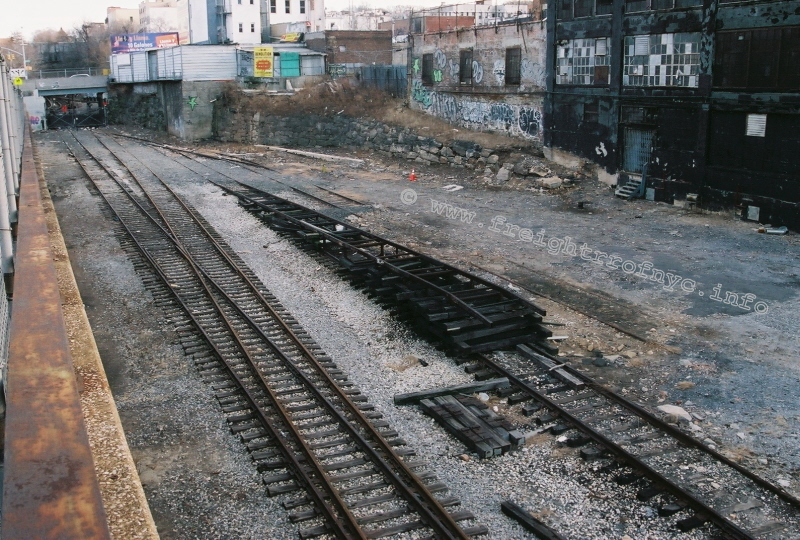
South Brooklyn Railway "38th Street Yard" between Third
and Fourth Avenues and 38th Street - January 26, 2010
Looking east toward Fourth Avenue and subway interchange
with subway car unloading ramp.
P. M. Goldstein photo
added 03 May 2012
.
.
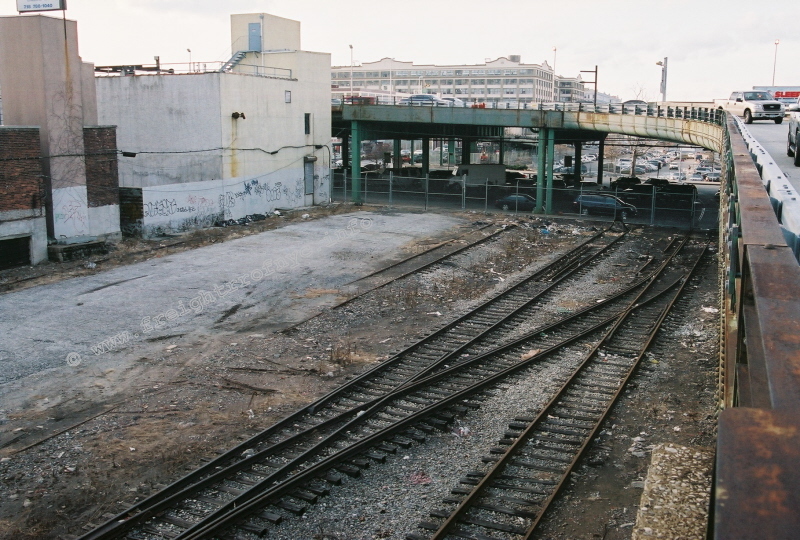
South Brooklyn Railway "38th Street Yard" between Third and Fourth Avenues
and 38th Street - January 26, 2010
Looking west toward Third Avenue grade crossing and
CostCo parking lot (under Gowanus Expressway).
P. M. Goldstein photo
added 03 May 2012
.
.
As of late April 2012, this yard has been cleaned up of rubbish and being reconstructed for intended interchange with New York New Jersey Rail..The original subway car unloading ramp seen in the above images has been removed, but allegedly it will be replaced by a new unloading ramp reportedly to be installed by the manufacturer of the new locomotives.
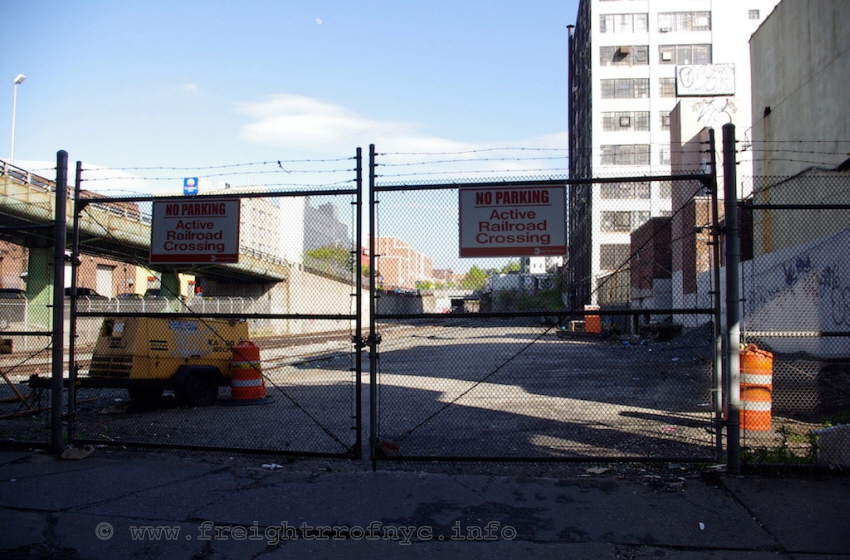
South Brooklyn Railway "38th Street Yard" between Third
and Fourth Avenues and 38th Street - May 1, 2012
New signs on vehicle entrance gate.
J. McCluskey
photo
added 03 May 2012
.
.
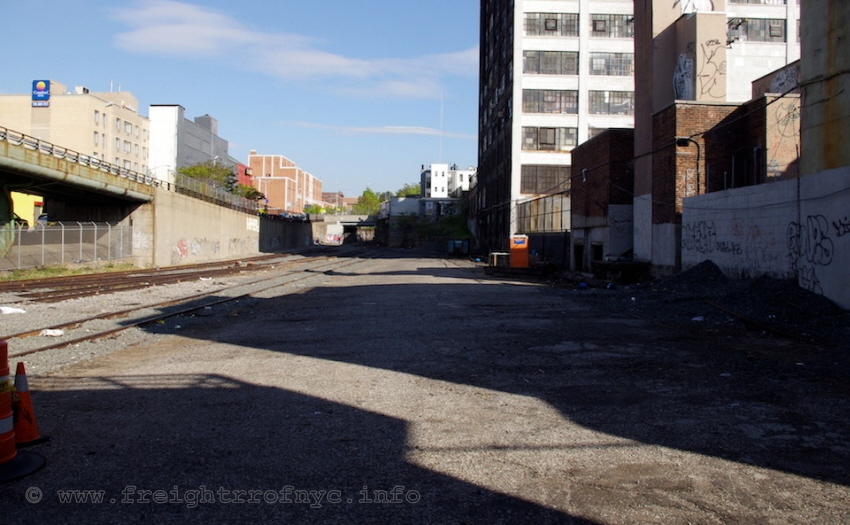
South Brooklyn Railway "38th Street Yard" between Third
and Fourth Avenues and 38th Street - May 1, 2012
J. McCluskey
photo
added 03 May 2012
.
.
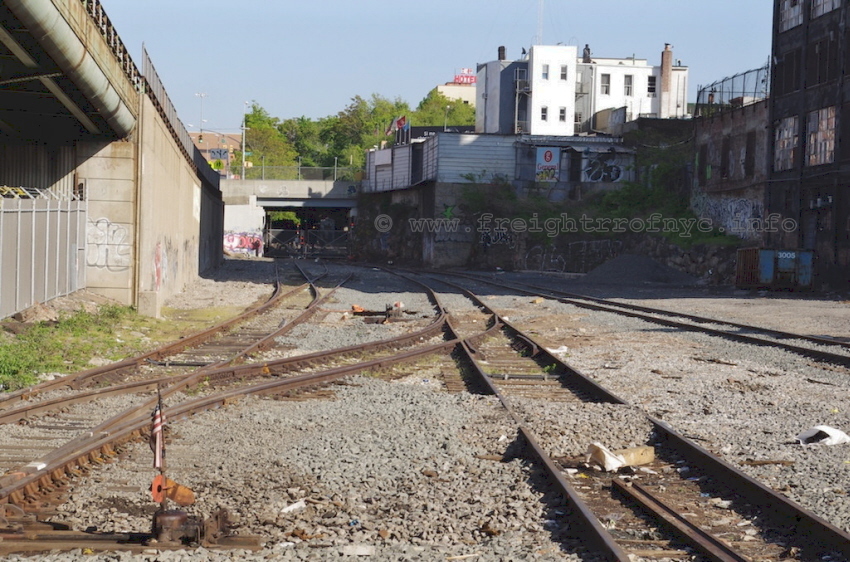
South Brooklyn Railway "38th Street Yard" between Third
and Fourth Avenues and 38th Street - May 1, 2012
Showing lack of unloading ramp.
J. McCluskey photo
added 03 May 2012
.
.
A new ramp would be built at NYCTA Linden Shops, and brought to this location for the intended unloading of the R156 work locomotives. However, after the third locomotive, the ramp would be relocated to New York New Jersey Rail's Bush Terminal Yard where it remains today.
.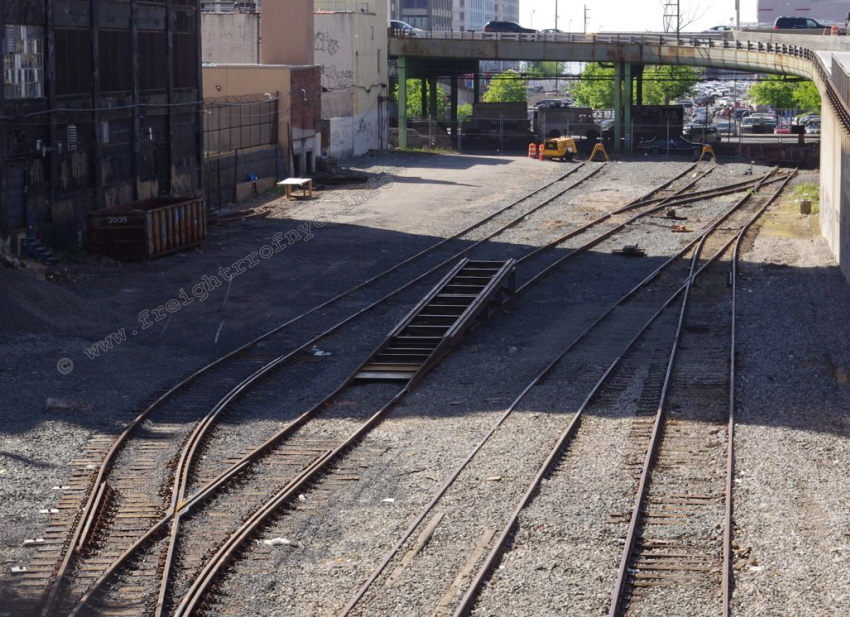
South Brooklyn Railway "38th Street Yard" between Third
and Fourth Avenues and 38th Street - May 12, 2012
Showing new unloading ramp recently relocated from Linden Shops for the unloading of R156 work locomotives.
J. McCluskey photo
added 12 May 2012
.
Beginning in 1914 with the construction of the BMT Fourth Avenue Subway to replace the Fifth Avenue Elevated; this would become the location of the south portal of the subway tunnel as well as the interchange where South Brooklyn Railway would enter upon signaled territory. As such, from this point to the 36th Street Yard, South Brooklyn Railway movements would have to get clearance from the BMT dispatcher to unlock the switch and align for entrance into the signaled territory.
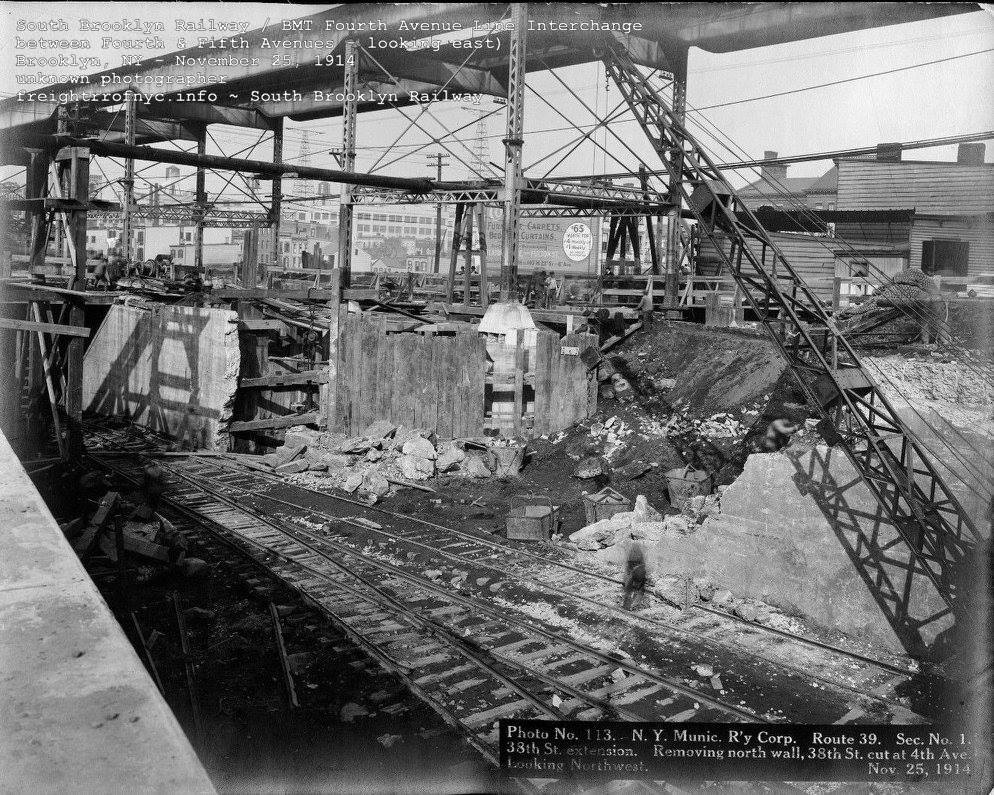
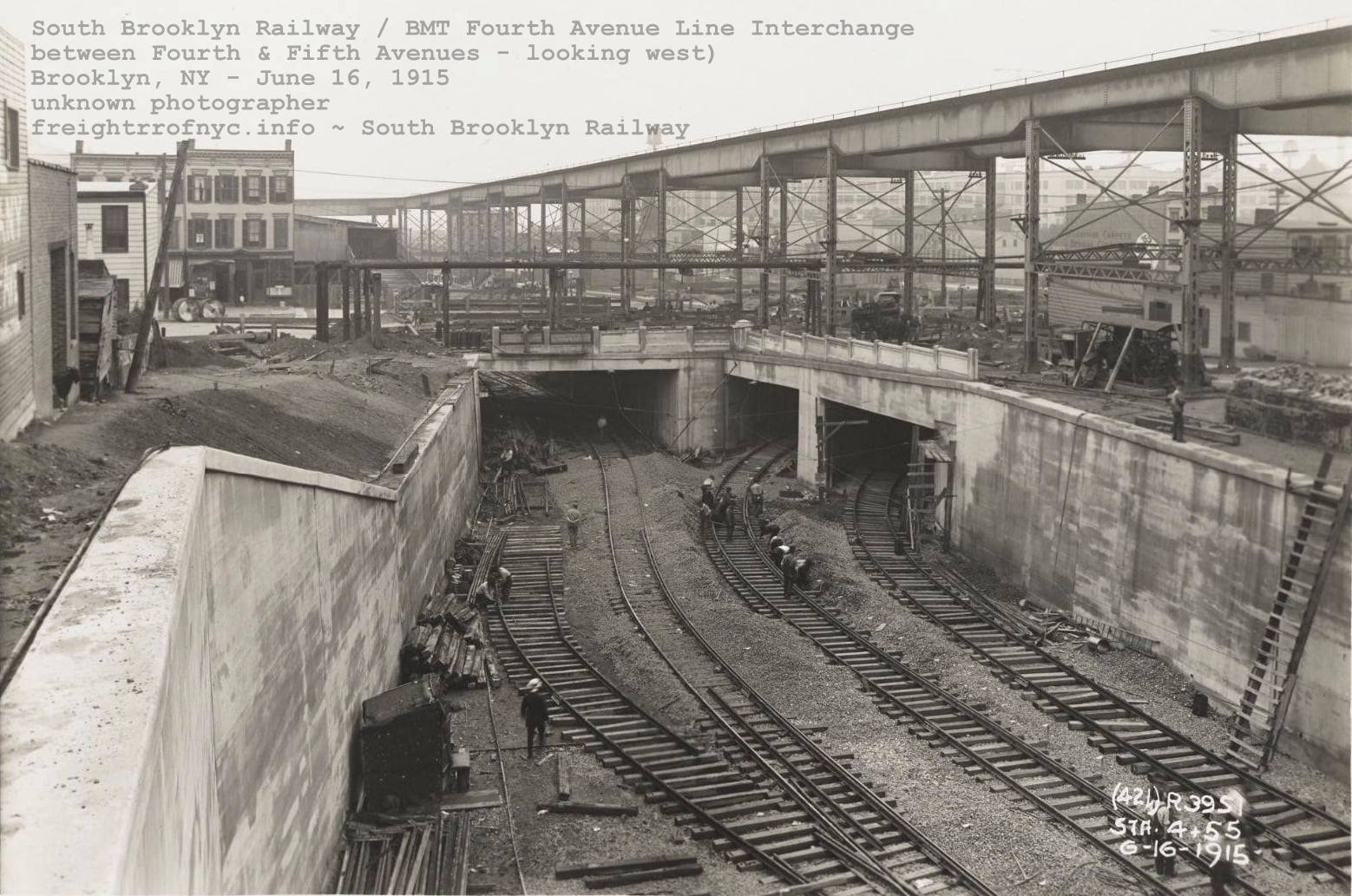
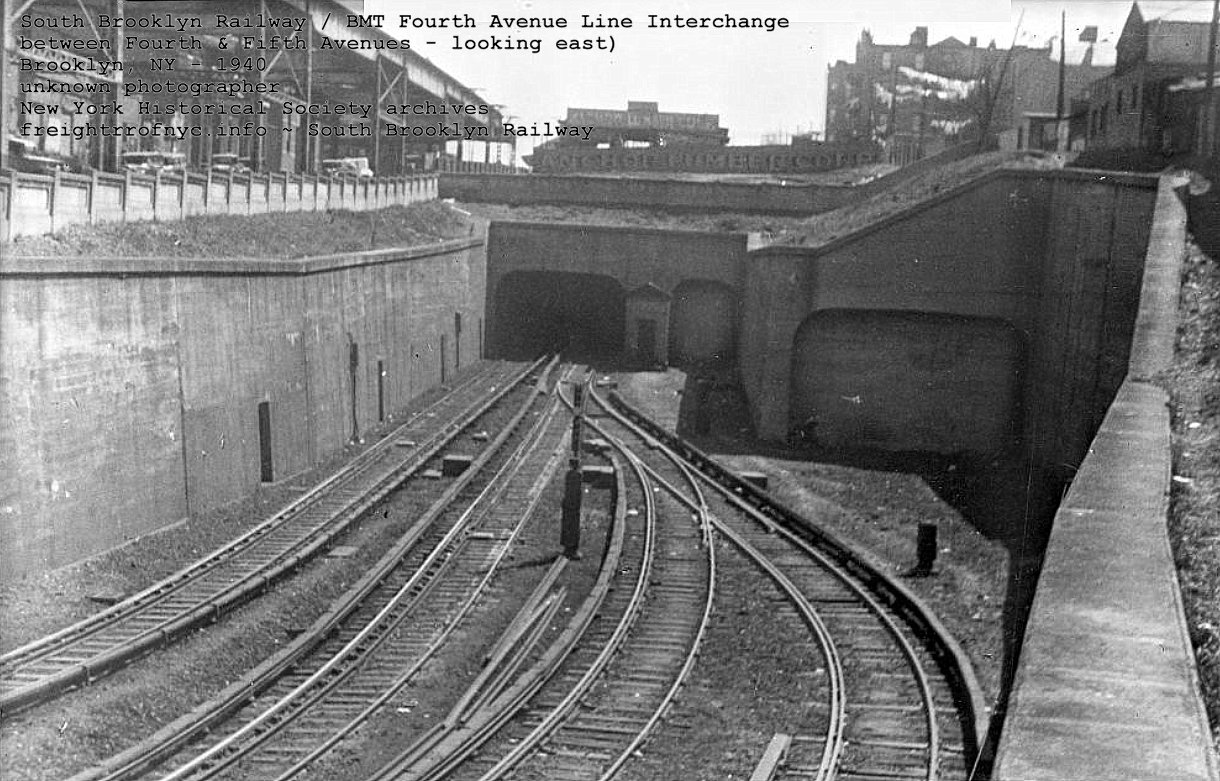
6) BMT 36th-38th Street BMT
Yard (west portion) & SBK 36th Street Yard (east portion)
Exiting eastbound from the tunnel
from Fifth Avenue, the tracks open up into the "36th-38th Street Yard" of
the New
York City Transit Authority (NYCTA) and former Brooklyn Manhattan
Transit "BMT". This facility is the present day MTA 38th Street Train Yard & Facility.
This is a rather decent sized railyard, but nowhere on the
magnitude of say; the Coney Island Yard & Shops Complex. The perimeter
of the yard is bordered by 36th and 37th Streets on the north, 39th
Street on the south, Fifth Avenue to the west and New Utrecht Avenue on
the east, with the BMT West End line running along the southern border
of the yard.
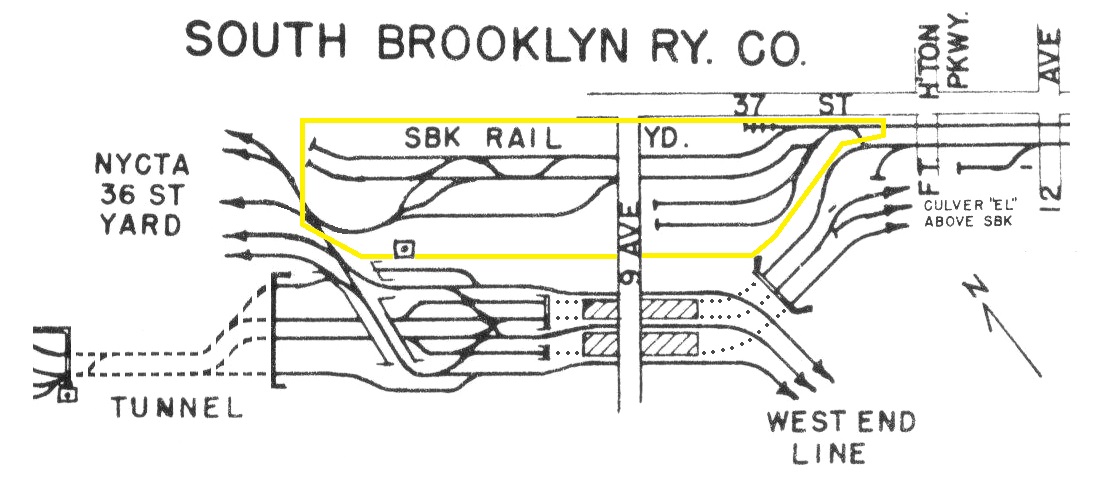
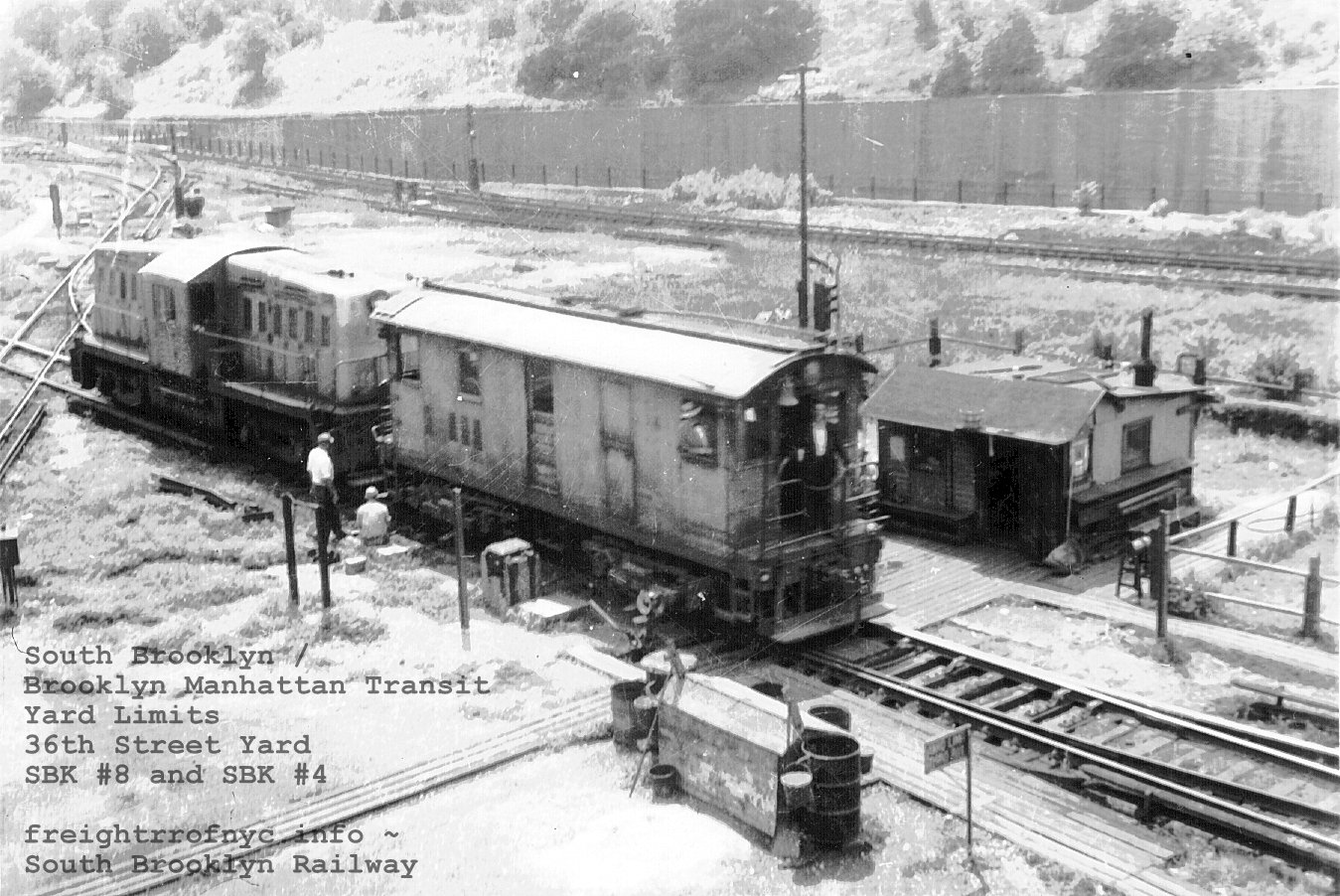 | 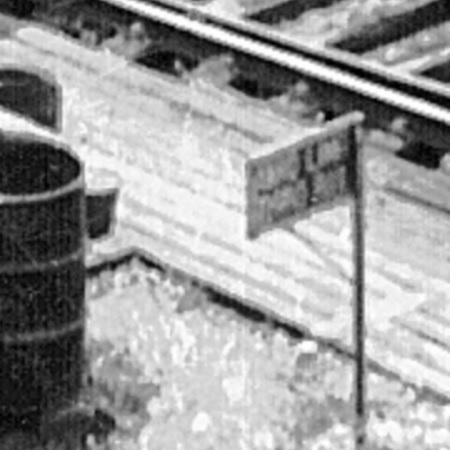 |
| The "diamond" at 36th Street Yards. SBK 36th Street Yard to left, BMT 36th Street Yard to right. Ramps down to Coney Island bound and Manhattan bound local tracks of West End Line at top left corner. | zoom and crop of sign: YARD LIMIT THIRD AVE (What does this Third Ave refer too?) |
Due to the topography of Brooklyn, this yard and facility is mostly subgrade, with a second level above it at the northwest end at Fifth Avenue and gradually becomes street level at the southeast end at Tenth Avenue.
Returning to the operations of the South Brooklyn Railway, it employed the use of the overhead trolley wire throughout their yard and several tracks of the BMT yard.; Several (not all) of its locomotives were also equipped with third rail pick-ups (over-riding type) for use on the BMT trackage that is also served by the 36th Street Yard. The change to diesel locomotives made trolley wire electrical pick up superfluous.
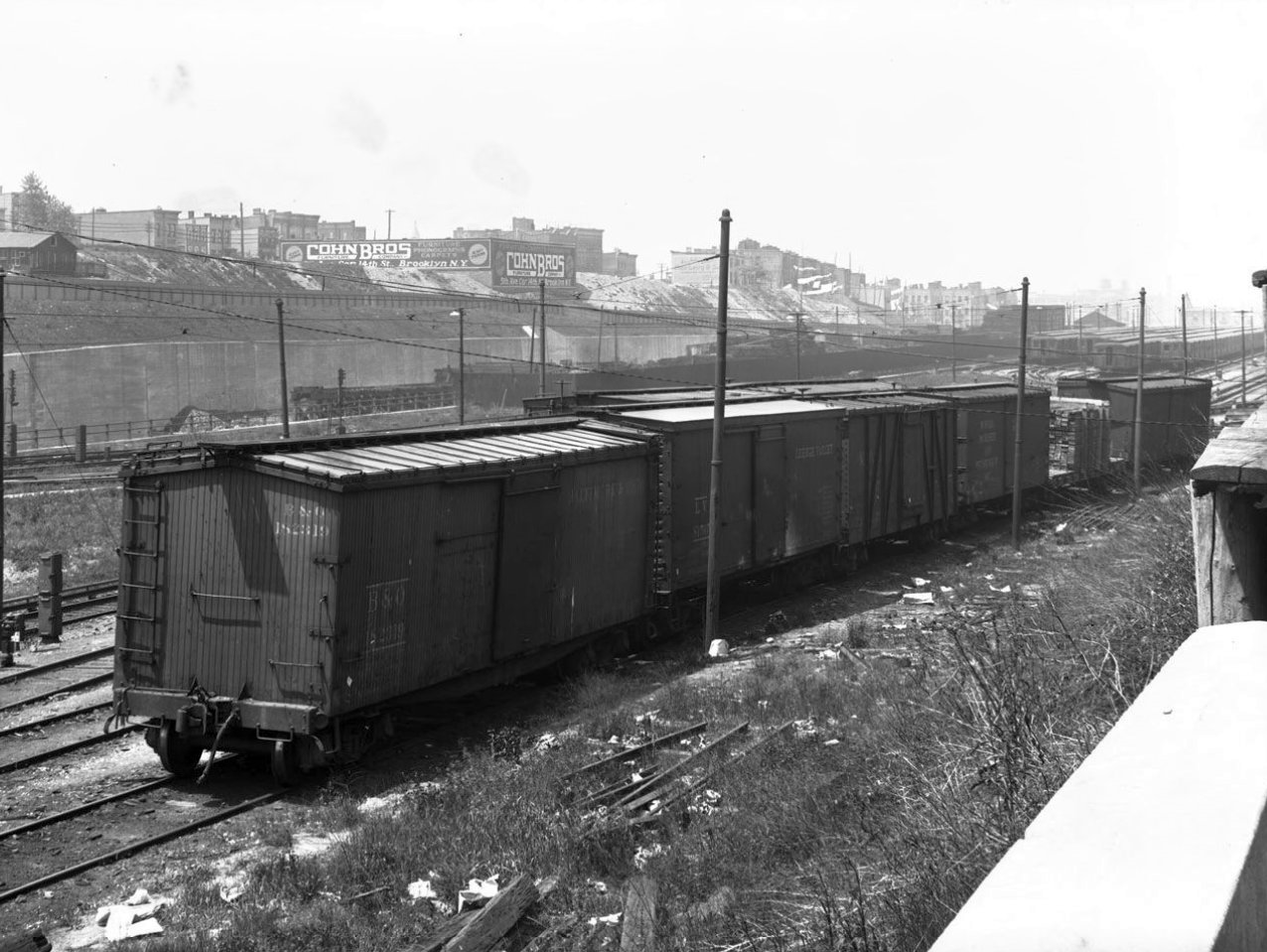
South Brooklyn Railway 36th Street Yard (west area - between Seventh and Eighth Avenues) - unknown date
(looking west-southwest)
Brooklyn Manhattan Transit 36-38th Street Yard in background.
unknown photographer
authors collection
added 20 July 2018
.
.
7) South Brooklyn Railway 36th
Street (eastern portion - between Ninth and Eighth Avenues)
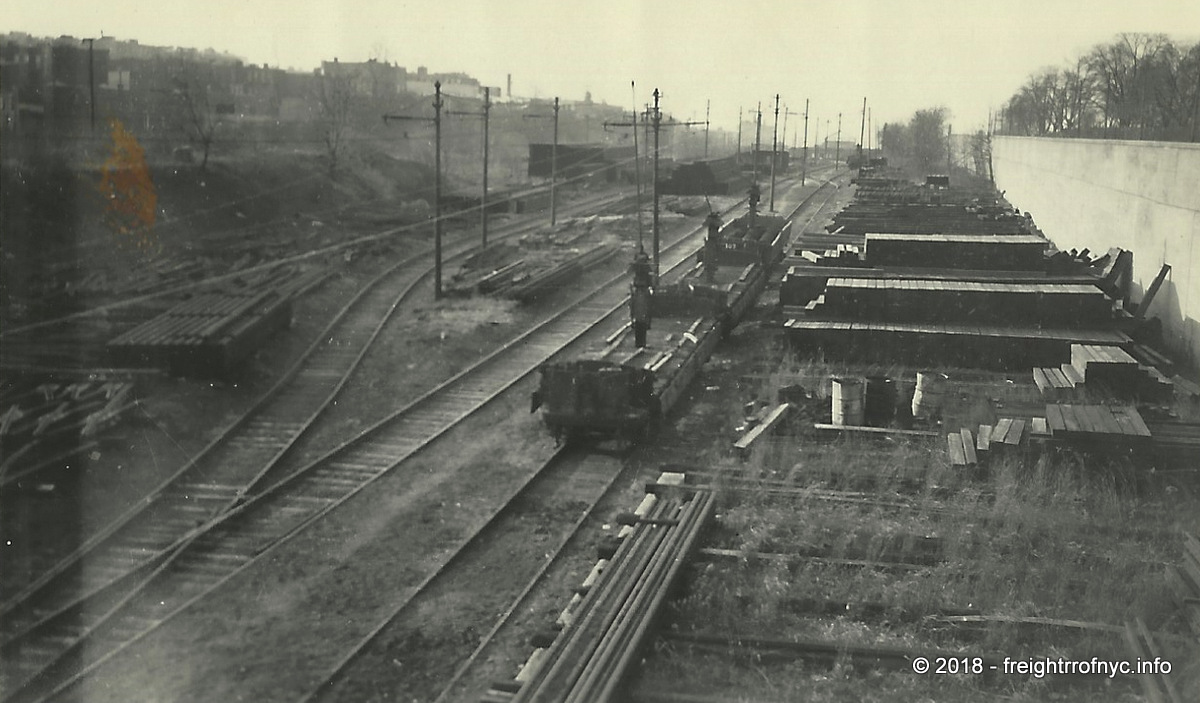
South Brooklyn Railway - 36th Street Yard (east area - between Ninth and Eighth Avenues) - unknown date
(taken from the Ninth Avenue overpass, looking west-southwest)
unknown photographer
authors collection
added 20 July 2018
.
The following image is circa 1940, and is looking west towards the South Brooklyn Railway 36th Street Yard, from atop the ramp that connected the BMT Culver Line (lower level) to the BMT West End Line (upper level) at Ninth Avenue Station. The South Brooklyn Railway tracks can be seen disappearing under the el and both would follow the same route to McDonald Avenue.
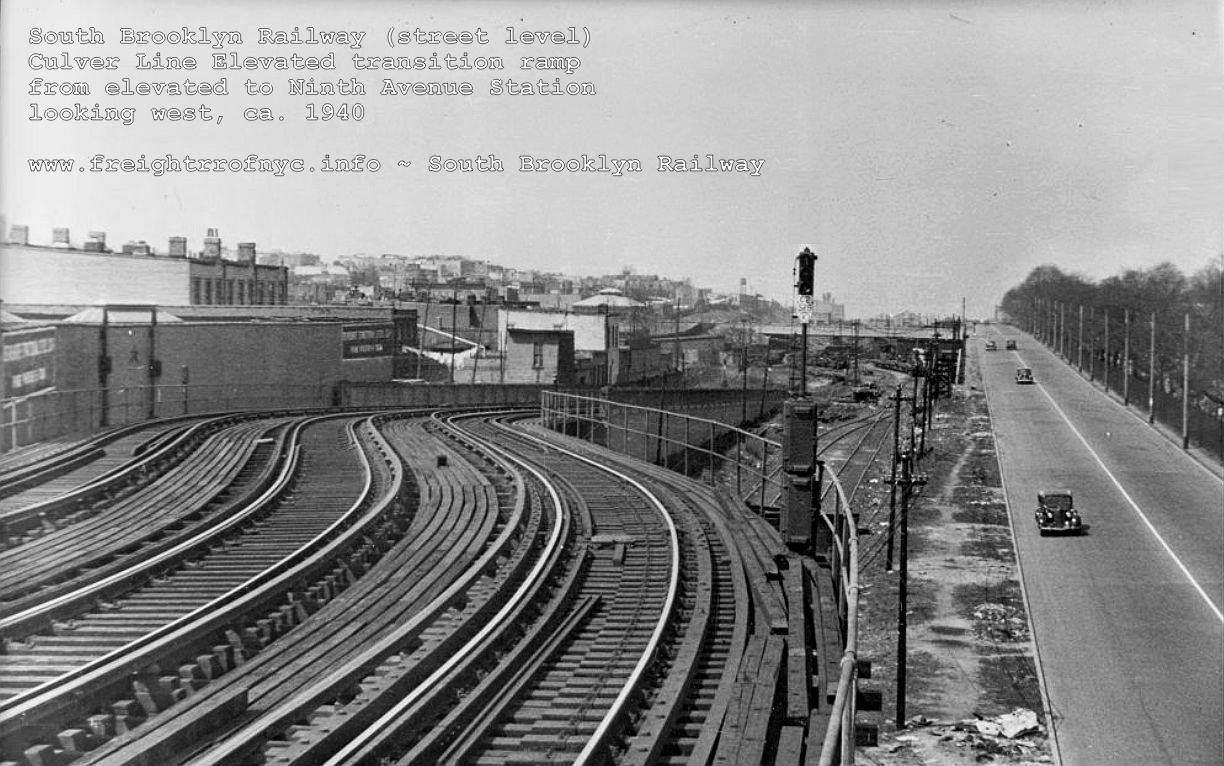
Culver Elevated ramp - ca. 1940
Note the gradual rise in terrain looking west and the yard becoming subgrade.
South Brooklyn Railway tracks at street level and enter under the elevated at this point.
added 18 April 2021
Continuing east out of the yard at street level however, South Brooklyn Railway trackage paralleled 37th Street for about one half of a mile to Dahill Road and it is this route that we shall continue.
.
.
8) 37th Street & Ninth Avenue
Delivery Station
According to the book "Brooklyn - A National Center of Commerce & Industry", published by the Committee on Industrial Advancement of the Brooklyn League in 1914; in the chapter "Freight Depots, Piers & Stores" on page 42, lists this location for deliveries of freight on the South Brooklyn Railway.
Referencing the 1916 series of E. Belcher Hyde Property Maps, no discernible structure seems to be present at 37th and Ninth Avenue that would represent a freight station as there is at 37th Street and Thirteenth Avenue. As the east end of the 36th Street Yard facility falls at 9th Avenue, perhaps at one point something was here but specifics elude us.
Referencing 1924 Fairchild Aerial Survey Photograph and shows a structure between the tunnel portals for the Culver Line and 37th Street with two stub tracks. This might be the delivery station being referenced. By the time the 1951 Aerial Photo was taken some of those structure are gone with most of this particular area open.
Judging from the 1961 Raudenbush Map, it appears these two sidings are what the earlier publication is referring to.
By the next aerial photograph available to us to examine (dated 1996) the NYCTA has constructed a long slightly curved building on this land utilizing those two stub tracks.
This is where the original South Brooklyn Railway trackage returned to street level. After the elevateds were built; the South Brooklyn Railway would retain its right of way at street level. The BMT "Culver Shuttle" would have its transition incline to its elevated at this location. It should be noted from this location, the BMT "Culver Shuttle"
9) 37th Street & Thirteenth Ave Delivery Station and the Greenwood Industrial Sidings:
- Berkshire Structural Steel
- Prospect Coal
- Roberts Foods
- Klein's Building Material
- Phoenix Hermetic
- Bay Ridge Coal
- Flatbush Industrial Corp. Building
- Culver Lumber "Fisher's Siding"
- unnamed sidings
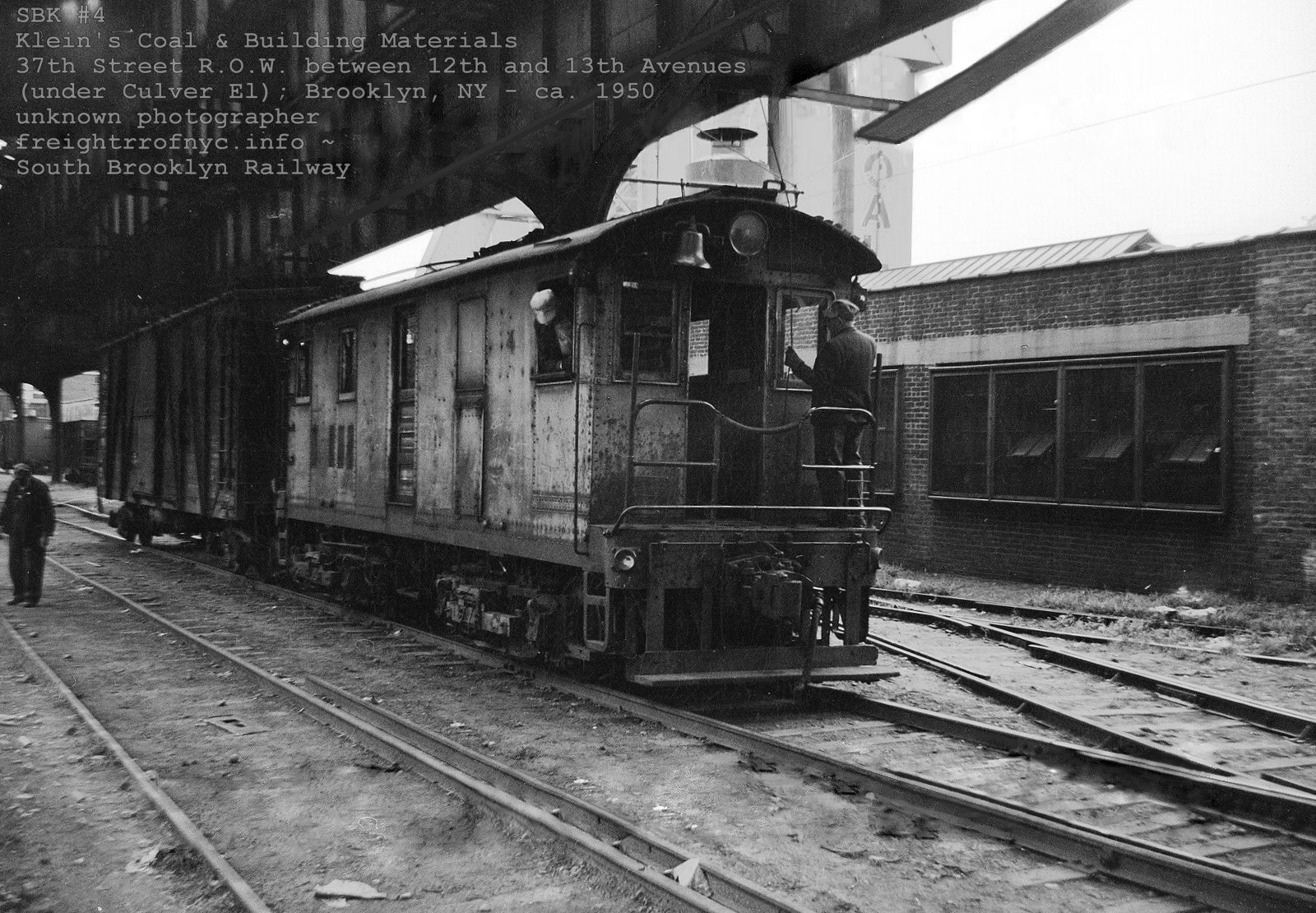
Klein's Coal (Prospect Coal) and Building Materials - ca. 1950
37th Street Right Of Way between 12th and 13th Avenues (looking southeast)
unknown photographer
added 01 November 2022
The 1960 ERA and 1961 Raudenbush track maps shows several sidings in this general area to both the south and the north of the right of way.
For clarity, we will address the property in order from west to east (Ninth Avenue to Fifteenth Avenue) with oldest map on top for a given area. Due to the different map plates, and having been stitched together for display, some images below overlap. Also, attempts has been made to scale the maps to one another, but this is not always the case. Please use caution when reviewing.
I also became aware of a discrepancy in the street grid in the Raudenbush Map. It shows the alignment of 37th Street to jog north between Old New Utrecht Avenue and Fifteenth Avenue. This was not the case, even evidenced by the 1906, 1916 and 1929 E. Belcher Hyde Property Maps as do the 1924 Fairchild Aerial and 1951 Aerial Photos. While I will on occasion and quite frequently question track and siding layout on the property maps, I do not question the street grid and I certainly won't dispute actual images. Needless to say, the 37th Street curbline of block 5349 remained in line with the blocks to the east (5368) and west (5301). So I have corrected the applicable segment of the Raudenbush Map below to reflect this.
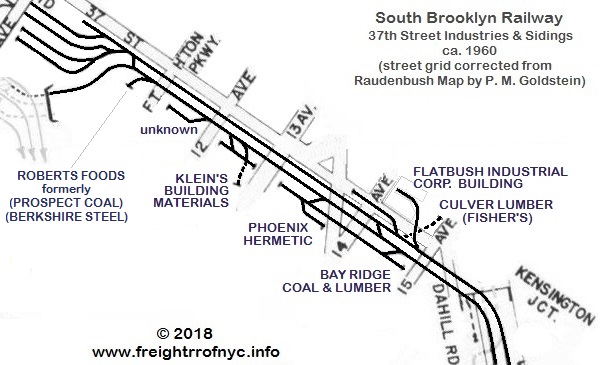
.
.
From west to east, the first siding encountered in the 1906 E. Belcher Hyde Property Map was between Ninth Avenue and Fort Hamilton Parkway on the southern side of the right of way. This siding is for the coal yard (Lot 57).

.
.
This same siding is also encountered in 1916 edition of the E. Belcher Hyde Property Map. If there is any degree of accuracy for the trackage shown in the property maps (and I almost always doubt it) the siding appears to be lengthened west to mid block to the Lot 74 property line.

E. Belcher Hyde Property Map - 1916
Volume 2, Plate 12
courtesy of New York Public Library Digital Archives
annotated version ©2018 by author
By 1929, the adjoining property west to the coal yard (Lot 57) was built up and is now occupied by Berkshire Structural Steel (Lot 67). It is not confirmed that South Brooklyn Railway actually delivered to them, but they were located on the siding.
The siding is not shown,
but believed to be hidden under the Culver Line elevated which opened
to service on March 1919, and now shown on the map.
We also see that a pair of sidings now joins the street trackage west of Tenth Avenue (Block 5581 - Lot 153-4) with a hoist house at the end of the northern siding.

E. Belcher Hyde Property Map - 1929
Volume 3, Plate 57
courtesy of Historic Map Works
annotated version ©2018 by author
.
.
Fort Hamilton Parkway to Fourteenth Avenue
Resuming at Fort Hamilton Parkway, the tracks continue without any note of siding. But the orientation of east-west building (Block 5291 - no lot number shown but an exclamation point) and the large spaces to either side, leads us to believe it may have had rail service. A siding is shown here in the 1960 Raudenbush Map.
S. Klein Building Materials (Block 5295, Lot 60) was confirmed to have a siding and accompanying rail service, despite not being shown in the map below, hence the angled buildings and alleyway through to 38th Street. Klein is also listed as being a coal dealer as well.

.
.
Thirteenth Avenue to Fifteenth Avenue
According to the book "Brooklyn - A National Center of Commerce & Industry", published by the Committee on Industrial Advancement of the Brooklyn League in 1914; in the chapter "Freight Depots, Piers & Stores" on page 42, lists the location of 37th Street & Thirteenth Avenue for deliveries of freight on the South Brooklyn Railway.
While not shown in either the ERA map of 1960 or the Raudenbush Map in 1961, there was in fact a South Brooklyn Railway Freight Station located in Block 5301 (bound by 37th and 36th Streets and Thirteen and Old New Utrecht Avenue Avenues. This structure is shown on both 1906 and the 1916 E. Belcher Hyde Property Maps with trackage to the building. Note that there a connection for the Church Avenue trolley line to the South Brooklyn Railway trackage as well, which is not surprising given the knowledge of the streetcar delivery network.
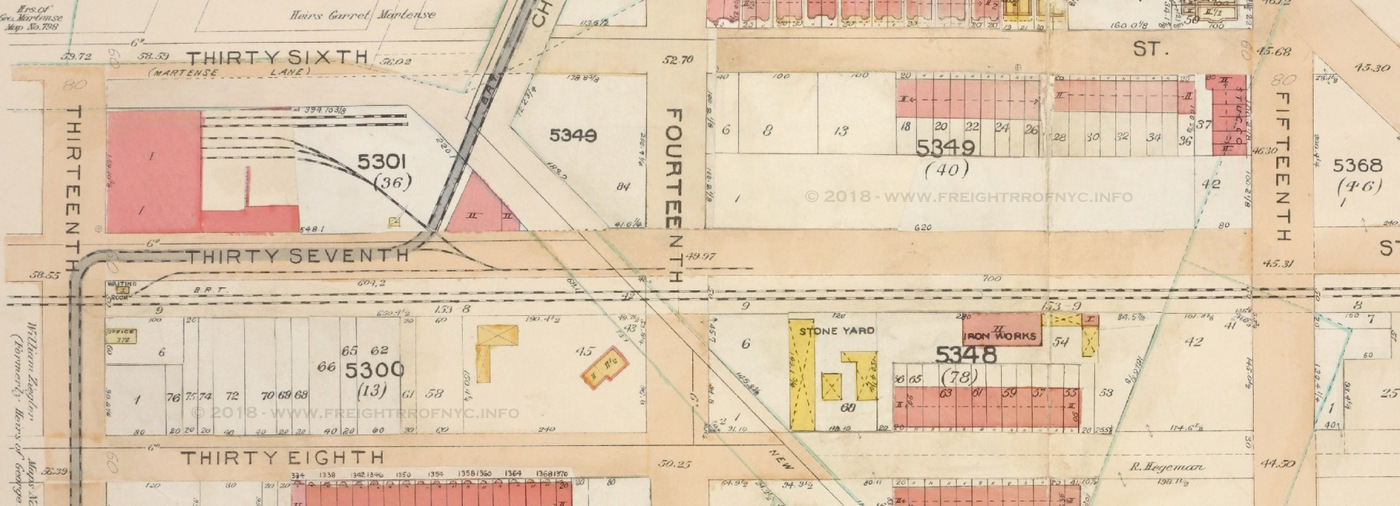
E. Belcher Hyde Property Map - 1906
Volume 5, Plate 29
courtesy of New York Public Library Digital Archives
annotated version ©2018 by author
Of particular note is a track in center of 37th Street. It is believed that this track was a remnant from the lead to the Thirteenth Avenue Freight House (shown in the 1916 Property Map above) and may just being used as a team track by 1960 (see next map).
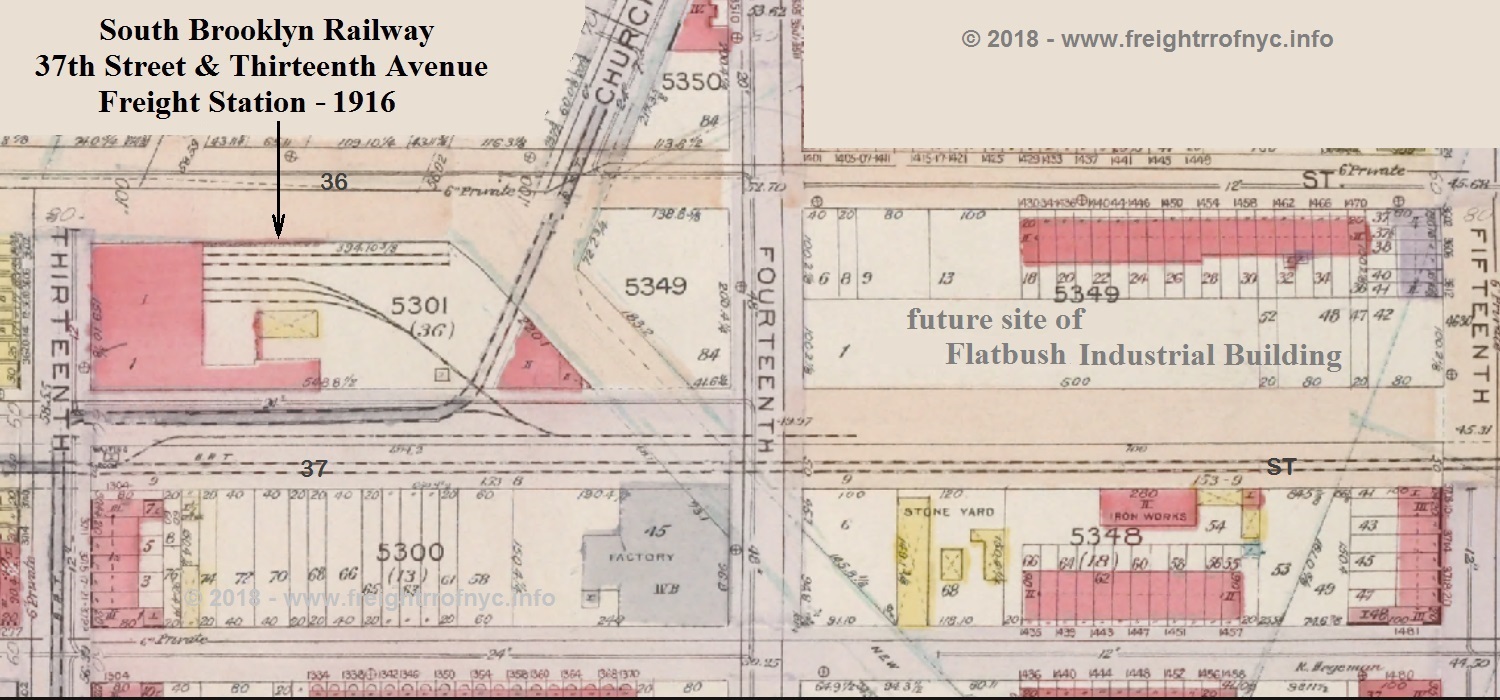
E. Belcher Hyde Property Map - 1916
Volume 5, Plate 29
courtesy of New York Public Library Digital Archives
annotated version ©2018 by author
added 30 June 2018
.
.

.
.
The Flatbush Industrial Corp. Building siding and Fisher's sidings were both located on the northern side of 37th Street with the turnout for the Flatbush Industrial Building facing points west and the turnout for the Fischer Siding points facing points east. Due to the confines of the property, the Fisher switch was encountered first going eastbound then the Flatbush Industrial Building switch and the tracks crossed each other on a diamond into the properties. This was a popular arrangement for rail service in tight confines as in Lot 48. While not shown, the siding for Flatbush Industrial in fact curved back west, crossed Lot 52 and ran through the open central corridor of the structure. By the Raudenbush Map, the Fisher Siding is shown as a broken line and thereby assumed to be out of service.
Research has revealed the the
original occupant of the building was H. W. Cotton and his business was
the fabrication and assembly of machinery such as lathes, mills and the
like. Found online is an agreement between the South Brooklyn
Railway and H. W. Cotton dated September 24, 1920 for the SBK to
construct and provide rail service to the building (see above).
By the issue of the 1929 E. Belcher Hyde Property Map, Block 5301 (the SBK Freight Station) appears to be one large empty lot, and the Flatbush Industrial Building (Lot 68) is now shown along with Culver Lumber (Lot 42). Culver Lumber is listed as "Fisher's Siding" in the 1960 ERA Map. Research shows a Charles Fisher at this location engaged in the paper & allied trades in a 1963 trade journal.
One the south side of 37th Street, Block 5300, Lot 48 was occupied by Phoenix Hermetic and their siding is shown along the north property line of the lot. Phoenix Hermetic was in the business of manufacturing caps for glass jars, canning and sealing as well as lacquering steel and tin plates for the lithograph industry among several other things.
In Block 5348, it is unknown if either Anchor Corrugating Iron Works (Lot 54) received rail service. At they were in the business of manufacturing metal shed and buildings, it seems logical rolls of steel would arrive via rail. Bay Ridge Coal & Lumber (Lots 49 & 53) did receive rail service and is shown in the 1960 ERA as well as 1961 Raudenbush Maps. Research shows Bay ridge Coal & Lumber was incorporated by January 1922 as reported in a coal trades newsletter.
It should be noted that while not shown, an extended storage siding and runaround track to service and switch out the customers in the area extended for two blocks between Thirteenth and Fifteenth Avenues on the south side of 37th Street and was located between the Phoenix Siding and the "main line" trackage.
What is also not shown in the next map, is the track in the middle of 37th Street (as seen in the 1916 map above). I vaguely recall as a child in the mid 1970's, my grandfather having business in the area and a boxcar standing in front of the Flatbush Industrial Corp. Building in the middle of 37th Street. This memory stands out because I wondered in awe "how a boxcar got there and when the train would come to get it." But don't quote me on it.
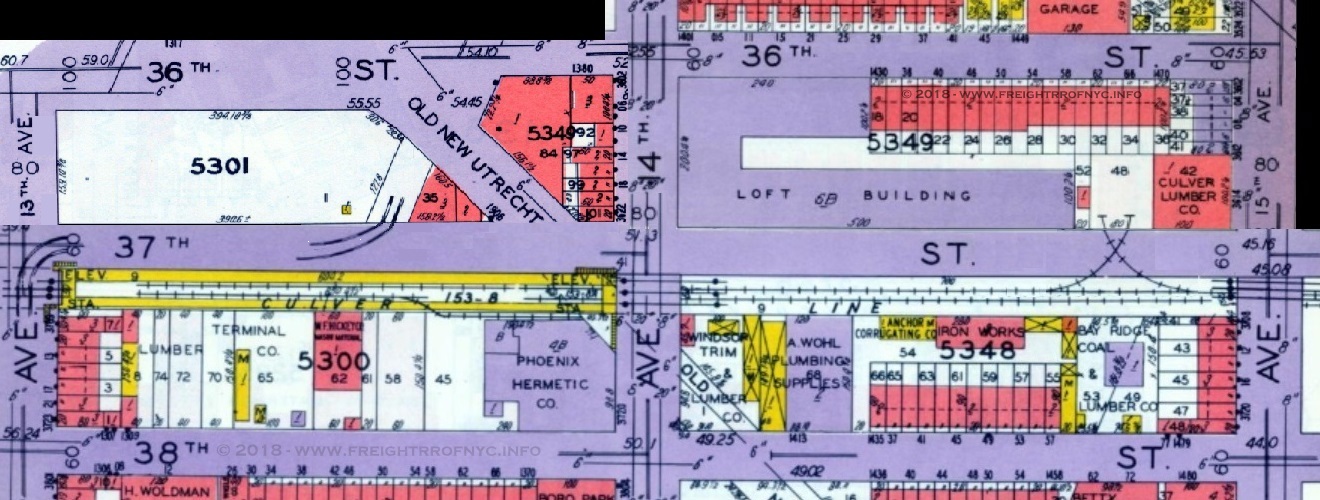
1929 E. Belcher Hyde Property Maps -
Volume 3 - Plates 58, 59, 60, 123
courtesy of New York Public Library Digital Archives
stitched version ©2018 by author
added 06 July 2018
.
.
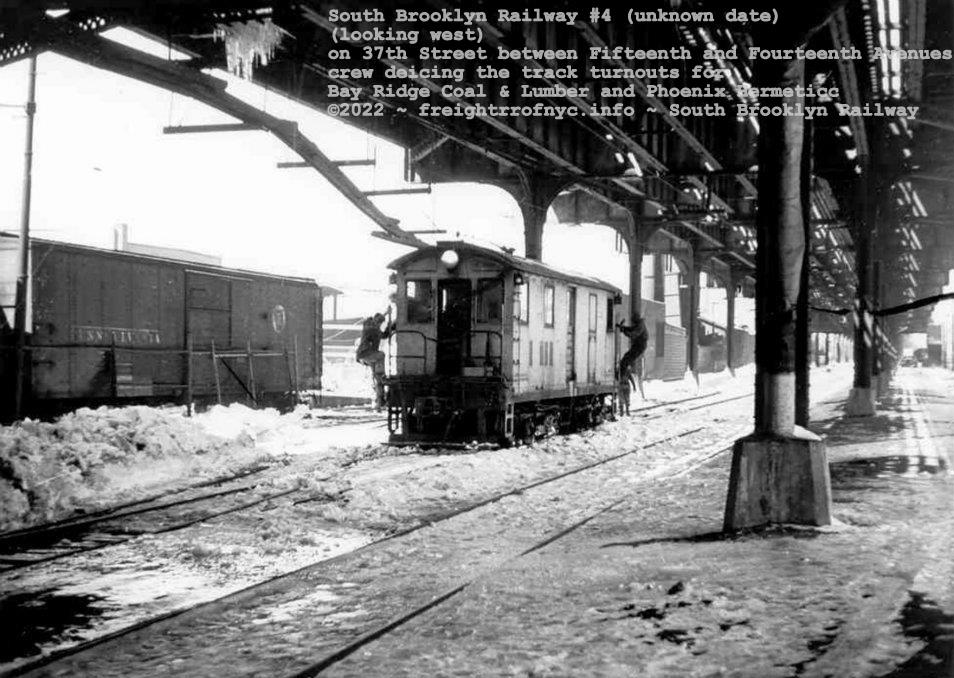
The crew of SBK #4 climbs down to help clear the track turnouts of ice and snow in front of Bay Ridge Coal & Lumber.
on the 37th Street Right Of Way; looking west from Fifteenth Avenue and Fourteen Avenues.
unknown photographer
added 02 November 2022
.
.
Rail service to the Flatbush Industrial Building is believed to ceased with the abandonment of this portion of the line in 1978. The Flatbush Industrial Building went on to house a food packaging company and other tenants when I visited it in 2008. Part of the central alley with rail siding has seen an expansion of the structure since original construction. This building was recently renovated and upon completion in 2017; it has become a mixed use business center called "Brooklyn Square".
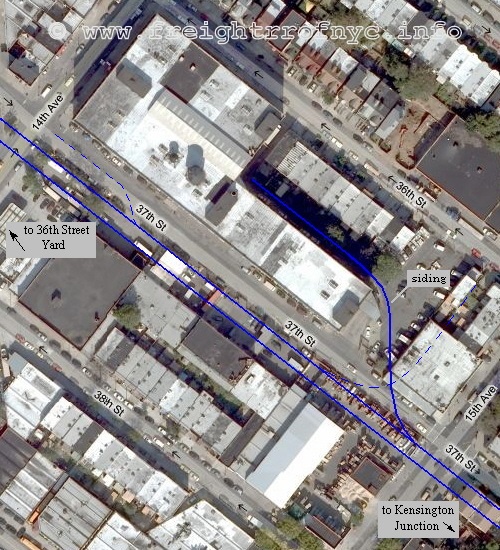
.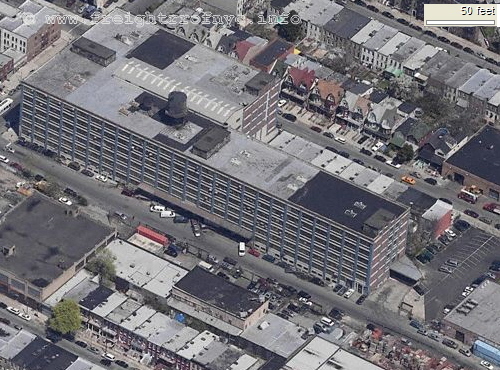
.
The segment for the South Brooklyn Railway from Fort Hamilton Avenue to Thirteenth Avenue that parallels the south side of 37th Street has been pretty much obliterated, with residential townhouses having been built on what was once the right of way.
.
.
Upon arriving at Dahill Road the right of way begins to curve to the south, diagonally cutting the northeast corner of Cortelyou and Dahill Roads and the southeast corner of Cortelyou Road and McDonald Avenue, and finally entering the centerline of McDonald Avenue.
This location was known as "Kensington Junction". It was here that trains could be switched to the 37th Street routing, or streetcars could continue north up Gravesend Avenue (see #10 below).
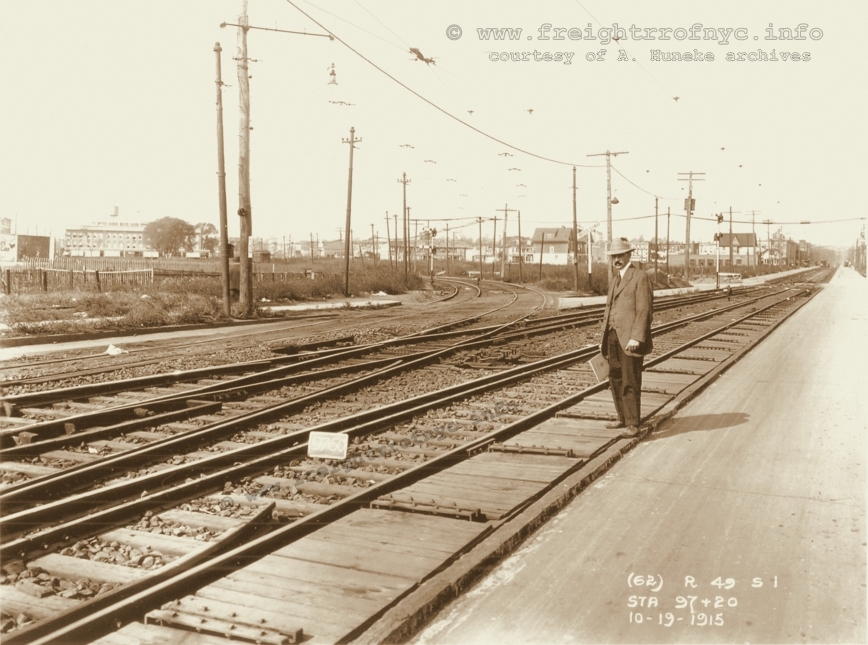 South Brooklyn Railway / Brooklyn Rapid Transit - Kensington Junction - October 19, 1915 Looking north. South Brooklyn Railway right of way curving left in center of image to 37th Street, BRT (Prospect Park & Coney Island) trackage from center of image to right edge lead north along Gravesend Avenue to 20th Street. Taken prior to and presumably for the construction of the Culver Line elevated structure. This photo is part of a large transit infrastructure survey series taken by the City of New York throughout the 1910's and 1920's. I have heard rumors that most of the glass plate negatives in this series were found in dumpsters. courtesy A. Huneke archives added 05 July 2018 |
| . . |
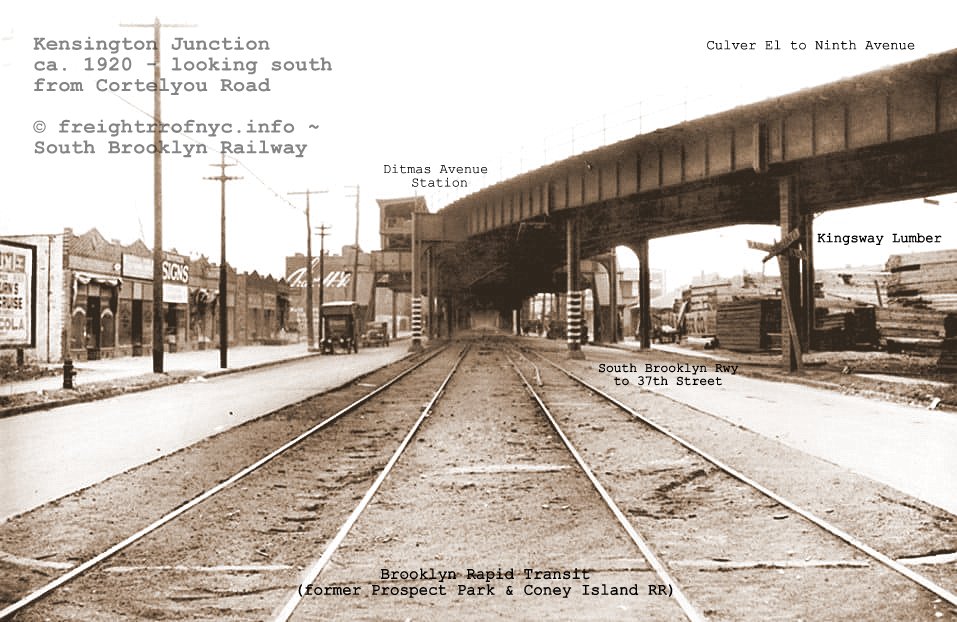 South Brooklyn Railway / Brooklyn Rapid Transit - Kensington Junction - ca. 1920 Looking south along Gravesend Avenue. South Brooklyn Railway right of way curving to right to 37th Street in center of image. BRT (Prospect Park & Coney Island) trackage in center of image to behind photographer leads north along Gravesend Avenue to 20th Street. Taken shortly after completion of construction of the Culver Line elevated structure. This image is interesting as the Culver Elevated was built 1918, but historical accounts state the PP&CI was electrified in 1916; yet it appears there is no trolley wire strung in photo! added 03 November 2022 |
| . . |
|
| . . |
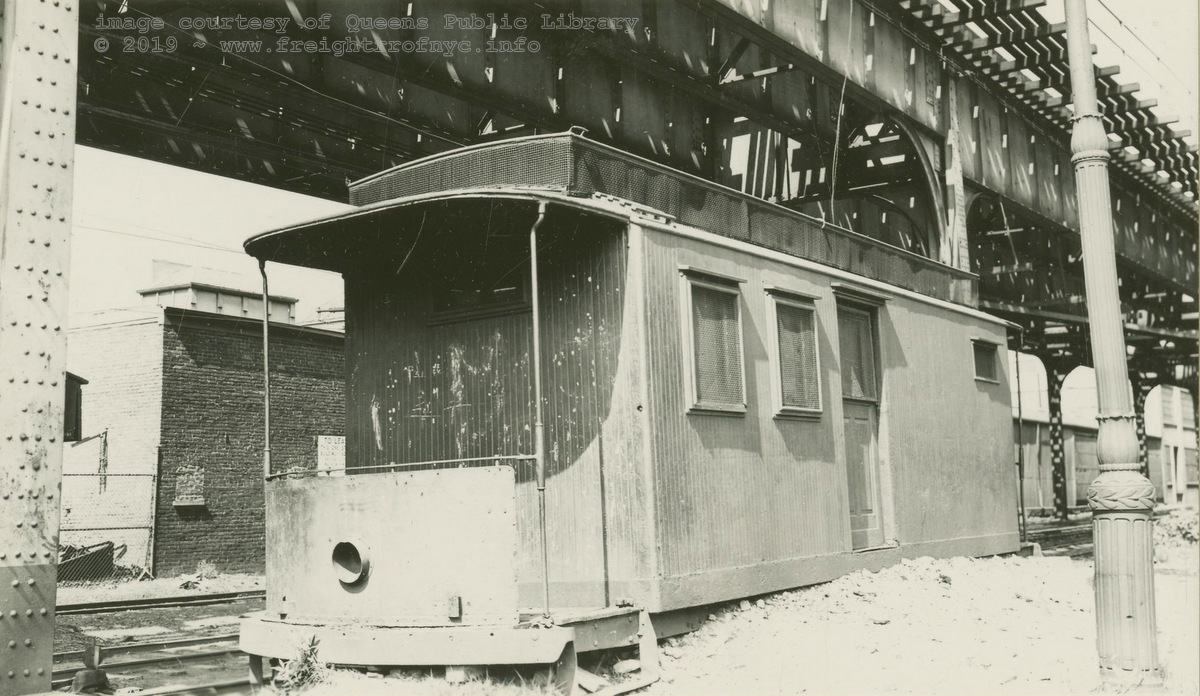 The "new" Kensington Junction Freighthouse! August 9, 1936 According to notes accompanying the image in the Queens Public Library; the body of BRT #222 (US Mail Trolley) was located at Kensington Junction for uses as a freighthouse. William J. Rugen photo image courtesy of Queens Public Library Digital Archives color corrected by author added 21 May 2019 |
| . . |
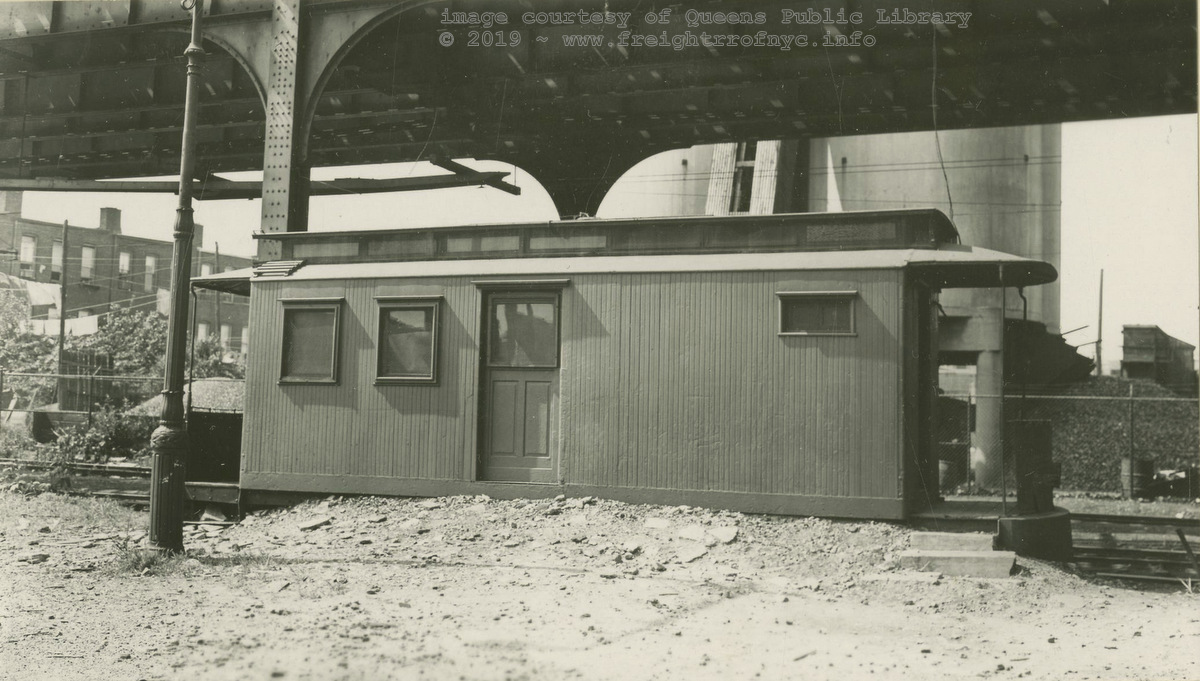 The "new" Kensington Junction Freighthouse! August 9, 1936 According to notes accompanying the image in the Queens Public Library; the body of BRT #222 (US Mail Trolley) was located at Kensington Junction for uses as a freighthouse. William J. Rugen photo image courtesy of Queens Public Library Digital Archives color corrected by author added 21 May 2019 |
.
.
Please note that McDonald Avenue was originally known as Gravesend Avenue, and had been renamed in 1933.
Also at this location, the BMT "Culver
Shuttle"
![]() line elevated (now demolished) connected with and had it's eastern
terminus across the platform from the Independent Subway / IND "Sixth Avenue
Line"
line elevated (now demolished) connected with and had it's eastern
terminus across the platform from the Independent Subway / IND "Sixth Avenue
Line" ![]() Line and also an elevated (which still exists).
Line and also an elevated (which still exists).
The South Brooklyn Railway (and Prospect
Park & Coney Island RR) right of way would continue to run under this IND
el in later years, which is now the NYCTA
![]() line.
line.
In the early years and up to at least the mid-1950's, photographs show the tracks were not embedded in the street as we have come to expect, but in fact the trackage between intersections was typical rails on ties construction (and apparently covered in dirt) and the automobile traffic drove to the outsides of the elevated structure (where automobiles park in the present day). Presumably as railroad freight traffic decreased and automobile traffic increased, girder rail (rail with a built in flangeway made for street use, see Glossary) was laid and the right of way paved so it can be shared by train & automobile alike.
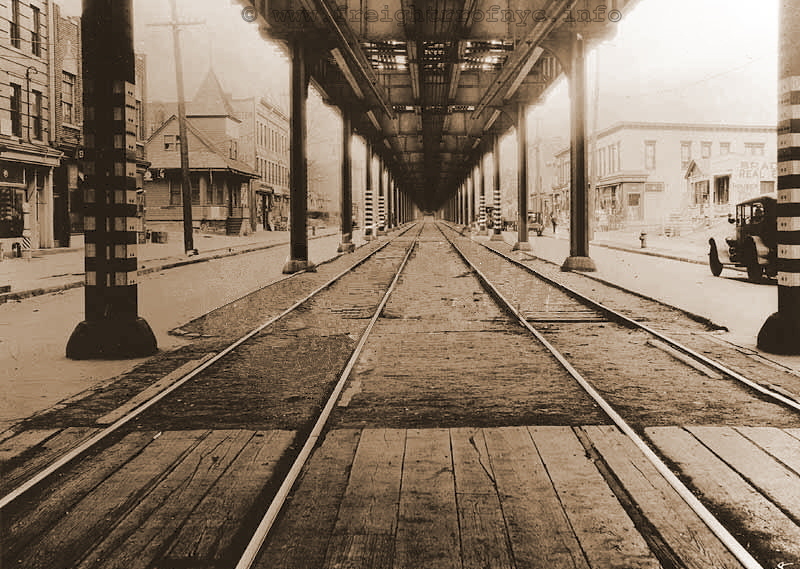
Gravesend Avenue - December 16, 1924
Looking south from Ditmas Avenue. Kensington Junction is half a block behind
photographer.
Under the IND "Culver / Sixth Avenue" line.
E. E. Rutter photo
B. Merliss archives
added 29 December 2009
.
Viewing the 1929 edition of the E. Belcher Hyde Property Map, there were two customers located at Kensington Junction: Rubel Ice and Coal (they had other locations throughout Brooklyn as well) and Kingsway Lumber. Research shows Kingsway Lumber filed for bankruptcy in 1932. I also recollect a building supply / lumber yard was located at this location throughout my years living in Brooklyn.
Ironically, the railroad may be long gone, but a brickyard and a small concrete mixing plant occupies this very same location in 2018.
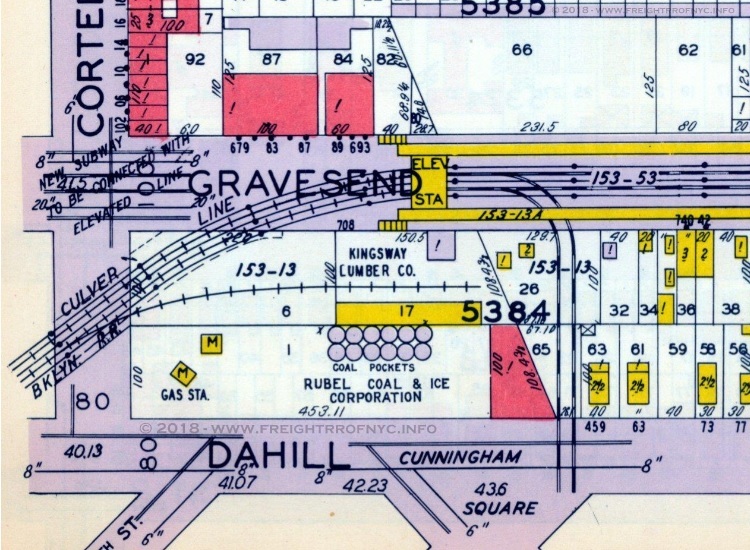
.
.

Kensington Junction - 1953
Looking north along McDonald Avenue (Gravesend Avenue) and under the IND "Culver Shuttle" (to left) and "Sixth Avenue" line (straight).
with South Brooklyn Railway tracks branching to left, former Prospect Park
& Coney Island RR to right on surface.
Compare with 1915 photo above.
unknown photographer
A. Huneke archives
added 29 December
2009
.
.

.
11) Ninth Avenue & 20th Street
Depot
A set of tracks also ran north from the Kensington Junction,
up Gravesend Avenue (McDonald Avenue), turning northwest at 20th Street and ending at the Ninth Avenue & 20th
Street Depot, which was the northern terminus of the Prospect Park &
Coney Island RR.
The PP&CI was the passenger carrying railway that originally
used this trackage, until Brooklyn Rapid Transit was organized and
then upon insolvency, subsequently became Brooklyn-Manhattan Transit. These passenger
carrying streetcars shared the trackage with the South Brooklyn Railway
until
1958 when trolley service was discontinued. The carbarns at Ninth Avenue and 20th Street would be
demolished circa 1960 and the property developed into Bishop Ford High
School. It is now a NYC Board of Education facility. No traces remain.
The August 27, 1915 issue of Railway Age Gazette (Volume 59, No. 9) lists this location as a freight station for the South Brooklyn Railway, and from the Eppler / Linder article we now now two customers received freight here: Ansonia Clock and Maltine, Co. but little more is known about this location.
Continuing south from Kensington Junction, the South Brooklyn Railway right of way heads almost due south towards Coney Island.
.
.
At Gravesend (McDonald) Avenue and Avenue I, there was an interchange with the Bay Ridge Branch of the New York, New Haven & Hartford Railroad and the Long Island Rail Road.
As the South Brooklyn Railway tracks running north/south were street trackage, as were the LIRR tracks running east/west, both crossed each other at grade. This photograph is courtesy of Bob Diamond:
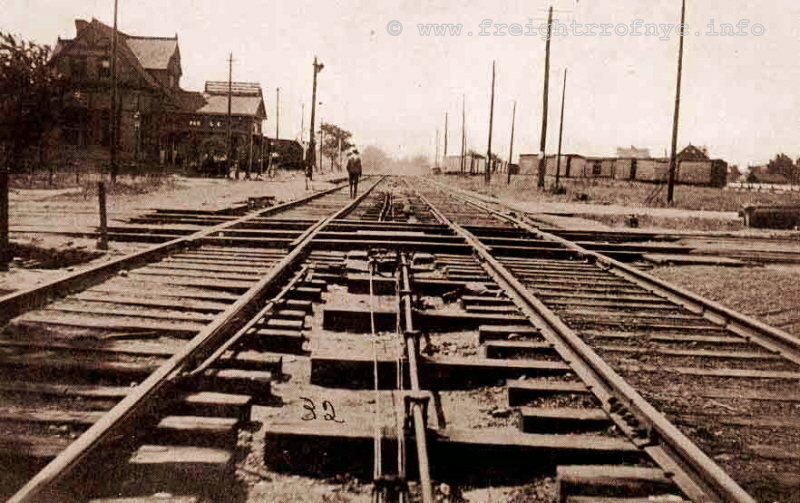
South Brooklyn Railway / Prospect Park & Coney
Island Railroad crossing with Long Island Rail Road - 1903
Parkville, Brooklyn, NY
Looking south (towards Coney Island) on Gravesend (now McDonald) Avenue at
Parkville Interchange.
Long Island Bay Ridge Branch tracks crossing from left to right.
Note string of wood freight cars in right background - they are on LIRR /
SBK interchange. Parkville Station on left.
R. Diamond archives
added 24 Dec 2009
.
.
The Long Island Rail Road embarked on a grade crossing elimination project beginning in 1905. As part of this, the railroad excavated the Bay Ridge Branch and after 1906, the South Brooklyn Railway would now run over the subgrade NYNH&H / LIRR tracks:
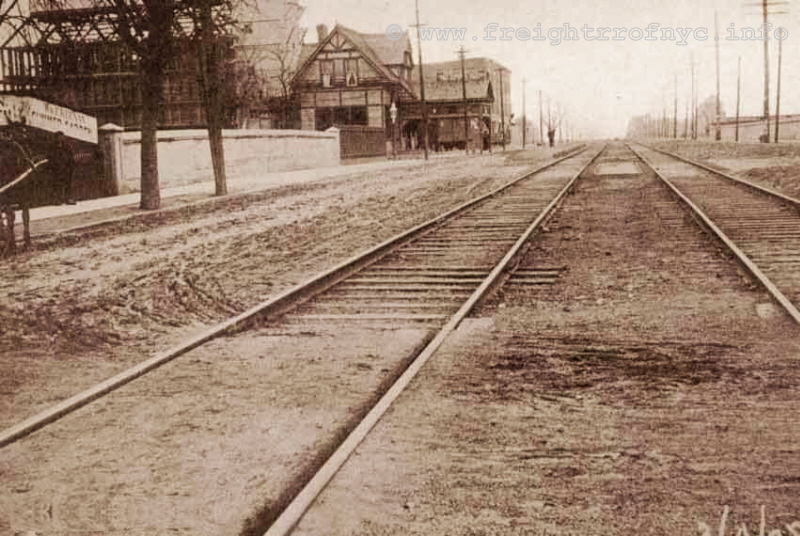
South Brooklyn Railway / Prospect Park & Coney
Island Railroad - 1906 - Parkville, Brooklyn, NY
Looking south (towards Coney Island) on Gravesend (now McDonald) Avenue at
Parkville Junction.
Long Island Bay Ridge Branch now subgrade (out of view) evidenced by bridge
wall on left of photo.
R. Diamond archives
added 24 Dec 2009
.
The turnout for the interchange was south of this overpass at the "triangle" intersection of McDonald Ave (a/k/a Gravesend Avenue), Avenue I and 20th Avenue. This track connected the south and west legs of the interchange. (There was another leg connecting the south and east legs of this interchange but this was removed in 1917.)
According to the State of New York Transit Commission of New York First Annual Report of 1921, the South Brooklyn Railway razed the Parkville Station (built in 1885, 2 1/2 story, 20' x 40' for the cost of $5,200.00.
This location, according to Robert Emery maps of the Bay Ridge Branch courteously furnished by Steve Lynch, show the last remnants of a freight yard that existed until 1959. It was in the middle of the lead tracks for this yard that the South Brooklyn Railway would interchange at this location.
It also appears that South Brooklyn Railway access to this location was limited to the southern most portion of the twin interchange leads, and that the South Brooklyn did not service this yard or adjacent industry spurs.
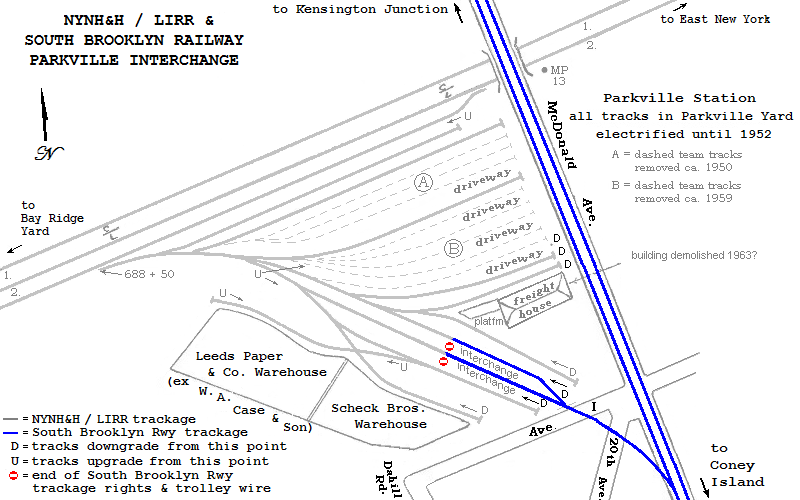
ca. 1920 - ca. 1959
R. Emery map
courtesy of S. Lynch
(modified by author and reoriented for
north)
added 11 Dec 2009
.
Sometime after 1969, Penn Central Transportation Co. (or simply Penn Central) had taken over freight service on the Bay Ridge Branch from the Long Island Railroad. It is unclear at this time exactly who the Penn Central serviced along this route (we do know that Penn Central serviced G & R Packing which was located further west at 8th Avenue (through at least 1973) as well as Leeds Paper and Scheck Brothers at Parkville Interchange. Freight service would gradually diminish along this branch, and when carfloating operations ceased at the Bay Ridge Yard in 1971, resulting in its loss of regular freight traffic.
In 1976, Penn Central itself would dissolve after filing for bankruptcy back in 1970. This in turn partially led to the formation of Conrail, of which would necessitate Conrail to run what little local freight service on the Bay Ridge Branch existed.
In 1984, the Long Island Rail Road would purchase the Bay Ridge Branch from Conrail, thereby returning LIRR presence to where it had been once before.
In 1997, the Long Island Rail Road reached a decision to privatize its freight operations. The "New York & Atlantic Railway" was organized in May 1997, and contracted with the LIRR to provide freight service in Brooklyn, Queens, Nassau & Suffolk counties.
On May 21, 1999, the City of New York awarded Bay Ridge Yard to the New York & Atlantic Railway and it is the New York & Atlantic Railway that operates the Bay Ridge Branch to this day.
So, what does all this have to do with the South Brooklyn Railway?
It appears from several photos (not shown here) dated January & February 1972 seen on Dave Pirmann's website www.nycsubway.org, that even during the Penn Central owned years, LIRR would transport subway cars along the Bay Ridge Branch to Parkville Interchange for interchange with South Brooklyn Railway.
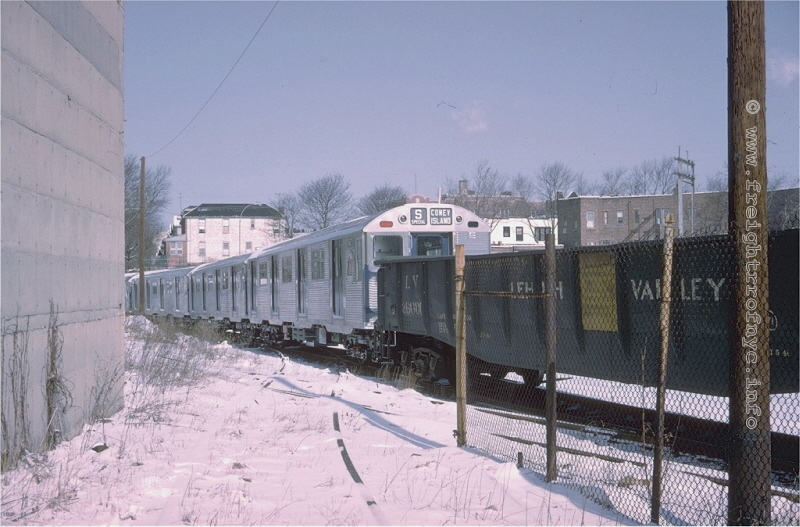
Parkville Interchange - Brooklyn NY - March 21, 1965
Looking north. Photographer is standing on Scheck Brothers Warehouse siding.
The crossing diamond is barely discernible under the snow next to the R32
and gondola.
The siding leading to the Leeds Paper Warehouse can be seen between the chain
link fence and Lehigh Valley gondola.
D. Grotjahn photo
J. Testagrose
collection
added 19 Dec 2009
.
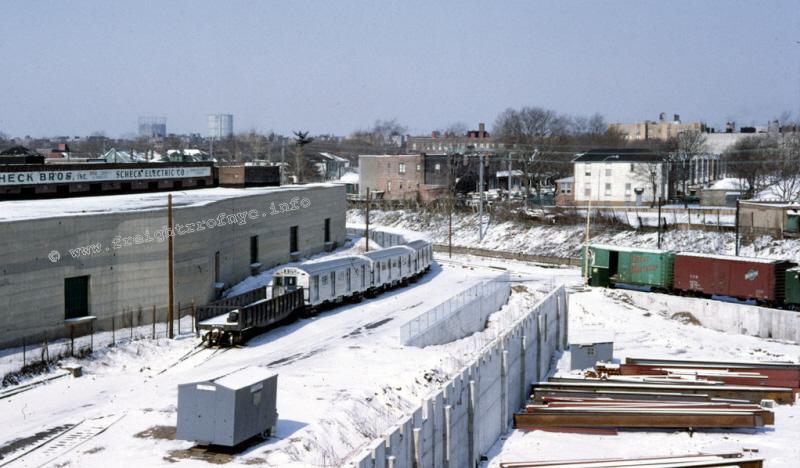
Parkville Interchange - Brooklyn NY - March 21, 1965
Looking northwest. Subway cars and gondola on interchange track. Boxcars
are on Bay Ridge Branch freight lead.
Property to left of concrete foundation is former location of LIRR Parkville
Station Freight Yard.
D. Grotjahn photo
D. Pirmann collection
added 19 Dec
2009
.
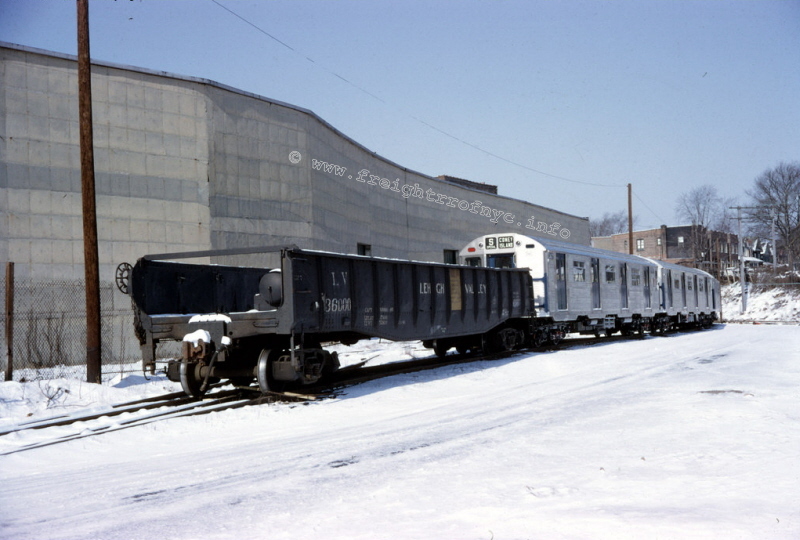
Parkville Interchange - Brooklyn, NY - March 21, 1965
Looking northwest. Note the air reservoir in the gondola. According to Paul
Strubeck, that Lehigh Valley gondola was modified
for use in hauling subway cars on Lehigh Valley trackage on mainland U.S.
Why it is seen here is not known,
(considering SBK has it's own transition cars) but apparently it is capable
of transition use between
standard AAR couplers (on Class 1 and SBK diesels) and the H2A type couplers
on the R32's.
D. Grotjahn photo
D. Pirmann collection
added 19 Dec
2009
.
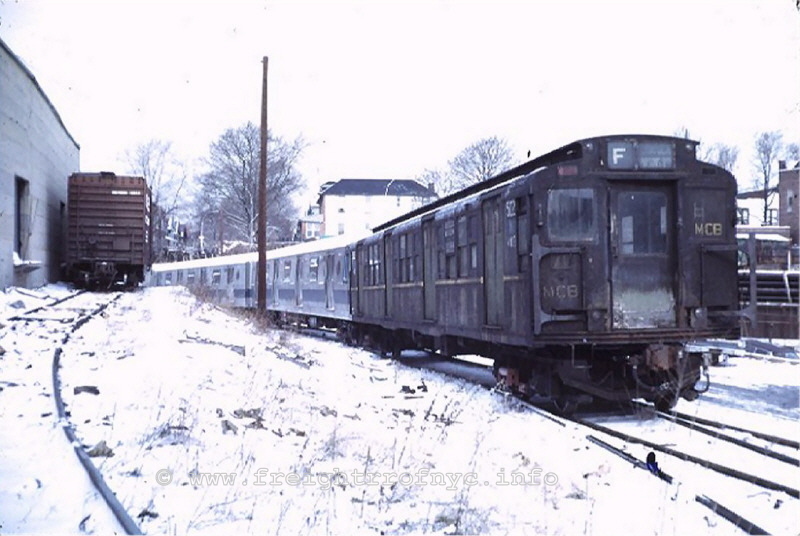
Parkville Interchange - Brooklyn, NY - February 18,
1972
Looking north. New R44's being delivered with R1 transition car (Note end
of transition car is marked "MCB" for MCB coupler.
Other end of transition car will have Form 70 Walton electric coupler). Box
car on left edge of photo is on Leeds Paper warehouse.
Points and turnout under lead truck of subway car lead to Scheck Brothers
siding.
S. Zabel photo
J. Testagrose collection
added 19 Dec
2009
.
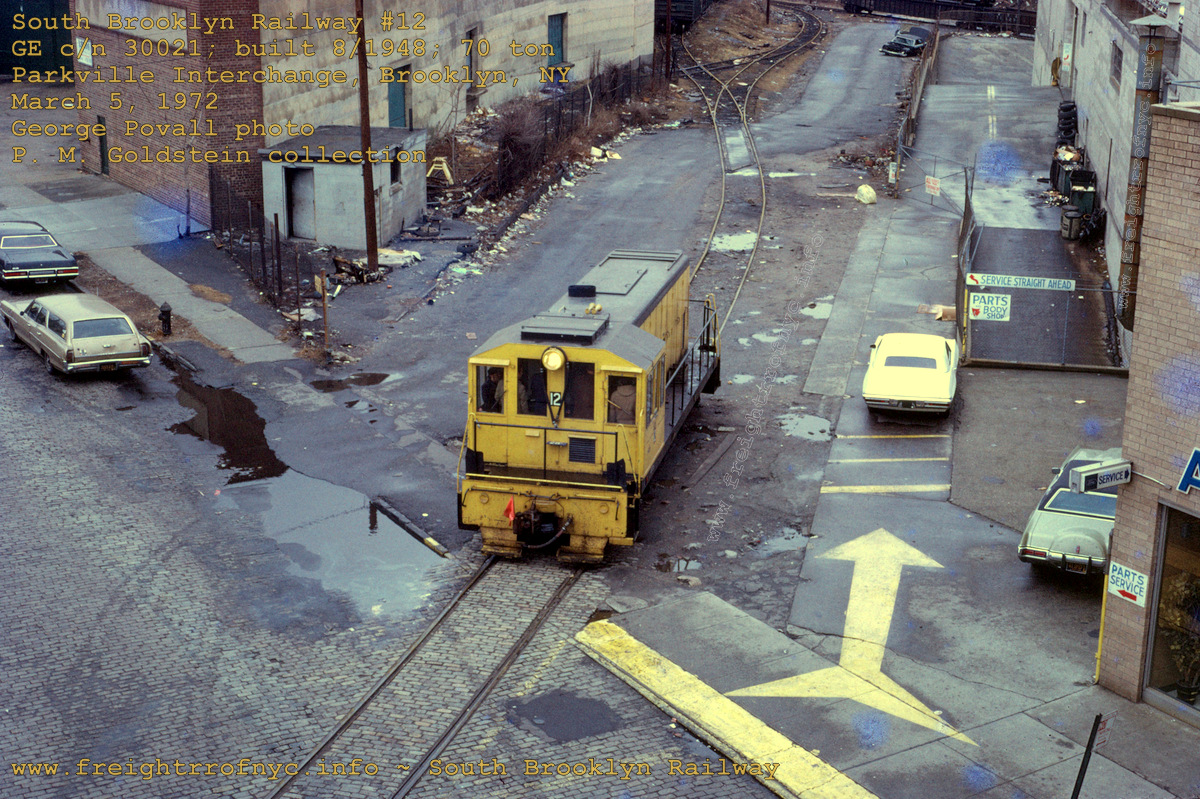
Parkville Interchange - Brooklyn, NY - March 5, 1972
Looking north-northwest and taken from the elevated platform of the Avenue
I station of the IND 'F' (Sixth Avenue Local) line.
#12 on interchange track at curbline of Avenue I with Penn Central Bay Ridge
Branch (ex-NYNH&H / LIRR) tracks in background.
Note boxcar at top center of photo is on "Leeds Paper" siding and gondola
with pipe is on Bay Ridge Branch freight lead.
Also note the single interchange track (as opposed to twin interchange tracks
and other parallel trackage) shown in Emery map above.
Telephoto compression makes length of track appear shorter than actual.
G. Povall photo
authors
collection
added 18 December 2009 - rescanned 18 April 2021
.
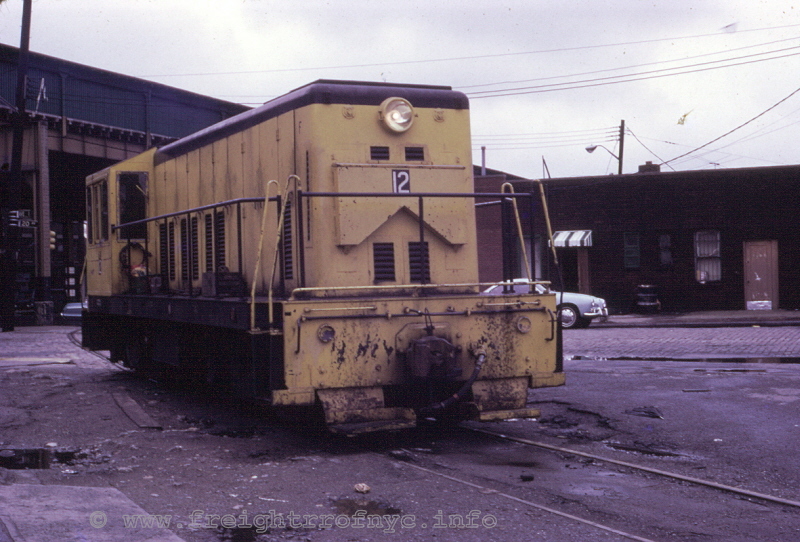
Parkville Interchange - Brooklyn, NY - March 5, 1972
Looking south-southeast. #12 on interchange track at curbline of Avenue I
with
McDonald Avenue (IND "Culver / Sixth Avenue"
![]() elevated line) in
background.
elevated line) in
background.
G. Povall photo
authors
collection
added 18 Dec 2009
.
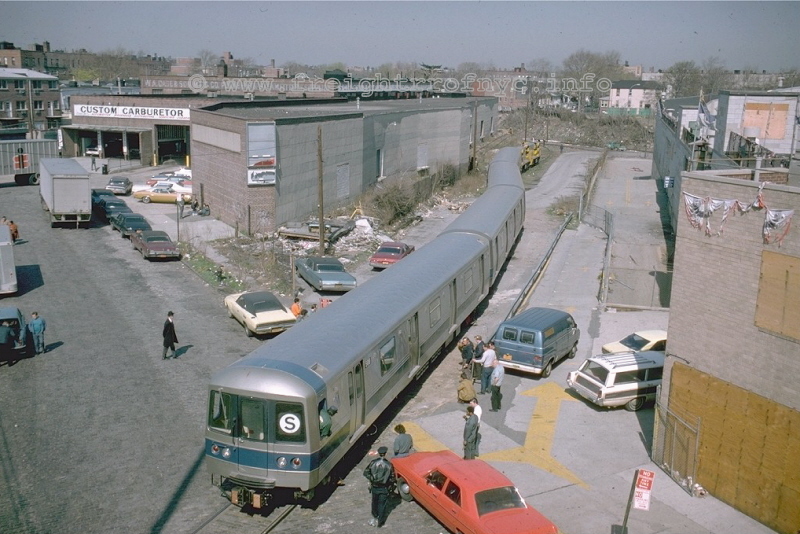
Parkville Interchange - Brooklyn, NY - April 23, 1975
Looking north-northwest and taken from the elevated platform of the Avenue
I station of the IND 'F' (Sixth Avenue Local) line.
Unidentified NYCTA diesels at head of train of R46's. The red Plymouth Valiant
is the official "SBK escort" car for street running.
S. Zabel photo
D. Pirmann collection
added 19 Dec
2009
.
It is also inferred (but not confirmed) that South Brooklyn Railway would also provide occasional freight service to the tenants of that weirdly shaped building (Leeds Paper & Scheck Brothers) at the Parkville Interchange, as photos taken in 1972 exist of freight cars on these sidings with an South Brooklyn Railway locomotive in view and apparently performing switching services..
This Leeds / Scheck structure is quite unique and the north wall was gull winged, as the walls actually curved to accommodate the unique "criss cross" arrangement of the siding tracks. The curved walls may be seen in a bing.com aerial photo:
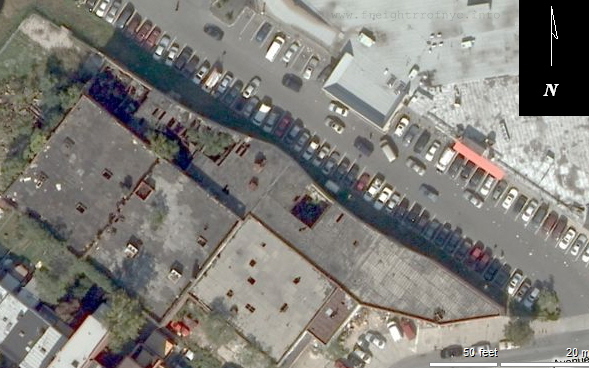
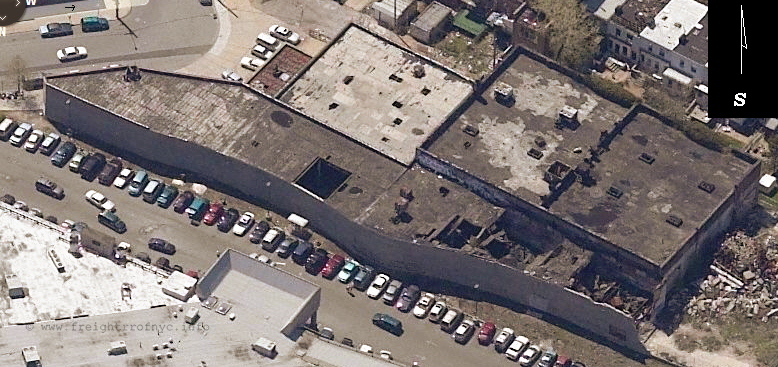
.
As of January 26, 2010; this structure was in the process of being razed (see photo in remnants chapter).
Returning to the "mainline" of the South Brooklyn Railway, the right of way would continue south towards Coney Island following McDonald Avenue to Kings Highway, where both the McDonald Avenue and the South Brooklyn Railway jogs a little to the west.
.
13) Avenue S & McDonald Avenue
- Voorhee's Grain Silo / Flatbush Coal & Oil - Gravesend
Heading south on the southbound track (west side of the street), the train would encounter a trailing point turnout and a short stub track located just north of Avenue S. This would be the location of one of the very few actual customer stub tracks on the Gravesend Avenue segment of trackage (currently only two are known - this one and one at Kensington Junction for the lumber yard).
This turnout's arrangement was so a locomotive and train heading south (on the southbound track) could pull past the turnout with a cut of cars, where a trainman would throw the point and then the locomotive could then reverse direction and push the railcar into the spur and onto thep property. Presumably there was a "between the rails" pit, where the feed or grain could then be offloaded and a conveyor would carry the feed/grain to the top of the silos where it could be dispensed.After researching 1916 E. Belcher Hyde Property Maps, I was able to learn that this location was originally William K. Voorhee's Grain Elevator. A track connection is not seen on the property map, but thanks to survey images for construction of the BMT Culver Elevated taken in 1915 and again in 1917, the spur is evident.
It is also understood that Voorhee's Grain Elevator had been a
supplier for feed for the horses for the Brooklyn Jockey Club and the
Gravesend
Race Track which was pretty much diagonally across Gravesend Avenue and
the stables one and a half blocks south. Voorhees would also sell as
well
as to the public.
On the property map dated ca. 1890, the property plot was listed
as being owned by "Van Sicklen, Voorhies and Stryker". By 1899, the
property only bears the name W. K. Voorhies. Please note
the spelling of
Voorhies vs. Voorhees changes between those seen on the property maps
and that of
which is actually painted on the side of the silos. As I'm more
inclined to believe the person actually knew how his own name was
spelled, I'll conclude Voorhees was the correct spelling. Also note
that the alignment of Lake Street is proposed and not yet actually
constructed.
| 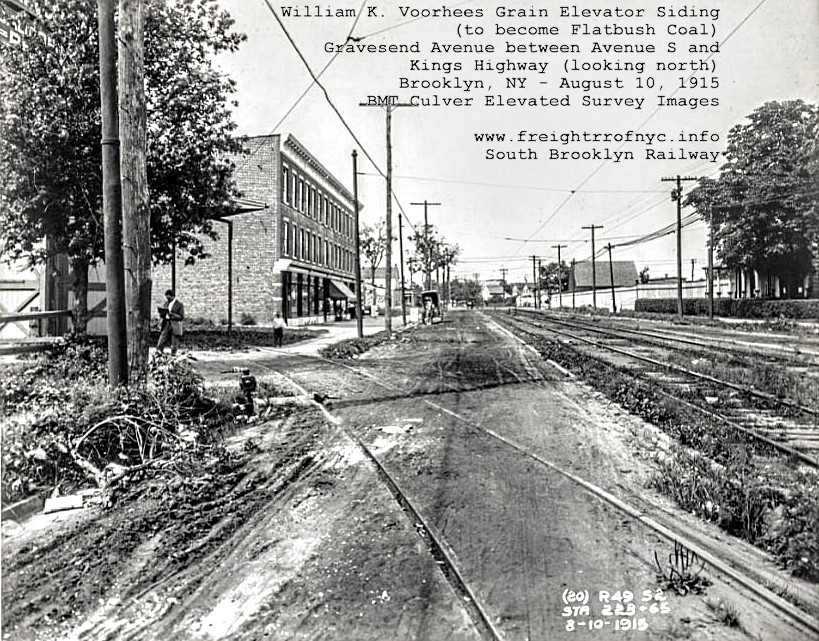 |
| E. Belcher Hyde - Atlas of Brooklyn, NY - 1899 Volume 3, Plate 2 - Brooklyn NY (note Kings Highway incorrectly identified as Avenue R - further west on this map this thoroughfare bears the Kings Highway name) annotated image by author added 08 May 2021 | August 10, 1915 Note trolley wire extending into spur. unknown provenance annotated image by author added 08 May 2021 |
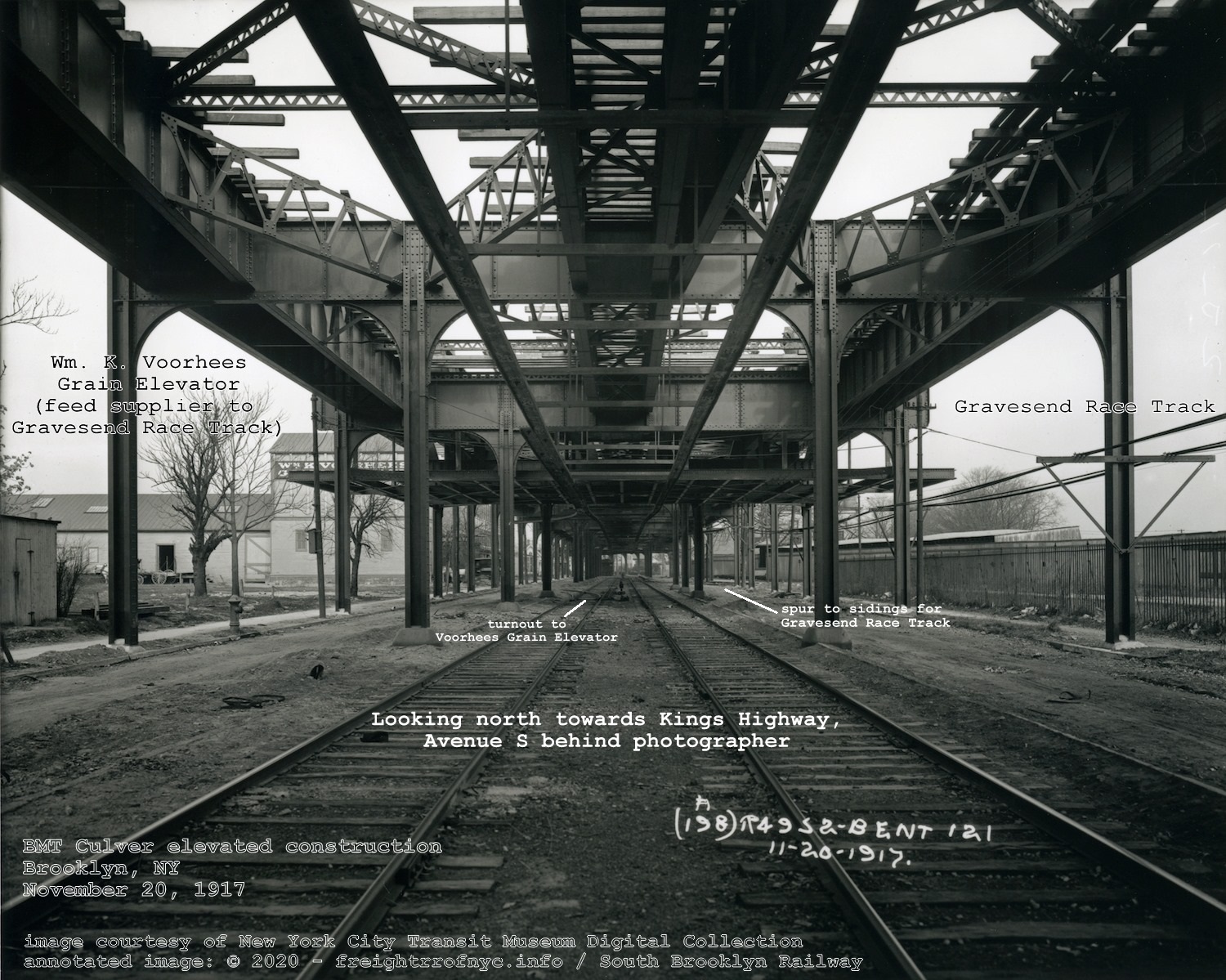
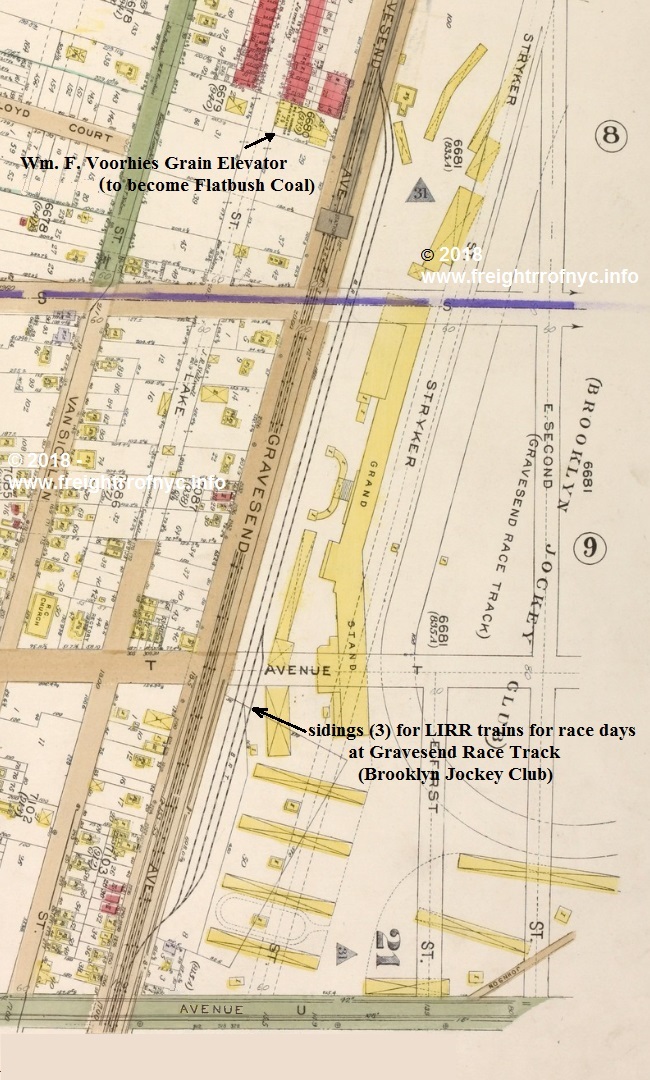 E. Belcher Hyde Property Map - 1916 Volume 3, Plate 10 (spur to grain elevator not shown but known to exist) courtesy of New York Public Library Digital Archives annotated version ©2018 by author added 11 July 2018 | |
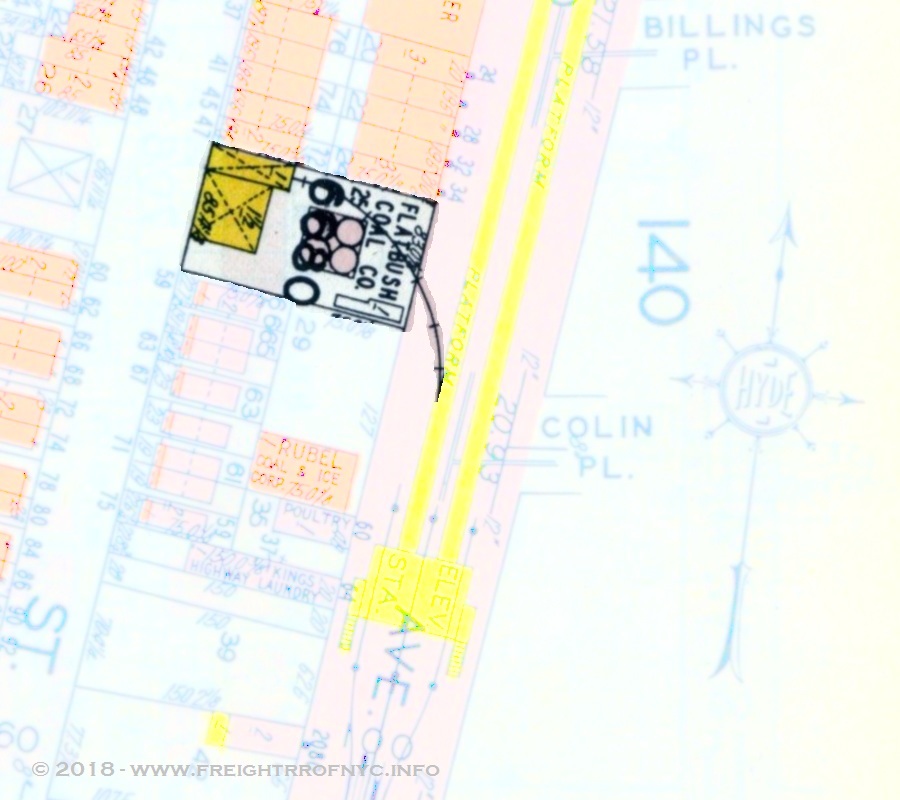 E. Belcher Hyde Property Map - 1929 Volume 4, Plate 137 courtesy of Historic Map Works annotated version ©2018 by author added 11 July 2018 | 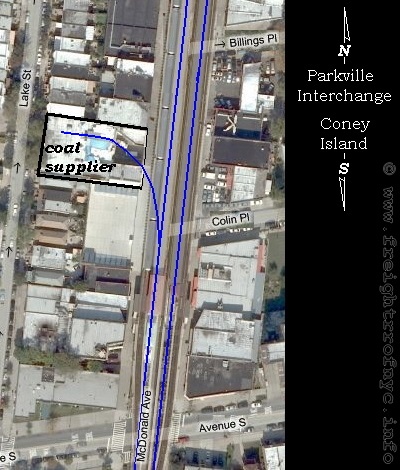 |
As some point in time, but specific date unknown; the property changed hands as well as commodities, and concrete coal silos built and a coal dealer would conduct business there.
I am deeply indebted to Ben Schaeffer for recording the name of the industry, as for many years now it has bothered me that I could not remember for myself! As I lived just a few blocks away, I was always intrigued with the operation, but the short-sightedness of my youth precluded me from taking note of the name. I distinctly recall seeing the "4 pack" coal silos looming above the Avenue S entrance/exit of the Kings Highway Station of the F train. As I lived on Avenue S (and East 8th Street), this was my stop and I used it frequently.
Presumably there was a "between the rails" pit, where the coal could then be unloaded and a conveyor would carry the coal to the top of the silos where it could be dispensed by gravity.
With deepest apologies, I cannot recall who sent me the following images
some time ago, so if you see them, please give me a shout so I can
credit your contribution. In these next series of images, taken ca.
1940 are from the New York City Property Assessment Images Series.
These photos show Flatbush Coal between Avenue S and Kings Highway on
Gravesend Avenue with the rail spur leading into underneath the silos;
and the backside of the building from Lake Street showing the tops of the silos.
 Flatbush Coal Co. - 1940 front left of facility taken from Gravesend Avenue courtesy of NYC Department of Records and Information Services added 18 April 2021 | 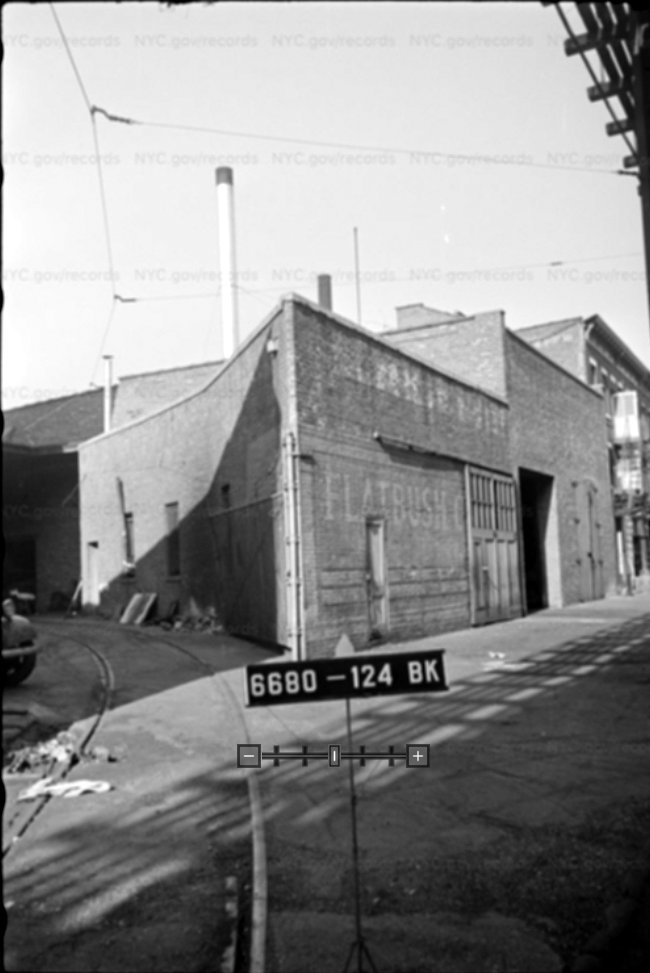 Flatbush Coal Co. - 1940 front right of facility taken from Gravesend Avenue courtesy of NYC Department of Records and Information Services added 18 April 2021 |
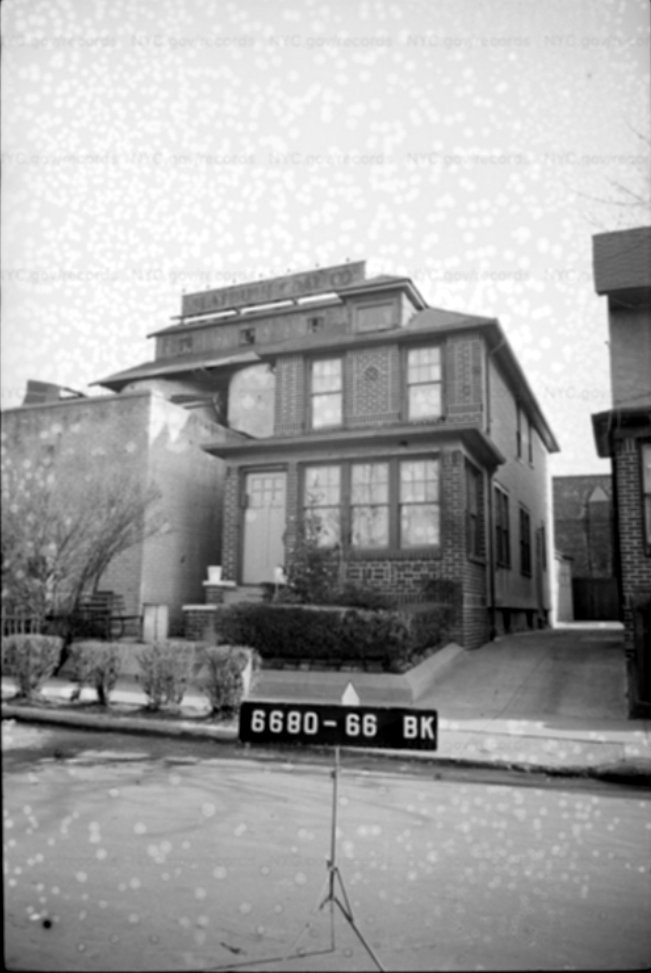 Flatbush Coal Co. - 1940 rear side of facility taken from Lake Street courtesy of NYC Department of Records and Information Services added 18 April 2021 | |
| . . | |
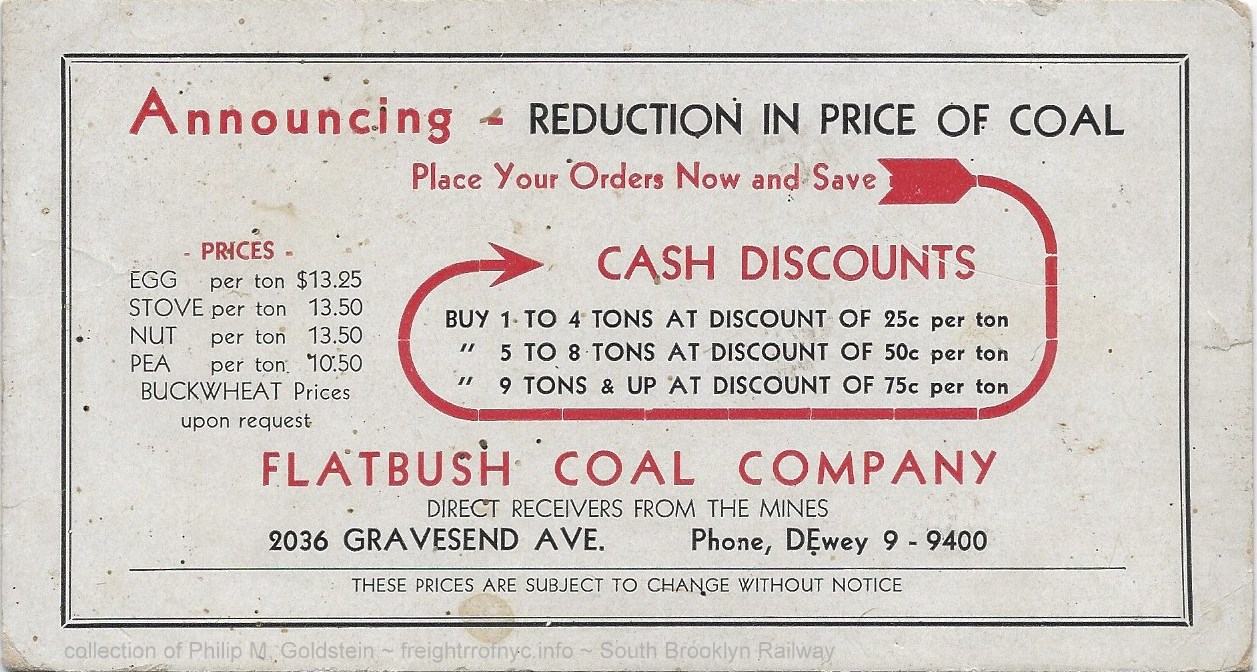 Flatbush Coal advertising ink blotter - pre-1931 (Gravesend Avenue) collection of the author added 07 November 2022 | |
.
14) Avenue U & Gravesend (McDonald)
Avenue Delivery Station - Gravesend
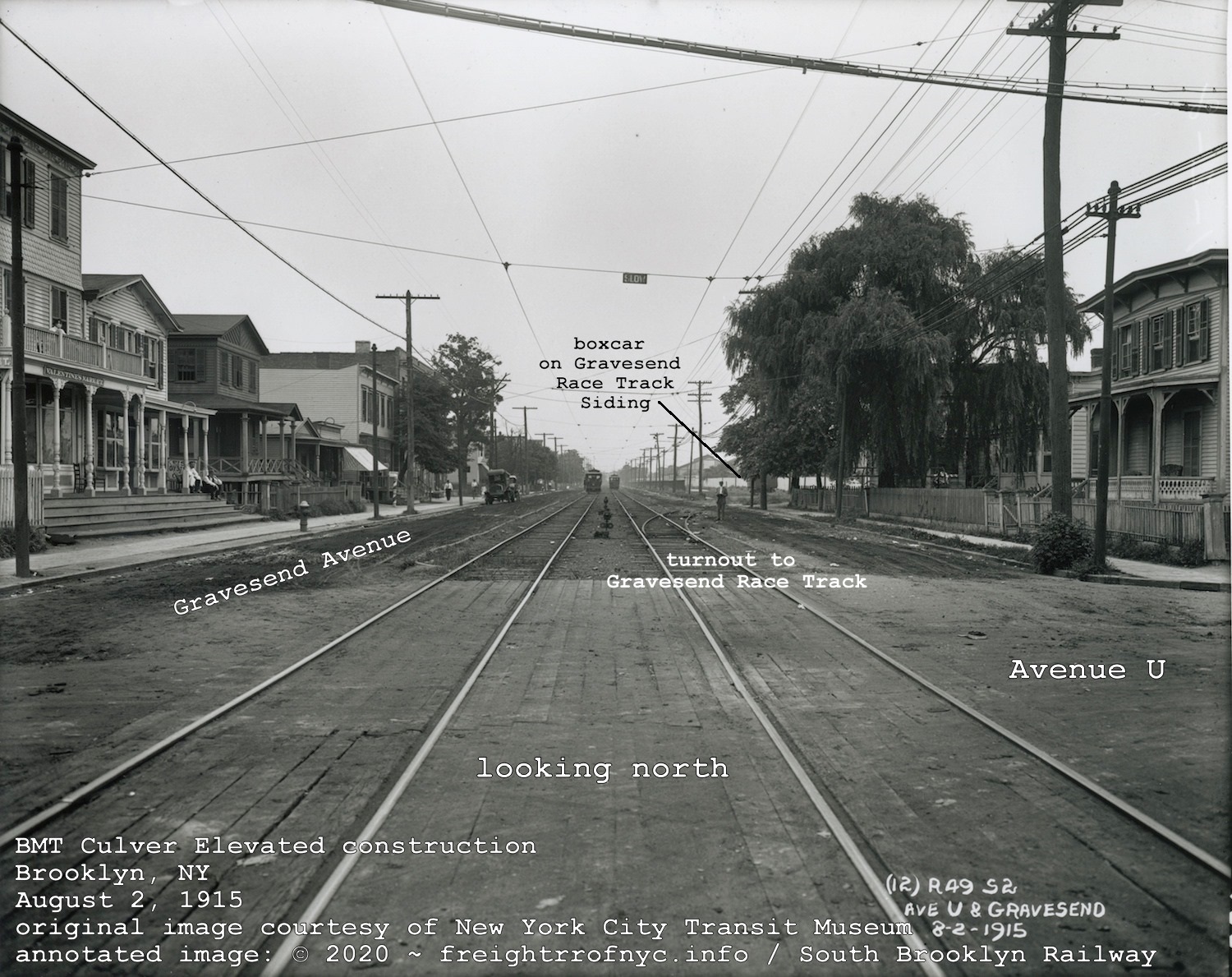
August 2, 1915
courtesy of the New York City Transit Museum Digital Collection
annotated image © 2020 by author
added 15 June 2020
.
According to the book "Brooklyn - A National Center of Commerce & Industry" as published by the Committee on Industrial Advancement of the Brooklyn League in 1914; in the chapter Freight Depots, Piers & Stores on page 42, lists this location for deliveries of freight on the South Brooklyn Railway. At the time this was read, it was unclear if this location hosted a team track, a platform or a full freight station. By the issue date of the 1961 Raudenbush Map does not reflect any presence here, so we might conclude it was long gone by that date. In referencing the 1916 E. Belcher Hyde Property Maps for this area (seen at right); it was then learned there were rather lengthy sidings between Kings Highway and Avenue U along Gravesend Avenue for the "lay up" of the "Brooklyn Jockey Club Specials" that the Long Island Rail Road ran to bring passengers and spectators to the Gravesend Race Track events. These trains are well documented on Art Huneke's website: Brooklyn Jockey Club / Gravesend Race Track and these LIRR steam trains were in addition to the regular scheduled streetcars & trolleys operating along Gravesend Avenue.
Interestingly enough, one of the three sidings (the east most) is
dramatically shorter than the others. Whether this is of any
significance remains to be seen.
After viewing this map, this author had a epiphany. What if (and this
is strictly conjecture here), the Brooklyn Jockey Club itself was the
delivery station?
It is very doubtful there could have been any type of outgoing
freight from a horse racing track per se other than the passengers at
the end of the events, except for maybe manure and perhaps the 'has
been' mounts enroute to the glue or dog food factories. Just
kidding! By the next series of E. Belcher Hyde property atlases are issued in 1929 (excerpt shown below), the entire Gravesend Race Track is gone and the street grid being built to plan. But yet, two of sidings show in the 1916 Map have been cut back to stub tracks ending at Avenue T. Perhaps this would be the impetus to install a delivery station at this location? According to the Linder / Eppler article, "part of the Gravesend Race Track siding at Gravesend Avenue south of Kings Highway was removed" in 1923. Fortunately, we can see in the 1924 Fairchild Aerial Photo, several freight cars shown on the sidings. This was after the Gravesend Race Track was demolished, the street grid completed and residential housing being constructed, as we can still see the turf oval of the racetrack in quite a few of the unimproved and empty lots. Further reference to the Linder / Eppler article states the Gravesend Race Track siding was completely removed in 1925. Lapse forward two years, and the discovery of an image in the digital collection of the New York City Transit Museum. The image is part of a survey series taken for the construction of the Culver Elevated over Gravesend Avenue. One of these images, dated August 1915, is marked "Avenue U & Gravesend" and in it we can clearly see the turnout for the southend of the Gravesend Race Track sidings.
1924 Fairchild Aerial Survey Photo original photo courtesy of New York City Department of Information, Technology & Telecommunications annotated version ©2018 by author annotated by author added 11 July 2018 | ... |  E. Belcher Hyde Property Map - 1916 Volume 2, Plate 12 courtesy of New York Public Library Digital Archives annotated version ©2018 by author added 30 June 2018 . 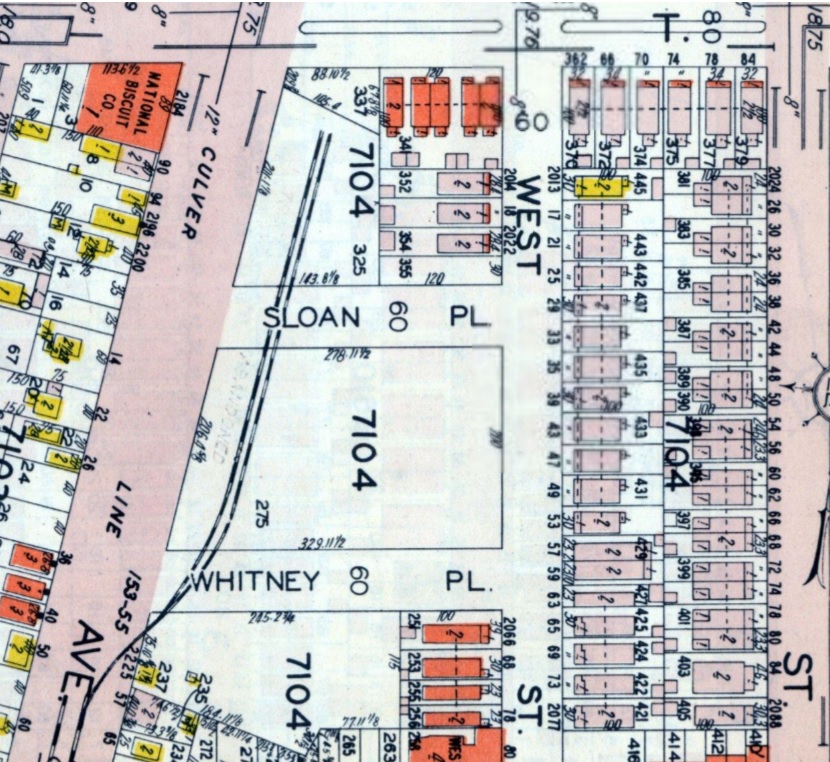 E. Belcher Hyde Property Map - 1929 Volume 4, Plate 138 courtesy of Historic Map Works annotated version ©2018 by author added 30 June 2018 |
15) PP&CI Culver Yard and NYCTA Coney Island
Yard & Shops
Over the course of its history, the South
Brooklyn Railway would come to have at least three different locations in Coney
Island that it would call home to its freight house, and we will address them in chronological order.
The first of
these would be located at the Prospect Park & Coney Island
Railroad's Culver Station. This
streetcar depot also had a yard
and turning loops for the trolleys. We know by viewing both the 1907
Hyde Property Map below and the 1924 Fairchild Aerial photo that this
location also had various sidings for local industries throughout its
existence. I think it can be safely surmised that the South Brooklyn
Railway (as freight agent for the Brooklyn Rapid Transit and owner of
the PP&CI) serviced this industries.
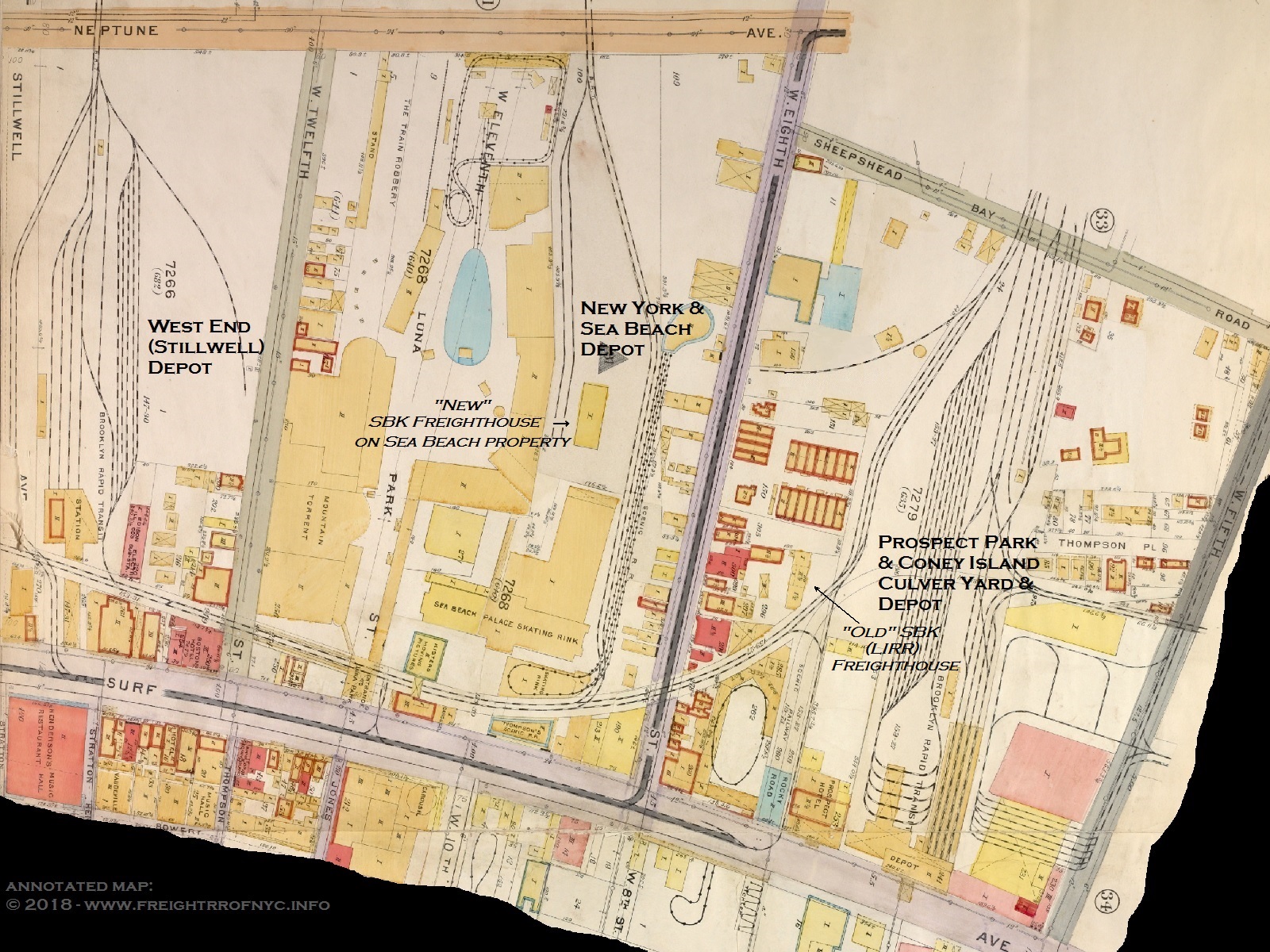
1907 E. Belcher Hyde Property Map
courtesy of New York Public Library Digital Collection
annotated version ©2018 by author
added 11 July 2018
.
.
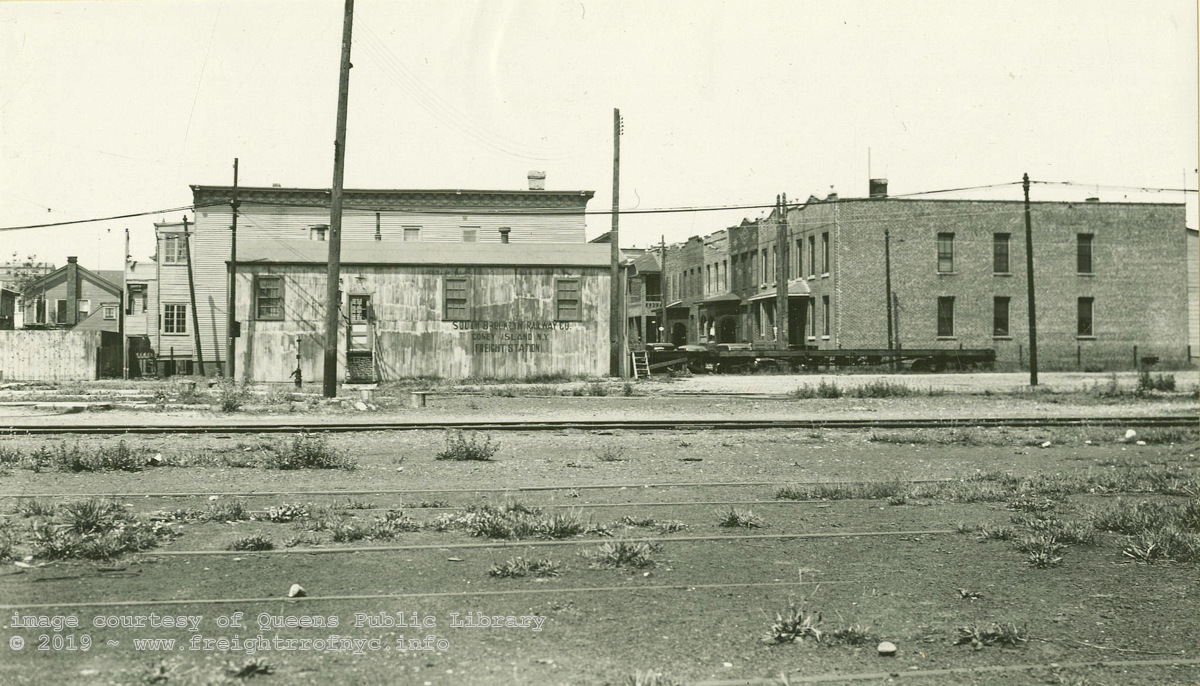
.
.
In 1909, the South Brooklyn Railway filed an application with the Public Service Commission to discontinue using the freight building at the Culver Yard, Coney Island. This freight station, which was owned by the Long Island Rail Road and operated the PP&CI RR; and was stated to be in dilapidated condition. As a result, the South Brooklyn Railway wished to relocate about 1000 feet to a new freight house on the property of the Sea Beach Railway between West 8 and West 12th Streets:
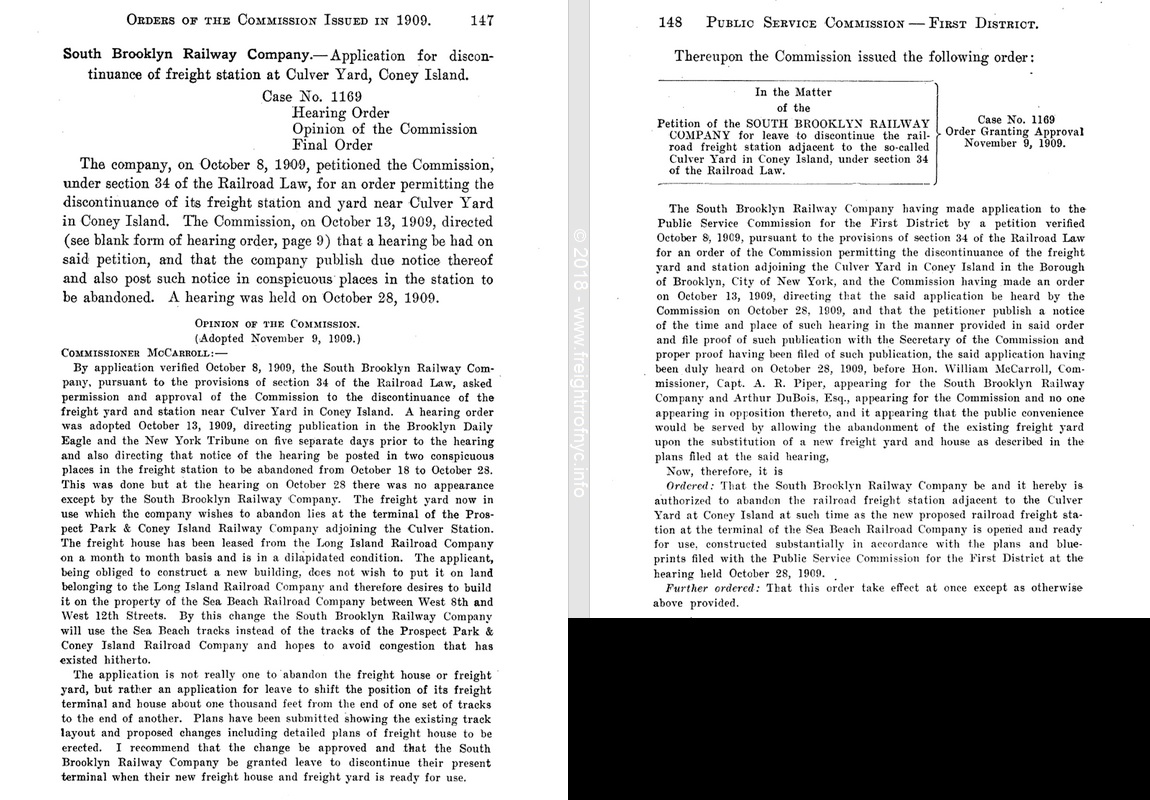
The right image below, reflects the trackage on the Culver Terminal from the June 11, 1904 trade journal "Street Railway Journal". While not specifically mentioned, it gives us an a detailed visual reference of the 'new' Culver Yard & Depot. It is believed that the "dilapidated freight house" in question is on the spur marked "To Long Island RR Freight Yard" on the left edge just south of the Sheepshead Bay Road grade crossing, but this is not confirmed.
The left image is the 1924 Fairchild Aerial Survey Photo below (annotated by the author). This image, while showing more than the basic area pertaining to the South Brooklyn Railway, was deemed beneficial as it shows the various locations used throughout the history of operations of the South Brooklyn Railway in relationship to one another and in one image.
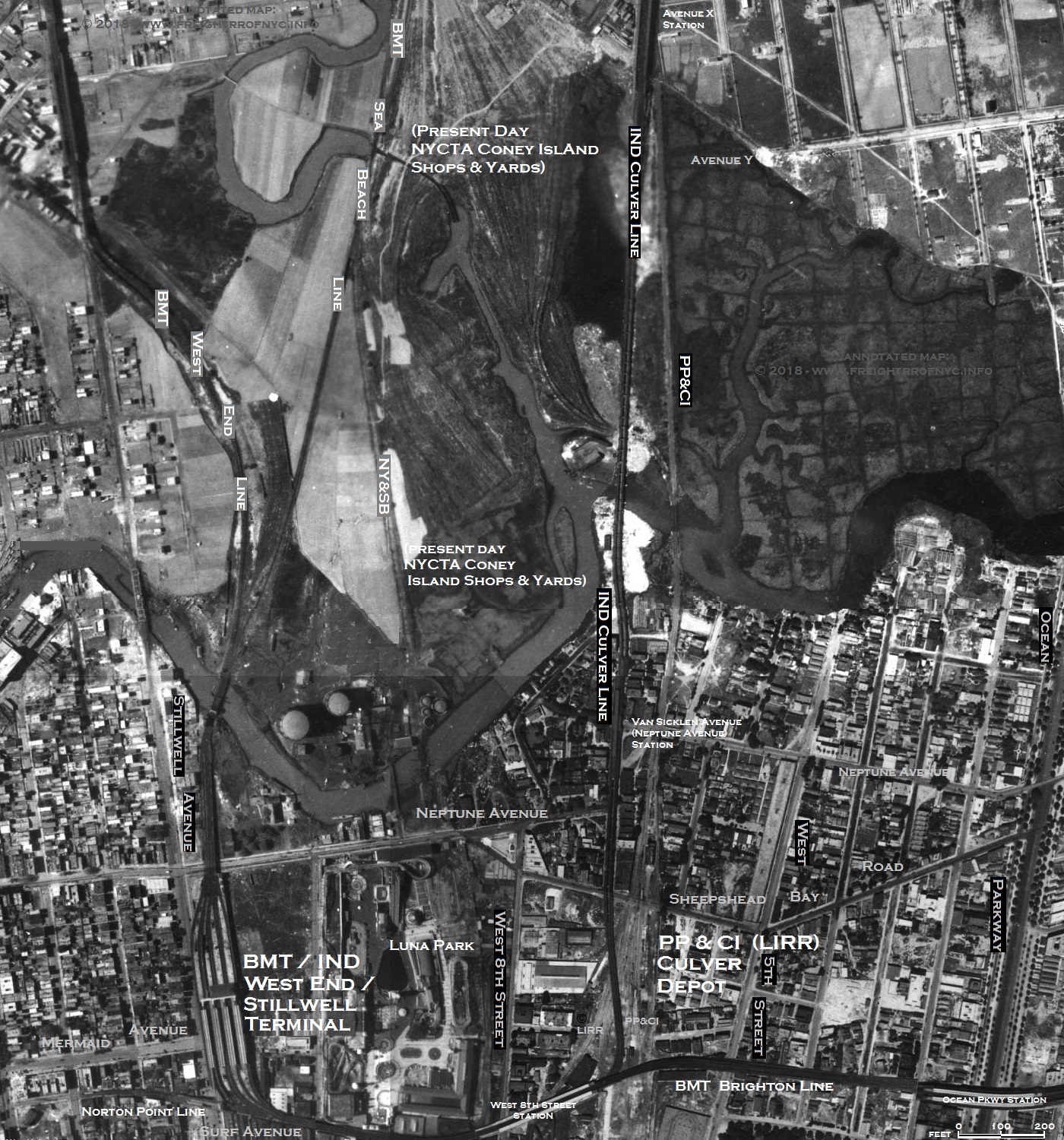 1924 Fairchild Aerial Survey Photo courtesy of New York City Department of Information, Technology & Telecommunications annotated by author added 11 July 2018 image to right: June 11, 1904 Street Railway Journal Google Books added 11 July 2018 |  |
 ) would come to dissect the Prospect Park & Coney Island Railroad Culver Yard.
) would come to dissect the Prospect Park & Coney Island Railroad Culver Yard.As originally built, the Prospect Park & Coney Island Railroad right of way (and with it the route that South Brooklyn Railway followed) veered a bit to the east at Avenue X and Gravesend Avenue and came out from under the Culver elevated. This route took it through undeveloped land and tidal marsh back in those days, and it was built upon fill with a small trestle crossing the Coney Island Creek (before it was filled in).
Also, at the intersection of Gravesend (McDonald) Avenue and Avenue X, the name of McDonald Avenue changes to Shell Road. And, upon being built in 1926, the southwest corner of this intersection begins the Coney Island Shops of the New York City Transit Authority.
At some point between the construction and opening of the Coney Island Yards & Shops in 1926 and 1929, the South Brooklyn Railway relocated to this location. By the publication of the 1929 edition of the E. Belcher Hyde Property Maps; the BMT Coney Island Yards are shown. But more importantly a subyard is shown connected to the Shell Road street trackage. And this would become the South Brooklyn Railway Coney Island Yard, if it is not already.
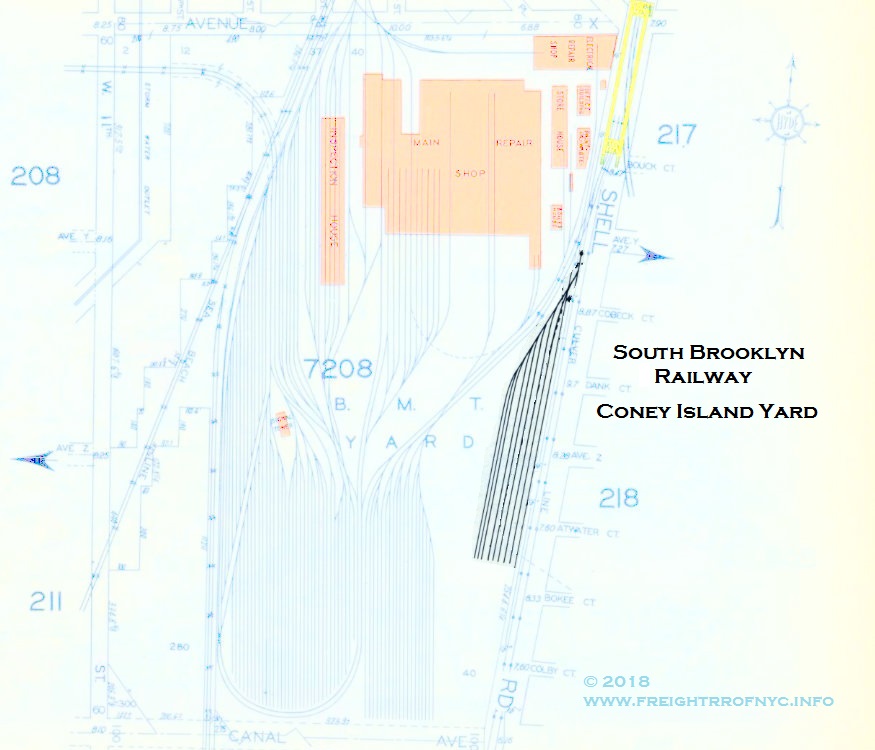
1929 E. Belcher Hyde Property Map
courtesy of Historic Map Works
annotated version ©2018 by author
added 11 July 2018
Also, it bears noting, that after the construction of the Coney Island Shops and Yard in 1926, the streetcar trackage of the was also realigned a few hundred feet to the west to follow the newly constructed Shell Road (and which would continue under the Culver el for another few blocks south). The reason for this being the tidal marshes were filled in to the east of Shell Road with residential housing being constructed in the adjacent areas.
In this next image, the 1951 Aero Service Corp Aerial Photo; we can see the Coney Island Shops and Yards and where the SBK would have its southern terminal. We can also compare the topography of the area, namely the filling in of the tidal marshes and the truncation of the Coney Island Creek allowing the Coney Island Shops to be built.
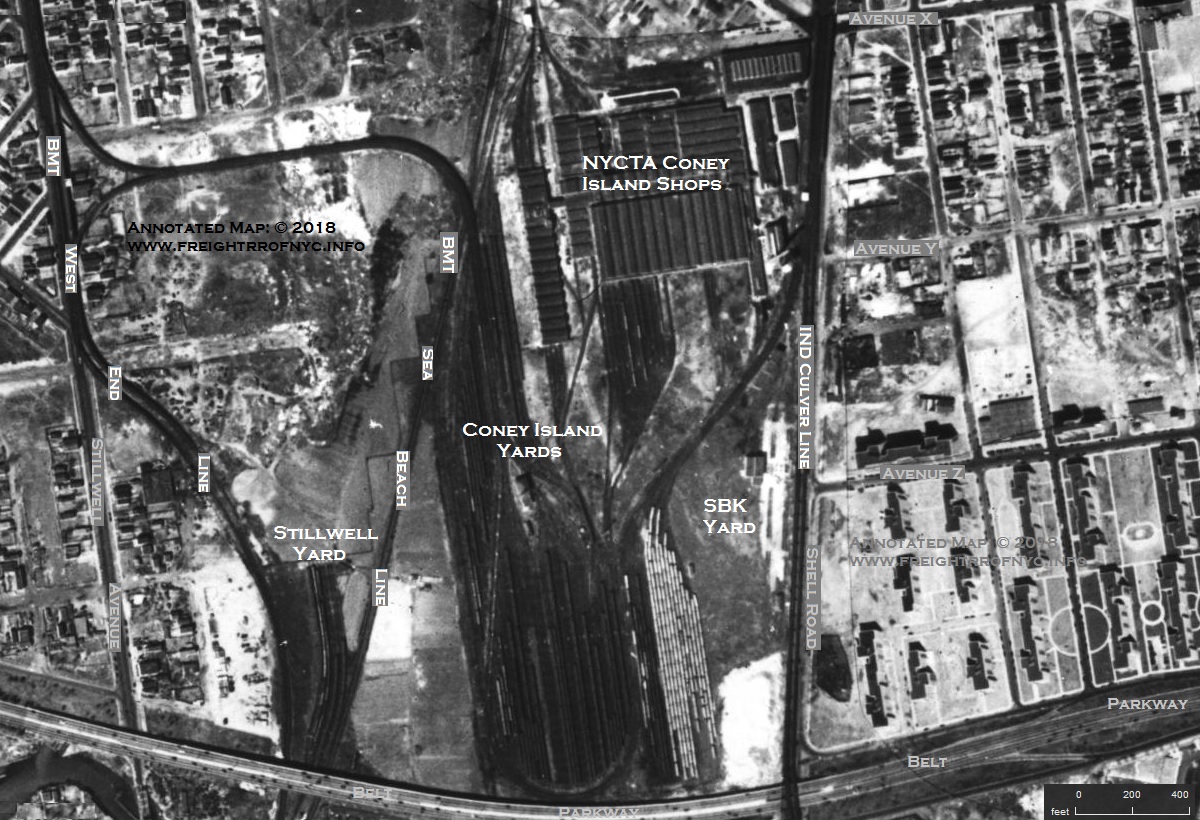
1951 Aero Service Corp Aerial Photo
annotated by author
added 11 July 2018
Once the South Brooklyn Railway train has entered their yard and passed over turnout #3, this turnout would be thrown and the train would reverse direction and proceed north into the Coney Island Shop trackage. This "switchback" maneuver is shown in the left image below.
Please take note: the track work of the South Brooklyn Railway Yard seen in the left image was partially "reconstructed" from examining a 1954 aerial photo seen on historicaerials.com. It appears a significant amount of trackage was "in the dirt" and barely viewable, so the possibility of more trackage at this location exists.
In the right image below, the original South Brooklyn Railway yard lead track into the Coney Island Shop track can be seen, and it is represented by the number 4 in the diagram at left. The resurfacing of Shell Road and subsequent reconstruction and expansion of the Coney Island Facility, made this location in the photo the ad hoc end of track.
|
|
"switchback" track arrangement for |
.
.
One of the more significant movements of the South Brooklyn Railway to the Coney Island Shops, was the U. S. Department of Transportations "State Of The Art Car" heavy rail mass transit demonstrator set. Built by St. Louis Car Company, and after testing at the DOT's High Speed Ground Test Center in Pueblo, Colorado, the SOAC set was demonstrated on six rapid transit systems throughout five cities in the United States, to include additional testing and public ridership and response. The first of these cities was to be New York City.
Each of the cars had different seating configurations for study; low density and high density. The high density car had transverse and longitudinal seating with a total seated capactiy of 72, allowing more standing passengers and this allowed a total of 300 poassengers total. The low density car has 62 seats in three sections: one with transverse seating (like MetroNorth or Long Island Rail Road), the second with a mix of seat types and the third section a mix of seat arrangements and two tables. Both cars were 'A' cars with operators cabs at the ends, so the set could be operate in either direction.
The SOAC Cars and two transition cars (converted gondolas) at each end with a coupler for the SOAC set on one end and MCB coupler on the other end to allow conventional locomotives to tow the set to the next demonstration location.
The SOAC cars and transition cars were carfloated from Greenville, NJ into Bush Terminal by New York Dock Railway, then interchanged with the South Brooklyn Railway at 38th Street and Second Avenue Yard, and the SBK which brought them to the Coney Island Shops for inspection and preparation for service on the NYCTA Rapid Transit (Subway) system.
Revenue service began on May 17, 1974 and would operate on the A, D, E and N lines with the two car set restricted to Independent Division (IND) routes. Demonstration was completed on July 19 of the same year, and the two car set and transition car (a converted gondola) were shipped out the way they came in to the next city. These cars survive and are located at the Seashore Trolley Museum in Kennebunkport, ME.
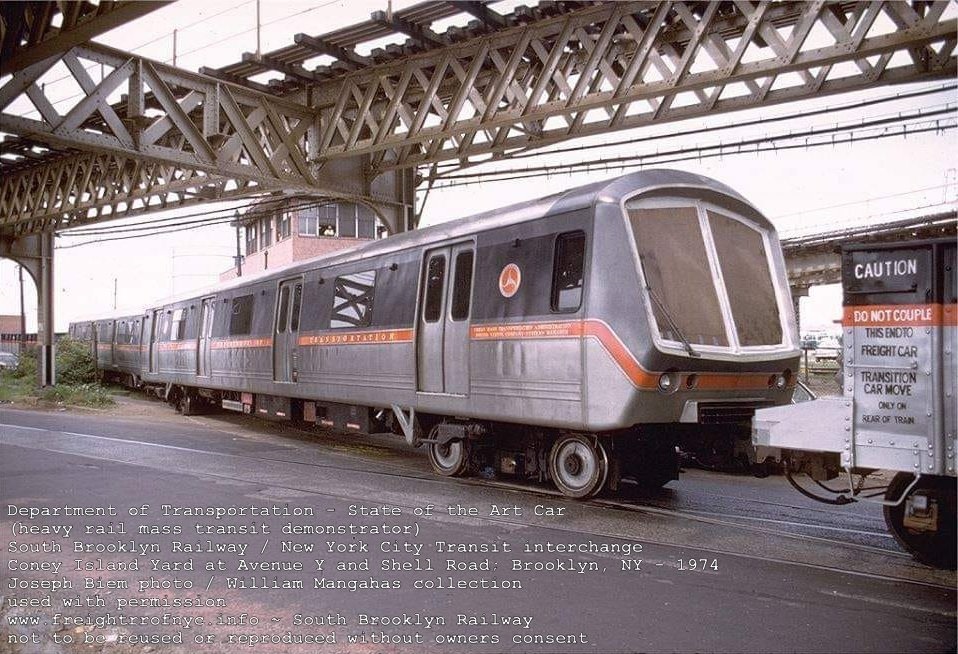
16) Bedford Car Load Freight
Station
On 10 July 2010, I was doing research for the Union Inland Freight Station in Manhattan. I took out my 1943 Map of Railroad & Terminal Facilities in the Port of New York, and after referencing the Union Inland Freight Station, I began to "explore".
I took note of a solitary facility way out in the middle of Bushwick, Brooklyn. It shows simply "Bedford, S. Bklyn" and the location is noted as being Car Load Delivery. The problem here is, there is no trackage to this location!
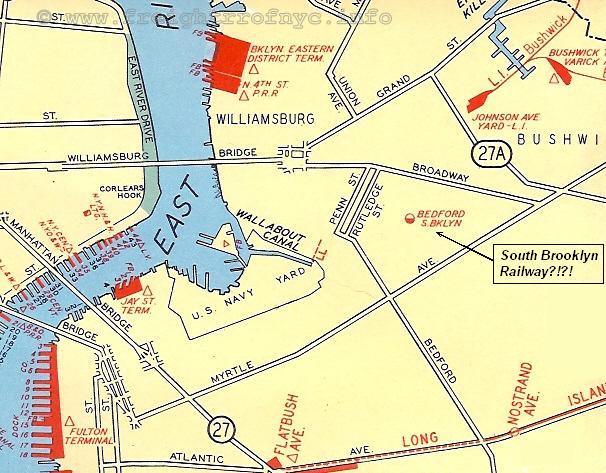
1943 Map of Railroad & Terminal Facilities in the
Port of New York
authors collection
added 10 July 2010
.
Originally, when this page was first composed, there was no reference to this location anywhere else and as far as I have searched. At that time, I could only come to the following hypothesis as to the purpose of this location:
1) it was served by electric streetcar, or |
Ongoing research conducted in 2018, now revealed some interesting information on this location. As it would happen, this location was the premises of Arabol Manufacturing at 56 Nostrand Avenue, Brooklyn, NY. Upon reading a very lengthy testimony transcript contained within the Notice of Appeals for the Appellate Division of the New York Supreme Court; Brooklyn Heights Railroad v. Alfred Steers dated March 1912, it is revealed that the Arabol Manufacturing Company acted as freight agent (as well as being a customer themselves) for several local businesses in conjunction with the South Brooklyn Railway.
According to photographs contained in the exhibits, this location had a sign "Bedford Freight Station - South Brooklyn Railway" and businesses that utilized this "freight station" include Amid Duron (in the same building with Amadol), Charles Froeb (wholesale distributor of wines & liquors) and J. W. Oelerich (food packaging).
Upon reading this transcript, this Mr. Steers had brought suit against the South Brooklyn Railway / Brooklyn Heights Railroad for blocked the sidewalk with freight cars on a spur that ran into the Amadol property. (It is both sad and refreshing to see that "NIMBYism" dates way back and is not particular to this modern era of litigiousness!)
So at least we now know something about this Bedford Freight Station and are slightly relieved that we were correct with out first option above. And, I think it can be safely concluded that service to this location would have concluded with the cessation of streetcar traffic.
.
.
17) Motor truck delivery
service
As it turns out, I might just be closer to figuring out the actual purpose for the Bedford location above, than I realized. By referencing a particular paragraph in the article below, an unusual facet of South Brooklyn Railway's operation comes to light:
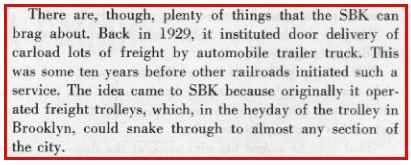
excerpt from March 1955 issue of "Transit
Magazine"
collection of Joseph D.
Korman
added 10 July 2010
Coincidentally, in the chapter discussing the South Brooklyn
Railway, it is mentioned on page 75 of "Railroads of New York" by G. W. O'Connor
(Simmons Boardman Publishing, 1949):
"It also operates a fleet of trucks."
We know now that the South Brooklyn Railway contracted with Horstmann trucking, and operated their Paramount Station which offered truck delivery from the main freighthouse to the customers door, via motor truck. This is discussed a little more at length in the Customers chapter above.
With this "Bedford" location still shown on the 1949 edition of the New York Harbor Terminals Map, but no longer shown on the 1951 edition or subsequent issues of the New York Harbor Terminals Map; the exact year this facility was closed now appears even clearer, however the exact year that South Brooklyn Railway motor truck delivery ceased remained unknown. It is my foregone conclusion that the reason service stopped is that this service become superfluous with the widespread use of the private motor truck.
.
.
.
Rerouting Throughout the
Years
.
Original Route: |
Original Route: 39th Street / 37th Street / Kensington Junction / Gravesend/McDonald Avenue to Coney Island Yard & Shops (1926-1978) |
According to Jay Bendersky's book "Brooklyn's Waterfront Railways"; on February 1, 1978, the South Brooklyn Railway ceased operations on the portion of trackage south of Fort Hamilton Parkway, including the trackage between Dahill Road and Avenue I along McDonald Avenue.
Also, according to an email received on 09 January 2010 from Dan C. he states:
"I lived near McDonald Avenue from 1960 to 1990. McDonald Avenue was reconstructed in 1978. It was at that time that the tracks were removed from the rebuilt LIRR overpass between Foster Avenue and Elmwood Avenue. Tracks were also removed at the intersection with Avenue X / 86th Street. These removals severed the connection. But for some unknown reason the now useless tracks were left in the street on McDonald Avenue while the outer lanes were properly torn up and rebuilt. When I left Brooklyn in 1990 the tracks were still there. If I remember correctly, they were paved over by 1992 and have been subsequently ripped out of the roadbed by the NYCDOT.
Even stranger was that in 1979 the NYCDOT painted Railroad Crossing indicators on the pavement of all the streets crossing McDonald even though by then it was by then impossible for trains to run there. They also put up little Railroad Crossing inventory tags on the pillars of the el. Maybe some of them are still there."
His email caused me to recollect the fresh "R X R" pavement markings, so this may be my source for believing the McDonald Avenue trackage was still in service. But, with that Avenue X / McDonald Avenue trackage removed, it would have been impossible for trains to access the Coney Island Rapid Transit Car Overhaul Shop, (or more simply: "the Coney Island Shops") and Coney Island Yard via McDonald Avenue trackage.
While I originally understood the right of way to have been shut down in two phases (36th Street Yard to Avenue I and Parkville Junction to Coney Island Yard), a lengthy telephone conversation with Ben Schaeffer; his information shows my understanding to be faulty, as the entire South Brooklyn Railway right of way from the east exit of the 36th Street Yard to Coney Island Yard being shut down at the same time. (Therefore I now believe that the street markings of R X R are what is causing me to think of a two segment shutdown.)
According to Ben, the last movement of any kind on the southern segment (Parkville Interchange to Coney Island Yard) was Sperry Car #402 being brought from Coney Island Yard to Parkville Junction on Thursday, January 31, 1978. On that same day, Conrail BR-1 (Oak Point Yard, Bronx to Bay Ridge, Brooklyn) dropped several cars for pick up by South Brooklyn Railway at Parkville Interchange.
The next day; on Friday, February 1,
1978; South Brooklyn Railway
removed those few cars from Parkville and brought them points north
along the Kensington Junction to 36-38th Street Yard segment.
After this last movement, all street trackage between
the 36-38th Street Yard and the Coney Island Yard including 37th
Street and McDonald Ave was embargoed. The reason for this embargo was
for the anticipated resurfacing of McDonald Avenue.
In July of 1978, the New York City Department of Transportation sent a crew to apply the "RXR" pavement markings at each intersection as compliant with highway safety regulations. Ironically about the same time, a notice for abandonment was filed with the Interstate Commerce Commission by the South Brooklyn Railway to abandoned its trackage south of Fort Hamilton Parkway.
To the best of Ben's recollection, on or about August 1981 the abandonment was approved. In approximately 1983, the McDonald Avenue overpass over the LIRR Bay Ridge Branch was scheduled for reconstruction. When it was rebuilt, street trackage was not part of the new design. This author distinctly remembers the tracks embedded in McDonald Avenue abruptly ending on both the north and south sides of the new overpass, but no tracks in the newly poured concrete of the overpass itself! This was before I became a historian, and I also recalled saying to myself "what idiot designed this? How will the South Brooklyn Railway use the McDonald Ave trackage!?!?" (Not realizing at that time the SBK street trackage along McDonald Avenue had been abandoned.)
No matter, as no train had or would ever transverse the trackage, since 1978 or would again. Most of the trackage on McDonald Avenue did remain embedded yet visible in the street for many years to come.
Due to the lobbying of Dov Hikind, a local Brooklyn
assemblyman; the trackage along McDonald Avenue was at first simply paved over. The Parkville
Interchange was in his district, and I believe it was stated in his proposal,
that the:
railway wasn't used to it's full potential,
that alternative routes existed,
the rails in the pavement both presented asphalt resurfacing problems, and
when wet, the rails were slippery causing vehicular and pedestrian accidents.
At some point during the 1990's, that resurfacing had grown dilapidated and to so effect a proper job, the now buried rails needed to be excavated and new substrate laid. And so McDonald Avenue was completely torn up, the rails removed and the thoroughfare resurfaced.
.
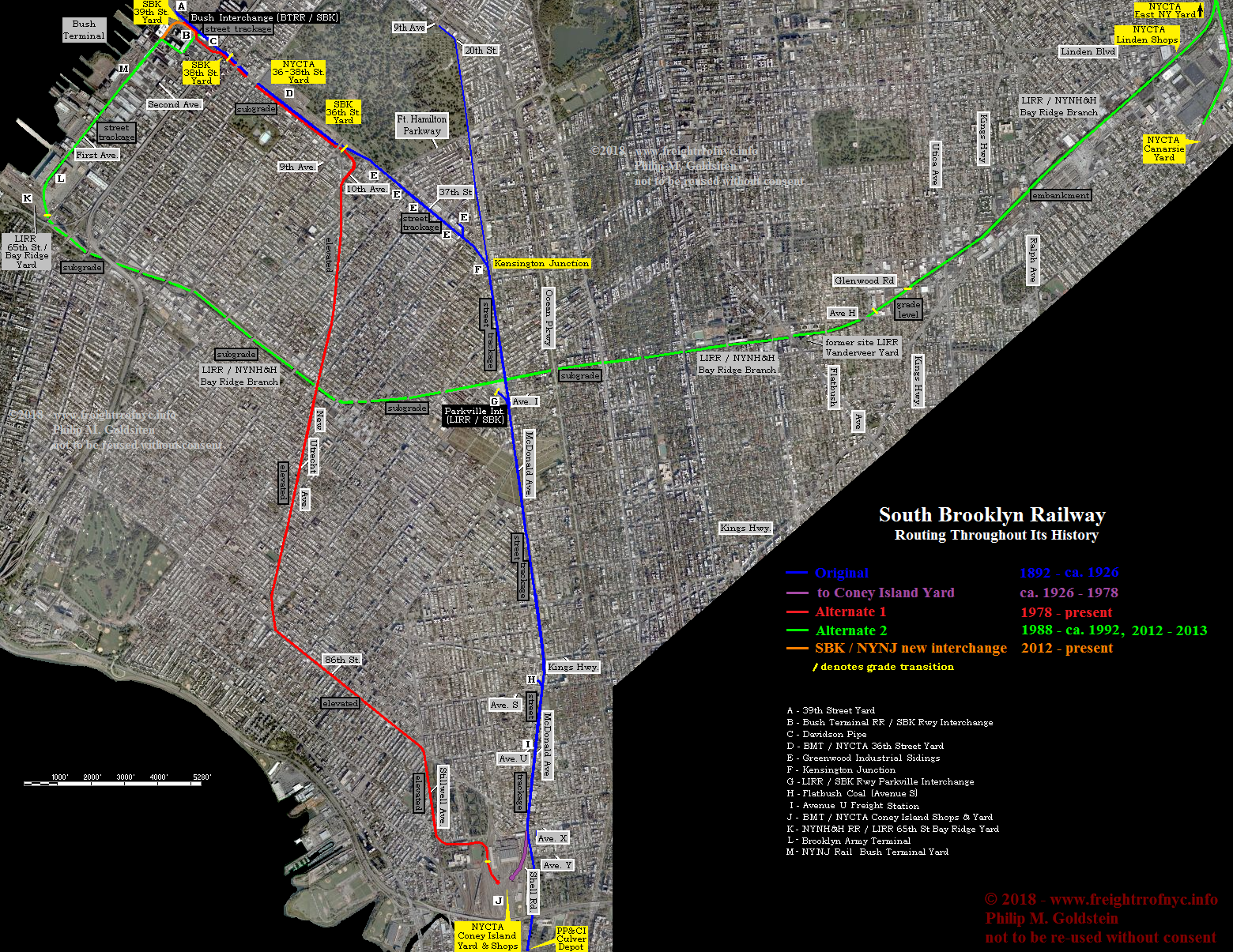
Alternate Route 1 (red): |
Following the abandonment of street
trackage south of Fort Hamilton Parkway including McDonald Avenue in
1978; the main route for the transport of subway rolling stock and MOW matériel on flatcars and in gondolas is
along the existing elevated trackage. This route would take South Brooklyn movements
via the BMT "West End Line" elevated (currently the
![]() train)
along New Utrecht & Stillwell Avenues and into the Coney
Island Rapid Transit Car Overhaul Shop, (or more simply: "the
Coney Island Shops").
train)
along New Utrecht & Stillwell Avenues and into the Coney
Island Rapid Transit Car Overhaul Shop, (or more simply: "the
Coney Island Shops").
The Coney Island Shops are one of only two major overhaul facilities for all the subway equipment in New York City (the other major overhaul shop being 207th Street in Uptown Manhattan). Staten Island Railway equipment is also repaired at the Coney Island Shops, but must be trucked over the Verrazano Bridge.
Returning to the routing, it must also be understood that with
this routing, two factors have to be kept in mind when using the West End Line elevated:
This South Brooklyn Railway routing enters this elevated trackage at the east end of the 36-38th Street Yard (just a couple of tracks south of where they used to enter street running on their former route along 37th Street). It is here that South Brooklyn Railway trains would be switched from yard trackage to the "mainline" of the West End Line, (which circumvents the 36-38th Street Yard for its continuous and unhindered routing under Fourth Avenue).
An inclined transition from the subgrade trackage to the elevated had been constructed in 1916 with the construction of the West End Line elevated.
This route is shown in red in the map above.
Alternate Route 2 (green): |
In 1987,
it was discovered that the Williamsburg Bridge was in dire need of
major repairs and required emergency repairs. This required closing the
bridge to both vehicular traffic and transit services. As closing the
bridge
would isolate some of Northern Brooklyn's subway lines,
access would still be needed to get subway equipment in need
of maintenance & repair to and from the NYCTA's Coney
Island Rapid Transit Car Overhaul Shop, more easily called "the
Coney Island Shops". So, on or about October 1987, the South Brooklyn
Railway
entered into an agreement with Long Island Rail Road (both
entities being operated by the Metropolitan Transportation Authority).
This agreement allowed
for the South Brooklyn Railway to operate over Long Island Rail
Roads' Bay Ridge Branch between the
hours of
19:00 and 03:00 (thats 7:00 pm and 3:00 am for those of you who cannot
read 24 hour / military time). This route allows movements from
the LIRR Bay Ridge Yard to the NYCTA Linden Shops or Canarsie Yard,
both located
in
East New York. It would also require the South Brooklyn Railway
to operate on New York Cross Harbor Railroad trackage under a separate
agreement, as well. All told the route was very arduous to say the
least.
A South Brooklyn Railway test train was scheduled, and the route was as follows:
From Coney Island Yard, north up the West End Line (currently the
NYCTA
![]() train),
train),
switch off the West End Line at the SBK switch between 4th and 5th Avenues,
west through the Third Avenue & 38th Street Yard, to Second Avenue and 39th Street.
Here,
the South Brooklyn Railway would switch upon and turn south onto the
New York Cross Harbor Railroad trackage on Second Avenue at "Bush Interchange",
south for two blocks along Second Avenue to 41st Street and curve under the corner
of the warehouse (of which so many photos are taken),
turn west down 41st Street for one block to First Avenue turning south again,
South along First Avenue to 58th Street,
through the Brooklyn Army Terminal to Long Island Rail Road Bay
Ridge Yard and turning east onto the LIRR Bay Ridge Division.
From
here, up to either the Linden Shops (for track & structures)
or to a point just north of the BMT Canarsie Line New Lots Avenue
Subway Station  Train,
Train,
A reverse move was necessary to switch onto the Canarsie Line  Line and finally
Line and finally
entering into the East New York Yard.
Even after the Williamsburg Bridge was rehabilitated, the South Brooklyn Railway would still see use of the Bay Ridge Branch (see Memoirs), and would still utilize it today if need be.
The original plan, as part of the South Brooklyn Marine Terminal reconstruction had the South Brooklyn Railway's 39th Street Yard between Second and First Avenues being ceded to the South Brooklyn Marine Terminal property.
It also had the South Brooklyn Railway now interchanging with New York New Jersey Rail (the successor to New York Cross Harbor Railroad) at South Brooklyn Railway's 38th Street Yard between Third & Fourth Avenue (two blocks east of the original interchange point) but this is not shown in the diagram. Matter of fact, none of South Brooklyn Railways trackage was represented and their 39th Street Yard is shown as "green space".
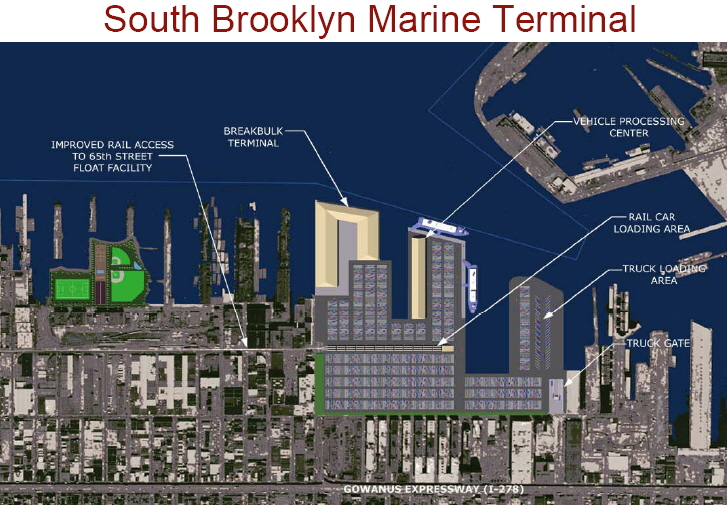
November 28, 2007 presentation by New York City Economic
Development Corp (NYCEDC)
to ASICMA on "Infrastructure in New York City"
.
As such, it seem to be that New York New Jersey Rail would have operating rights on the South Brooklyn Marine Terminal trackage, proceeding across Second Avenue, utilize the trackage adjacent to Costco, cross Third Avenue and possibly interchange with South Brooklyn Railway at the South Brooklyn Railway's 38th Street Yard.
It appears by 2012, that plan had changed. Information now handed down to the author now had the South Brooklyn Railway interchanging with the New York New Jersey Rail at First Avenue & 39th Street, one block west of the original interchange point, following a complete restructuring of the track layout.
The graphic below has the yard trackage for the South Brooklyn Marine Terminal still oriented for north / south (and of which the former SBK 39th Street Yard is currently oriented east / west), but with the tracks moved to the eastern boundary of the property instead of running up the center. And with that revised track entrance being located at 39th Street and First Avenue providing access into the yard for New York New Jersey Rail and allowing an interchange with South Brooklyn Railway.
This original graphic below was originally from the "Sunset Park Vision Plan" of 2009 and was modified by the author to reflect all changes prior to May 2012.
As the proposed reconstruction of the South Brooklyn Marine Terminal shows trackage splitting east and west from a First Avenue and 39th Street access point, this arrangement would have effectively dissected the original South Brooklyn Railway 39th Street Yard. Therefore, this South Brooklyn Railway Yard was removed in its entirety to facilitate the new trackage alignment.
.

.
The new NYNJ Rail - South Brooklyn Railway Interchange: |
In 2006, the New York Cross Harbor
Railroad became New York
New Jersey Rail also known as NYNJ Rail. Also about that time, NYNJ Rail welded the turnout point located at First
Avenue and 41st Street for the First Avenue alignment. This weld
prevented New York New Jersey Rail traffic or South Brooklyn Railway
traffic from using 41st
Street to Second Avenue and then to the Bush Interchange where
interchange at Second Avenue & 39th Street could take place.
In
short, the SBK was now isolated at Second Avenue and 39th
Street at their yard. Therefore, the transfer of any freight traffic (if any!) from
NYNJ Rail to South Brooklyn Railway now had to go through the
Brooklyn Army Terminal and to the Long Island Rail Road / New York
&
Atlantic Railway Bay Ridge Yard to NYCTA Linden Shops for transfer
anywhere else in the NYCTA System. Until 2012, it was not an issue as
NYCTA was not receiving any freight traffic or equipment via rail from NYNJ Rail.
This would change in 2012. When the order for the twenty-eight
new R156 work locomotives (MotivePower MP8AC-3) was proposed, a way was needed to transfer
those locomotives to the NYCTA / South Brooklyn Railway. As NYNJ Rail
was already revamping its track structure, and as part of the New York
City
Economic Development Corporations' Sunset Park Improvement Plan, the
South Brooklyn Marine Terminal was being reconstructed. So, the
opportunity presented itself for a new interchange with shallower radius
curves and heavier rail to include conventional two point turnouts, as well as eliminating the sharp
reverse curves encountered previously along the 41st Street routing.
The NYNJ Rail "main" was continued north along First Avenue for
one more block to 39th Street (it previously ended mid-block between
41st and 39th Streets at a large industry), then turning gradually to
the east
to a turnout where the track would split to either a multi-track
siding serving the the South Brooklyn Marine Terminal or connect with
the South Brooklyn Railway. This new interchange was no more than one
city block west of the old "Bush Interchange" but it so
dramatically eased the curvature of the track alignment.
Unfortunately, this new interchange was not ready for use by May
1, 2012 when the first locomotive (0L912) of the new order arrived for
the NYCTA. It would not be until the delivery of the second locomotive, which would
have the
honor of being the first NYNJ Rail / SBK interchange to utilize this
new interchange.
This interchange remains in service as of 2021. With thanks to an internal source, the delineation line of the South Brooklyn Railroad and New York New Jersey Rail is established at the Second Avenue crossing at 39th Street, in which the legal documents states:
"WHEREAS, the 2nd Avenue Grade Crossing at 39th Street is the point of delineation between NYNJR rail territory and operations and SBK Rail territory and operations, and; WHEREAS, the Parties desire to establish an interchange agreement, to formalize and accurately reflect how interchange traffic emanating from both Parties' facilities will be handled, with the primary interchange activity to be NYNJR delivering rail cars to the SBK Connection Track (as hereinafter defined); and WHEREAS, the parties are willing to enter into this Agreement on the terms and conditions provided herein for so long as the Parties tender rail cars to each other..."West of this point is NYNJ Rail property, but SBK does have access rights as far as the switch at First Avenue and 39th Street. |

South Brooklyn Railway / New York New Jersey Rail Delineation Point
(North is to the right)
annotated map by author
not to be reused or reproduced without consent.
added 18 April 2021
.
.
.
| 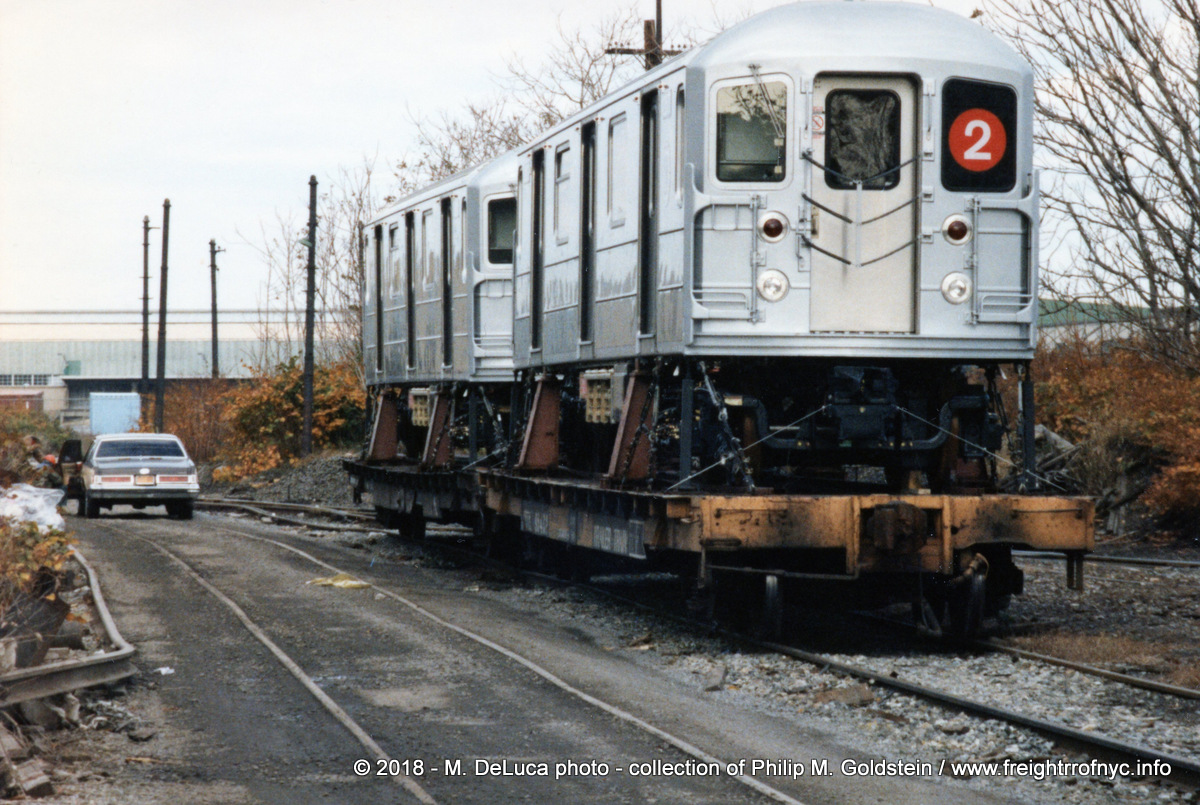 Bombardier R62A Subway Cars ('A' Division - IRT ) at 39th Street Yard (between
First and Second Avenues waiting to be brought to the 38th Street "Unloading" Yard. Brooklyn, NY M. DeLuca photo collection of P. M. Goldstein / P. F. Strubeck added 02 July 2018 |
Since 1994, with the closing of the Davidson Pipe Yard, the South Brooklyn Railway has had no other general freight customers other than the NYCTA, if you would even call the NYCTA a customer - as it is more of a "parent organization".
While the South Brooklyn Railway is still theoretically in operation as a freight subsidiary to the New York City Transit Authority, it has not hauled new inbound subway cars or outbound obsolete subway cars for scrapping or rebuilding to or from either Bush Terminal Yard (or the NYCTA East New York Shops via the LIRR Bay Ridge Branch) since.
So far, all new subway cars have arrived via highway upon lowboy trailer / tractor trailer and over the George Washington Bridge.
Unless
other new subway equipment is scheduled to arrive via New York New
Jersey Rails'
carfloats, or via New York & Atlantic Railway at 65th Street; the
South Brooklyn Railway has no work other than internally with the NYCTA
System, and its two
locomotives work alongside the myriad of other work equipment of the
NYCTA.
As for N1 and N2; sadly, their unique maroon and silver paint is
fading and
peeled, and it is uncertain if it even warrants the TA in repainting
them in
SBK colors. More likely than not, what with the arrival of the new
R156's, the GE 47 tonners quite simply, are tired. They were built in
1975, and have
been rebuilt at least once since then. But, if there is any justice in
the world - and someone of authority in the NYCTA reads
this; please
save one (or both!) and keep it with SBK steeplecabs #6 & 7 in
Coney Island Yard!
What does the future hold for the South Brooklyn Railway? This is a good question and without a definitive answer. As we have seen throughout history after the cessation of carload and less than carload delivery by South Brooklyn Railway, the South Brooklyn solely serves its parent organization, the New York City Transit Authority. And if there is nothing to haul, it will exist in name only. But let us not count it down and out yet. We can be thankful for every single carload or movement that comes in over the line.
And with new work / MOW equipment arriving for the NYCTA, it cannot be said the South Brooklyn Railway doesn't see service! (Most recent movements first):
In June of 2019, the first of the new R252 Contract MOW flatcars - OF801; began arriving. It appears to have arrived via highway on a low boy road trailer but was offloaded at the Second Avenue Interchange. (Why not directly at 38th Street Yard remains to be learned.)
The following link is to a video taken by "DJ Hammers", and is available on YouTube. Here NYCTA 897 [GE SL50] (with unique green and yellow safety stripes) arrived to haul it east to 36th Street Yard. How many more flatcars will arrive this way, remains to be seen.
Delivery of the first R252 Flatcar on the South Brooklyn Railway
.
.
.
0L912 - MotivePower Incorporated R156 move (and other R156 arrivals) w/ SBK N2 & N1 & NYCTA RD 411 - May 1, 2012
.
On May 1, 2012, the first locomotive in the 28 unit order for a new low emission diesel-electric work locomotive that had been placed by New York City Transit / Metropolitan Transportation Authority was delivered to the NYCTA Linden Yard is Brooklyn., NY
The locomotive was transported on her own trucks, but loaded upon
an TTX Corp 64' specialty flat car HTTX #91796, and transported from
MotivePower Inc.; in Boise, Idaho. It should be noted that HTTX 91796 is a 64' flatcar
(which was specified by the NYCTA for delivery of these locomotives). This length
flat car (or lack there) of would come into play in a future delivery.
Two interesting tidbits, for this locomotive not SBK related:
John Dooley posted the following image confirming this locomotives arrival in Bush Terminal via New York New Jersey Rail carfloat and subsequent haulage down First Avenue to the NY&A / LIRR interchange at 65th Street / Bay Ridge: http://www.nycsubway.org/perl/show?133502.

First Avenue & 53rd Street, Brooklyn, NY - May 1, 2012
NYNJ Rail
#1133 w/ NYCTA OL912 enroute to 65th Street / Bay Ridge Yard interchange
with New York & Atlantic Rwy.
John Dooley photo
used with permission
added 03 May 2012
NYNJ Rail brought the locomotive into Brooklyn via carfloat at their 50th Street float bridge and hauled it along First Avenue, through the Brooklyn Army Terminal to the 65th Street / Bay Ridge Yard. Here it was interchanged with the New York & Atlantic Railway who picked it up in 65th Street / Bay Ridge Yard and made final delivery at NYCTA Linden Shops via the Bay Ridge Branch.
From there, South Brooklyn Railway locomotives N2, N1 and NYCTA rider car RD411 brought 0L912 through the BMT system to the NYCTA Coney Island Shops for final calibration and testing. Click on screenshot below to watch video:
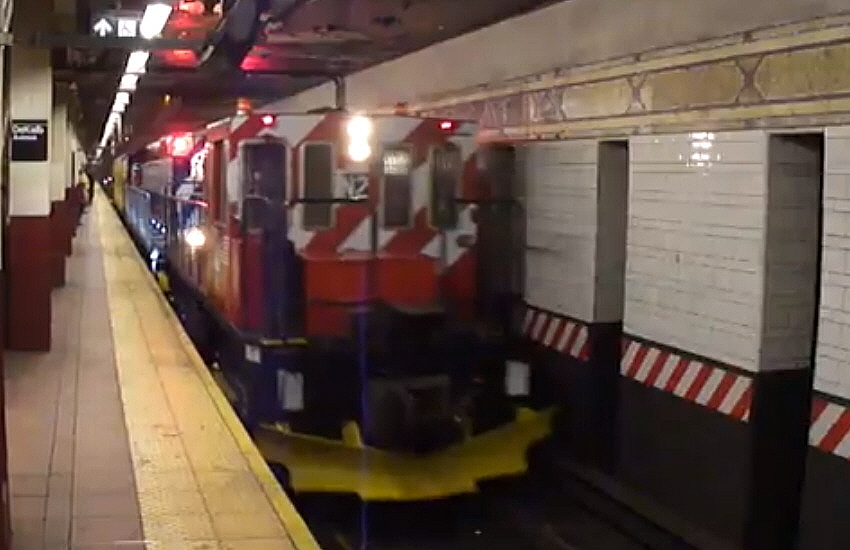
SBK #N2, NYCTA #0L912, NYCTA Rider Car #RD411 and SBK
#N1
coming through DeKalb Avenue Station in Brooklyn, being push (N1) / pull
(N2) South Brooklyn Railway locomotives
video by Trevor Logan, all rights reserved. Used with
permission.
added 03 May 2012
.
.
A new unloading ramp was constructed and installed at Linden Shops to unload 0L912 from its flatcar. After 0L912 was unloaded, the unloading ramp was relocated from Linden Shops to the Third Avenue & 38th Street "Unloading" Yard by May 20, 2012. The new unloading ramp was placed where the old subway car unloading ramp once stood.
Before delivery of the next locomotive however (and as previously mentioned above), a notable event took place: the new interchange turnout between SBK and NYNJ Rail (now located at First Avenue and 39th Street) was tested January 2013 and activated. This "reconnection" allowed rail traffic to be directly interchanged between NYNJ Rail and the SBK once again and without involvement on the New York & Atlantic Railway.
0L913 arrives - February 7, 2013
The next locomotive to arrive: 0L913 arrived in Brooklyn on February 7, 2013. It too came in via carfloat by NYNJ Rail and was brought to Bush Terminal Yard. Here South Brooklyn Railway locomotives N1, N2, a transition car and a flatcar were dispatched to haul the 0L913 on its flatcar to the unloading ramp at Third Avenue and 38th Street, where 0L913 was then unloaded.
After unloading, the empty flat car was returned to NYNJ Rail. Incidentally and according to Ben Schaeffer, that flat car has the honor of being the last interchanged freight car to cross Third Avenue on the South Brooklyn Railway as of the June 2018 update to this website.
0L914 arrives (twice!) - March 21, 2013
On March 21, 2013, the third locomotive of the order: 0L914 arrived. And here was where a problem arose. Remember in previous chapters above it being mentioned that the locomotives were specified to be shipped on 64' flatcars?
Well, 0L914 came in on a 89 footer XTTX 14278 due to the unavailability of a 64 footer. NYNJ Rail unloaded the flatcar from the carfloat with the locomotive on it and brought it to Bush Terminal Yard, where a NYCTA crew was waiting to take delivery using two standard R52 TA work locomotives [GE 45ton]: #77 and 76 (and not SBK N1 or N2) as well as two idler flatcars: OF616 and OF609.
The load was spotted by NYNJ Rail, the NYCTA crew coupled onto the load and away they went, enroute to the unloading ramp at Third Avenue and 38th Yard. Lo and behold, the flatcar would not navigate the curve approaching Third Avenue! And this being on the fairly recently installed (ca. 1995) trackage around Costco property perimeter... This new trackage was designed and tested to handle 75' subway cars, and it was not anticipated that very long modern freight cars would need to traverse the line.
Upon this discovery, the NYCTA crew calls the NYCTA MOW Department, who rushed
over to the Third Avenue and 38th St "Unloading" Yard, disassembled the new unloading ramp,
transported it (disassembled) to NYNJ Rail's Bush Terminal Yard and reassembled it.
Once that was accomplished, the NYCTA train crew returned to Bush Terminal
Yard with the flatcar and locomotive load and they proceed to unload
it. And thanks to this, 0L914 would become the first new R156 to be "delivered" on its
own wheels via the South Brooklyn Railway!
It was
at this time that the powers that be wisely decided it would be best to
keep unloading the subsequent locomotive deliveries at Bush Terminal
Yard, and thereby eliminating the possibility of a repeat of this situation as well as the necessity of having the
following locomotives shipped only on 64' flatcars.
We are fortunate to now share a video of this particular move. The video was filmed by Zack Summer and posted on YouTube:
LIRR caboose C60 move by South
Brooklyn Railway - April 4/5, 2009
.
On April 4, 2009; the Twin Forks Chapter of the National Railway Historic Society lent their recently restored Long Island Rail Road N22a "C60" caboose to the New York City Transit Museum located in downtown Brooklyn.
The New York City Transit Authority's Transit Museum held an exhibit: "The Route of the Dashing Commuter: The Long Island Rail Road at 175" (celebrating the 175th anniversary of the LIRR - and this exhibit ends at the end of March 2010).
The Long Island Rail Road handled transportation of C60 from Twin Fork's Riverhead, Long Island location to New York & Atlantic Railway's Fresh Pond Yard. From there New York & Atlantic Railway took the caboose to the NYCTA's Linden Avenue Shops in East New York.
However, the South Brooklyn Railway handled the rest of the move from that location to the Transit Authority's 207th Street Yard in the Inwood neighborhood of Manhattan, as C60 needed final preparation for display in the Transit Museum.
The following is an itinerary of the move:
Long Island Rail Road / New York & Atlantic
Railway:
April 4, 2009 - 6:00 am - 8:00 pm
14 hours time in transit
Due to LIRR speed restriction of 15 mph along entire route. This special
move also was required to take a siding to allow revenue trains to
pass.
.
Long Island RR picked up the LIRR C60 caboose at Riverhead, LI at 6:00 am on April 4th, 2009
LIRR recrew at Hillside Support Facility, Hillside, Queens.
arrival at New York & Atlantic Railway Fresh Pond Yard at 7:00 pm with a change to NY&A motive power.
from NY&A Fresh Pond Yard to NYCTA Linden Shops, East New York, Brooklyn arriving at 8:00 pm.
South Brooklyn Railway:
April 4, 2009 - 10:30 pm / April 5, 2009
- 7:00 am,
9.5 hours time in transit
This move of LIRR C60 on NYCTA trackage was quite convoluted due to
trackwork,
forcing the South Brooklyn Railway to take the following route from Linden
Shops:
.
changeover to South Brooklyn Railway motive power at Linden Shops, East New York, Brooklyn.
2 hour layover for NYCTA prep work.
departing Linden Shops, Brooklyn at 10:30 pm to Manhattan via the Williamsburg Bridge,
south through Manhattan and back to Brooklyn via the Montague Street tunnel,
to 36th Street Yard, Sunset Park, Brooklyn (with South Brooklyn Railway recrew),
36th Street Yard to Coney Island Yard,
Coney Island Yard north to and over the Manhattan Bridge back into Manhattan,
continuing north in Manhattan and arriving at 207 St / Inwood, Manhattan at 7:00 am April 5th 2009.
The total time C60 spent in transit encompassed 25 hours, roughly 100 miles (of railroad travel), three railroads, and five counties: Suffolk, Nassau, Queens, Kings [Brooklyn] and New York [Manhattan].
Paul Strubeck, himself a member of Twin Forks; was instrumental to the restoration of C60 and the subsequent move, and he obtained several outstanding photographs. Here are the images pertaining to the South Brooklyn Railway portion of the move:
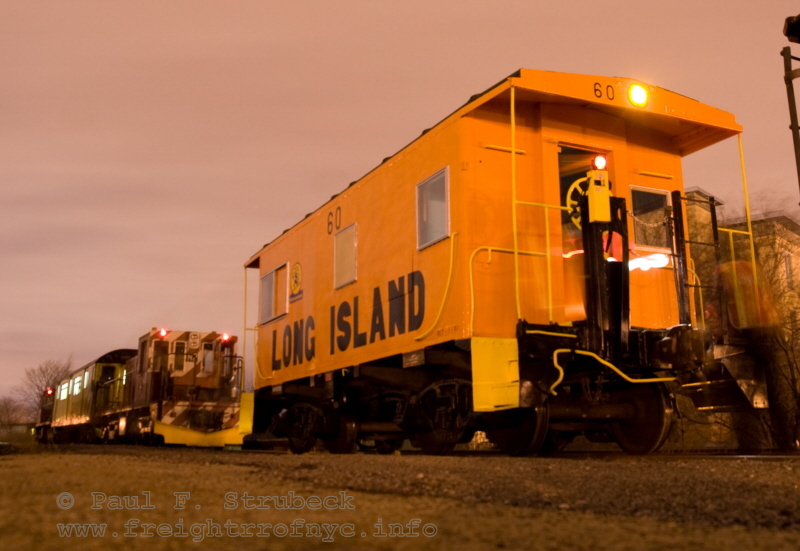
LIRR C60 w/ SBK N2, NYCTA "rider car" RD411 and SBK
N1 in background.
April 4, 2009 - NYCTA Linden Shops, Brooklyn, NY
P. F. Strubeck
photo
added 24 Dec 2009
.
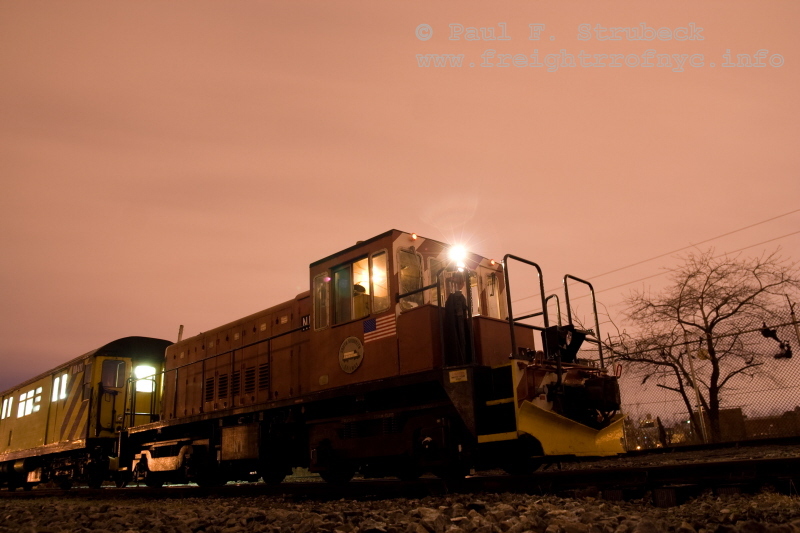
NYCTA "rider car" RD411 and SBK N1 - April 4, 2009
- NYCTA Linden Shops, Brooklyn, NY
P. F. Strubeck
photo
added 24 Dec 2009
.

SBK N2 (foreground) with NYCTA "rider car" RD411 and
SBK N1 - April 4, 2009 - NYCTA Linden Shops, Brooklyn, NY
P. F. Strubeck
photo
added 24 Dec 2009
.
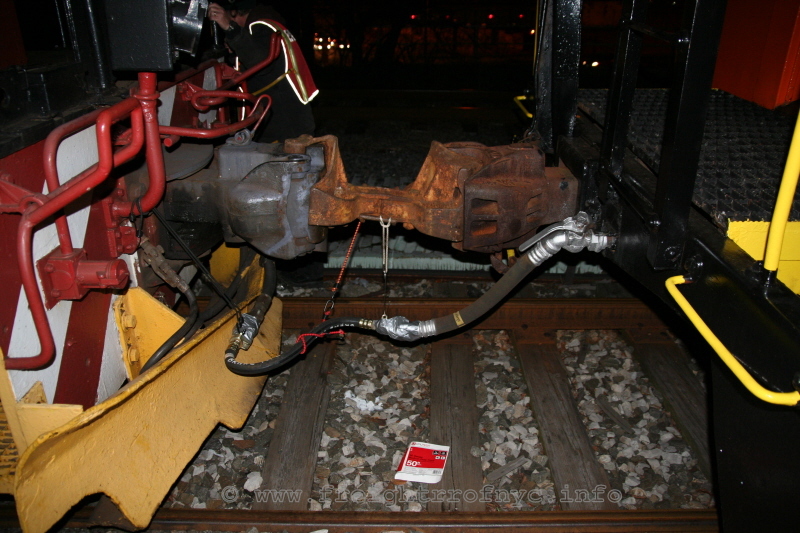
SBK N2 & LIRR C60 - April 4, 2009 - NYCTA Linden
Shops, Brooklyn, NY
Note airline extension and coupler extension (which according to Paul Strubeck
it weighs approximately 200 pounds,
is over 75 years old and was originally from the Boston & Maine RR).
P. F. Strubeck
photo
added 24 Dec 2009
.
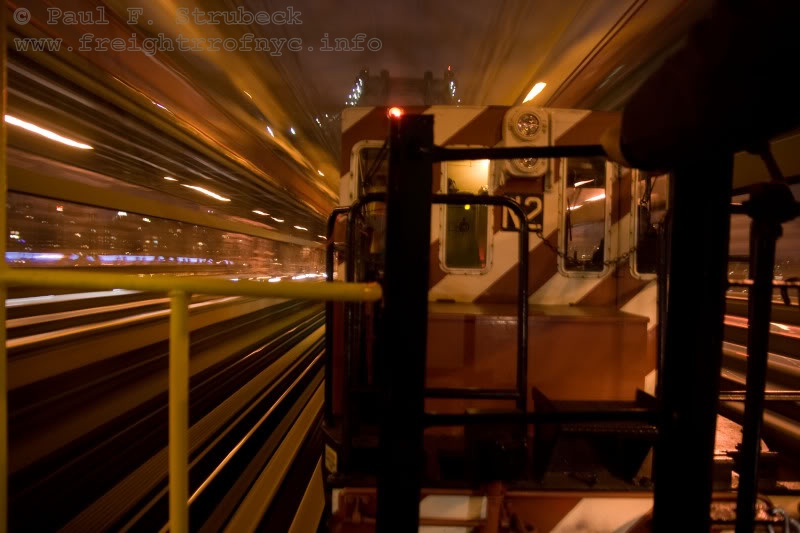
SBK N2 & LIRR C60 - April 4, 2009 - westbound on
the "BMT Jamaica / Broadway Line"; now NYCTA
![]() lines
lines
crossing the Williamsburg Bridge; East River, NY
P. F. Strubeck
photo
added 24 Dec 2009
.

SBK N2 & LIRR C60 - April 4, 2009 - Subway Tunnel;
Manhattan, NY
P. F. Strubeck
photo
added 24 Dec 2009
.
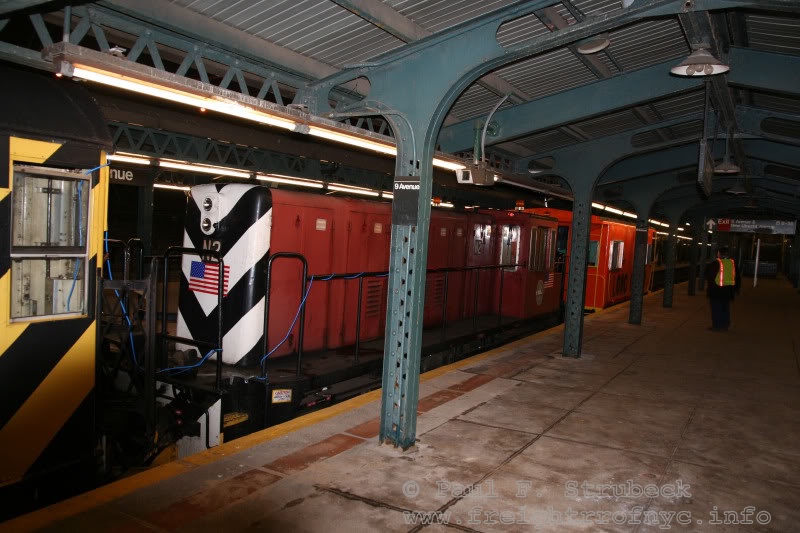
SBK N2 & LIRR C60 - April 4, 2009 - BMT "West End
Line" / now NYCTA
![]()
![]() line - Ninth Avenue Station
line - Ninth Avenue Station
Sunset Park, Brooklyn, NY
P. F. Strubeck
photo
added 24 Dec 2009
.
.
.
Original Right Of Way
Remnants
.
On 26 January 2010, my long time friend and fellow New York rail enthusiast Dave Gellerstein and myself traced the original route of the South Brooklyn Railway to commit as many of the remnants we could find to record before being completely obliterated.
We began our journey at the Coney Island Yards of the New York City Transit Authority. Unfortunately, shadows and a chain link fence make a good image difficult of the track that led out onto McDonald Avenue:
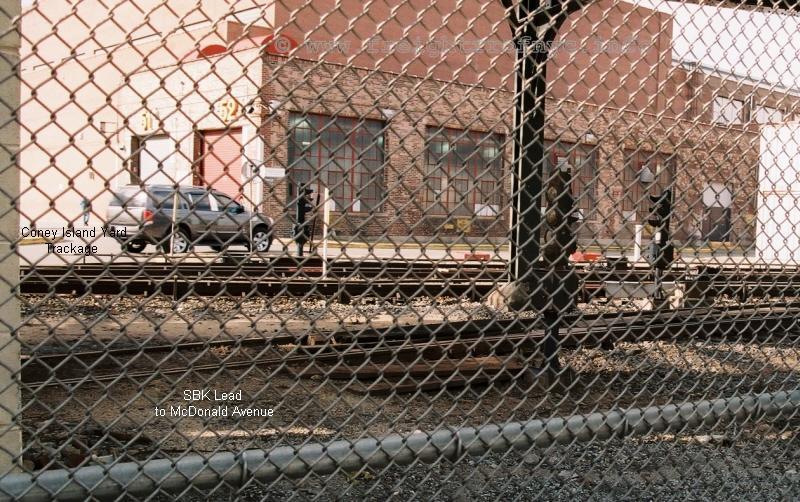
South Brooklyn Railway track (foreground) at Coney
Island Yard - January 26, 2010
authors photo
.
.
The next location north that we could locate and knew of, was that of the coal supplier located between Avenue S and Kings Highway. While the concrete coal silos were torn down many years ago, the ground floor entrance still remains as does tracks embedded in the sidewalk.
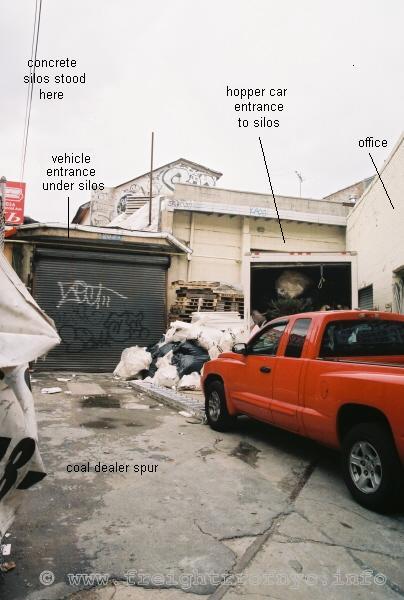
South Brooklyn Railway spur into former Flatbush Coal at Avenue
S and McDonald Avenue - January 26, 2010
authors photo
.
.
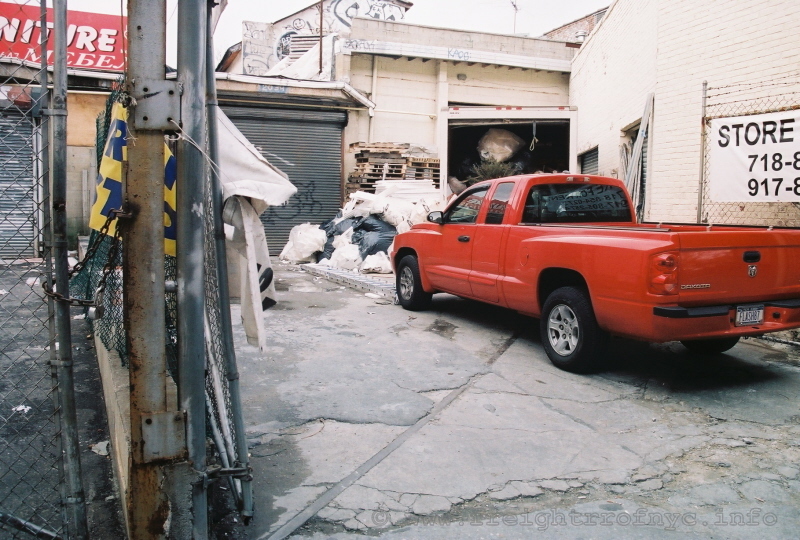
South Brooklyn Railway Spur into former Flatbush Coal at Avenue
S and McDonald Avenue - January 26, 2010
authors photo
.
.
Our next stop traveling north was Parkville Interchange. Nothing remains of the trackage, but the ironically the unique curved wall warehouse of Leeds Paper / Scheck Brothers was in the process of being demolished that very day! We were a little too late for the Scheck portion of the wall, but the Leeds wall was still standing. So, we took pictures. You can barely make out the curved wall at the middle of the left edge of the photo.
Oh, and that driveway is the former right of way connecting the South Brooklyn Railway with the New York New Haven & Hartford & Long Island Railroads:
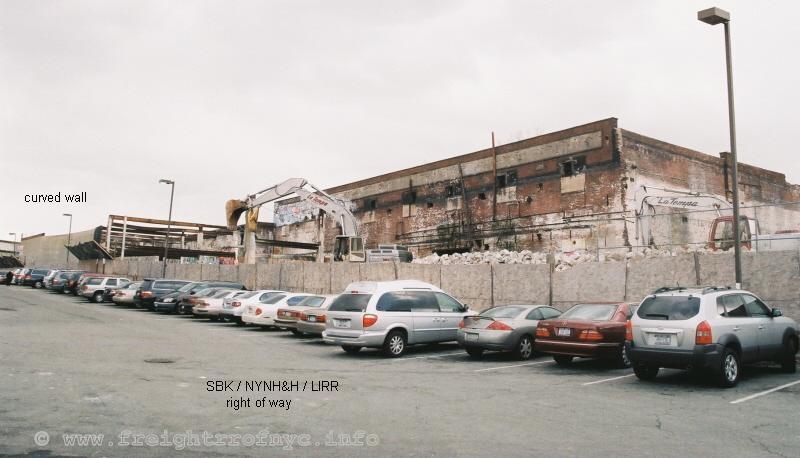
Leeds Paper / Scheck Brothers Warehouse - SBK &
NYNH&H / LIRR Parkville Interchange - January 26, 2010
authors photo
.
.
The next stop was Kensington Junction, but truly nothing remained and while we able to identify the right of way; new structures, a gas station canopy and a red moving truck occupied the scene. Just under the station canopy, the sea-green Culver Elevated can be seen:
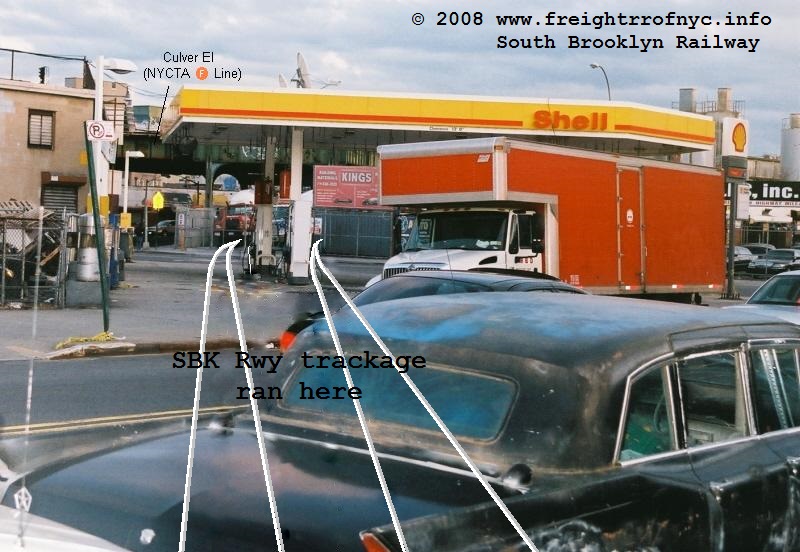
looking southeast at McDonald Avenue - January 26,
2010
authors photo
.
.
Now, while we continuing north, 37th Street ran against us, so we circumvented this portion and proceeded to Second Avenue and 39th Street, to back track. But I am posting the images of 37th Street here to keep the continuity of our "journey" north / westward.
At Fifteenth Avenue, a rail can be seen peeking out of the concrete of a parking lot for cement mixers:
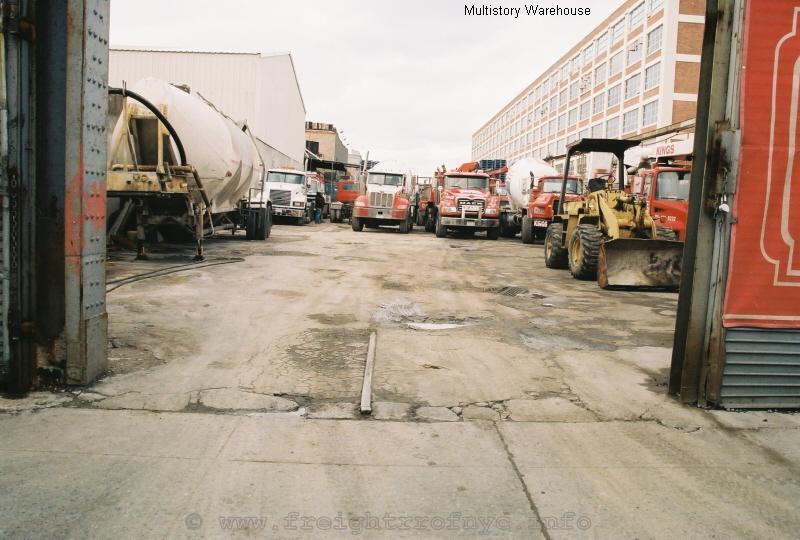
Looking west from 15th Avenue - January 26, 2010
authors photo
.
.
In the photo above, the large multistory warehouse can be seen. Upon first examination, we could find no remnants of trackage leading to the warehouse. Hopping back in my truck we circled around the block and I had to wait for the traffic light. I looked down at the pavement and saw a crease in the asphalt. A few feet further, I could barely make out another crack. Lo and behold, the creases were as wide as railroad track!
I immediately put my truck in reverse and backed into a parking spot to examine a little closer. The beige Nissan SUV in the image below is actually parked upon the tracks and the creases in the asphalt can be seen leading out towards the middle of the street from the two front tires:
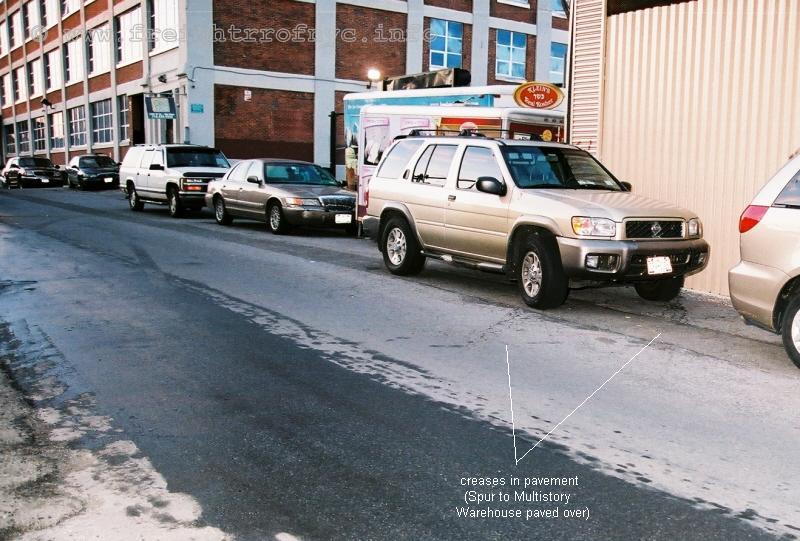
Looking northwest on 37th Street between Fourteenth
and Fifteenth Avenues - January 26, 2010
authors photo
.
.
The next photo was taken from the other side of the Nissan, and the rails can be clearly seen in the pavement:

Looking west - January 26, 2010
authors photo
.
.
Now the tracks in the photo above run under that beige corrugated structure and would have led into the parking lot of that multistory warehouse. No trackage can be seen in the parking lot but upon walking through the parking lot to the center alley, revealed tracks still embedded in the pavement:
Judging from the location of the track, (about 8 feet away from the wall and where the left row of cars are parked), leaves us to wonder if there was a loading dock running the length of the wall.

Looking west - January 26, 2010
authors photo
.
.
Here is a closer look at the loading door and wall:
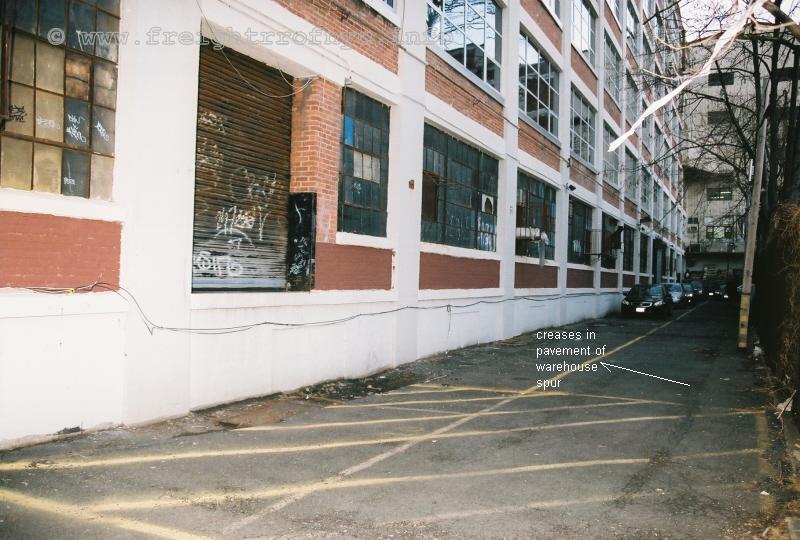
Looking west - January 26, 2010
authors photo
.
.
Turning around and facing east is this view:
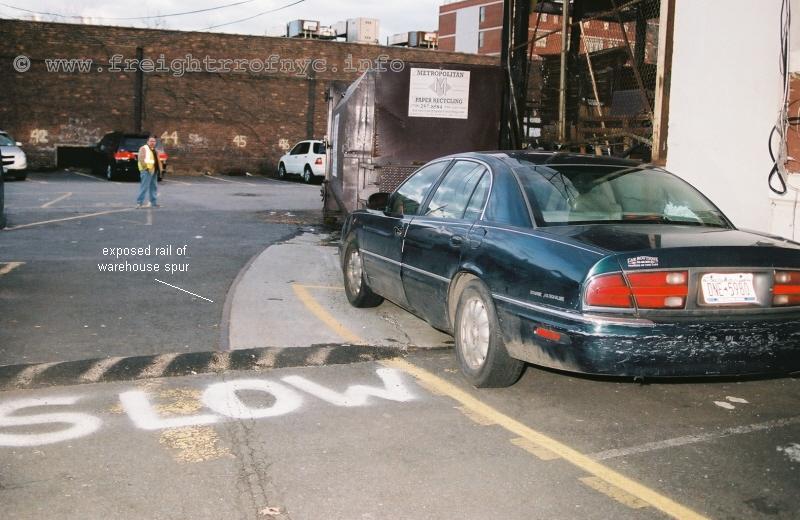
Looking east at parking lot of multistory warehouse
with trackage curving towards 37th Street.
Visible trackage ends under the dumpster - January 26, 2010
authors photo
.
.
Another block west, we were at the intersection of Fourteenth Avenue, Old New Utrecht Road and 37th Street. Again, rails could be seen peeking out of the pavement:
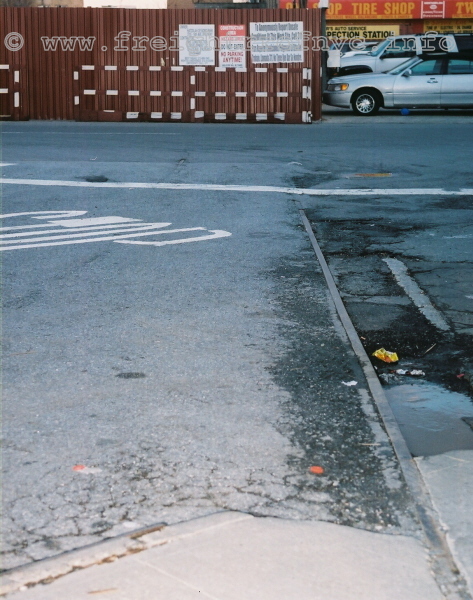
Looking east - January 26, 2010
authors photo
.
.
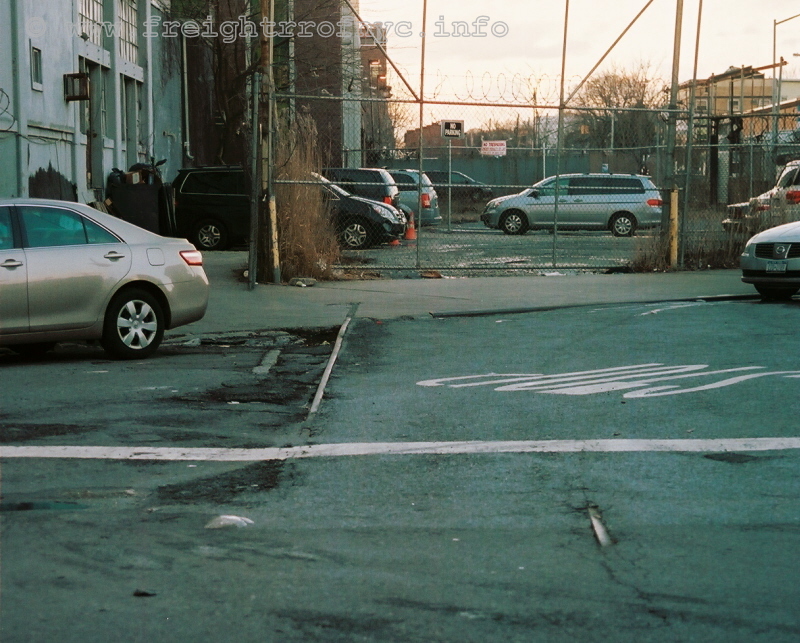
Looking west from centerline of Fourteenth Avenue -
January 26, 2010
authors photo
.
.
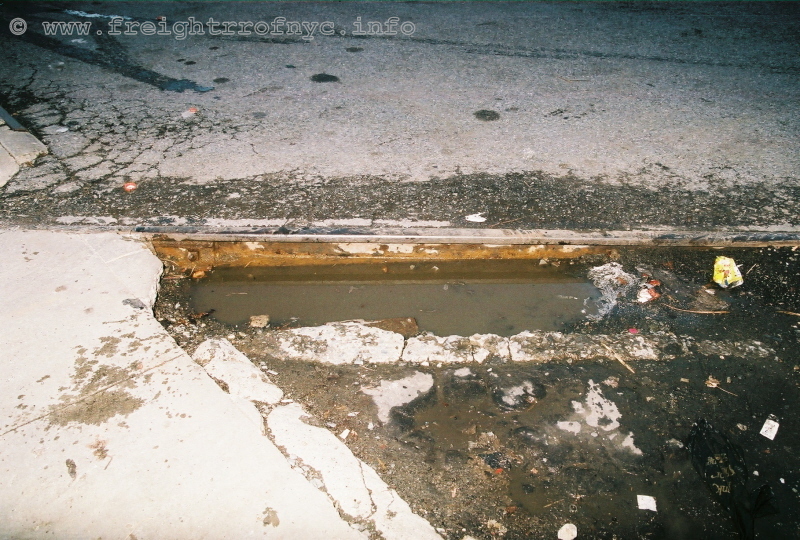
Looking north at west curb line of Old New Utrecht
Road - January 26, 2010
authors photo
.
.
We could find no remnants from Old New Utrecht Road to Tenth Avenue, which begins the 36th Street Yard of the New York City Transit Authority. At this point a fine chain link fence (2" squares instead of the standard 4") is in place and really prevents photography. So, we made our way to Fourth Avenue. This begins the infrequently used but serviceable portion of the South Brooklyn Railway.
I had to walk up the 38th Street exit ramp of the Gowanus Expressway to get past the chain link fence seen on the left edge of the photo. Doing so put me at a higher perspective and yielded unobstructed views of the 38th Street Yard between Fourth and Third Avenues.

Looking east toward Fourth Avenue and subway interchange
with subway car unloading ramp - January 26, 2010
authors photo
.
.

Looking west at Third Avenue - January 26, 2010
authors photo
.
.
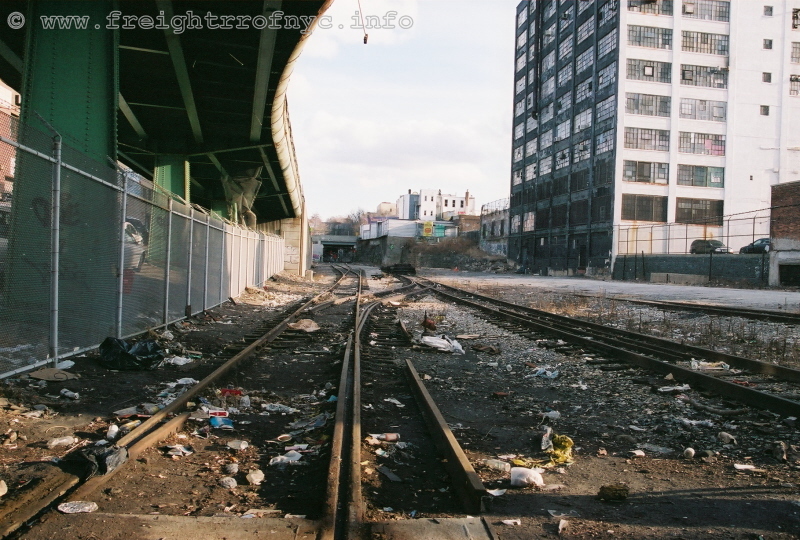
Looking west from Third Avenue entrance gate - January
26, 2010
authors photo
.
.
From this point down, the trackage was reconstructed. So, while not original trackage, it is the continuation of the original route as close as we can get in the present day.
These first images are of the crossing at Third Avenue:
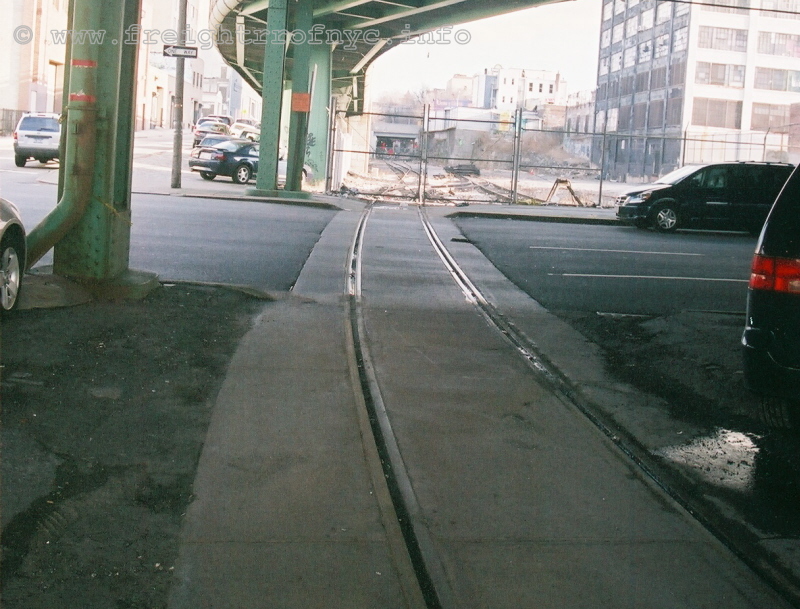
Looking east from the center island (parking lot) of
Third Avenue (northbound lanes) - January 26, 2010
authors photo
.
.
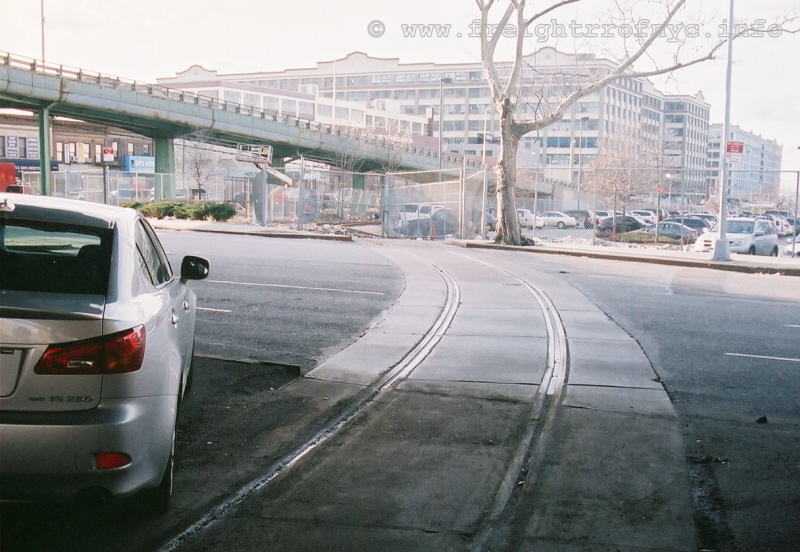
Looking west from the center island (parking lot) of
Third Avenue (southbound lanes) - January 26, 2010
Costco parking lot on right behind fence.
authors photo
.
.
We then proceeding to Second Avenue and parked between 39th and 37th Streets. This portion of the trackage was rebuilt to a new alignment in 1994.
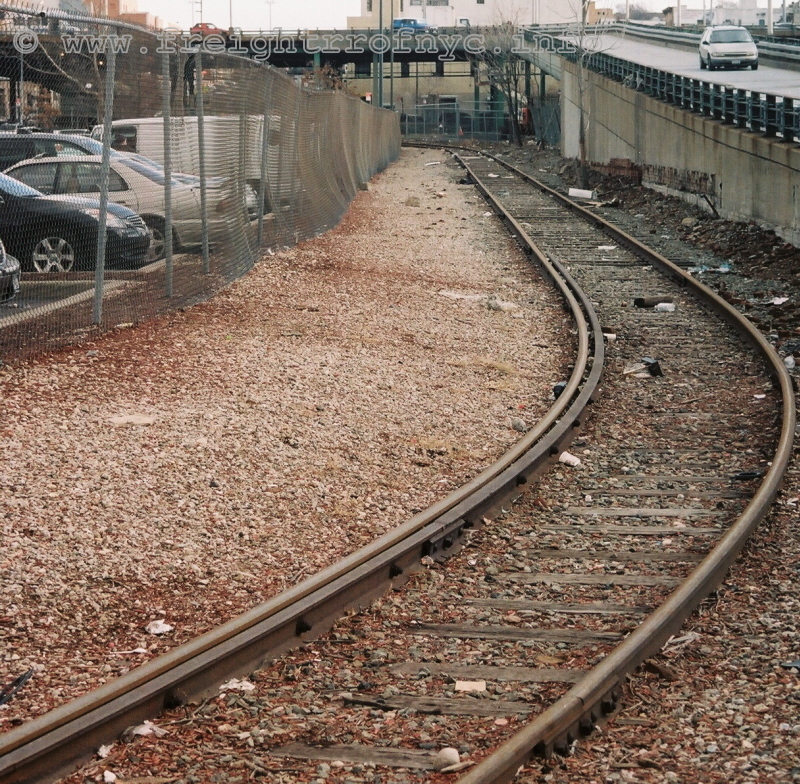
Looking east from Second Avenue - January 26, 2010
Costco parking lot on left behind fence.
authors photo
.
.
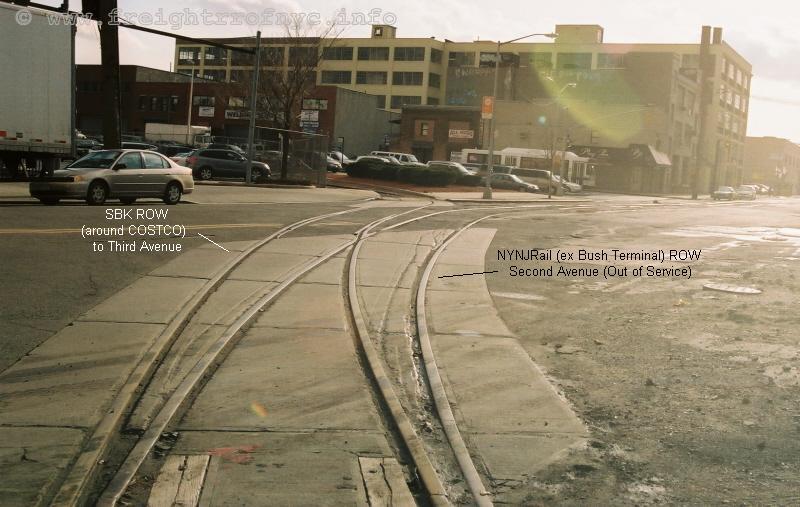
Looking southeast from west curb of Second Avenue (and
from the entrance of the SBK 39th Street Yard) - January 26, 2010
Note the gouges in the cement parallel to the rails from a minor derailment.
authors photo
.
.
This is the original location of the Yard, but the track configuration has changed dramatically over the last two decades. This is the view after turning 180 degrees and after taking the image above:
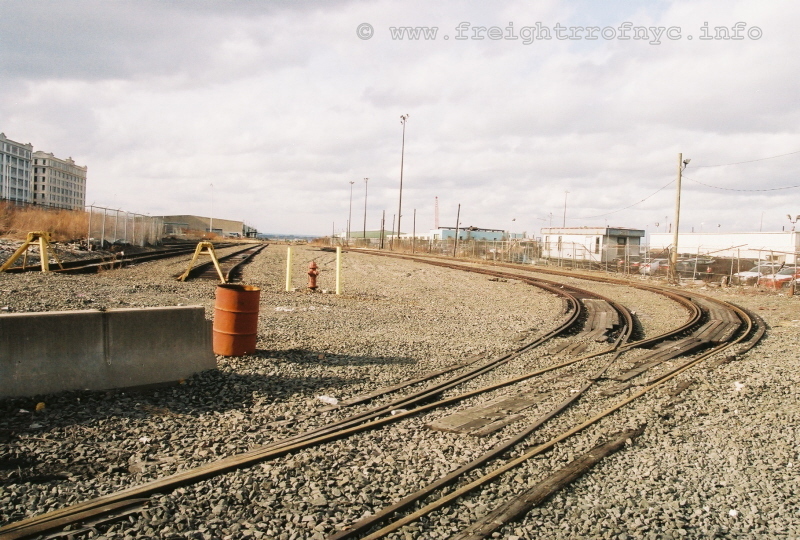
Looking west at 39th Street Yard - January 26, 2010
authors photo
.
.
At this point we made a U-turn and drove to 39th Street and Second Avenue and made a right and headed past First Avenue. To our good fortune, the gate to the South Brooklyn Marine Terminal was open.
This is the view of the 39th Street Yard from the Terminal looking east:
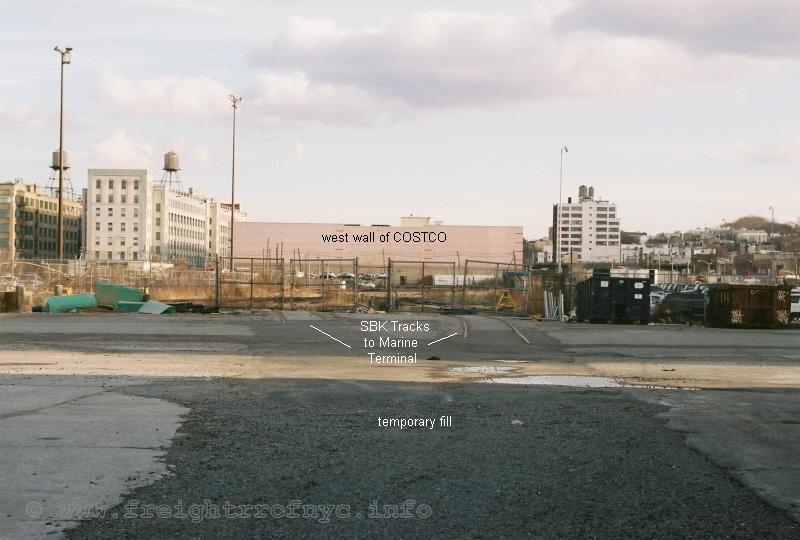
Looking east at South Brooklyn Railway 39th Street
Yard from Marine Terminal - January 26, 2010
authors photo
.
.
Now, this location was serviced by New York Cross Harbor Railroad when American Stevedoring occupied the premises. Currently, there is is a lot of reconstruction under way. Notice the tracks in the image above are cut short. These two tracks come together and the track ran parallel to the Pier Shed servicing loading docks seen in the image below. Also note the pavement has been torn up and temporary fill is in place. Obviously, this portion of the right of way is currently being reconstructed and appears it will be placed back in service for a new tenant.
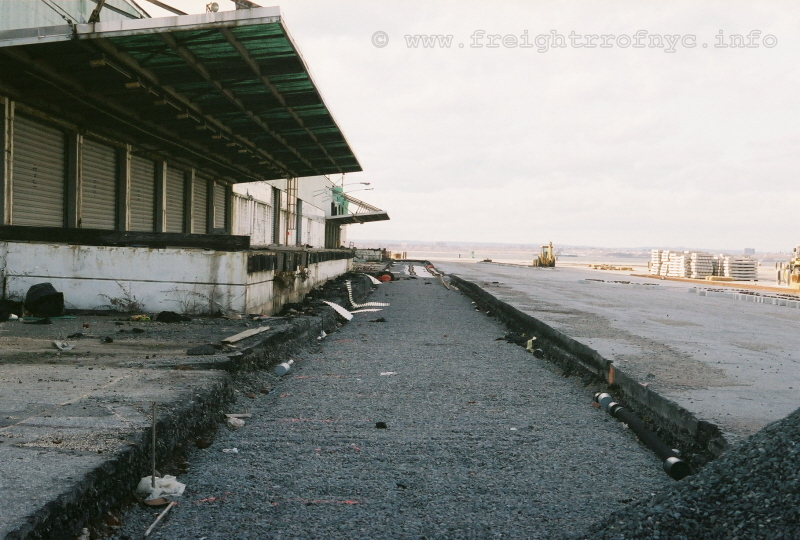
Looking west at loading docks of South Brooklyn Marine
Terminal - January 26, 2010
authors photo
.
.
Of particular interest is the fact that the track is being rebuilt using lengths of welded rail (not standard 39 footers) and concrete ties:
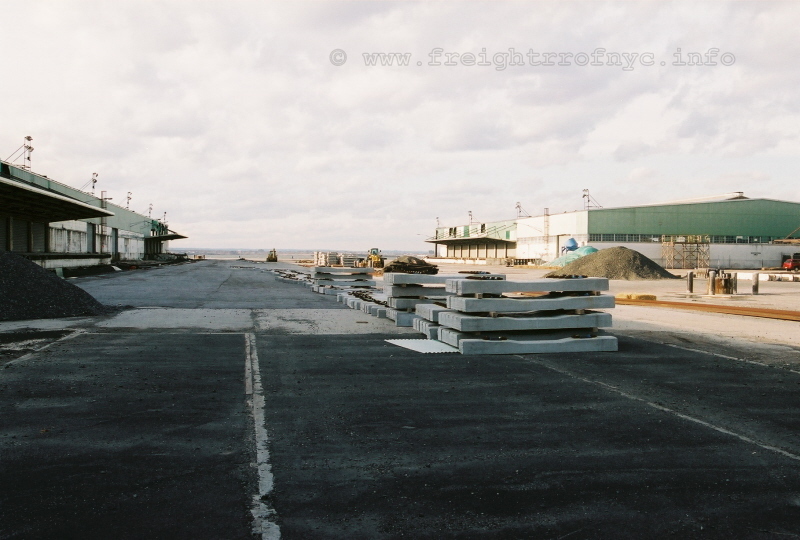
looking west - January 26, 2010
authors photo
.
.
..
Another interesting facet of South Brooklyn Railway operations was that prior to the abandonment of those street running parts of the route, train movements would employ the use of a escort vehicle while operating on public thoroughfares. According to Brooklyn Transit historian Ben Schaeffer, the escort vehicles were mostly used when moving subways cars and not during general freight operations.
There are two known escort vehicles that served the South Brooklyn Railway. The first vehicle is what appears to be a 1971 Ford "Country Squire"; license plate: NY 7897BV. It is definitely in police livery, but it is unknown at this time whether it is New York City Police Department or New York City Transit Police.
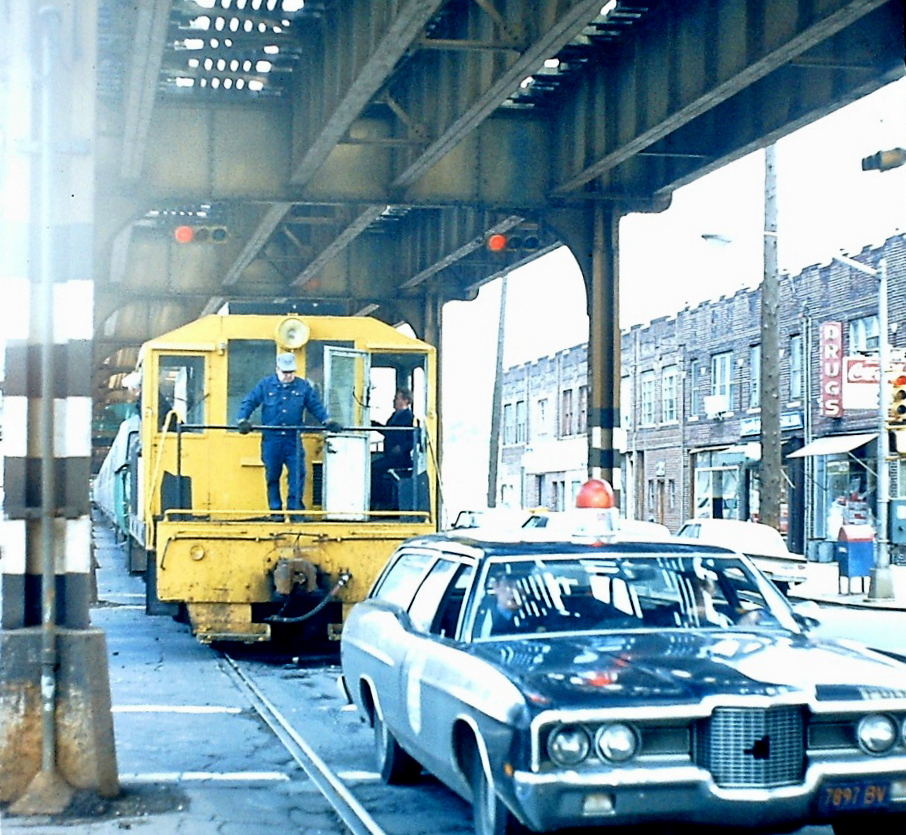
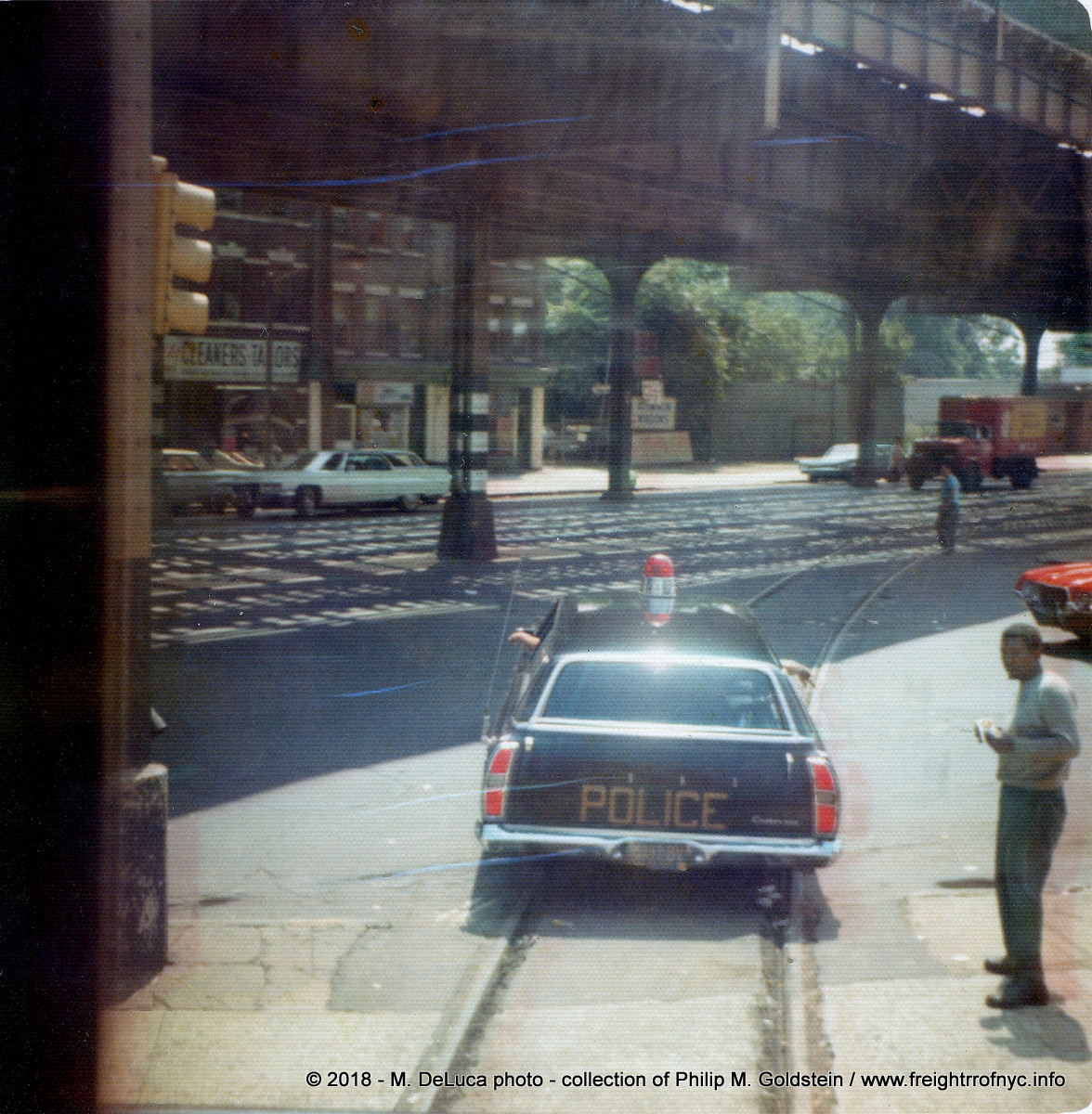
.
.
The second vehicle known to have escorted trains, was a bright red 1973 Plymouth Valiant, license plate: NY 14522-K
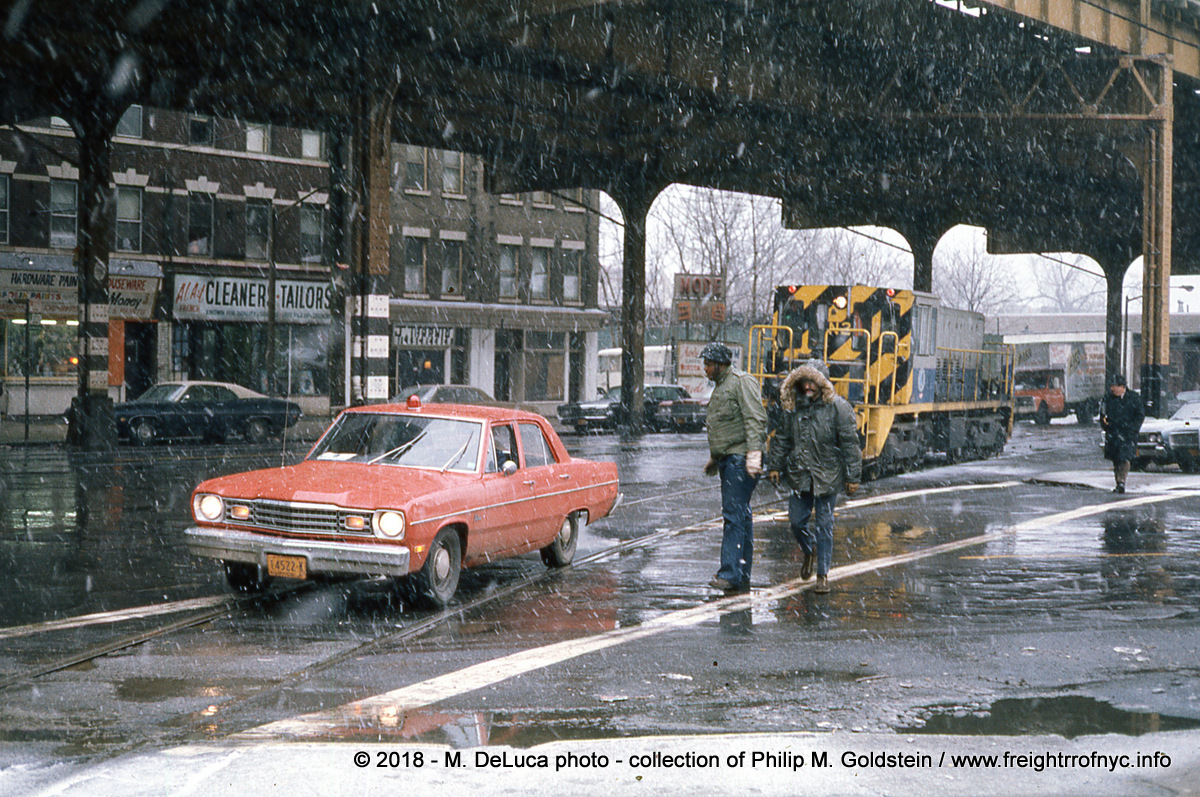
.
.
.
Dual Couplers, Compromise
Couplers (Coupler Adapters) & Transition Cars
.
Unique to South Brooklyn Railway operations over and above all the other industrial and offline terminal railroad operations covered by this website, is the fact that the South Brooklyn Railway must transport subway cars in addition to standard freight cars. Not just those new subway cars arriving and obsolete models being shipped out, but also hauling the varied equipment comprising the museum collection throughout all eras of NYC Transit history.
As technology progressed, these couplers changed in function and style; from early and simple Van Dorn couplers (which were similar to link and pin), to the current automatic type couplers self-containing of air and electrical connector lines and being able to be uncoupled by the push of a button in the cab of the subway car. A list of couplers used by subway car models as follows:
| subway car model | coupler model (for #1 end) |
| Van Dorn a | |
| R1 - R9 | WABCo H2A |
| R10 - R22 | WABCo H2C |
| R26 - R28 (pre-GOH) | WABCo H2C on #1 end, H2CAR (semi-permanent for married pair operation) on #2 end |
| R26 (GOH) and R28 (GOH) | WABCo H2C on #1 end only b |
| R29 and R29 (GOH) | WABCo H2C on #1 end only b |
| R30 - R30A | WABCo H2C on #1 end, H2CAR (semi-permanent for married pair operation) on #2 end |
| R32 | WABCo H2C b |
| R33, R36 (all versions) | WABCo H2C b |
| R38 | WABCo H2C b |
| R40S, R40M, R42, and all GOH versions... | WABCo H2C b |
| R44 (pre-GOH) | Ohio Brass Form 70 c (will mate with H2 types) |
| R46 (pre-GOH) | Dresser w/ centering device (Ohio Brass Form 70?) b? c? |
| R46 (GOH) | Hadady Coupler #RTD-107 w/ centering device b |
| R62 - R68A | WABCo H2C b |
| R110A | WABCo N2C b |
| R110B | NYABCo H2C(m) #RTC-201P? b |
| R142, R142A | WABCo model # unknown b (Tomlinson style-flat faced, hook type with electrical portions) |
| R143 | WABCo model # unknown b |
| R160A, R160B | WABCo model # unknown b |
| R179 | model # unknown b |
| R188 | model # unknown b |
| R211 | model # unknown b |
| WABCo =
Westinghouse Air Brake Company NYABCo = New York Air Brake Company GOH = after General Overhaul a = Most, but possibly not all, early subway & el cars equipped with Van Dorn couplers were converted to H2A's b = Couplers are listed for #1 (operating cab) end. Post-GOH & modern subway car #2 ends are permanently coupled with linkbars c = will mate with H2A and H2C accoridng to compatibility charts. NOTE: Despite certain models of subway cars have the same model coupler, does not mean that those different subway car models are compatible of being coupled & operated together. Compatibility is based upon brake equipment, and other systems. |
|
Before progressing any further, it must be kept in mind that when freight locomotives such as those operated by the South Brooklyn Railway, it is not necessary to have any electrical connections to the subway car(s) being towed, and it is only necessary to have a physical coupler match to that particular subway car, not an electrically operative one.
As such, those compromise couplers sharing physical profiles with one another could be used with various models of subway cars. However, which of those model subway car couplers on the above list that share physical profiles with another is not known at this time. It is presumed but unconfirmed that a compromise coupler suitable for mating to and H2A would be compatible with an H2C. I am trying to ascertain this information for inclusion here.
In any event, even this assortment of coupler models would pose a physical match incompatibility when trying to mate with the standard MCB (Master Car Builders) or AAR (American Association of Railroad) couplers found on typical freight cars and locomotives, hence the need for compromise couplers.
Locomotives #1, #2 and #3 show (by viewing the images in the locomotive photo chapter below) that they were equipped with Van Dorn type couplers. It is not known if these locomotives were ever converted to MCB couplers, and it is not believed so, as images of #1 in storage show it to still be equipped with Van Dorn couplers.
But it is known that there is a Van Dorn / MCB compromise coupler, and was used on 17 November 1998 when Car "G" (which was built in 1878 as New York Elevated RR #41 and subsequently converted to a money collection car by Manhattan Railway in 1898. In 1998, Car "G" was loaned from the Shore Line Trolley Museum located in East Haven, Connecticut; to the New York City Transit Museum collection displayed in former Court Street Station. It had to be trucked from Connecticut to the NYCTA's 207th Street Facility where it was unloaded. It was at this location that Car "G" was coupled to South Brooklyn Railway locomotive N2, utilizing a Van Dorn to MCB compromise coupler, and brought to Court Street Museum.

Car "G" on left with Van Dorn to MCB Compromise Coupler
with SBK N2 on right.
N. Gerstein photo - 17 November 1998
.
This image allows us to conclude that despite the advanced age of museum rolling stock and likewise its coupler profile of the series, the South Brooklyn Railway has an assortment of compromise couplers for movement of the museum pieces as well as re-purposed equipment pressed into maintenance of way service.
Locomotives #1, 2 & 3 are seen throughout their history in images equipped with Van Dorn couplers. It does not appear that either of these locomotives were converted to MCB/AAR coupler.
Locomotive #4 shows only an MCB/AAR style coupler, as does locomotive #5.
However, locomotives #6 and #7 were equipped with dual couplers, meaning they had both an MCB and a H2 subway car coupler mounted side by side on a common coupler shank, on both the front and rear of the locomotive. All a brakeman had to do, was move the desired coupler into position:
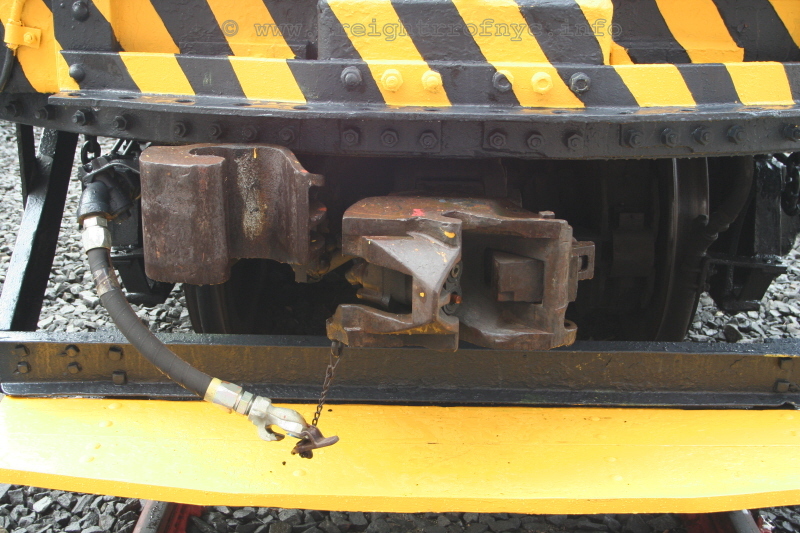
dual couplers on SBK 7 - April 2008
coupler on left: MCB (freight cars)- coupler on right: H2 (subway cars)
Coney Island
Yard, Brooklyn, NY - TA Roadeo
P. F. Strubeck
photo
added 24 Dec 2009
.
After the electric locomotives with dual couplers were retired, the South Brooklyn Railway diesel locomotives (which were equipped with standard MCB/AAR couplers) would need a compromise coupler or a transition car to pull subway cars.
Paul Strubeck had the foresight to photograph some of these unique, essential and all-to-often overlooked pieces of equipment necessary to South Brooklyn Railway operations. Here are just two examples of the many types used:

H2 (left) to MCB (right) Compromise Coupler (with knuckle lock pins) - April 2008
Observation / Inspection Car 0F116 on left, SBK N1 on right
Coney Island Yard, Brooklyn, NY - TA Roadeo
P. F. Strubeck
photo
added 24 Dec 2009
.
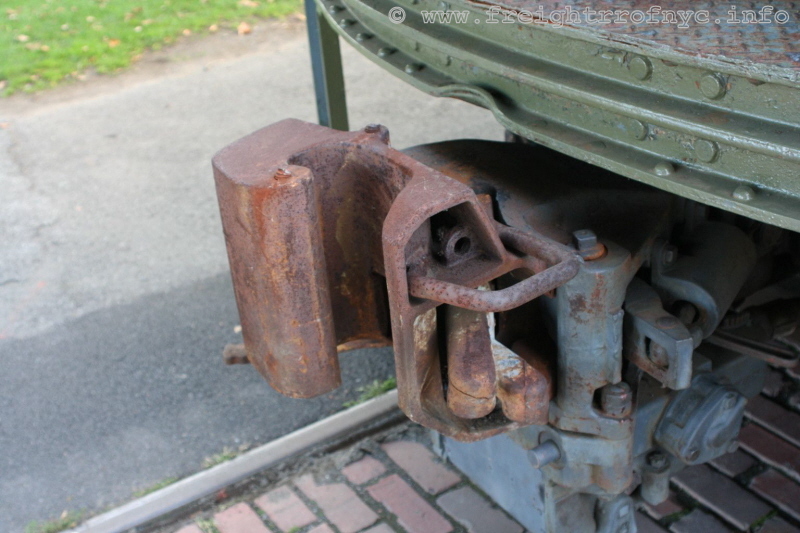
MCB to H2 Compromise Coupler - (MCB face showing) - October 2008
Trolley Museum of New York; Kingston, NY
P. F. Strubeck
photo
added 24 Dec 2009
.
With the utmost thanks to my "source" at the NYCTA; here is a composite photo of the issued poster that circulates with the Authority. The left panel is comprised of photos showing the types of car couplers encountered on subway equipment - both work (non-revenue) cars and revenue (passenger) cars. The right panel are photos of the adapters to be used for those couplers. Please note that the couplers shown for revenue equipment are for equipment in active service (when the poster was issued), and not for retired cars or cars in the Transit Museum.
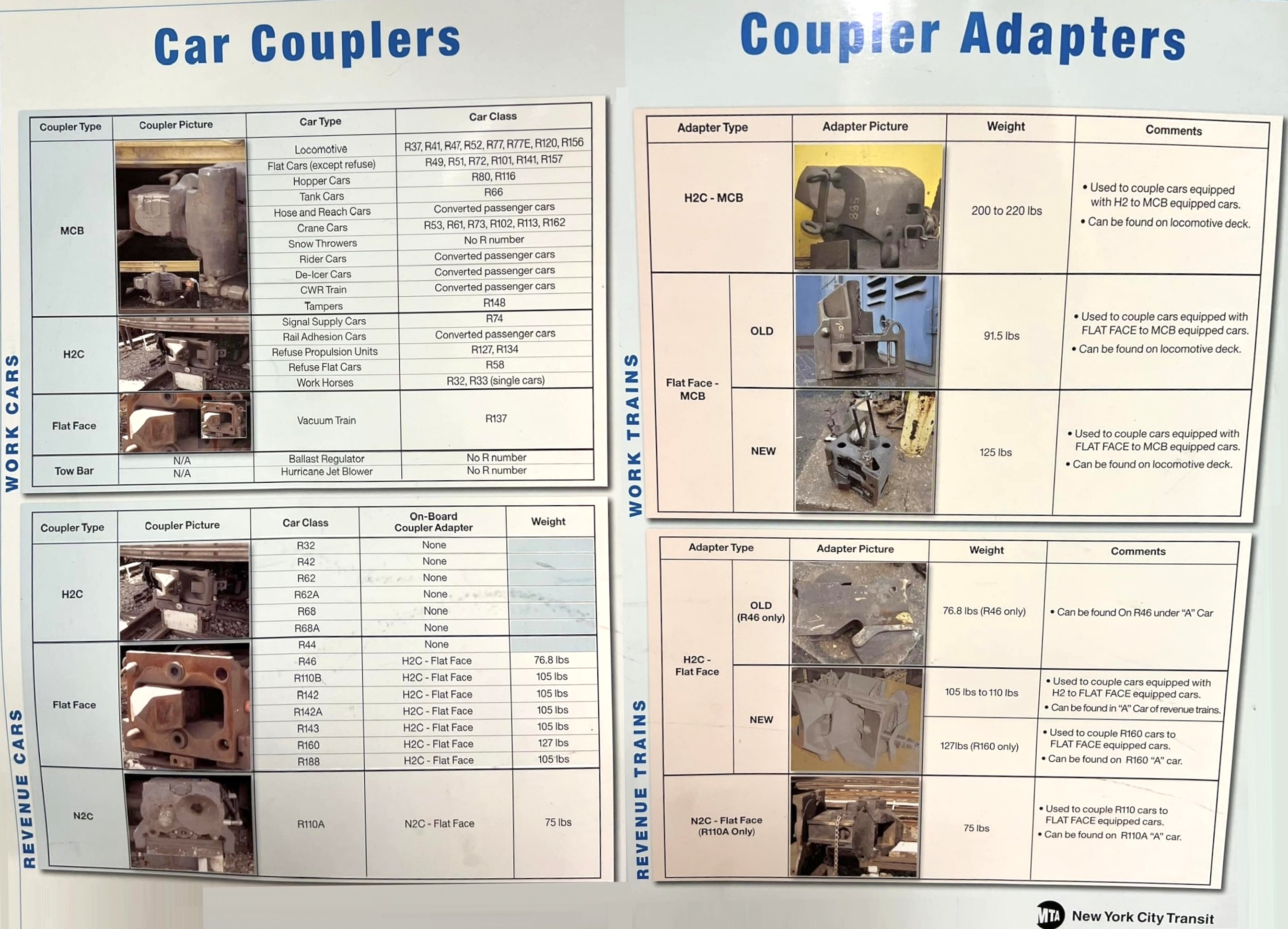
thanks MW!
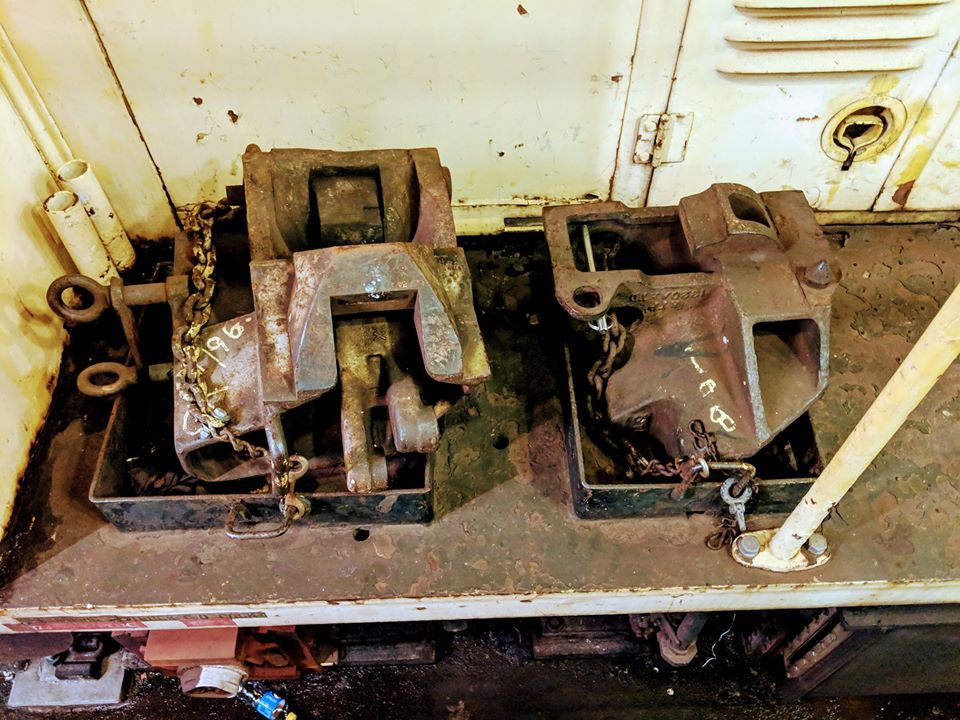
Transition Cars
Also encountered and similar in usage is the "transition car". This piece of rolling stock is equipped with MCB or AAR type of coupler on one end, and subway style coupler on the other.
Relatively speaking, almost any common freight car can be converted into a transition car; with one of the couplers changed to the type needed and it is not a hard process to accomplish -in "olden days" three or four men could change a coupler. Today, a small truck mounted jib crane is used.
As these freight cars are already AAR / FRA inspected and certified for use on main line tracks throughout the United States; they were suitable for use in bringing new equipment from anywhere in the US to the NYCTA interchange; or in those cases for old equipment to be brought to a rebuilder over main line trackage.
Within this page, you can find photos showing many different types of transition cars. Usually, gondolas or flatcars were used for pulling new and rebuilt subway cars off flatcars at the loading ramp at the 38th Street "unloading" yard, as these would be of the lightest types of freight cars in use. NYCTA cut down some older subway cars to the floor, installed an MCB coupler on one end and used that to offload new subway cars off the flat car transporters. This became one of their "internal" (not to venture outside the subway system) transition cars.
As the different subway car manufacturers were located in various parts of the United States, these subway car builders would have had to contract with the trunk line railroad near their construction shops to move the NYCTA subway cars east.
Subway car rebuilders were located in:
While not for certain, it would be logical that each trunk line railroad that might have hauled these subway cars to the New York area, would have had their own transition car. Since most of the Midwestern railroads did not have terminals on the New Jersey shore of the Hudson River would have had to consign the shipment to a eastern railroad that did, and then that railroad would need to use a transition car as well. Lehigh Valley, Delaware Lackawanna & Western, New York Central and Pennsylvania Railroads (among others) all had terminal facilities in New Jersey equipped for carfloating the subway cars to Brooklyn.
And we know by the photos below, that New York Central did indeed have a transition car, as did the Lehigh Valley and the Delaware, Lackawanna & Western Railroads. How many others remains a mystery. For the record, changing a coupler on a freight car is not a terrible task, and can usually be completed by two men in under an hour.
While duplicitous, I show these photos again here for clarity:
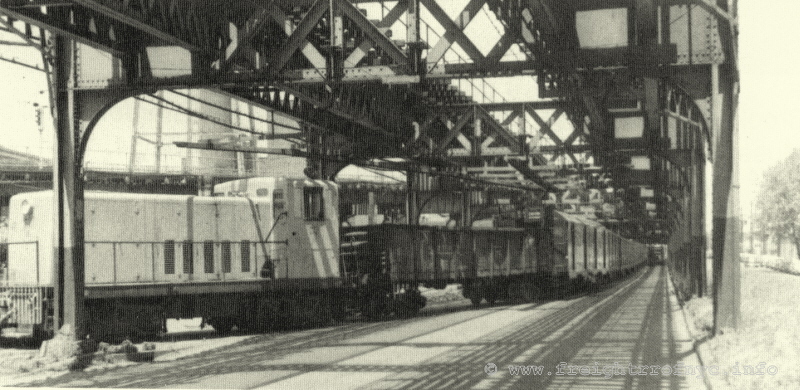
#13 - Shell Road and Avenue Y
- May 31, 1961
Bringing brand new R30's into Coney Island Yard with New York Central gondola
transition car.
Under the "Culver / Sixth Avenue"
![]() line.
line.
A. J. Lonto collection
ERA Headlights May - June 1993 Issue
added 22 Dec 2009
.

Parkville Interchange - Brooklyn, NY - March 21, 1965
Note the air reservoir in the gondola. According to Paul Strubeck, that Lehigh
Valley gondola was modified
for use in hauling subway cars on Lehigh Valley trackage on mainland U.S.
trackage and is apparently capable of transition use between
standard AAR couplers (on Class 1 and SBK diesels) and the subway car H2A
type couplers.
D. Grotjahn photo
D. Pirmann collection
added 19 Dec
2009
.
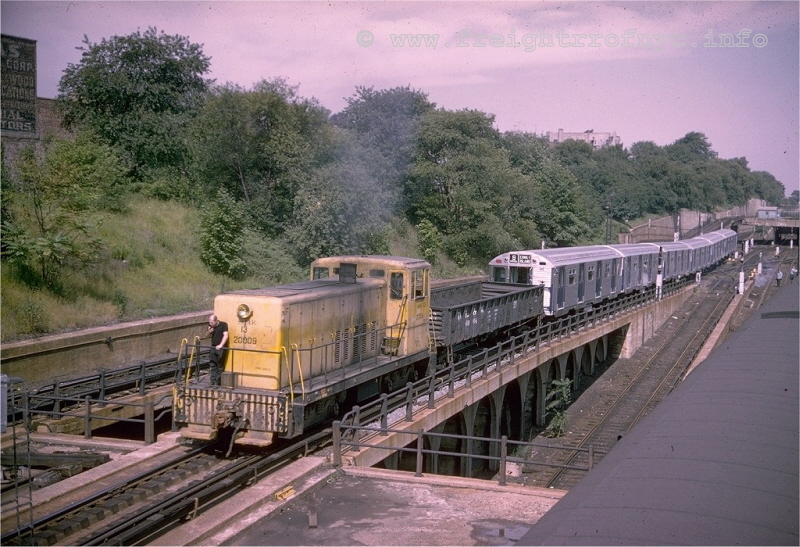
#13 - unknown date - Ninth Avenue
R32's enroute to Coney Island. Note the DL&W gondola being used as transition
car.
The train is climbing the ramp from subgrade to street level.
J. Shanus photo
J. Testagrose
collection
added 06 September 2009
.

Parkville Interchange - Brooklyn, NY - February 18,
1972
R44's going out to LIRR for speed testing and delivered to Parkville Interchange with R1 M502 transition car.
Note transition car is
marked "MCB" for MCB coupler on that end.
Other end of transition car has H2A coupler to mate with
R44's. (Form 70's and H2A mate on the compatibility chart)
S. Zabel photo
J. Testagrose collection
added 19 Dec
2009
In
February of 2020, I was
involved in a dialog in a Facebook group where another group member
insisted
that the opposite end of the transition car (M502) shown in the image
has MCB couplers on both ends, and a coupler adapter was used to mate
with the R44's. MCB coupler on one end (closest to the camera) and H2A coupler on the other end (coupled to R44's). According to the NYCTA compatibility chart; H2A and Ohio Brass Form 70's will mate. Therefore no compromise coupler / adapter is needed between the H2 and Form 70. An image of the H2A end can be seen here: M502 H2A end image - nycsubway.org I was also told that compromise couplers (a/k/a coupler adapters) did not begin use on the TA until 1975; but transition cars are still used as necessary (such as on the unloading ramp in the photo below, when needed and when weight loading prevents direct coupling with a compromise coupler. Furthermore, this same Facebook group member insisted that M502 is not called a transition car, but a "spacer" car. Again, I inquired of Mr. Schaeffer. As I have been told, a spacer car has MCB coupler on both ends and is used to spread out the weight of the work locomotives which also have MCB couplers front and rear. Furthermore, these "spacer" cars are listed as a Rider Cars (RDxxx) in NYCTA rosters. This is NOT the case in this photo. For the record, Mr. Schaeffer is employed with the NYCTA for over 23 years, and Mr. DeLuca has been employed by several railroads since the 1970's. I believe their tenure qualifies their industry knowledge, over and above the fact that both have been avid transit / Brooklyn railroad buffs even longer than their professional railroad careers. |
.
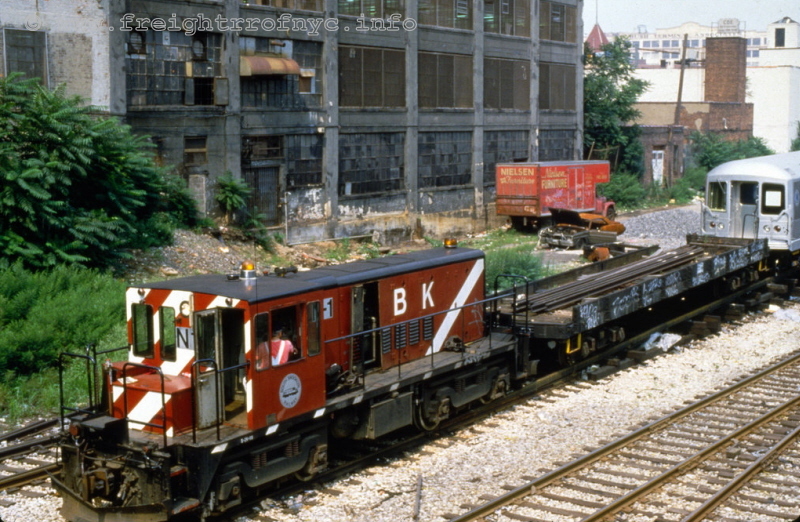
N1 - August 1988 - 38th Street between
Fourth and Third
Avenues
Looking south west. Unloading rebuilt R42's tranported atop flat cars with transition car, which appears
to have made from the chassis of a subway car.
D. Pirmann photo
added 22 Dec 2009
.
.
..
Paul, you got your wish.
Due to the large amount of images accrued of locomotives and
equipment operated by the South Brooklyn Railway; it has been deemed
necessary to place the collection of images on their own page, like
what I have done previously with Brooklyn Eastern District Terminal,
Bush Terminal and New York Dock:
South Brooklyn Railway - Locomotives & Equipment
Images & Roster
.
.
.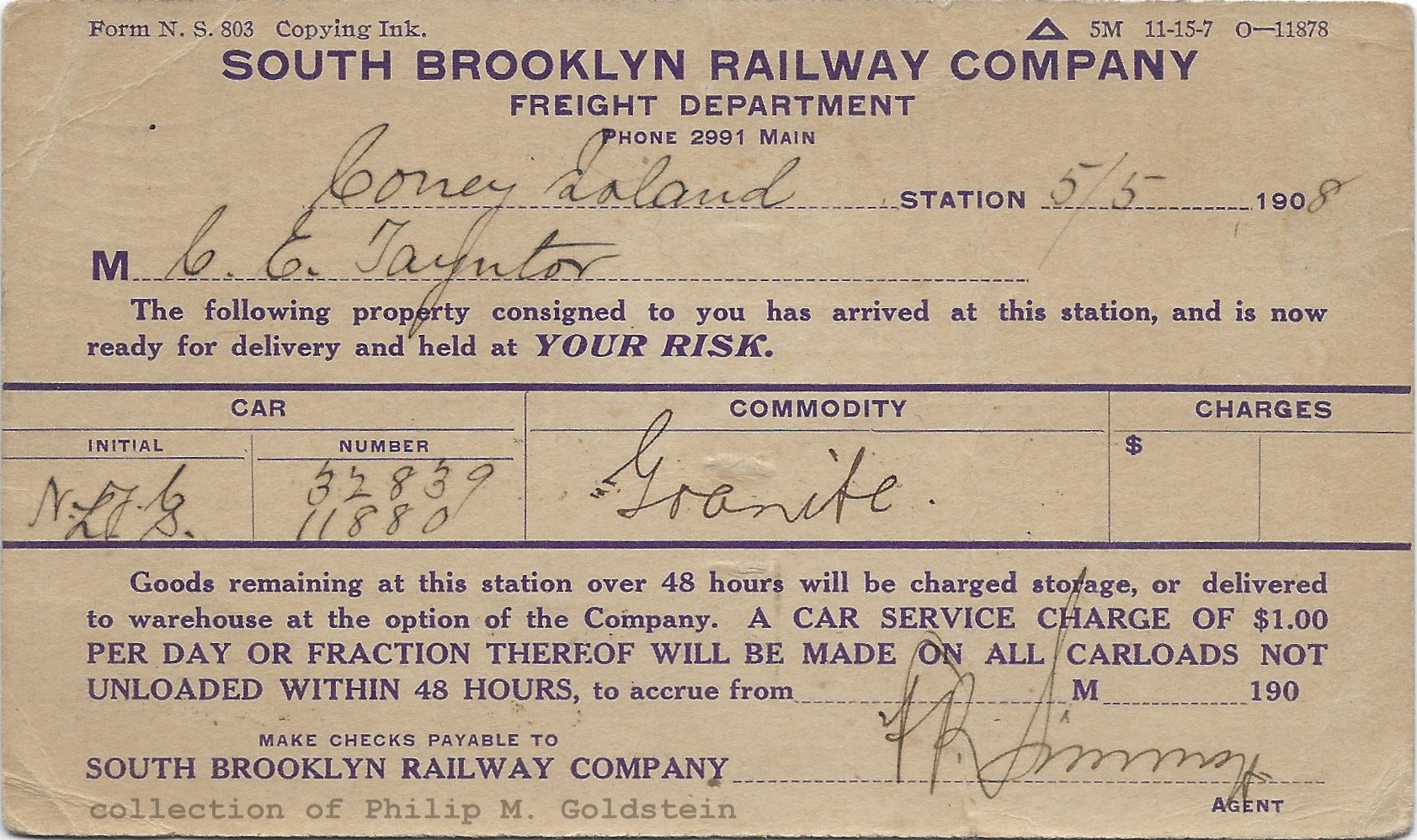 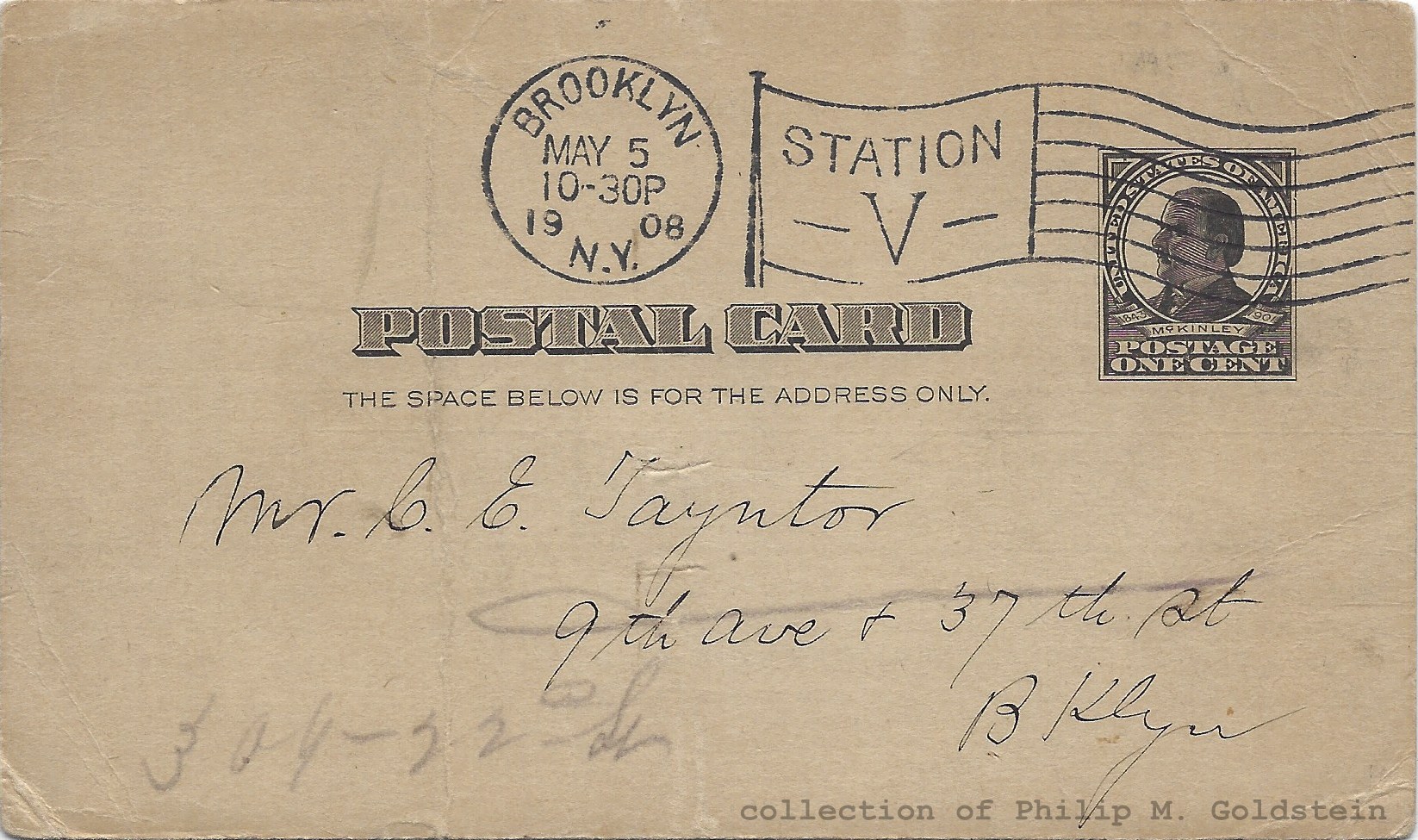 Arrival Notice - May 5, 1908 3 1/4" x 5 1/2" authors collection added 25 July 2021 | ||||||||||||||||
| .
. | ||||||||||||||||
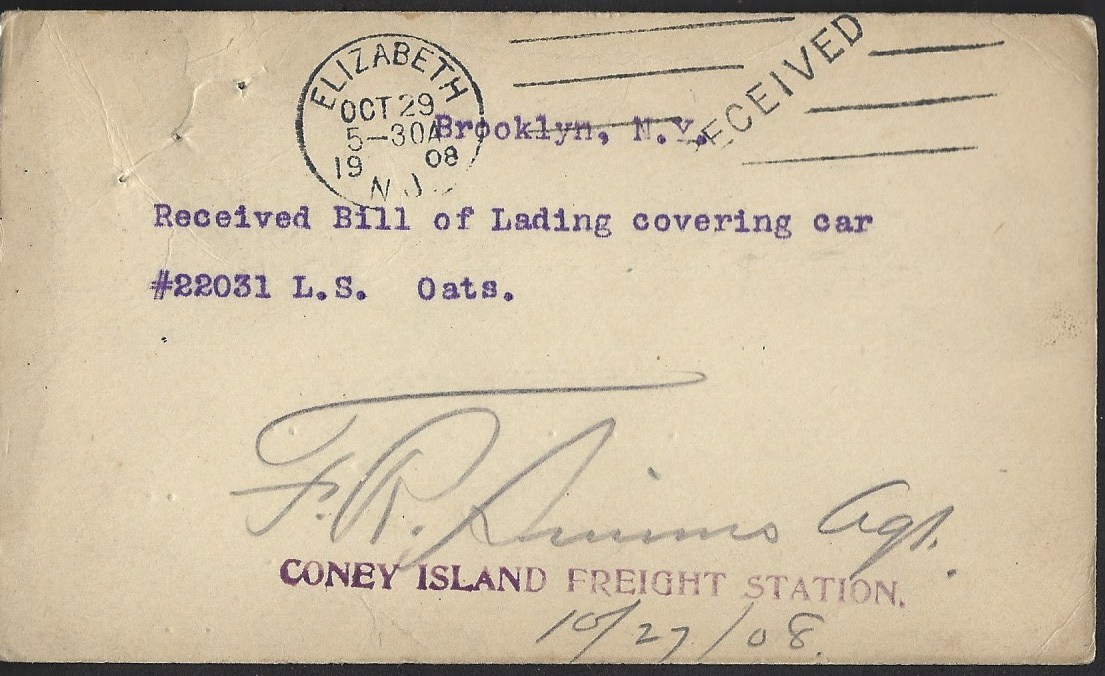 #6 Envelope - postmarked October 1908 authors collection added 02 July 2018 | ||||||||||||||||
| .
. | ||||||||||||||||
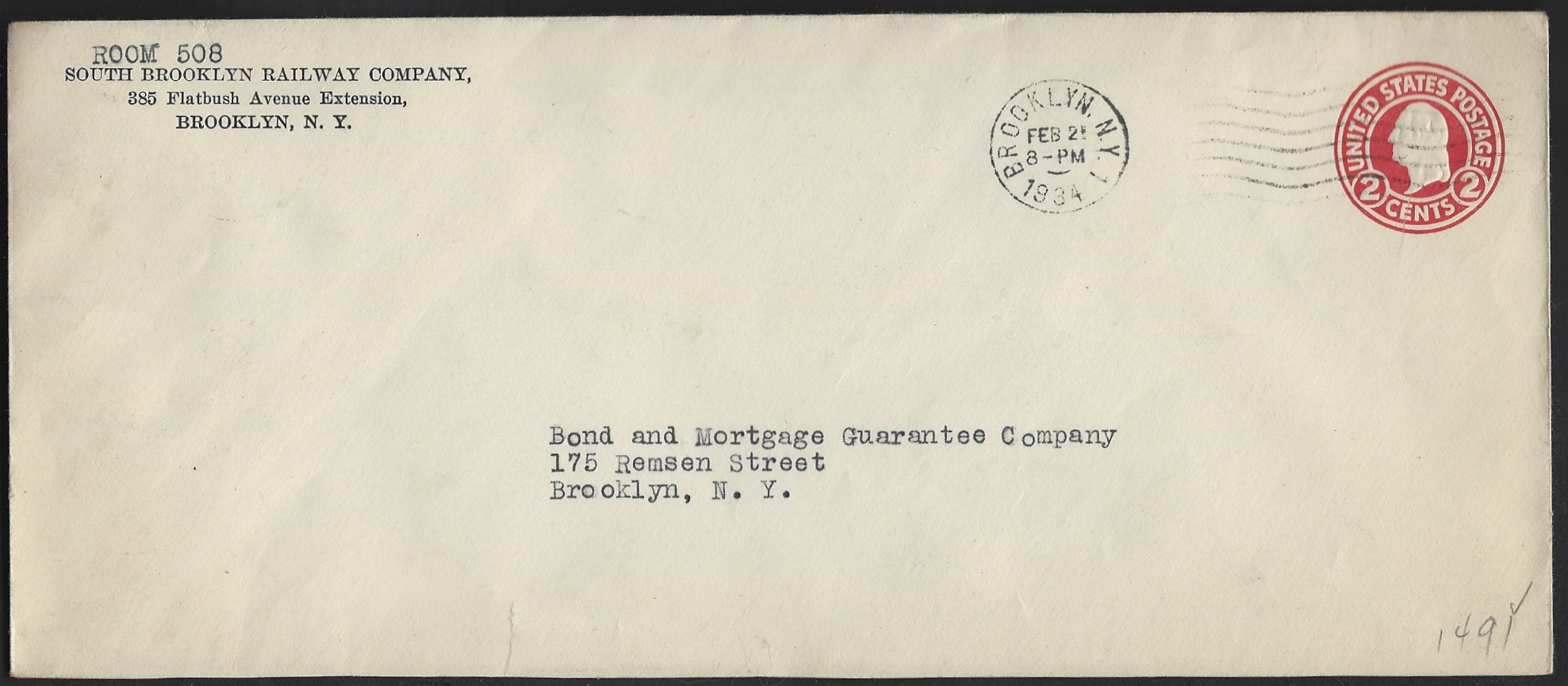 #11 Envelope - postmarked February 1934 authors collection added 02 July 2018 | ||||||||||||||||
| .
. | ||||||||||||||||
|
||||||||||||||||
| .
. | ||||||||||||||||
   Car Clearance Tags formerly Benjamin W. Schaeffer collection authors collection added 25 July 2021 | ||||||||||||||||
| .
. |
||||||||||||||||
| ||||||||||||||||
| .
. |
||||||||||||||||
| ||||||||||||||||
| .
. | ||||||||||||||||
|
||||||||||||||||
| .
. |
||||||||||||||||
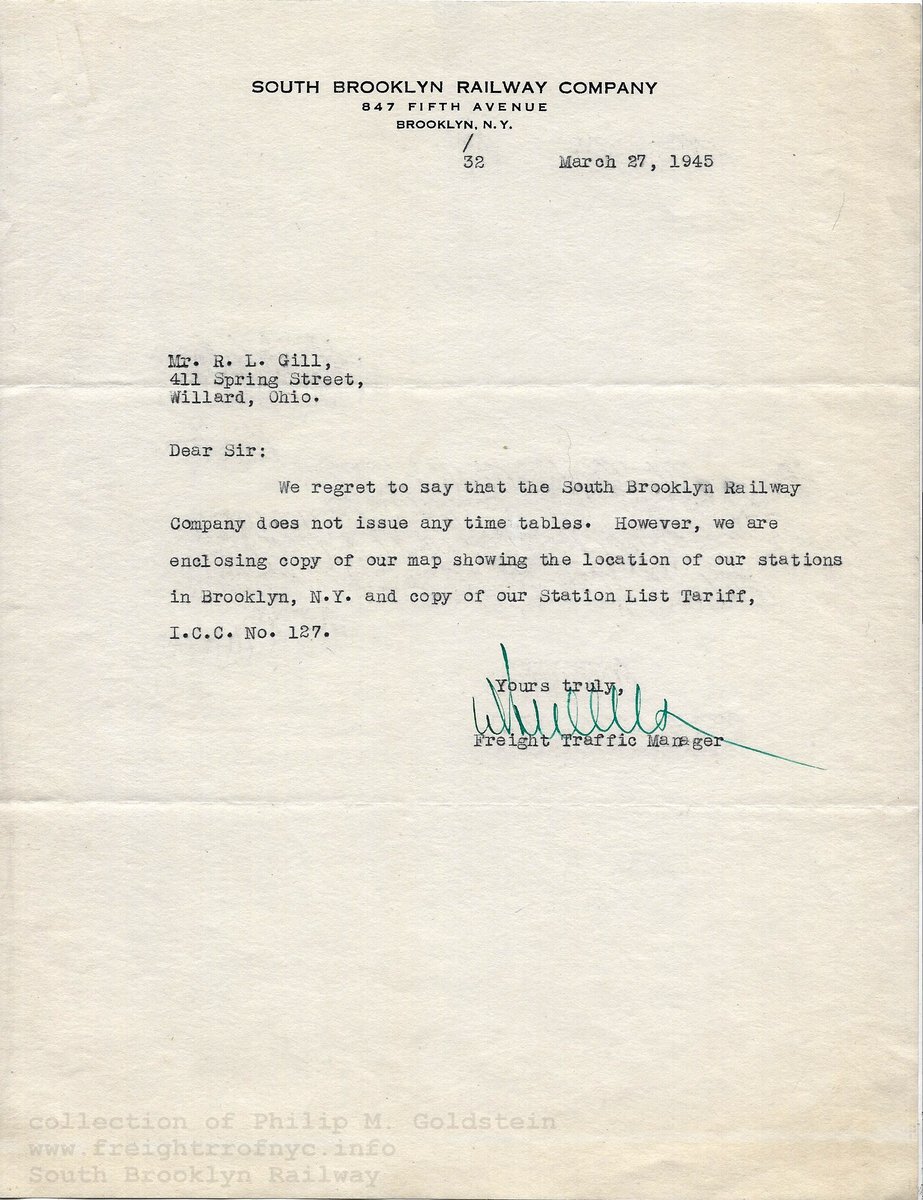 ..... .....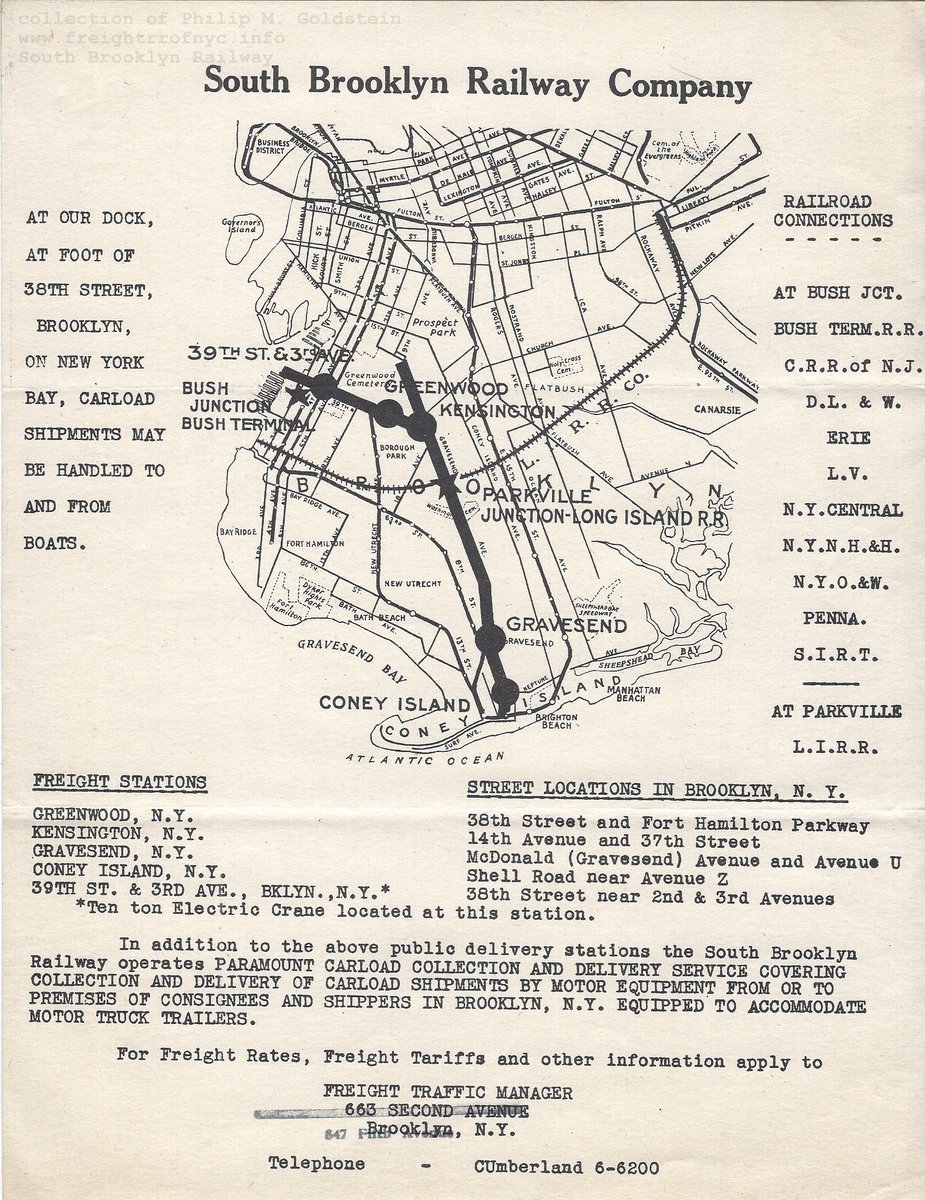 | ||||||||||||||||
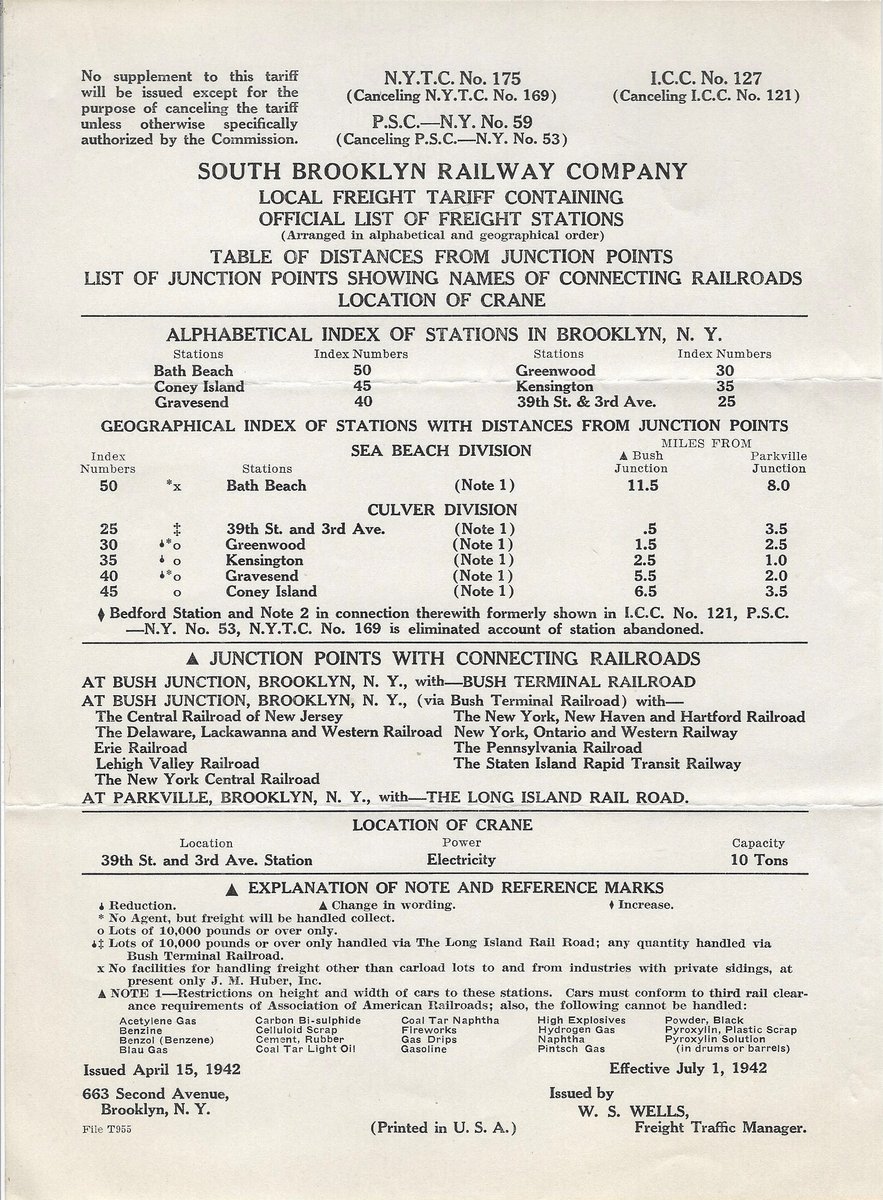 Cover letter, system map & station list, (8 1/2" x 11") 1942 tariff sheet (8" x 11") 1945 authors collection added 18 August 2021 | ||||||||||||||||
| .
. | ||||||||||||||||
| ||||||||||||||||
| .
. |
||||||||||||||||
|
||||||||||||||||
| .
. | ||||||||||||||||
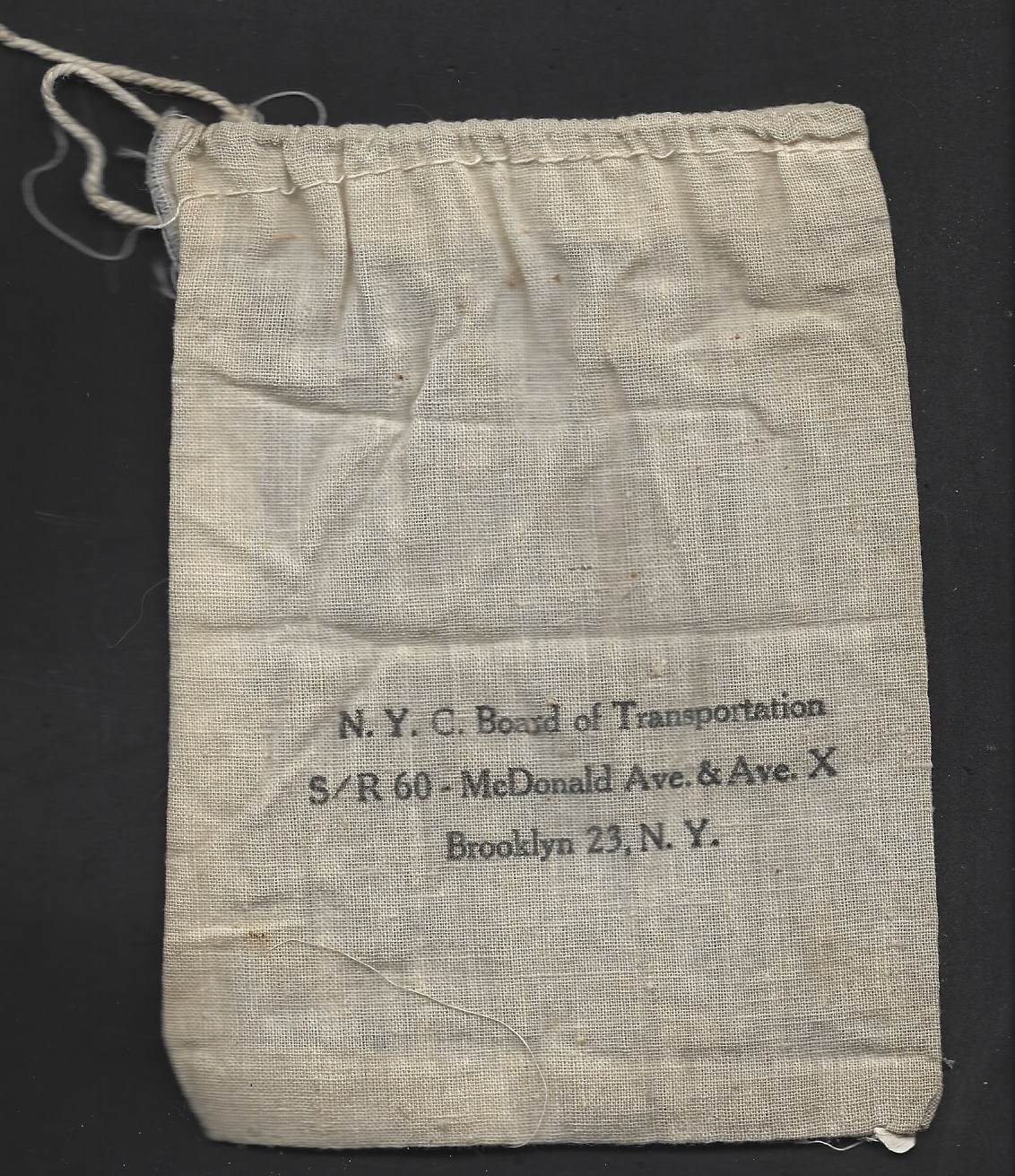 (may or may not be South Brooklyn Railway) authors collection added 02 July 2018 | ||||||||||||||||
| .
. | ||||||||||||||||
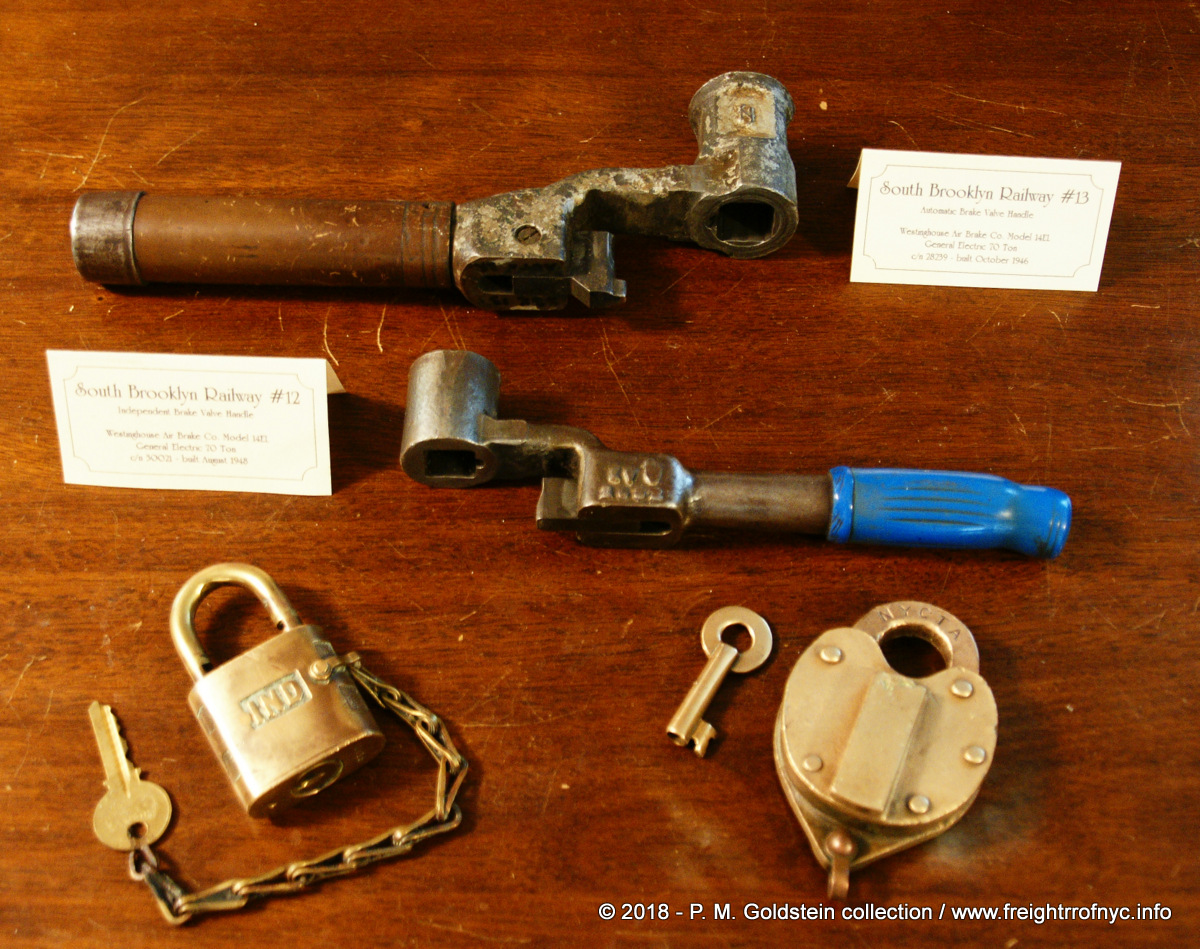 South Brooklyn Railway #13 Automatic Brake Handle South Brooklyn Railway #12 Independent Brake Handle brass Yale lock - NYCTS / IND brass Wilson Bohannon lock - NYCTA Both brake handles were gifted to the author by M. DeLuca, of who's images grace this page. authors collection added 02 July 2018 | ||||||||||||||||
| .
. | ||||||||||||||||
| ||||||||||||||||
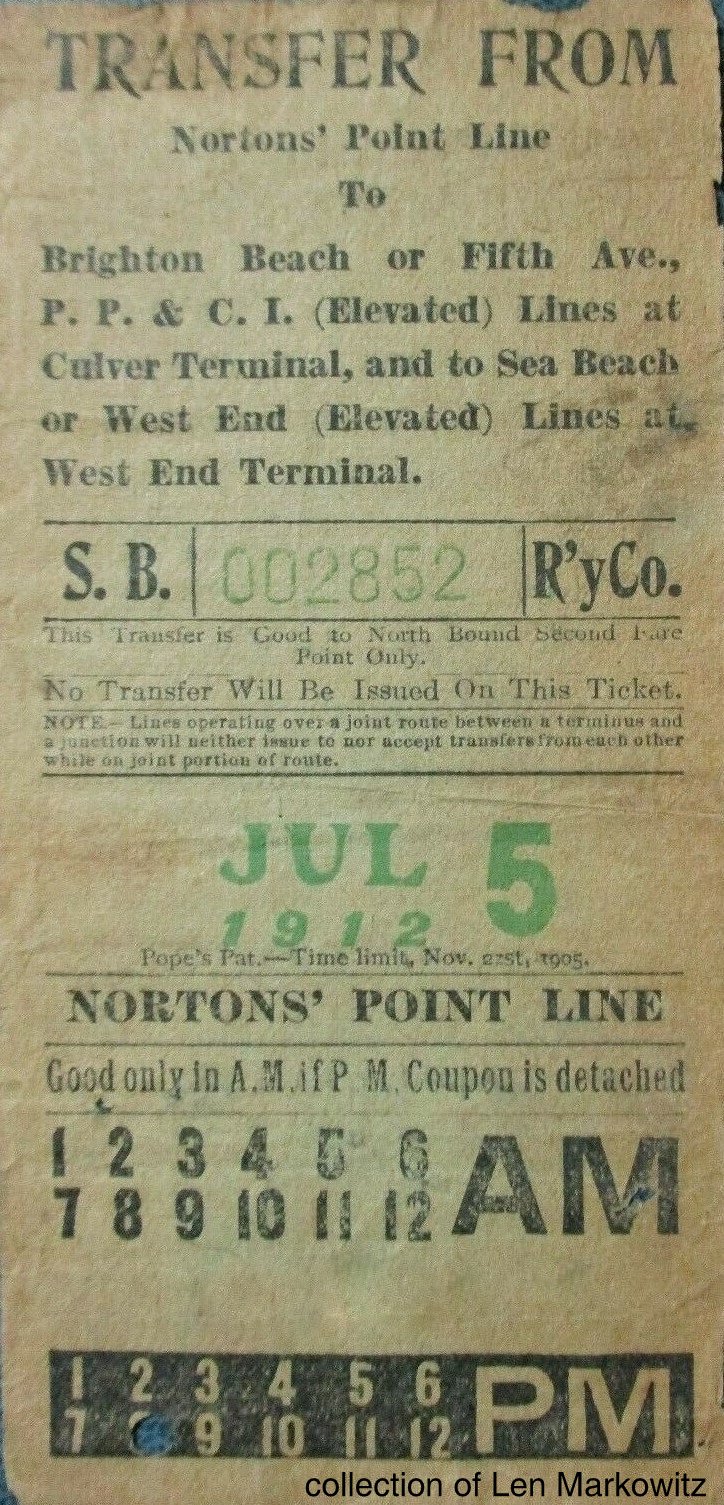 | 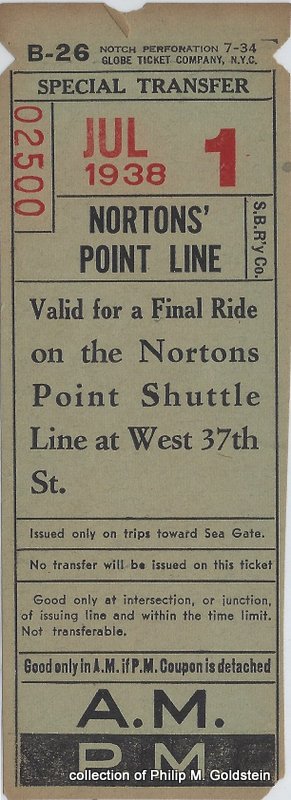 | 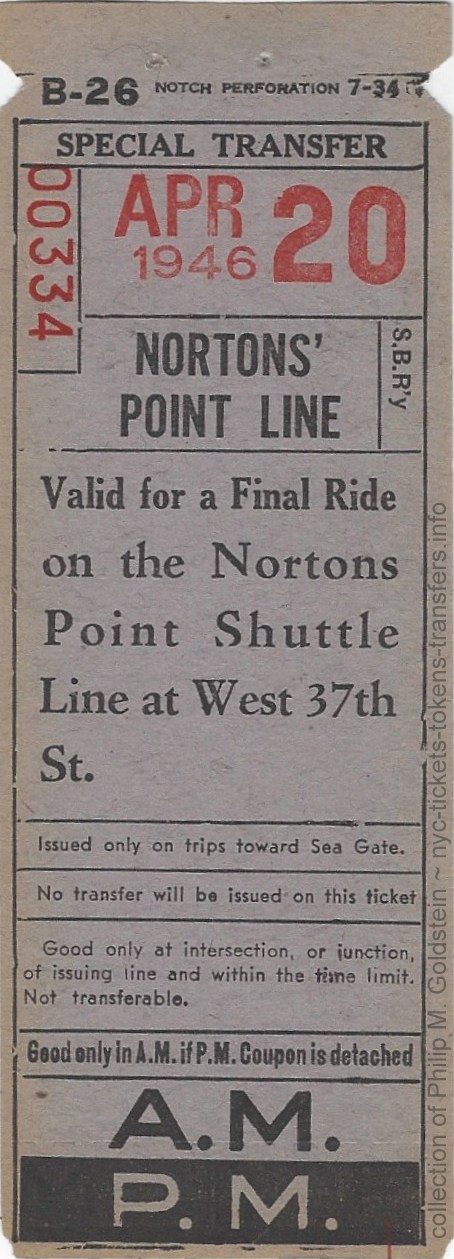 | 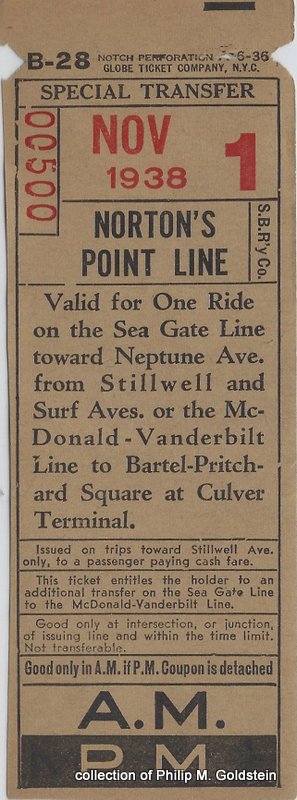 |
| collection of Len Markowitz | authors collection | ||
.
Flatbush Avenue Coal Ink Blotter
6 1/4" x 3 3/8"
authors collection
.
.
Some of the fondest memories South Brooklyn Railway fans have, is
of the bocce courts on the right of the way. Never to forget their
heritage and the old country, some of the neighborhood Italian elders
used the South Brooklyn Railway tracks north of Kensington Junction as
a bocce court. The dirt and mud between the rails was leveled and
packed, and it was found to be ideal for playing bocce, with the rails
serving as boundary bumpers.
These bocce courts were even appointed with removable backstops, so that when that occasional train would venture down the line, the elders would simply remove the backstop to allow the train to pass. As train speeds were only a few miles an hour and as the elders had long since established a relationship with the locomotive crews, there were never any issues. Note the bocce court is between the north and southbound tracks and not between the track gauge itself.
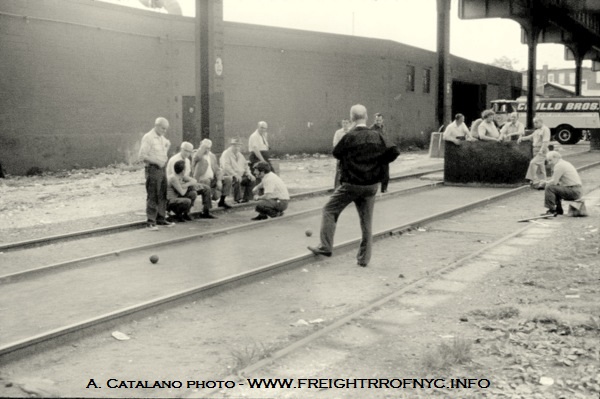 | 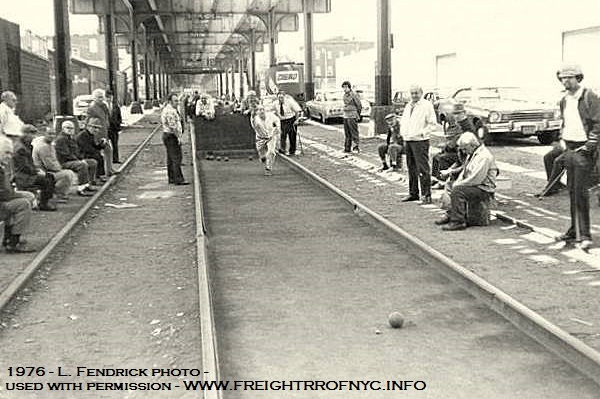 |
Being a Brooklyn resident of the Gravesend neighborhood, and living within walking distance to South Brooklyn Railway's McDonald Avenue trackage, I remember when the first portion of the McDonald Avenue trackage was removed from service, and then the second.
At least on one occasion many years before, I remember vividly as a child, sitting in the family car waiting for a traffic light to change when a big bellowing diesel locomotive sauntered by, running the street trackage on McDonald Avenue.
Sometime in 1991 or 1992, my friends Dave, John, my sister Randi and I decided to go "exploring" the Bay Ridge Division tracks. We took the subway (F Train) from Kings Highway to Avenue I, where we knew we could get onto the Bay Ridge Division right of way through the South Brooklyn Railway / LIRR Parkville Interchange at Avenue I and McDonald Avenue.
About 1/4 of a mile west of Parkville Interchange / McDonald Avenue and Avenue I, we found a Nolan TS-1 tool cart from the Transit Authority laying off to the side of the tracks. Well, riding is always better than walking, and we set the cart on the rails, loaded our gear on the cart and set off towards Owls Head. After a few hundred feet, we discovered our stuff kept wanting to slide off the deck, so we looked through the debris and rubbish thrown into the right of way, and we found some wire that we used to tie our stuff down with. We took turns sitting on the back of the tool cart pushing with our feet. When we would come to an incline, two of us would push. We found a 2" x 3" piece of wood, and we would jam it between a wheel flange and the frame to slow the cart down when going down a hill. Don't kid yourself; Brooklyn isn't as flat as you think and that cart would pick up some pretty decent speed heading downhill and that "jam" brake was necessary.
About 30 minutes later, the right of way really opened up, and we arrived at Fort Hamilton Parkway. Here, we took a well needed rest break and took the time to inspect an old position signal left over from the New York, New Haven & Hartford Railroad's days of ownership of the Bay Ridge Division. After watching some subway trains on the adjacent West End Line, we started off again.
We arrived at the Fourth Avenue underpass about another 30 minutes later. The underpass actually stretches for a couple of city blocks, so it's more of a wide multi-track tunnel than a simple overpass, and it gets dark under there. We were about half way through, when I caught movement in front of us and to our right, and behind the concrete support pillars. I said something to my friends about it, (and of whom couldn't care less), so they tell me keep pushing. (Seems like I was the one always pushing...) Lo and behold 2 seconds later, here comes a headlight out from behind the pillars and onto our track!
Well, we all panicked with visions of a Casey Jones type wreck, so in an adrenaline fueled fright, we picked the tool cart up and literally threw the cart a good 15 feet off the tracks. Mind you with all our stuff still tied down on it: backpacks with clothes, my camera, and a large ice chest full of sandwiches and soda, and including the weight of the cart, we're talking several hundred pounds! My sister and friends ran behind the pillars and like the railfan I am, I stood off the tracks and watched the loco approach us. It wasn't going very fast (we didn't know that when we first saw it) and about a minute later the locomotive stops with the cab right next to me. It was South Brooklyn Railway N1 hauling some subway cars eastbound out of the Brooklyn Army Terminal trackage and Bush Terminal.
By this time my friends and sister came out from hiding and the engineer had stuck head out the cab window and asked what we were doing. I told him we were heading to the Owl's Head Yard for a picnic, and to take pictures. He smiled, said "no problem" but to be careful. He told us he would be returning westbound around 2 p.m., so if we were to be on the track outside the yard, we were to keep an eye out for him heading towards us. He also told us vandals had broken into the firehose lockers in the Bay Ridge Yard and hose was stretched across the tracks, so that if we really wanted to get all the way to the water with the cart, we'd have to clean up some hoses.
He told us his name, but my memory fails to recall it (somehow Angelo seems familiar) and he headed east. We rerailed our tool cart and headed west. We then came to a turnout where the tracks diverge for the Brooklyn Army Terminal and the Bay Ridge Yard, and the switch was thrown for the BAT, so we threw the switch, ran the cart through, and returned the switch to its original position. Then we came across a derail that was locked and we had to "hump" the cart over the derail (it's funny how the cart felt heavier now than in the moment of panic when we threw it off the tracks!)
Once in the yard, we picked up and rolled quite a few rolls of firehose that morning to clear "our track" and finally made it to the water. I remember seeing a tug with the BEDT herald on its stack tied up along the wharf, and I went to get my camera. But, like a schmoe, I forgot to bring film! All that way, all that railroad history and memories, and I forget the film!
After a few hours, and after some lunch and some exploring, we decided to head back to McDonald Avenue. We decided to take a roll of fire hose with us and one of the hose nozzles and we set off. We had to hump the tool cart over the derail (now it felt even heavier) and play with the switch again. We didn't encounter N1 all the way to McDonald Avenue, and when we went to unload, we realized we lost the hose nozzle somewhere along the way. We split the cart into two parts and buried the tool cart under some old tires and debris under an overpass for a future trip. A few months later when we returned (with film this time) to get the tool cart, the tool cart was gone.
For what its worth, looking back upon it, that was one of my best days of "railfanning"!.
I also recall a moderately sized coal retailer (long since out of business during my years) with four 3 story concrete coal silos of Flatbush Coal located between Colin Place & Billings Place and McDonald Avenue (between Avenue S and Kings Highway). In the street was a turnout, and branching off the mainline, tracks entered under the silos. This sight frequently greeted me as I disembarked from the "F" Train on my way home from work, and I was saddened to see that these coal silos were torn down several years ago during a visit to my old neighborhood.
.
.
.
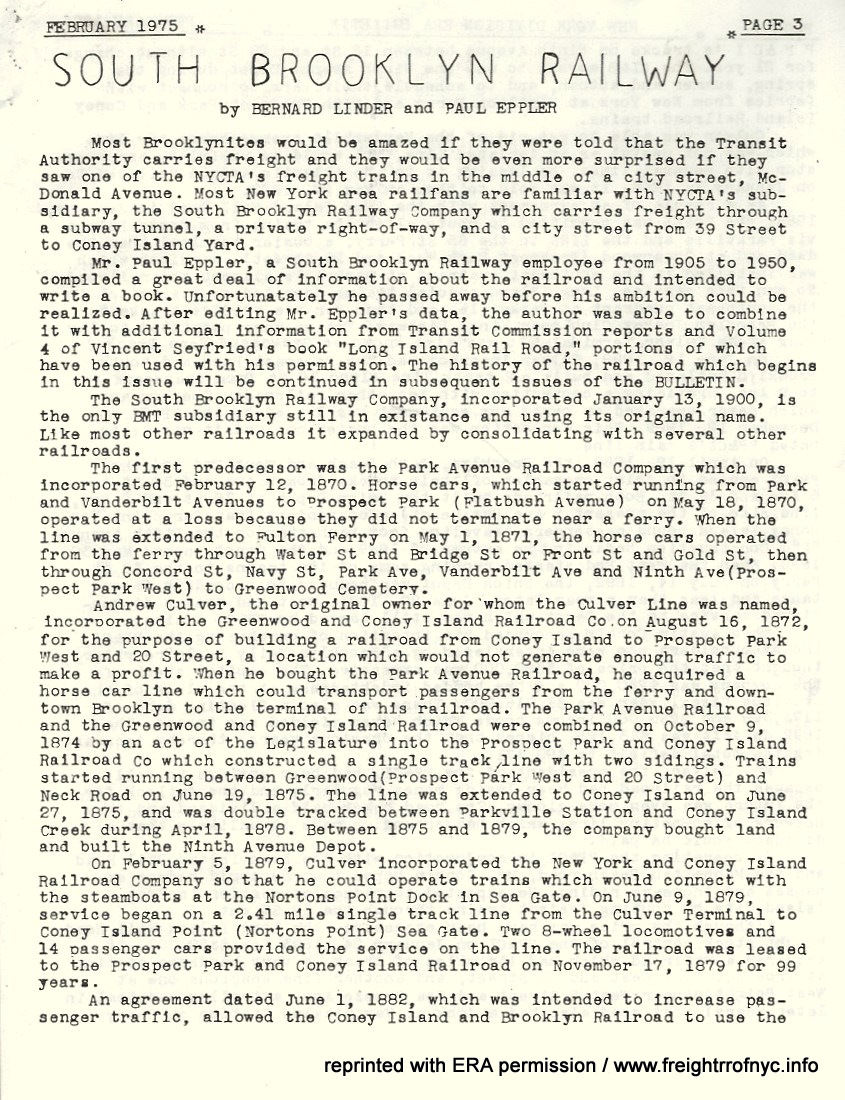 |
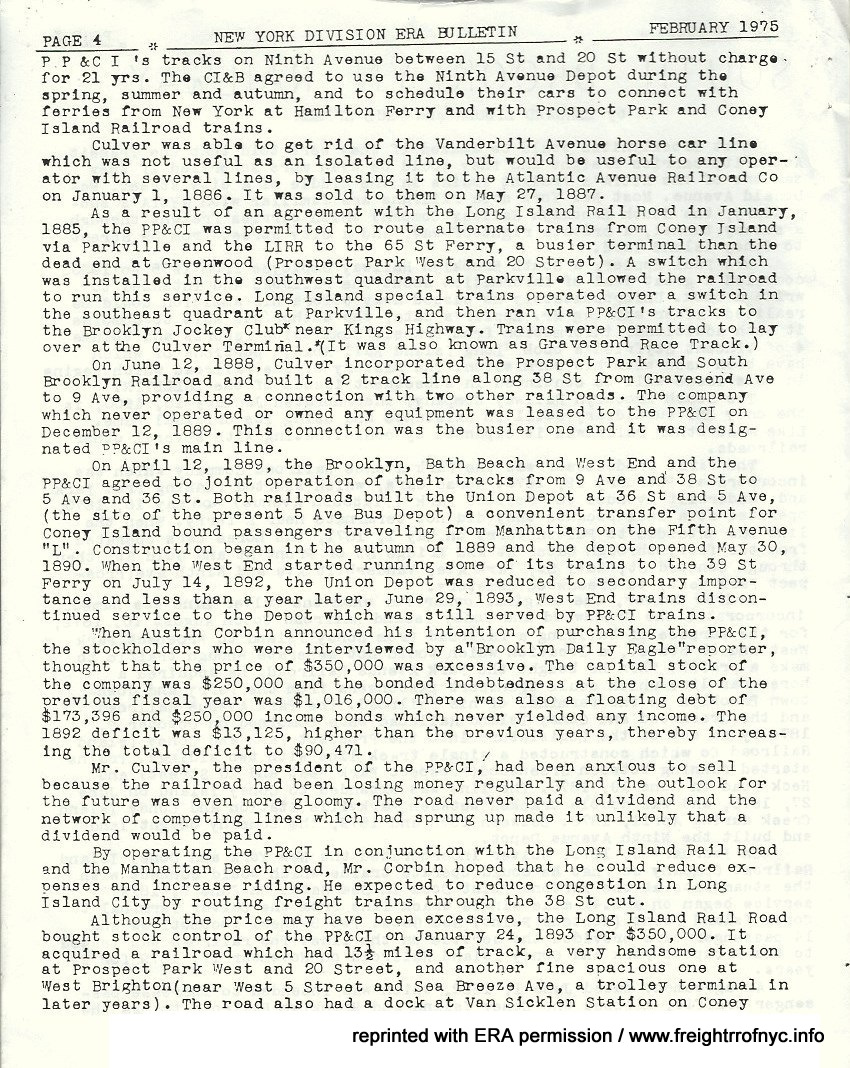 |
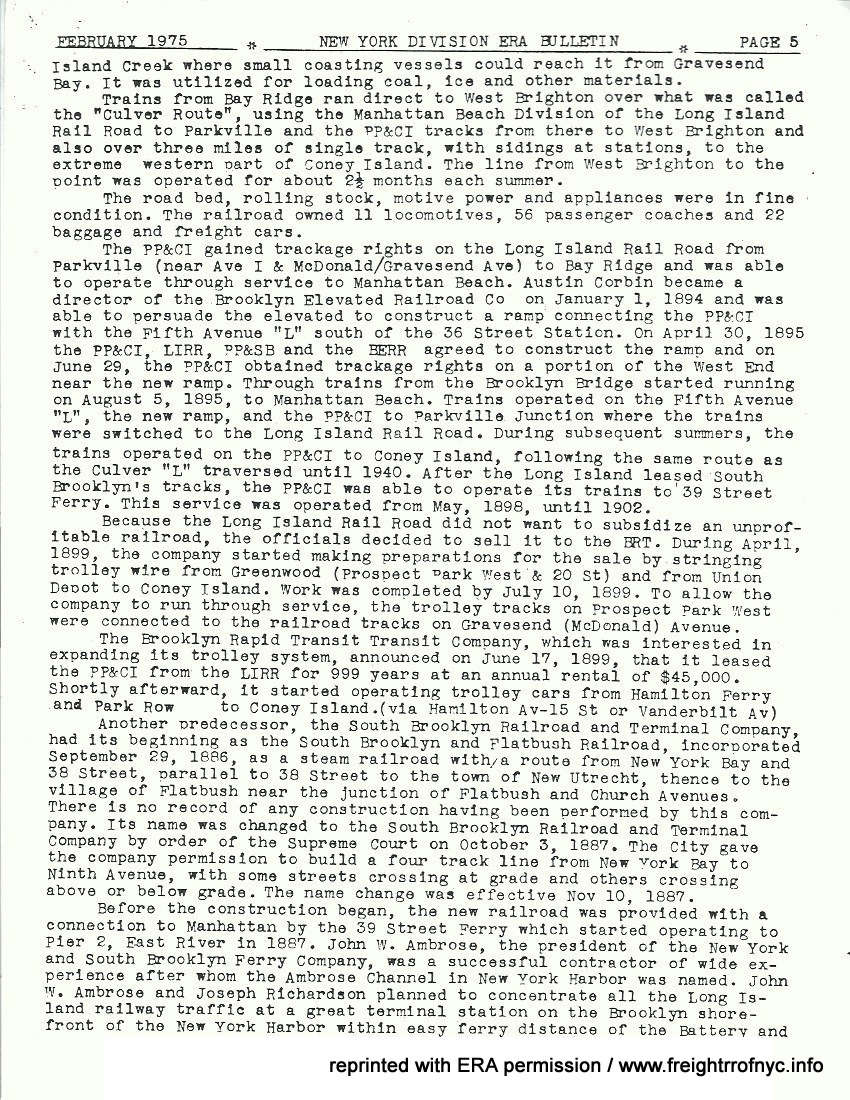 |
 |
 |
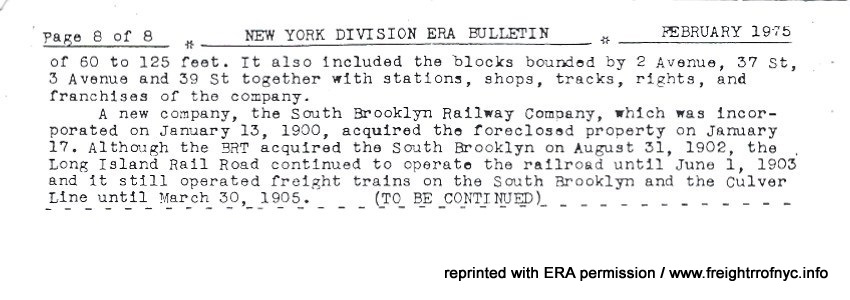 |
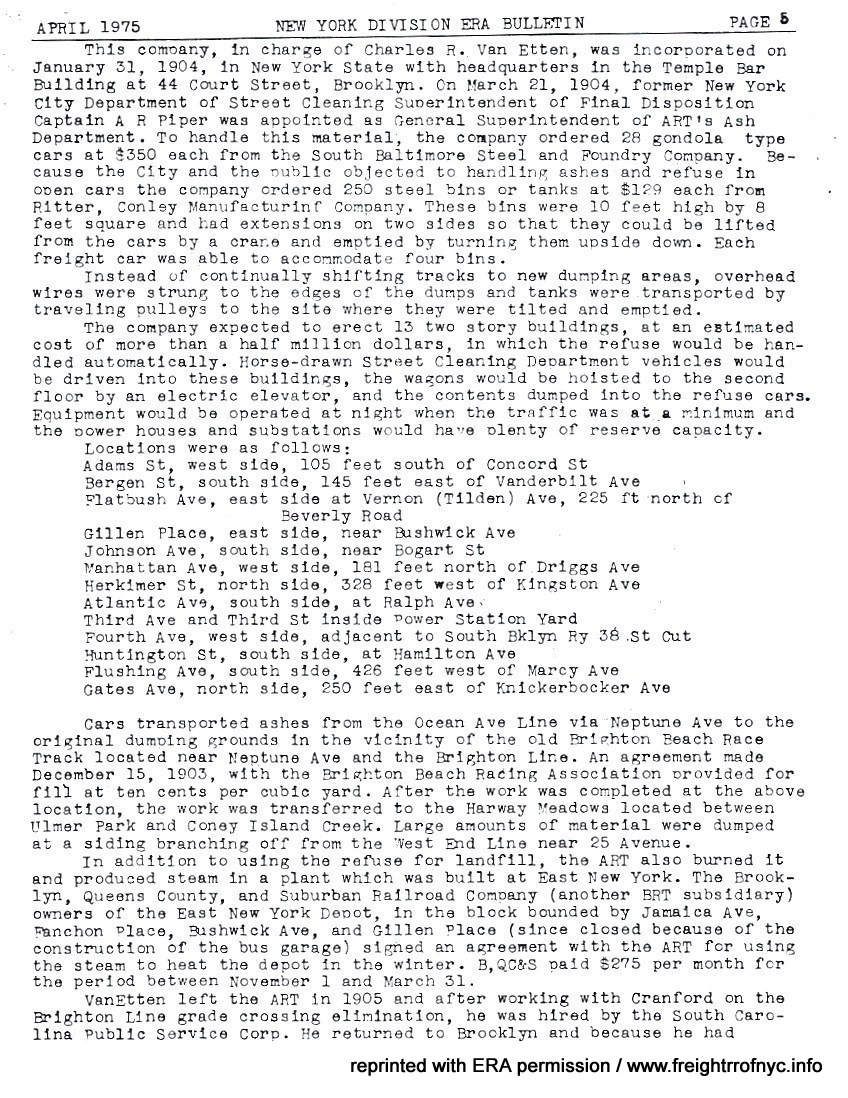 |
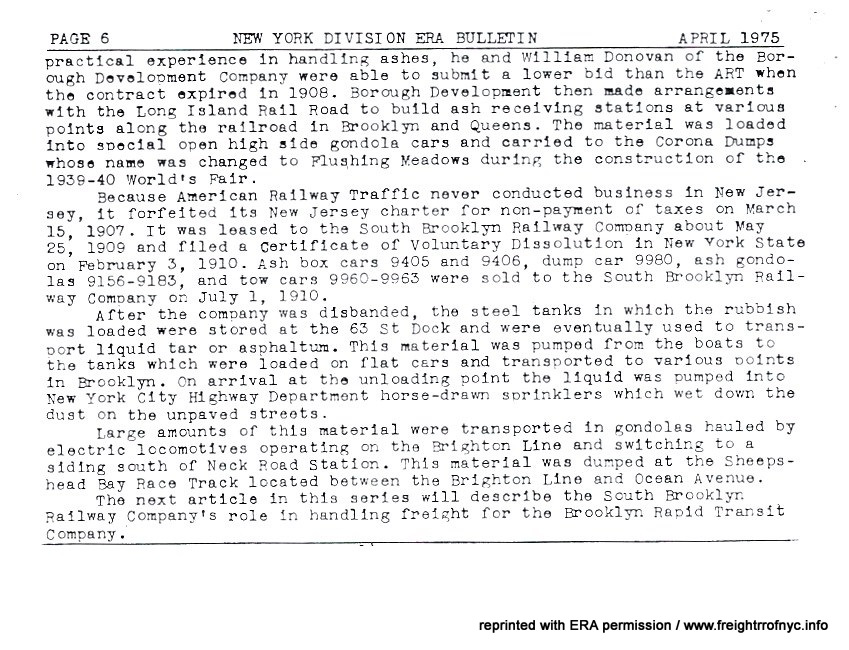 |
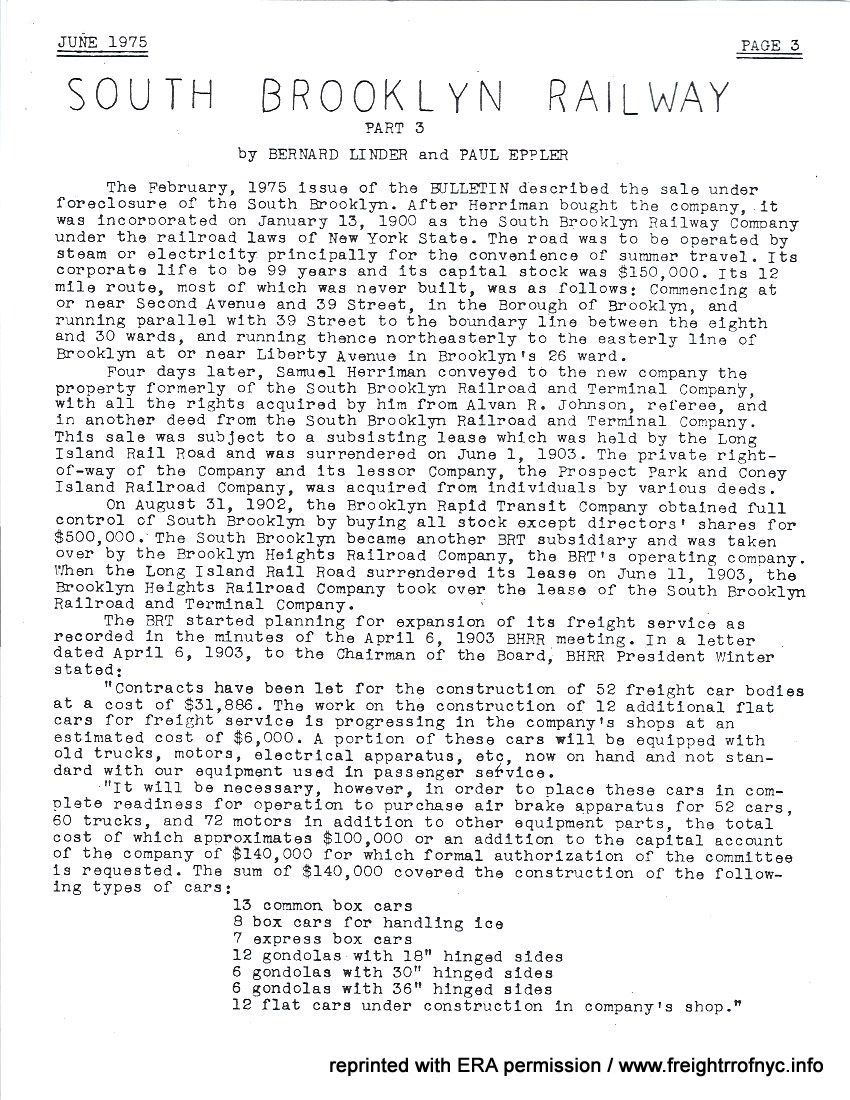 |
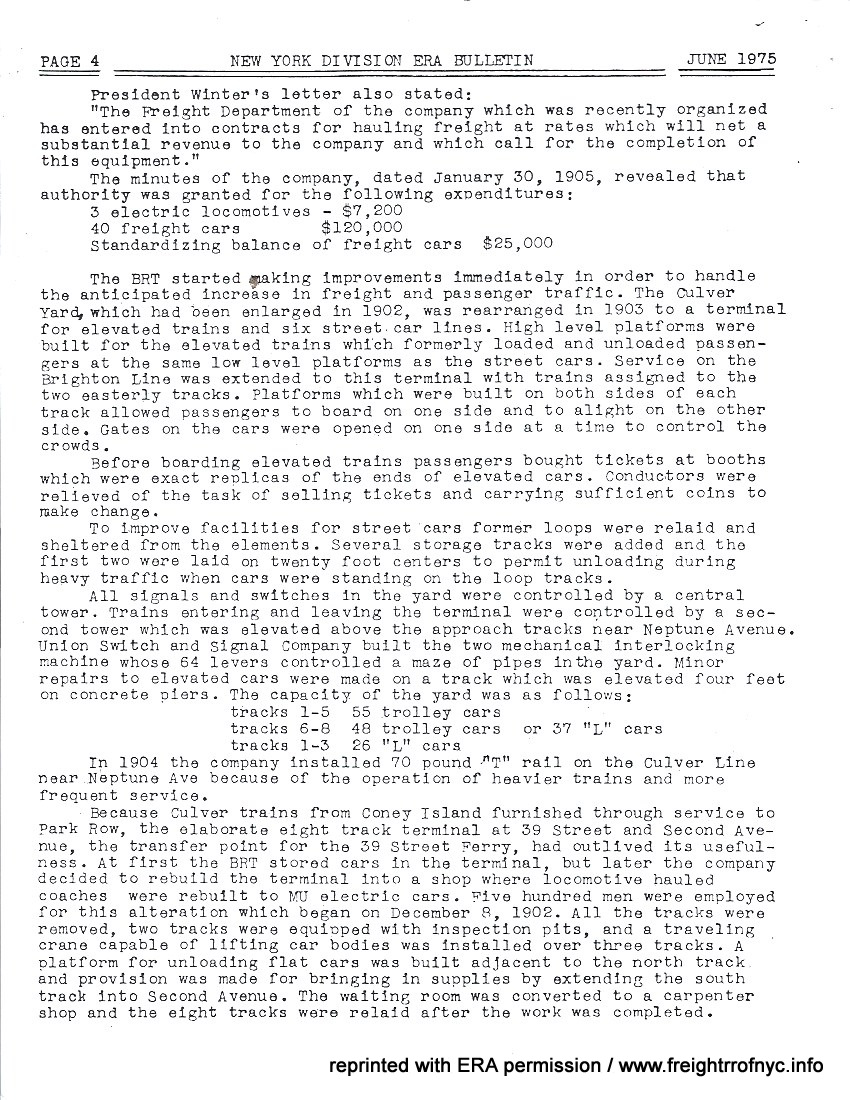 |
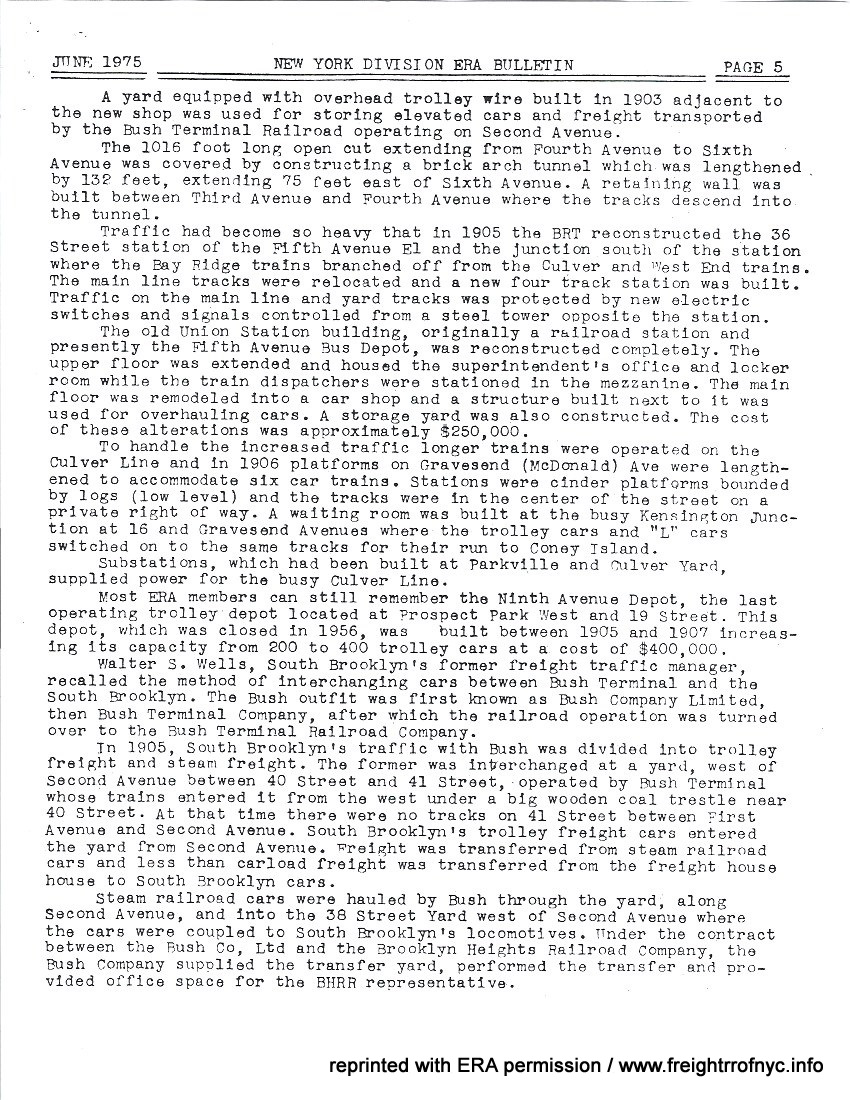 |
 |
 |
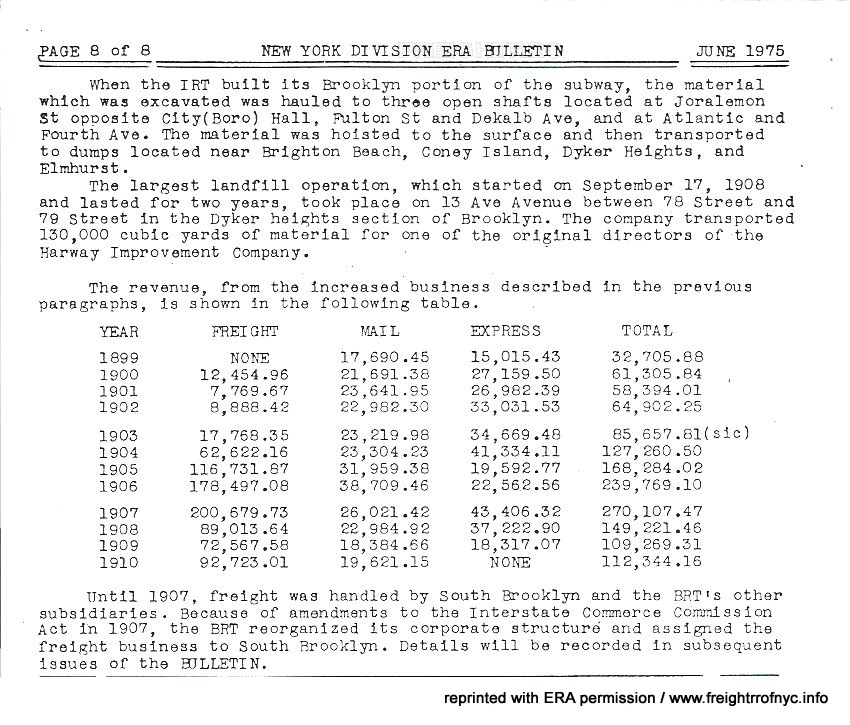 |
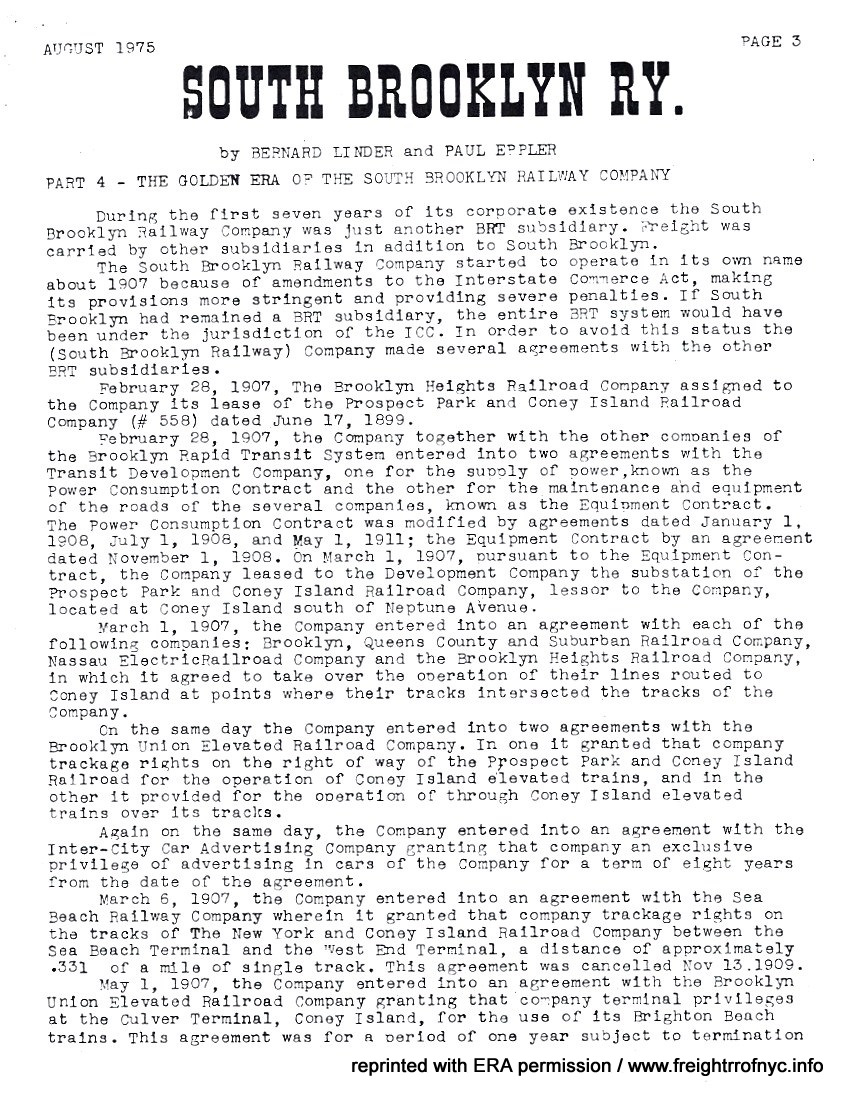 |
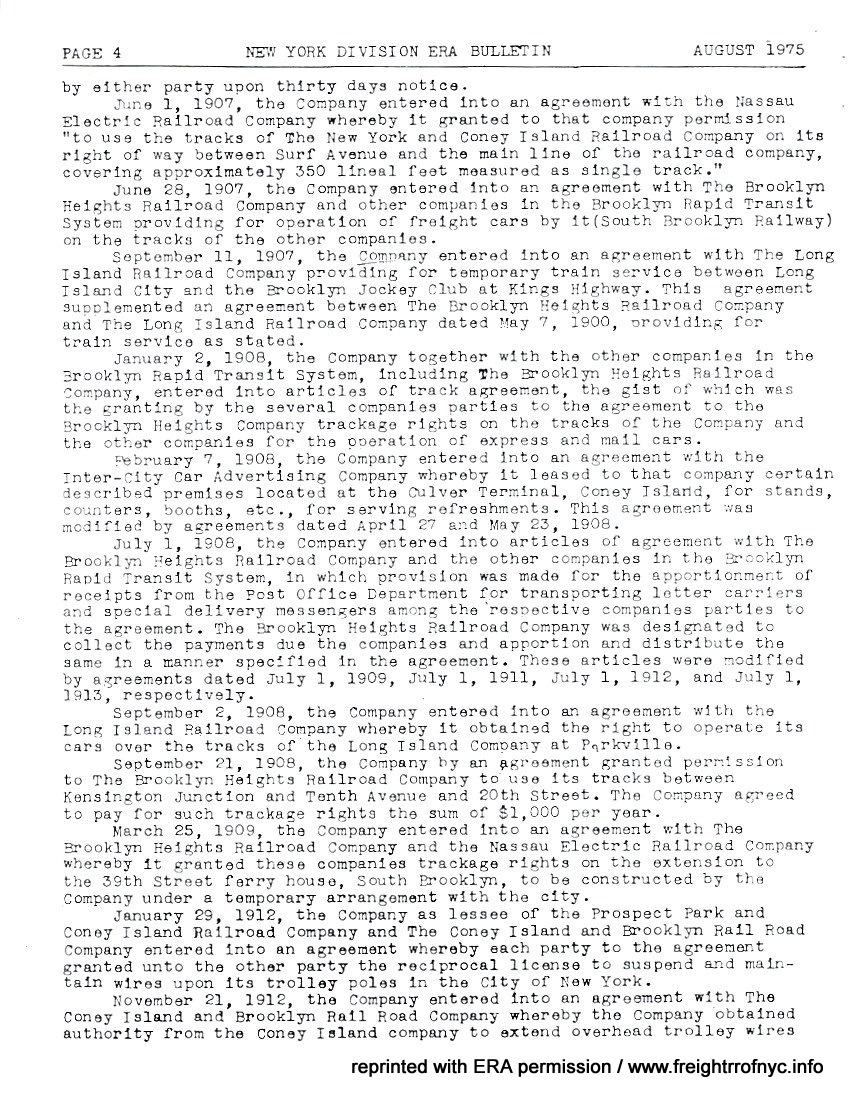 |
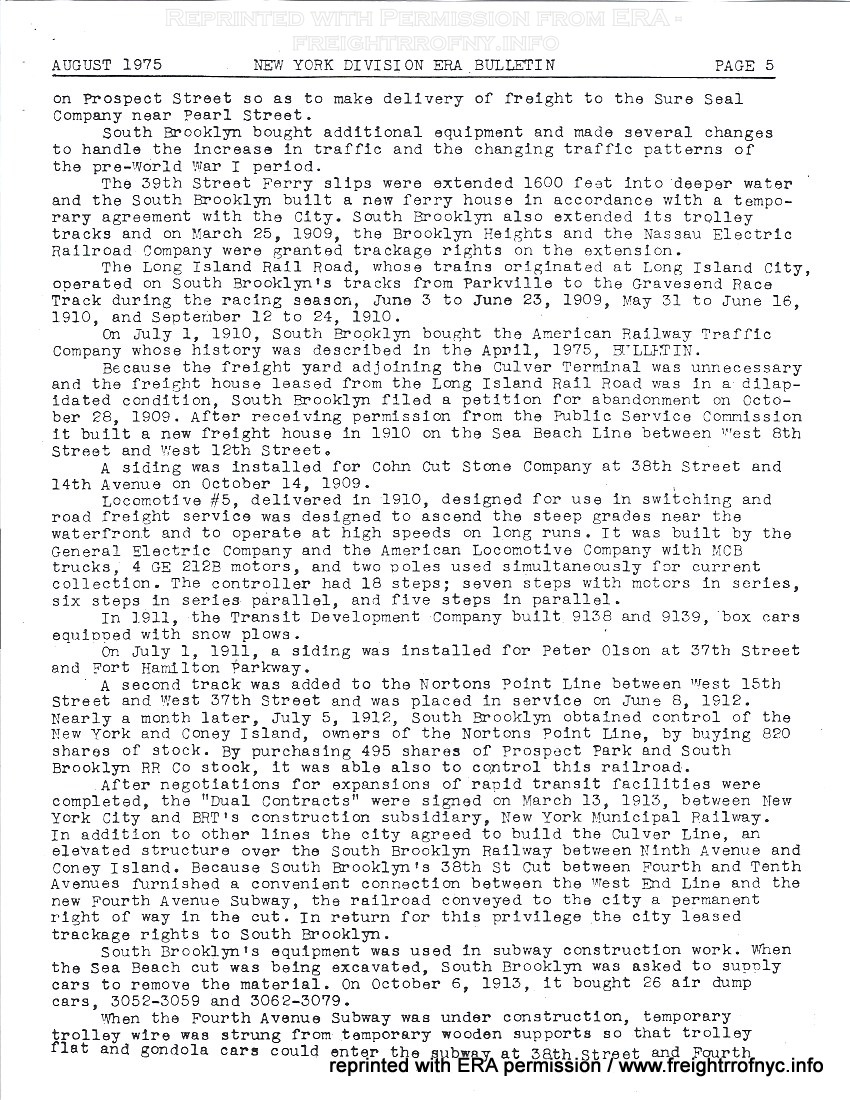 |
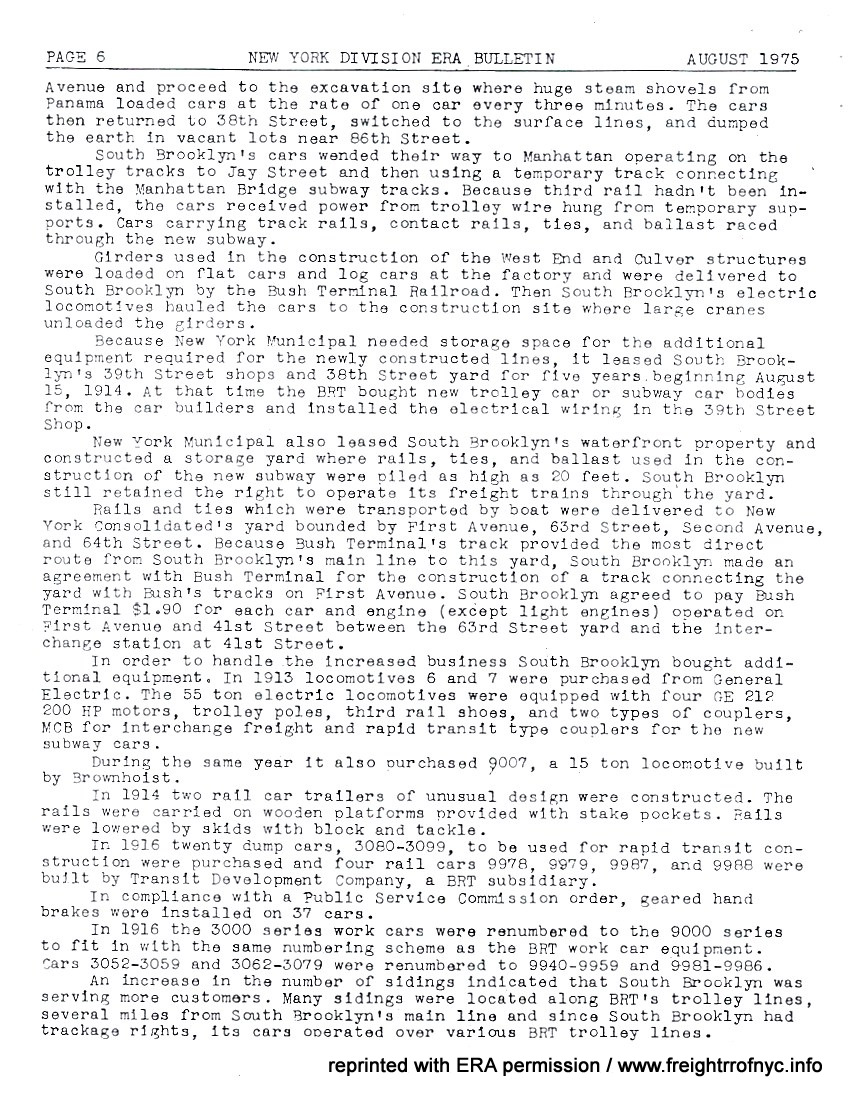 |
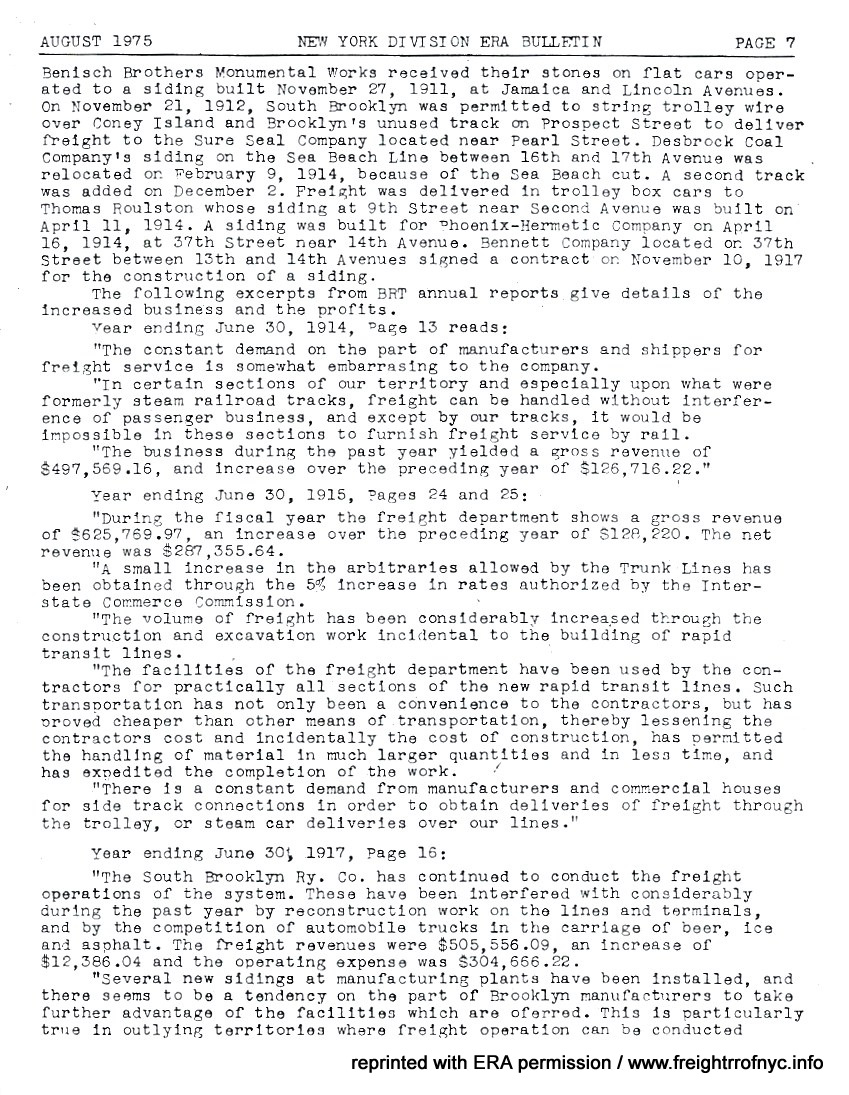 |
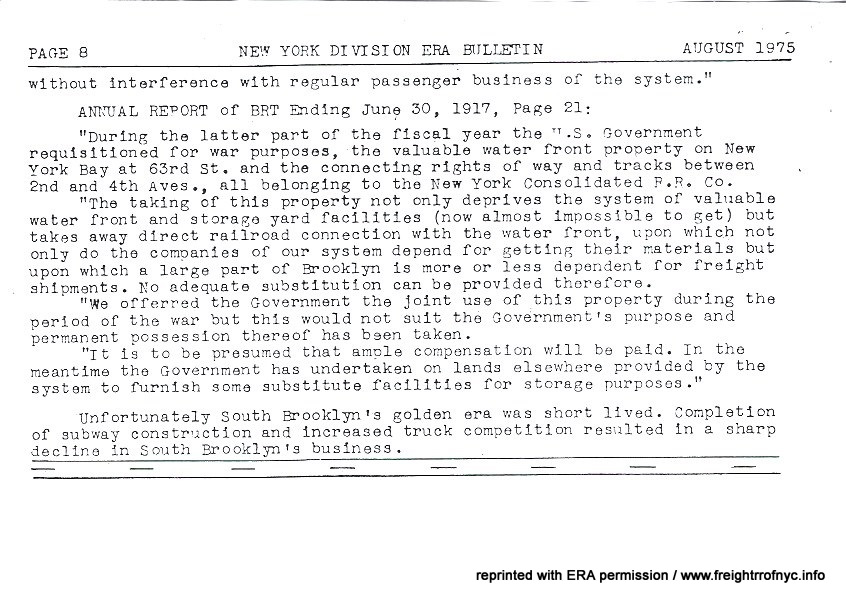 |
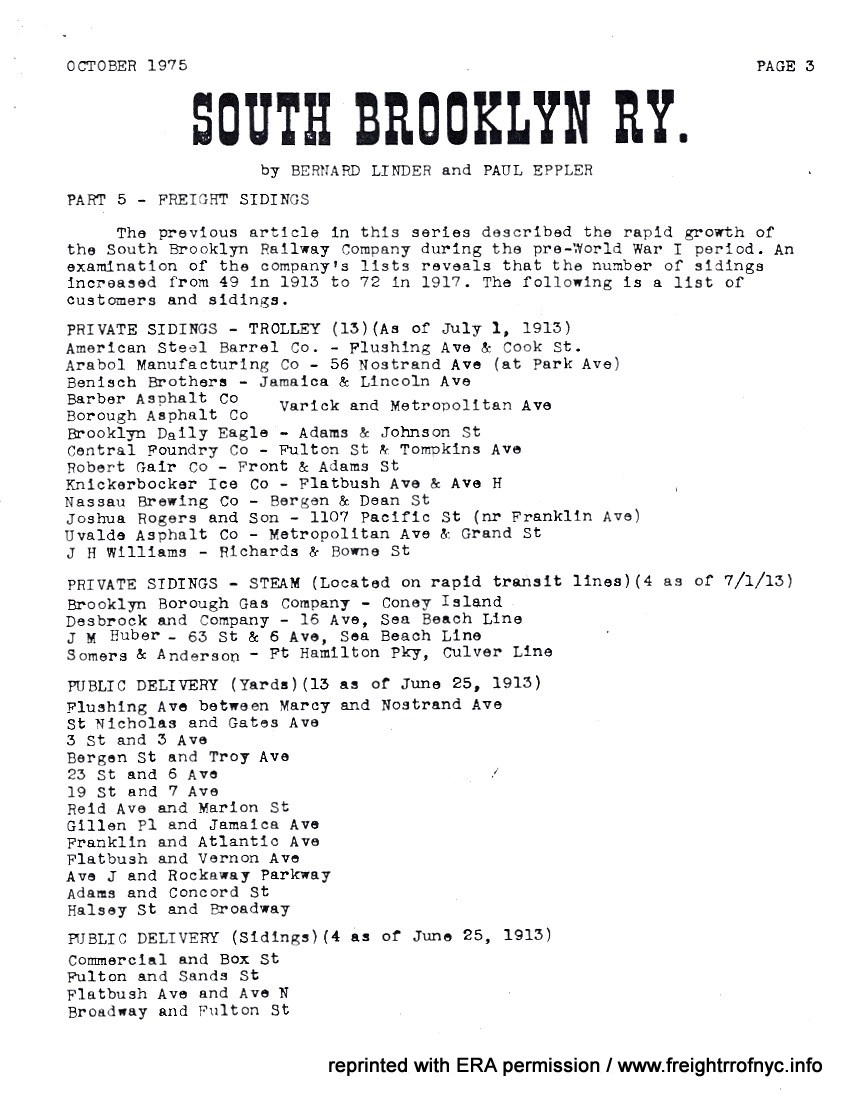 |
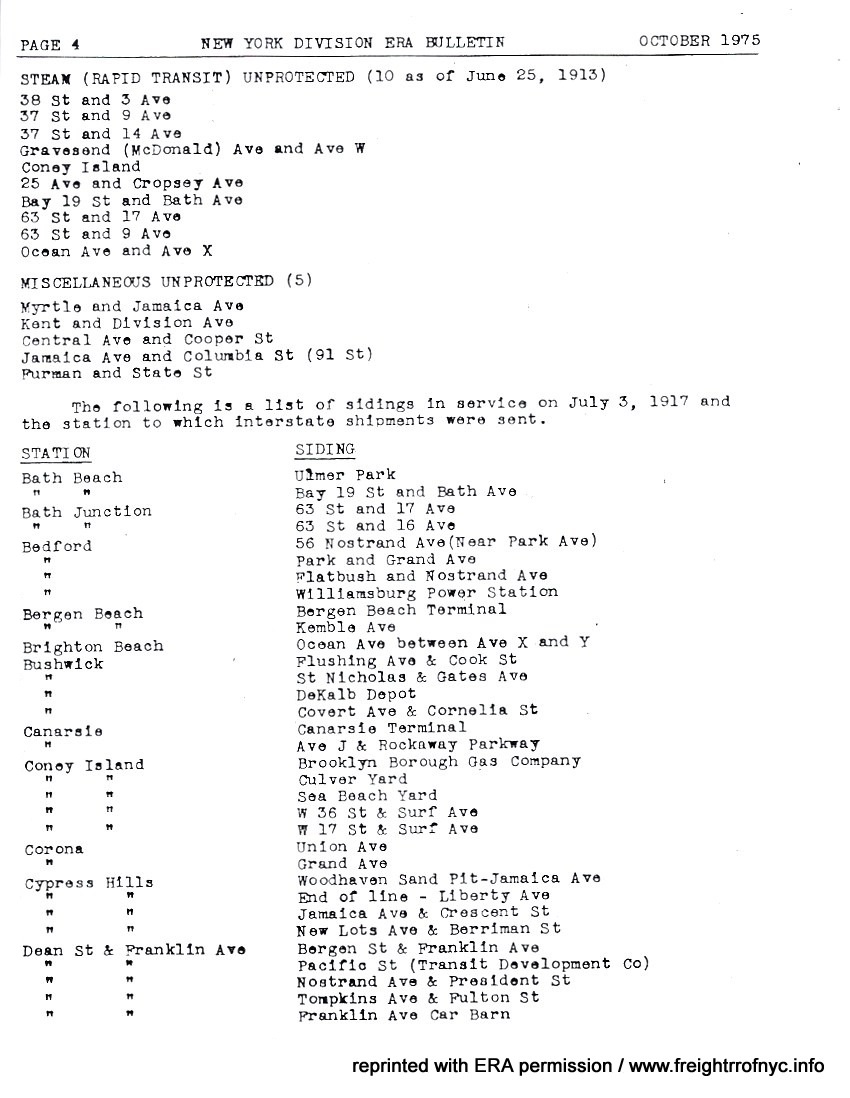 |
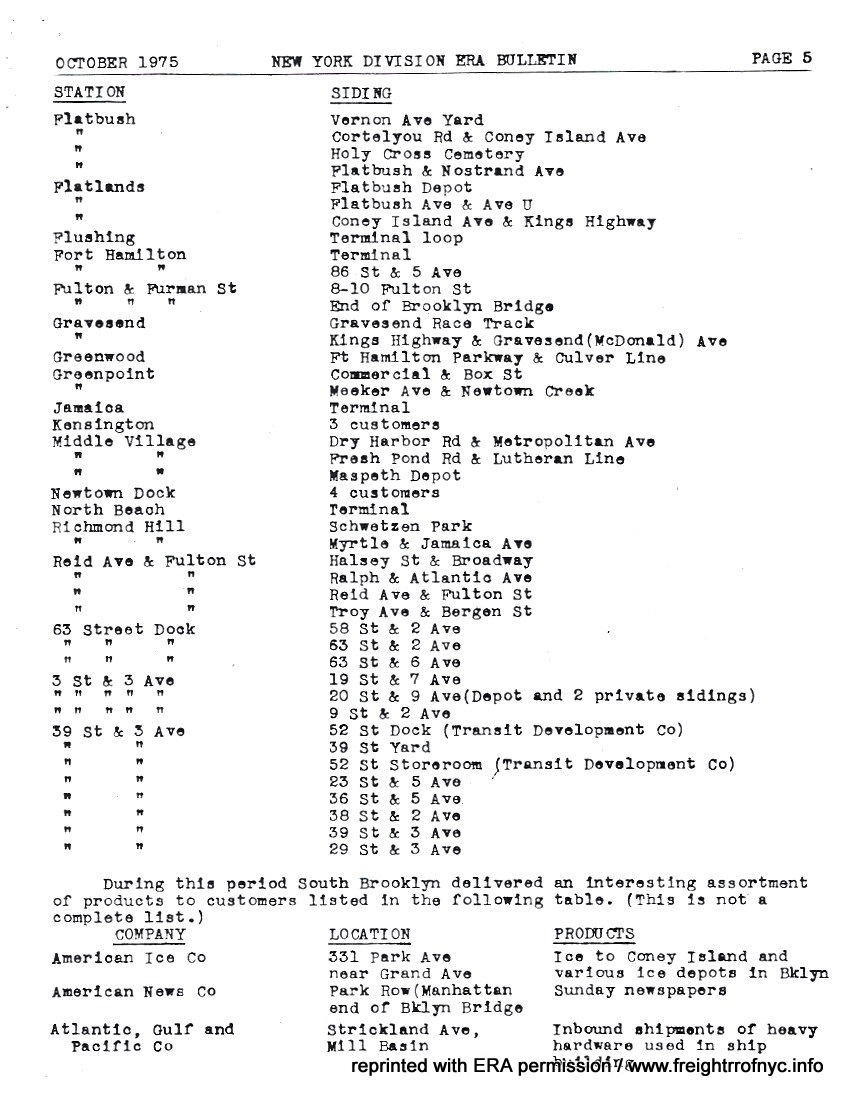 |
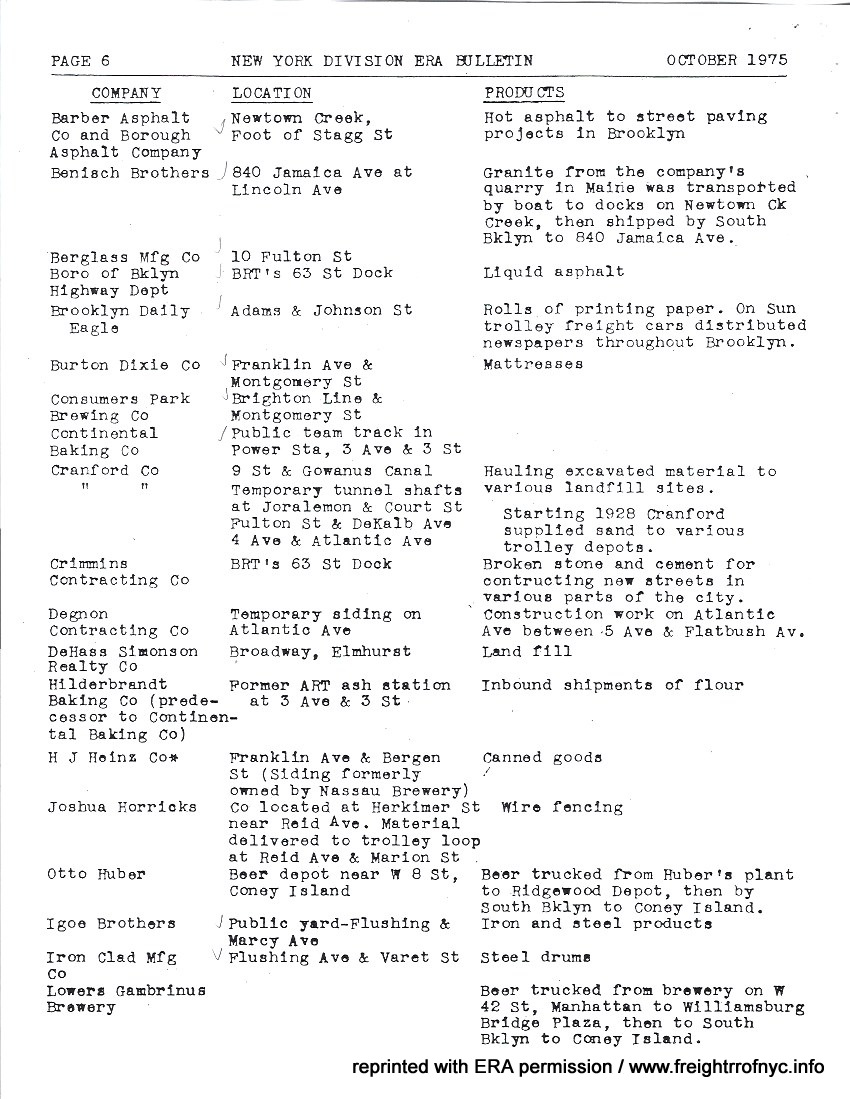 |
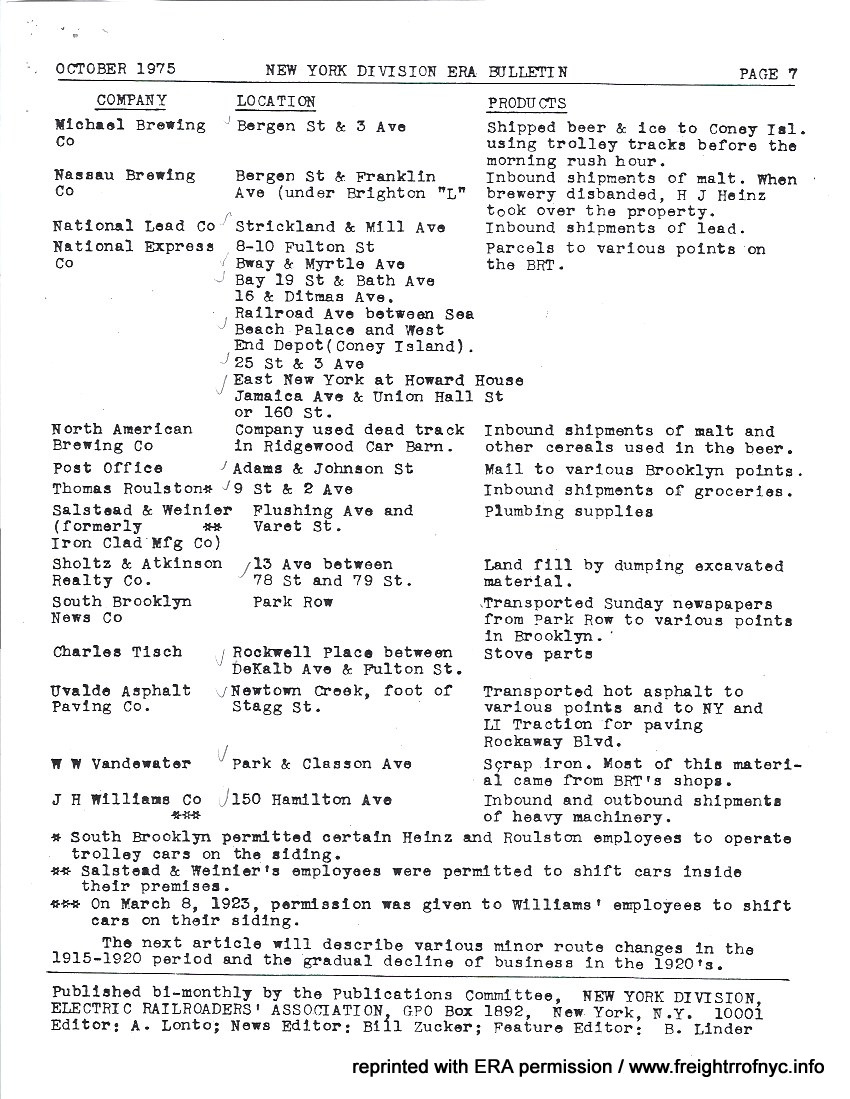 |
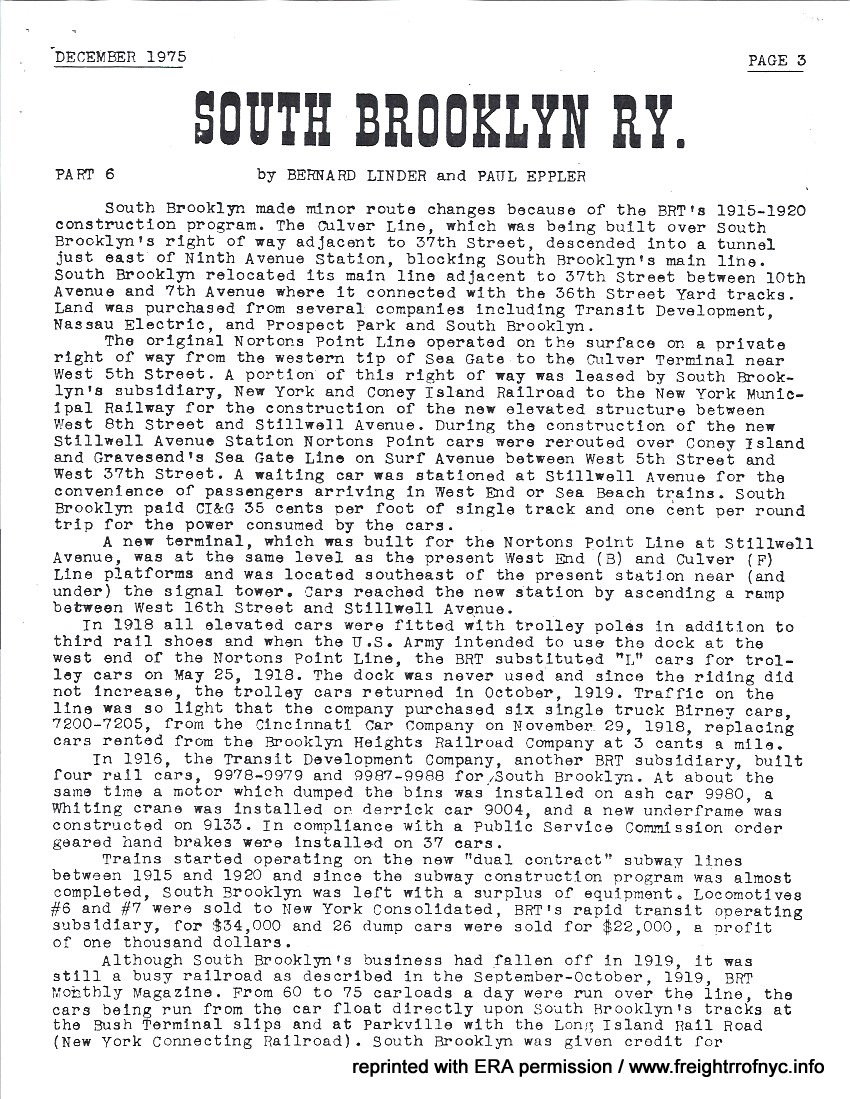 |
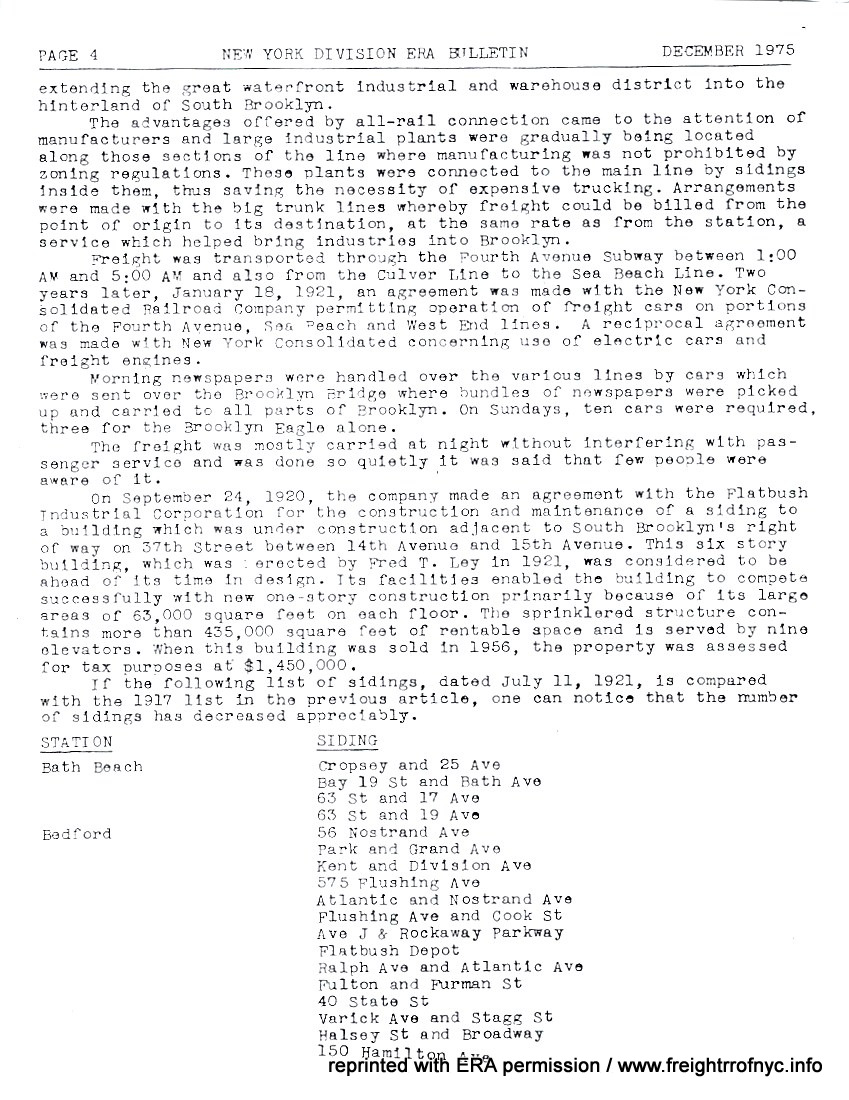 |
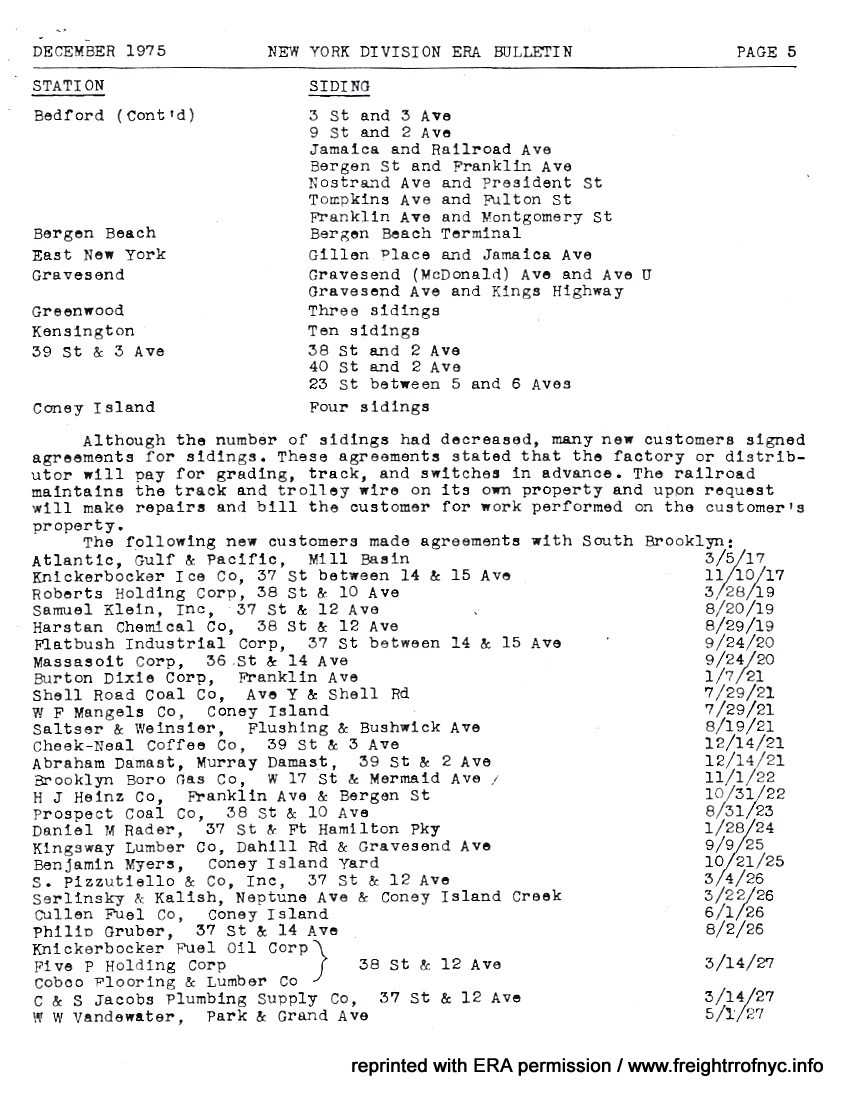 |
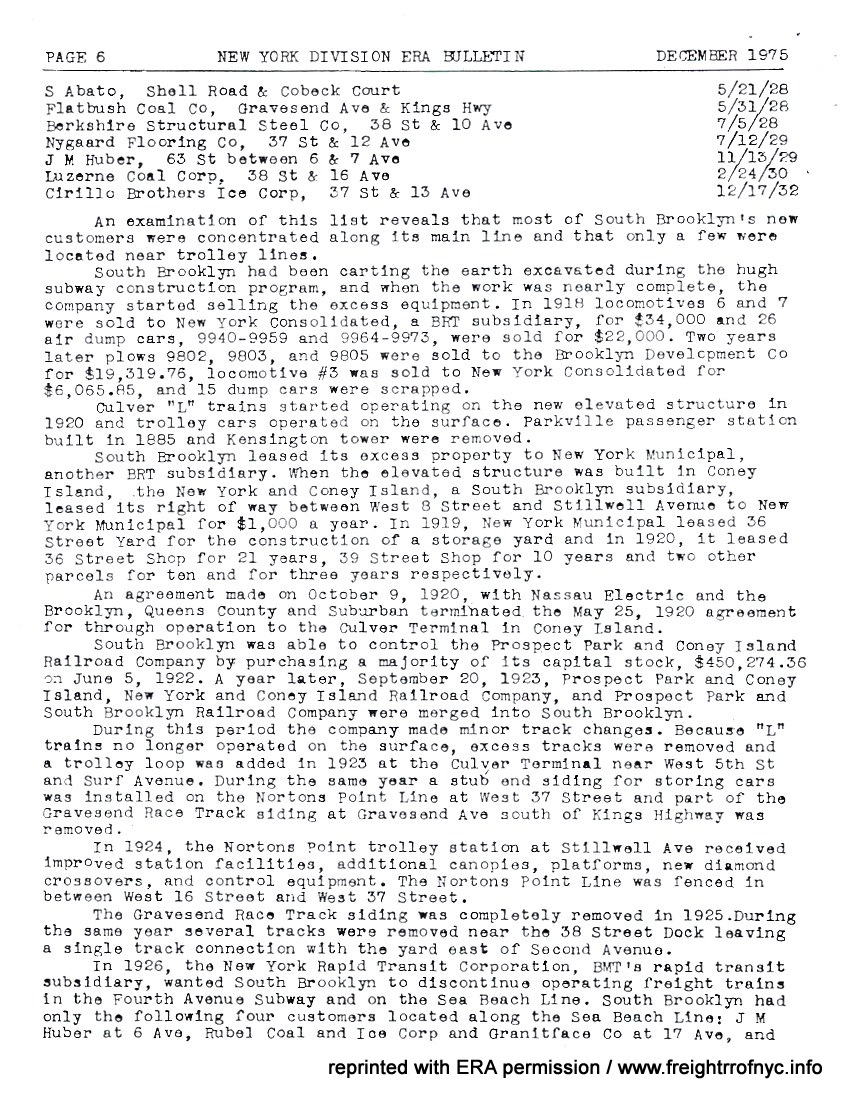 |
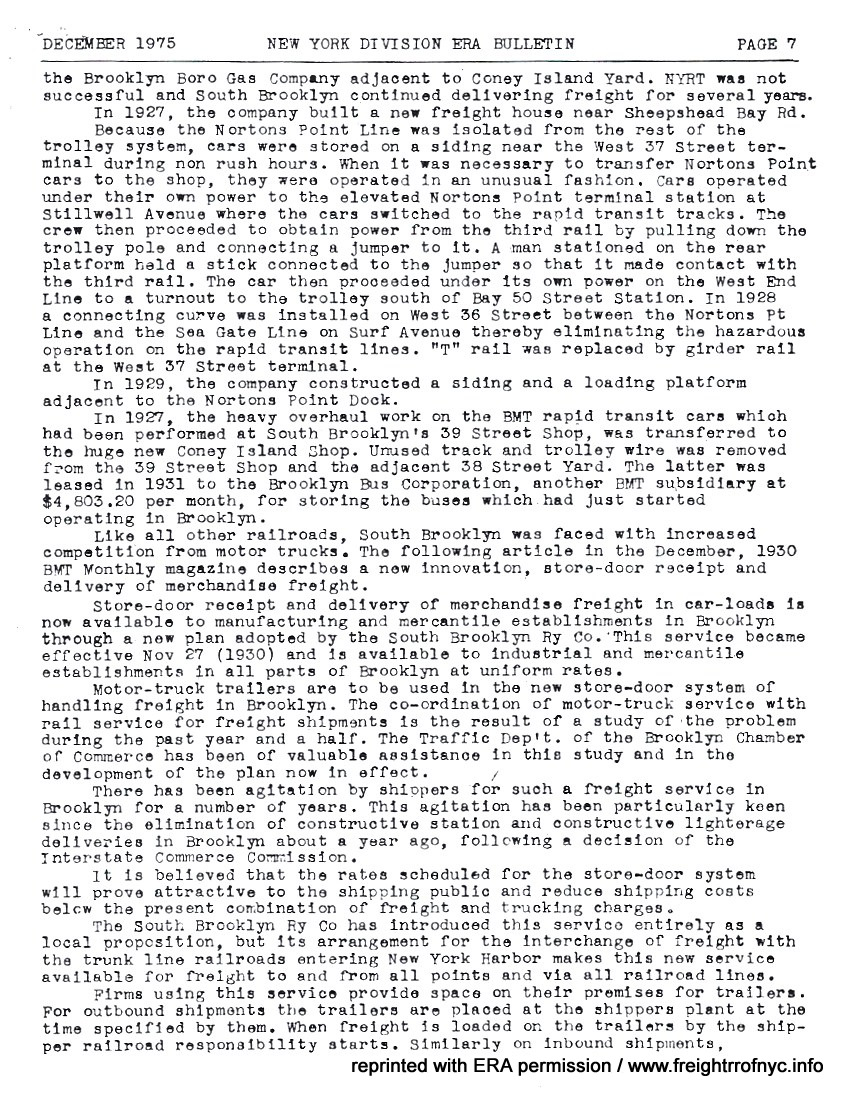 |
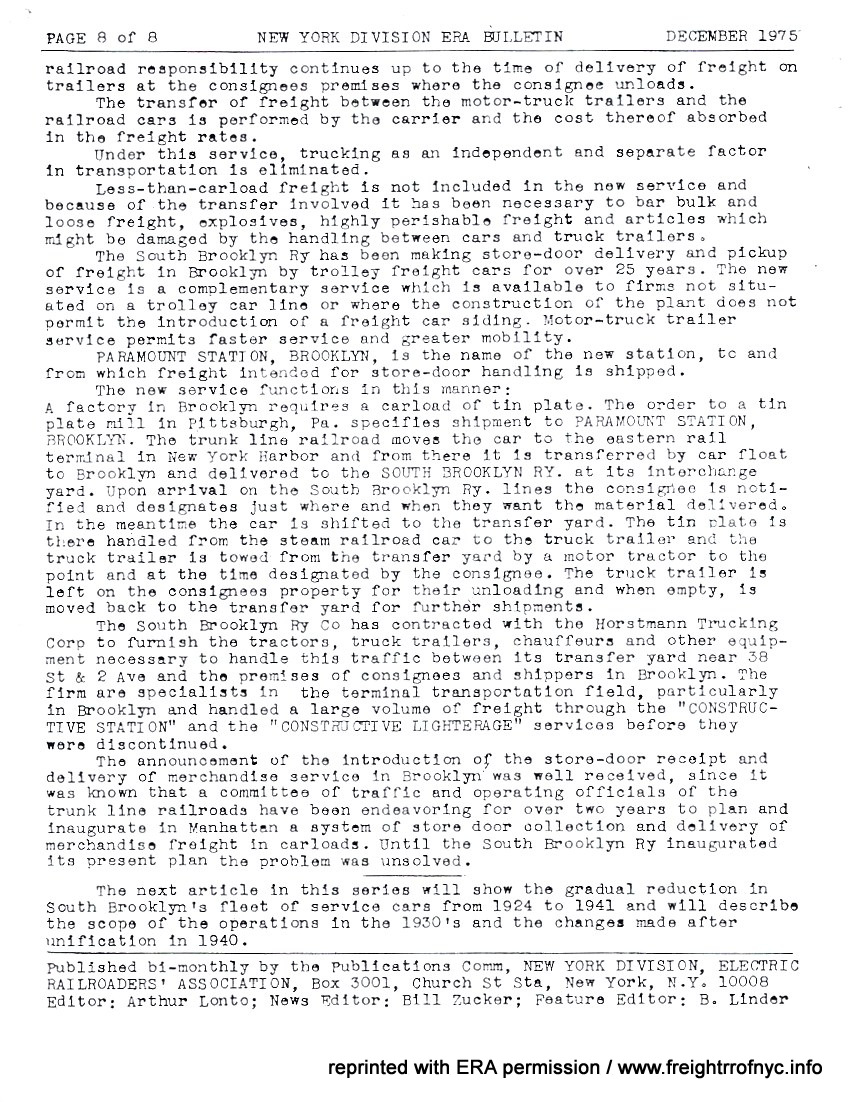 |
 |
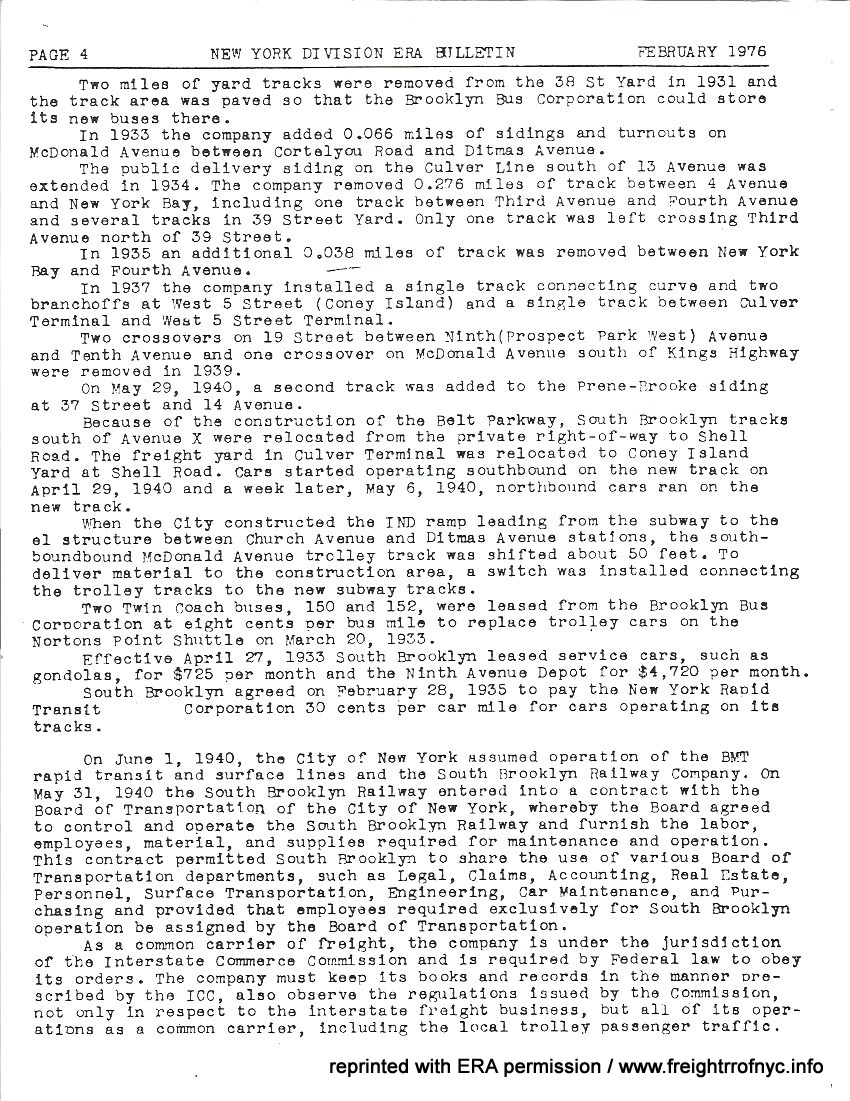 |
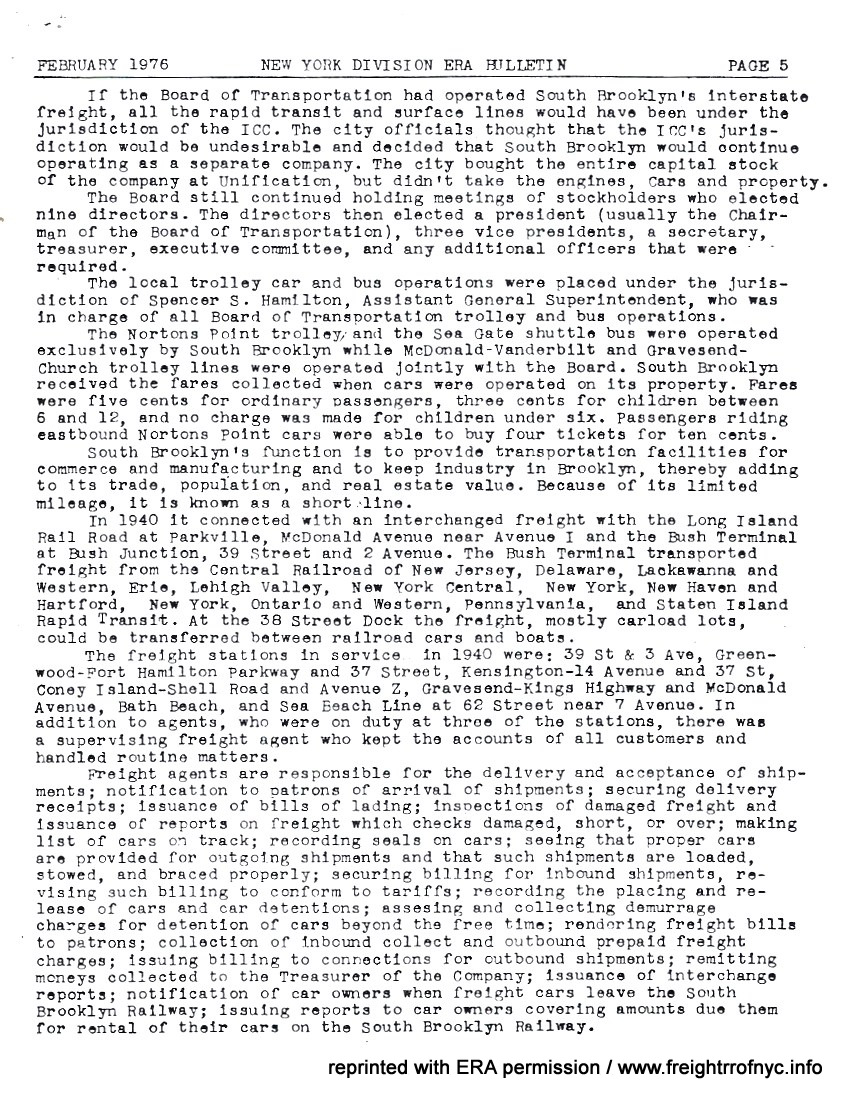 |
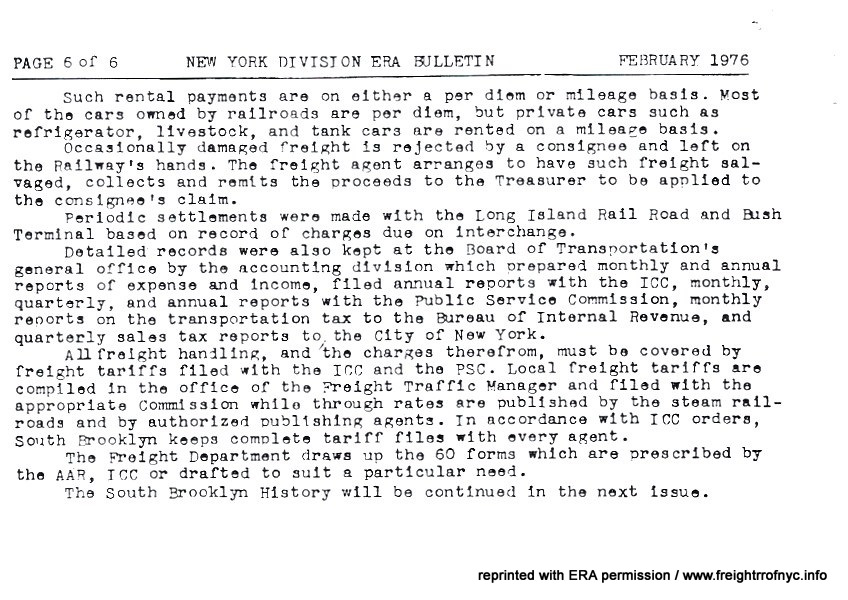 |
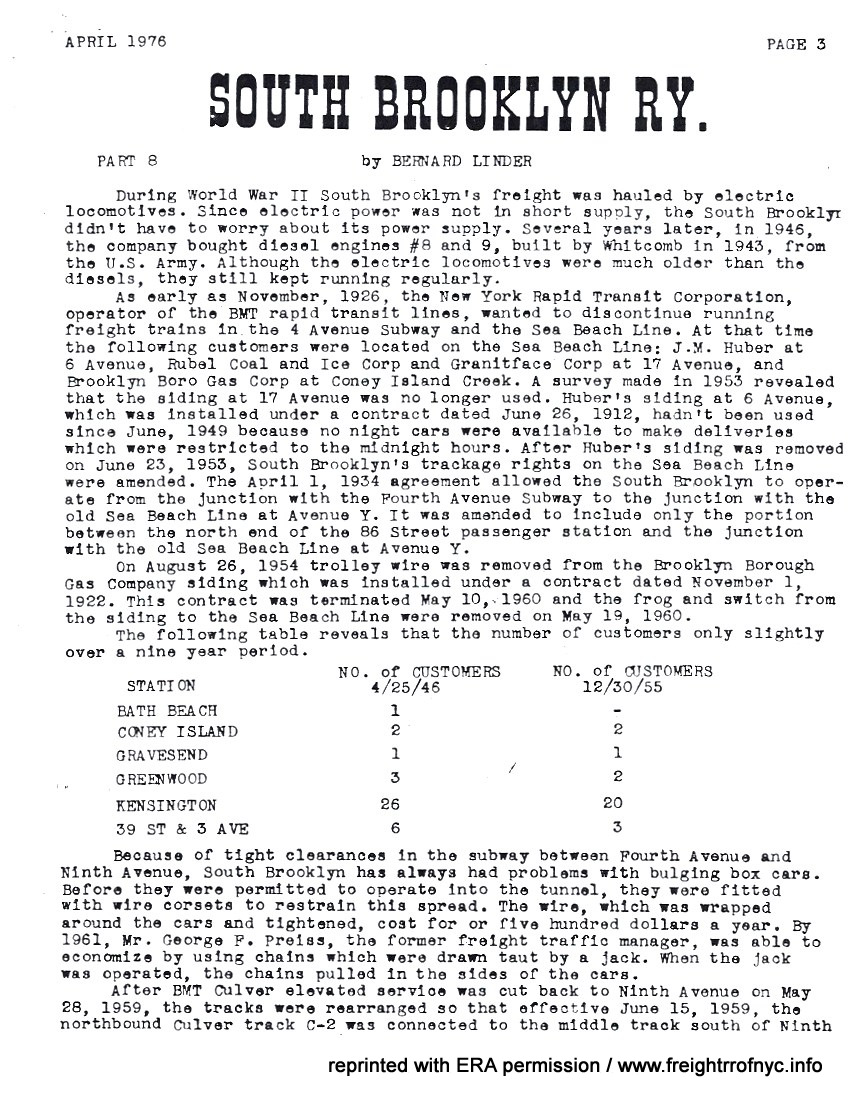 |
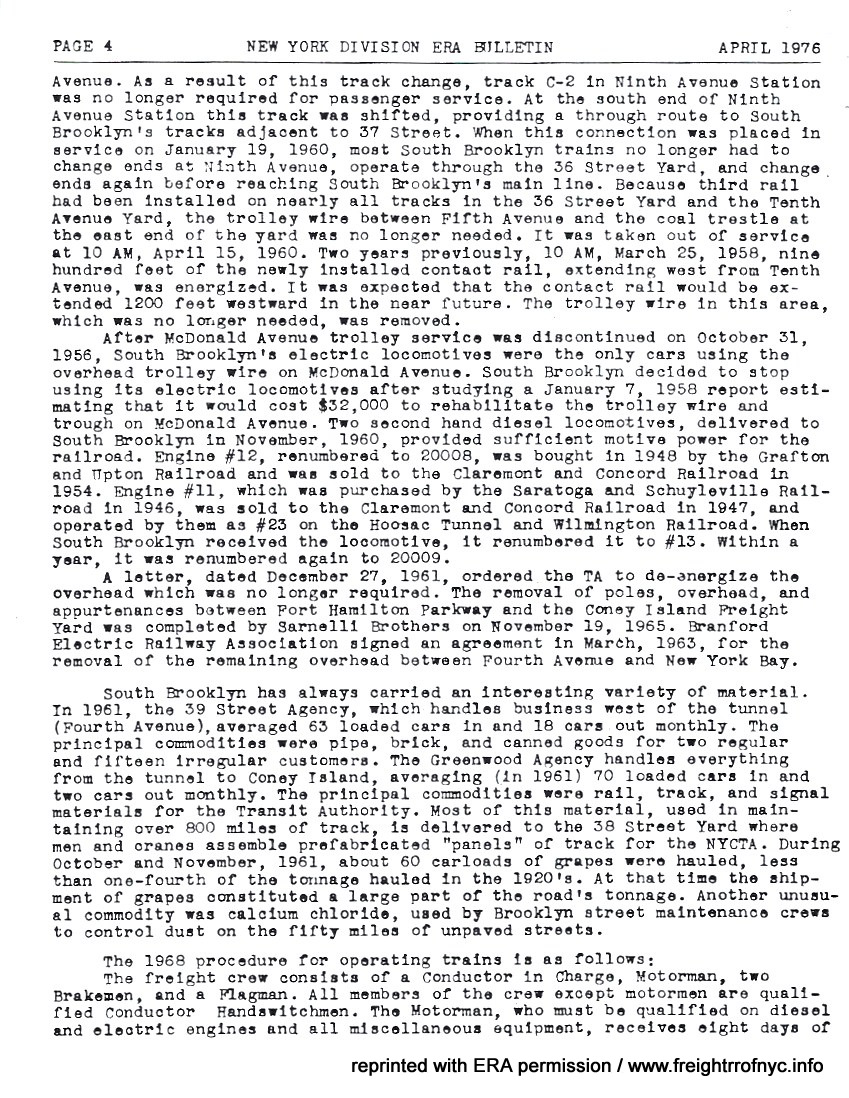 |
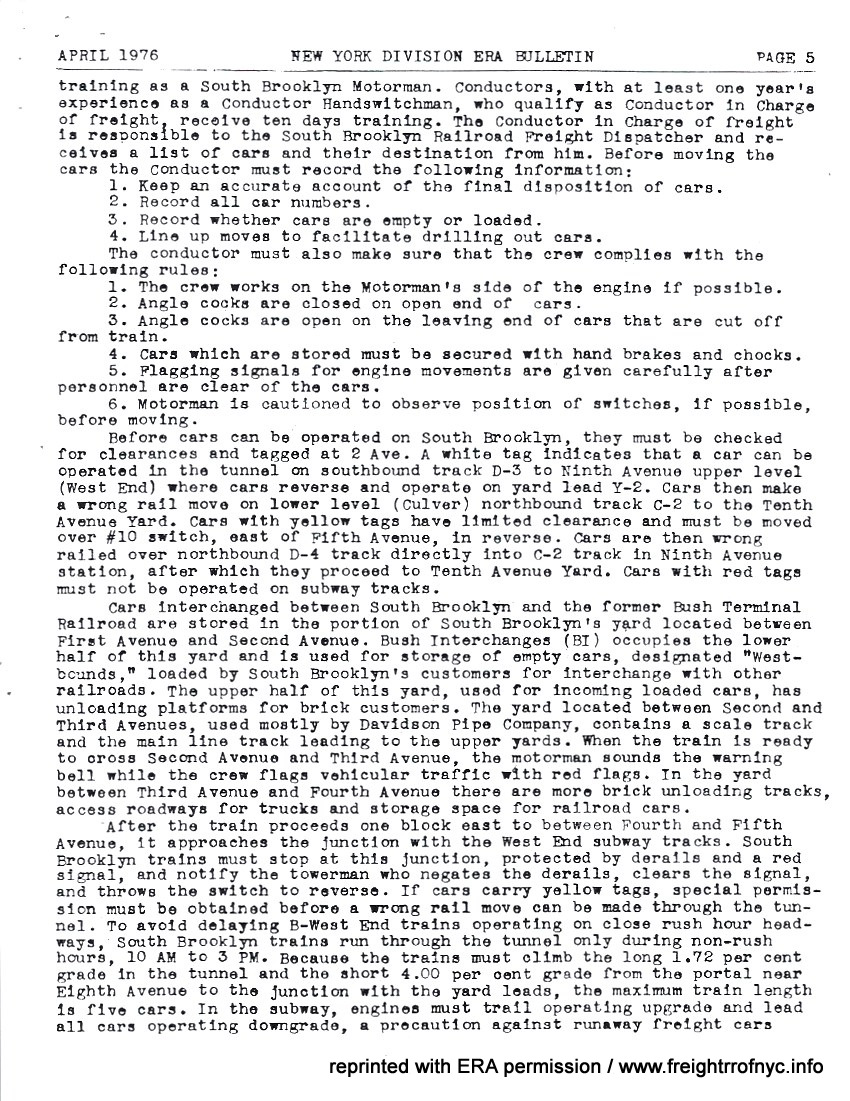 |
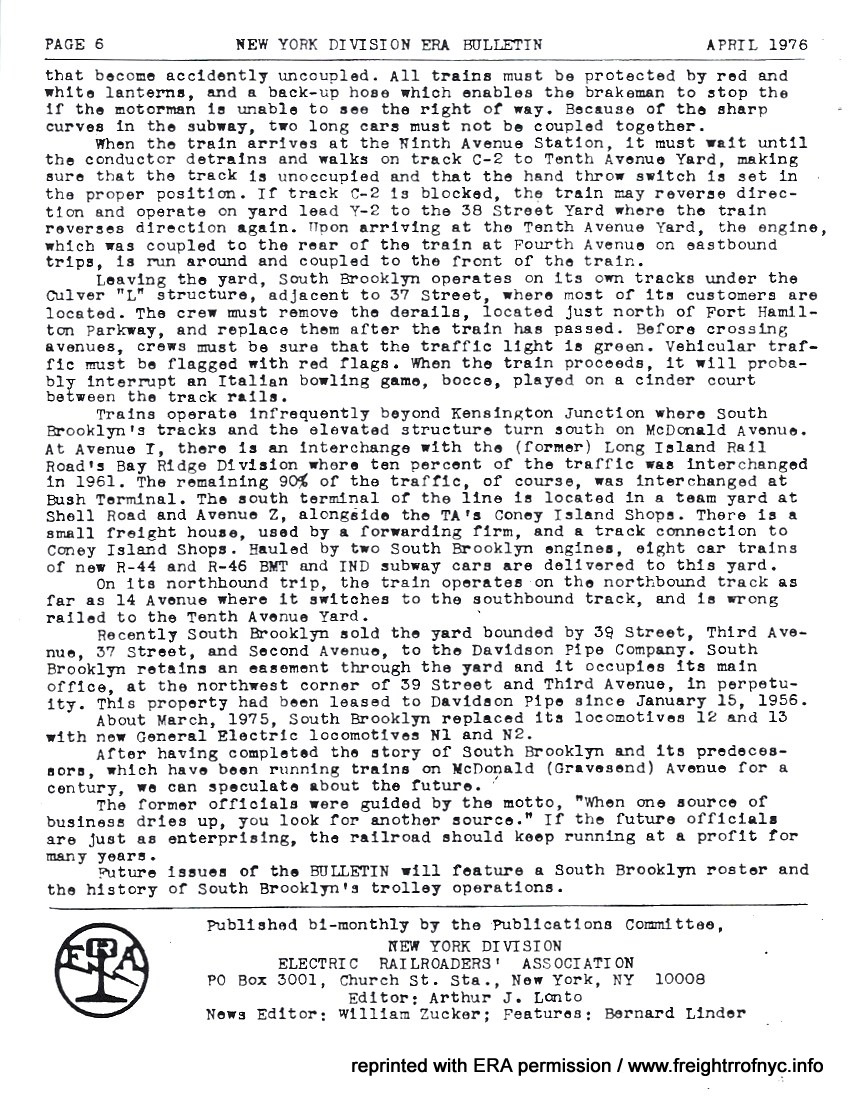 |
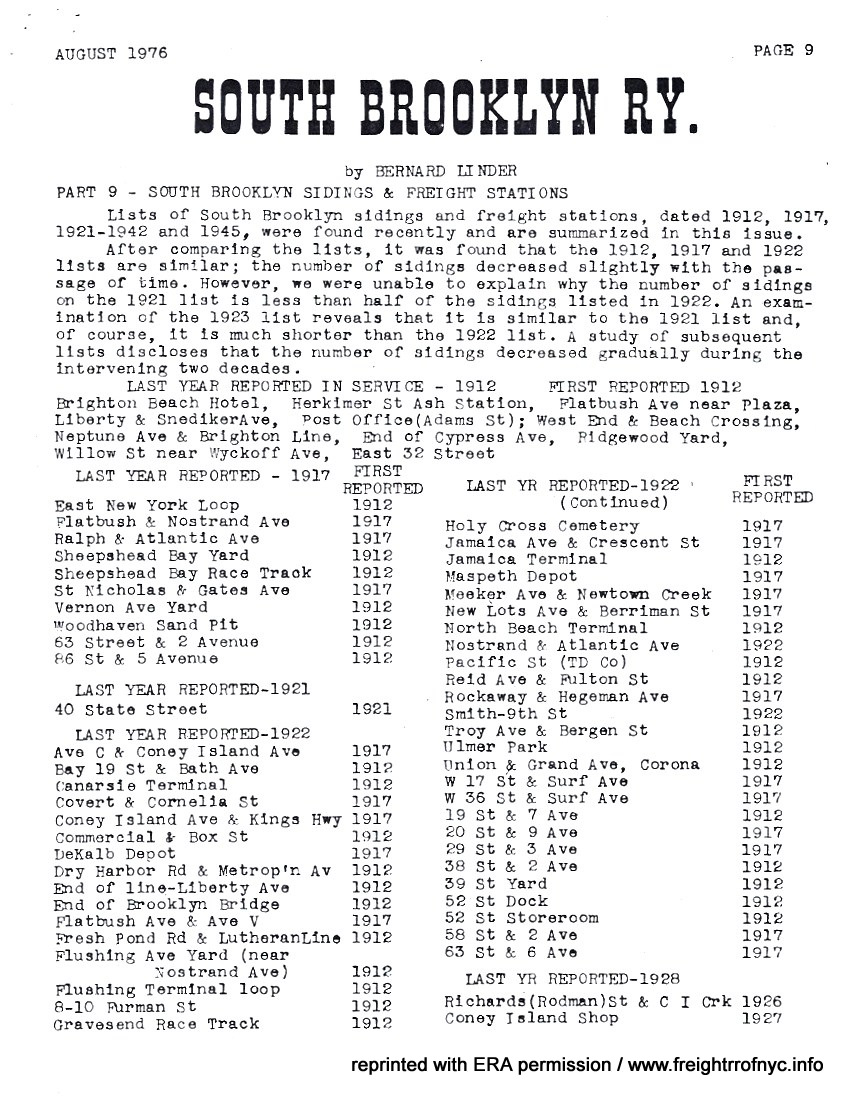 |
 |
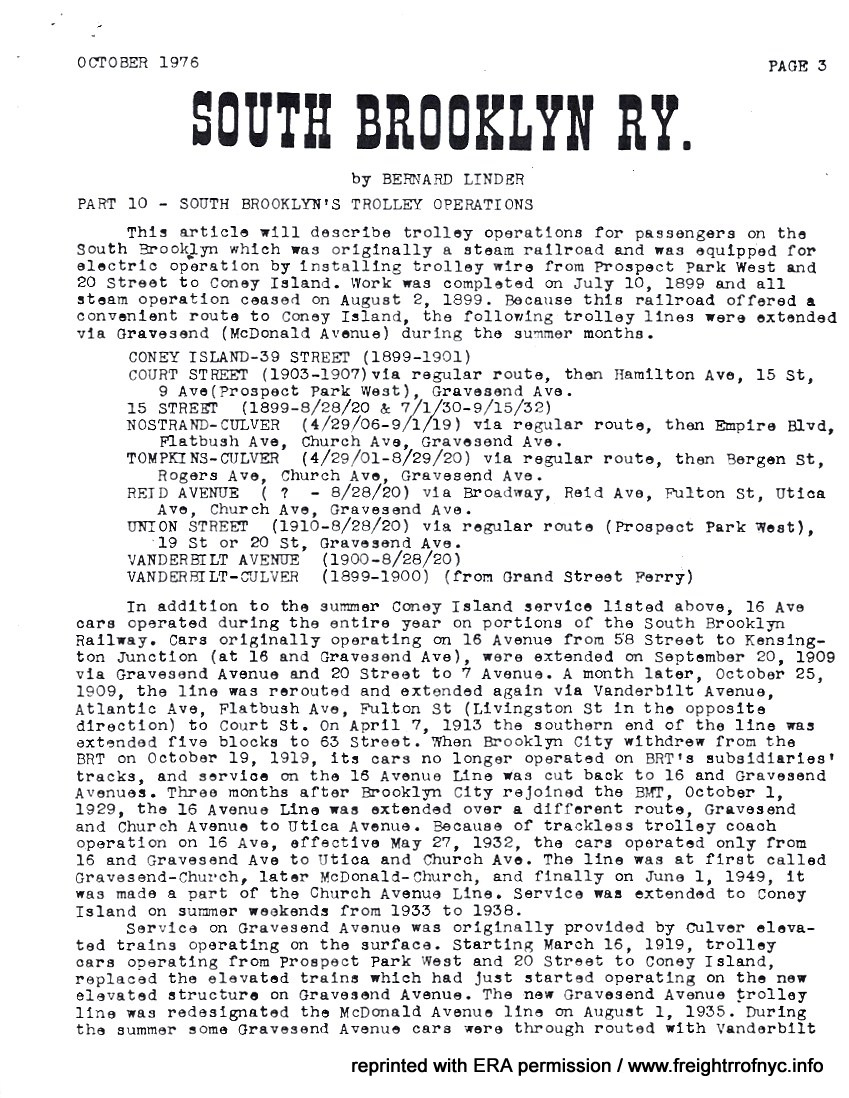 |
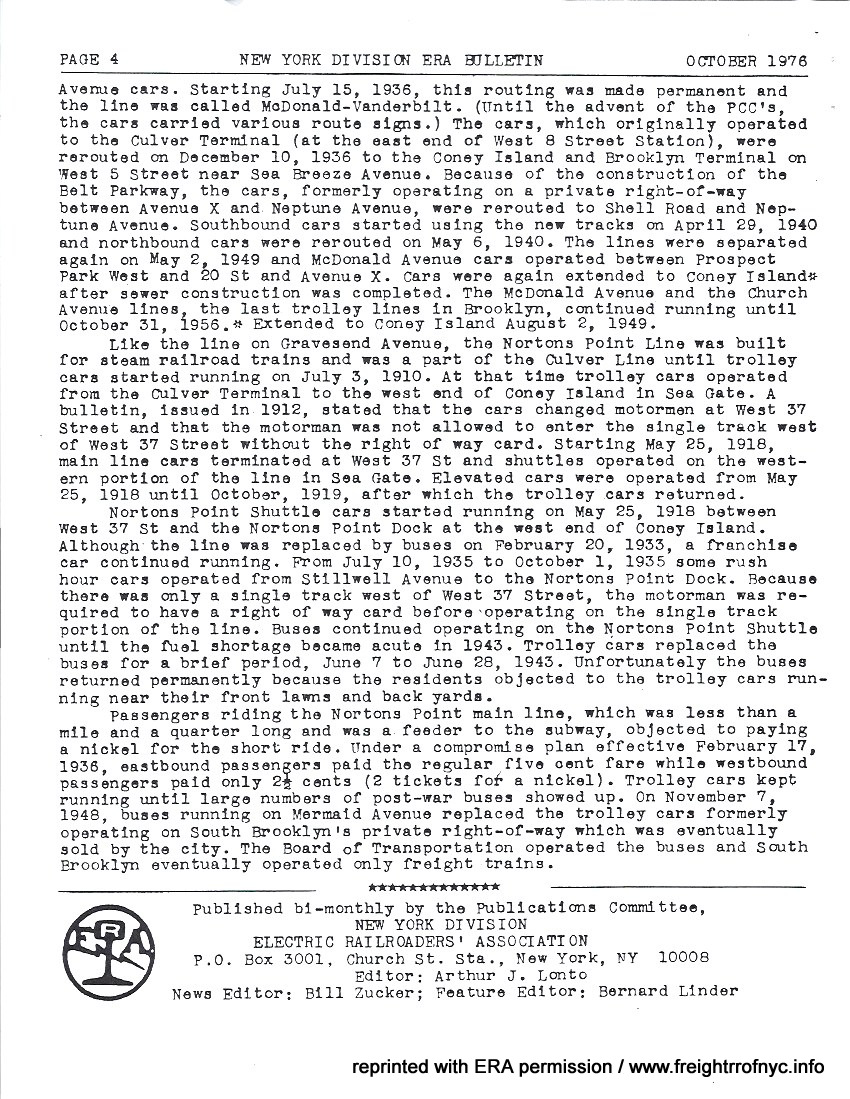 |
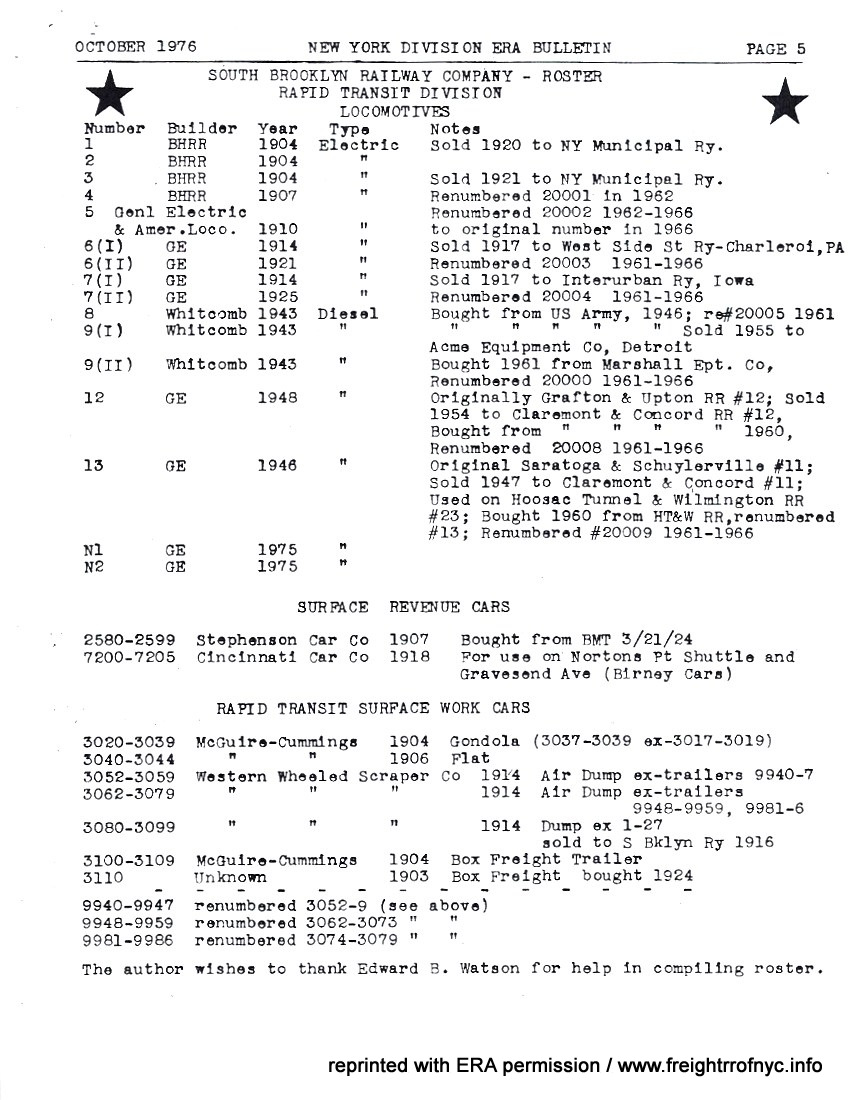 |
 |
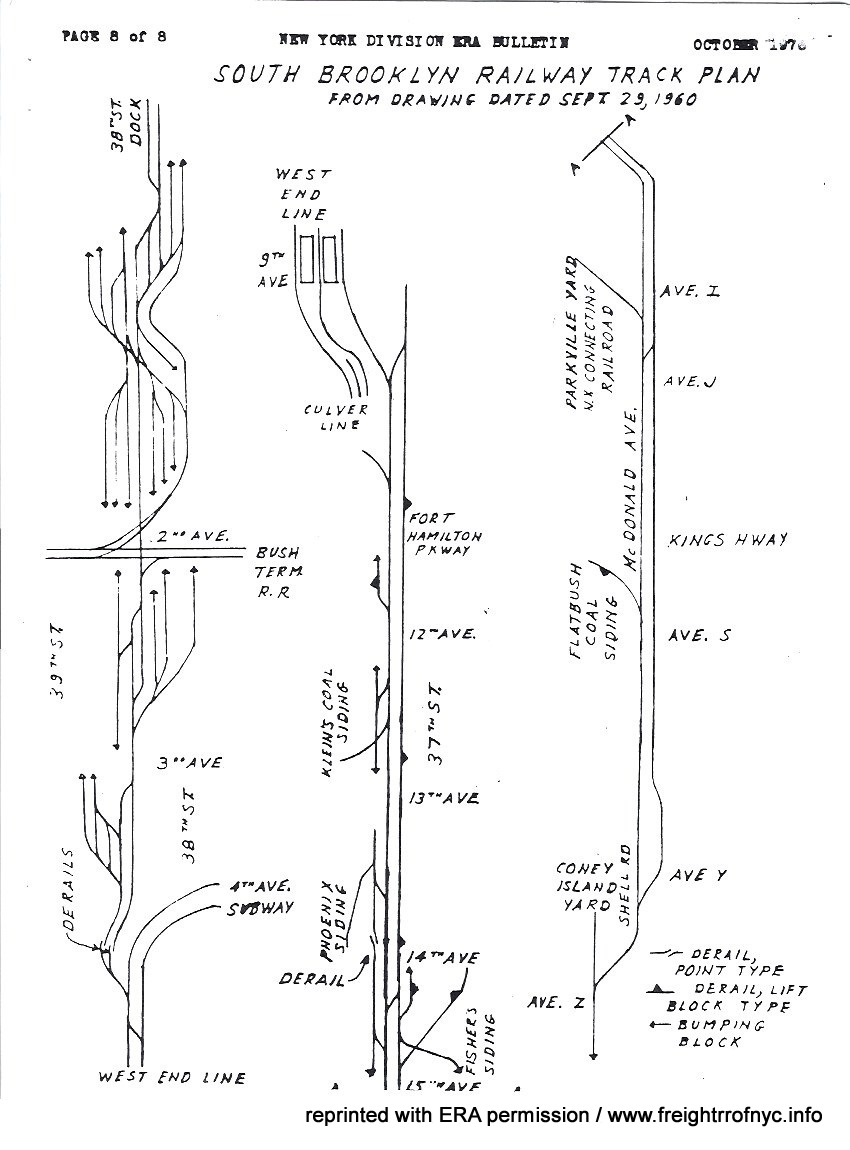 |
As this particular webpage deals with an active railroad, viewers should be aware that:
this webpage or the author is not affiliated with:
.
South Brooklyn Railway,
New York City Transit Authority,
Metropolitan Transit Authority,
City of New York,
South Brooklyn Marine Terminal,
New York City Economic Development Corporation,
New York New Jersey Rail,
Davidson Pipe Supply Company, or
Costco Wholesale Corporation;
.
or any of their subsidieries, holding companies or parent organizations,
employees or otherwise;
and no affliation or connection with those companies or municipalities is
suggested or implied.
This website and the information contained
within has been compiled for the use of reference only, and any inaccuracies
are purely accidental.
This webpage sees revision for the purpose of the addition of information,
or correction of inaccurate data.
Suggestions or corrections should be sent directly
to:
bedt14@aol.com
.
.